Last updated on April 26, 2024
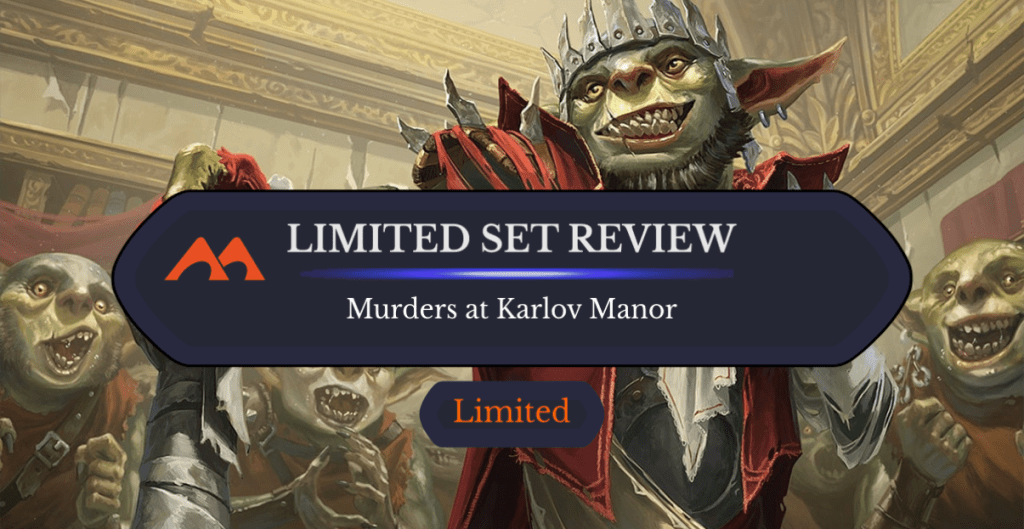
Krenko, Baron of Tin Street | Illustratrion by Brian Valeza
There’s been a murder! I guarantee you, most British people of a certain generation will read that with the thickest of Scottish accents. Did the US ever get Taggart? Anyway, murder mystery stories are among the most enduring in pop culture, and I’m ecstatic to see them getting the Magic treatment. This MTG set looks really sweet, and it’s my pleasure to bring you a card-by-card breakdown of it for playing Limited. I really enjoyed The Lost Caverns of Ixalan and ended up drafting it more than any other set since Dominaria United, so I’m ready and fired up to bring you my thoughts on this brand new expansion.
Reminder that this is a review based on initial impressions of the cards. It’s hard to figure out how these cards play out without knowing things like the speed of the format or the relative power levels of the colors and archetypes. My reviews are largely based on the card’s quality in a vacuum or assuming that their specific archetype is playable.
If you’ve read any of my previous set reviews, you’ll be aware that I use a comparative rating system on a scale of 0-10. However, I’ve decided to make a small change. My ratings of 1 and 2 felt completely interchangeable, so I’ve combined them into a 1, which gives me a bit more scope for the rest of the scale. Now, the scale means the following:
10: The absolute best of the best. 10s make a meaningful impact on any game regardless of when you play them and are extremely tough to beat. Cards like Bonehoard Dracosaur or Aclazotz, Deepest Betrayal.
8-9: Extremely good cards, usually game-winning bombs and the most efficient removal spells, though not quite good enough to be a 10/10. Could also be the mythic uncommon of the set (though these are harder to predict). Cards like Zoetic Glyph or Sanguine Evangelist.
5-7: Important role-players. These are typically going to be great uncommons that really drive you towards playing a particular color, like build-arounds and good removal, as well as very powerful commons. Cards like Clay-Fired Bricks or Bitter Triumph.
2-4: The average Limited card. Most commons end up in this range, and most of your Limited decks are made up primarily of these. Cards like Sunshot Militia or Cavern Stomper,
1: These cards aren’t playable in your main deck, usually because they’re too situational, but they could be useful out of the sideboard. Cards like Acolyte of Aclazotz or Vito's Inquisitor
0: Absolutely awful cards. Virtually unplayable in every scenario, and you should never put these cards in your main deck. Cards like Zoyowa's Justice or Sorcerous Spyglass.
MKM New Mechanics
This set has a lot of new mechanics, and I’d like to go over them before talking about individual cards.
Cases
Cases are a new subtype of enchantments that look very similar to the classes from Adventures in the Forgotten Realms. Each case gives you some kind of an ability up front, then gives you a condition for it to become “solved” in your end step, followed by an ability it gains if it’s solved. Naturally, a lot of these are rated based on how good the up-front ability is and how easy they are to solve. Any case that gives a somewhat minor bonus for solving but is really easy to solve is likely more desirable than a broken ability trapped behind a nearly impossible solve condition. These look like they should play out pretty nicely, and I’m looking forward to trying them out.
Collect Evidence
This is a new graveyard-based mechanic. Collect evidence is typically an additional cost on spells or abilities which asks you to exile cards from your graveyard with combined mana value equal to the amount of evidence it asks you for. Doing so gives you bonus abilities, reduced mana costs, and so on. This sounds awful to me. Even if you proactively mill yourself, I’m skeptical as to how often you can even do this in a game. The various cards that ask you to repeatedly do this look especially weak.
Disguise + Cloak
If you missed your opportunity to play Khans of Tarkir on MTG Arena over the last month, you missed a real treat. Morph is a classic mechanic that plays incredibly well in Limited. Disguise is a new reskin of morph that simply adds ward 2 to the creature while face-down. 2/2 vanilla creatures for 3 mana are pretty below rate these days, but assuming that the rest of the set is designed to allow them to thrive, the mechanic will be sweet to play. Similarly, cloak is a reskin of manifest. Whereas manifest was a keyword action that instructed you to put the top card of your library face-down as a 2/2 creature, cloak is much more flexible and allows creatures to be placed face-down from a variety of zones. These two mechanics in tandem should be quite strong and will make for complex and exciting gameplay.
You should also be aware of the “rule of five” for face-down creatures. This was a big feature of morph and megamorph in Khans of Tarkir. The rule states that no creature that’s able to beat a 2/2 in combat without trading can have a disguise cost of less than five. This means that if you attack with a 2/2 into your opponent’s face-down 2/2, then unless they have 5 mana open, they won’t be able to turn it face-up and “eat” your attacking 2/2. If they can turn it face-up, they’ll trade off. This said, they might have a spell to turn it face-up, or they may have a powerful ability that triggers on turning it face-up, but this is still worth noting for when you play this set.
Investigate
Investigate is a fan-favorite mechanic which we’ve seen a few times now. This is its third time appearing in a Standard set since its debut in 2016’s Shadows over Innistrad. If a card instructs you to “investigate”, you create a
Cluetoken. Clue tokens can be sacrificed to draw a card by paying 2 mana. Of course, because they’re also artifacts, they can be utilized in a variety of ways, which I’m sure this set will have ways to do.
Suspect
Some cards allow you to pick a suspect. Suspected creatures gain menace and can’t block, so it’s something you can actually benefit from doing to either your creatures or your opponents’. There are other abilities that can do something specifically to a suspected creature. This is another hard one to figure out. It feels very aggressive, so it’s clearly going to play best out of red or white decks. If you’ve drafted a slower, more controlling deck, you likely don’t want any of these effects, but aggro decks should be very happy with them.
MKM Draft Archetypes
Let’s look at the draft archetypes. We’re on Ravnica, but multicolor cards aren’t a mechanical focus, so we have a simple set of 10 2-color draft archetypes to focus on:
- Azorius (): Detective typal + Draw two cards
- Dimir (): Control + Clues
- Rakdos (): Aggro + Suspect
- Gruul (): Disguise with big creatures
- Selesnya (): Disguise with go wide
- Orzhov (): Disguise + 2-power creatures matter
- Golgari (): Graveyard recursion
- Simic (): Collect Evidence + Self Mill
- Izzet (): Sacrificing artifacts + Clues
- Boros (): Battalion (three or more creatures) aggro
White
Absolving Lammasu
Rating: 3/10
It’s too early to know quite how good messing around with suspected creatures is, but I don’t think this is an ability I particularly care about. In that case, Absolving Lammasu is just a 4/3 flier that gains you 3 life when it dies, which is okay, but nothing particularly special these days.
Assemble the Players

Rating: 3/10
I’m really down on this enchantment. On one hand, a cheap Future Sight for 2-power creatures seems appealing, but I think it’s just too restrictive in what you’re able to cast with it. Assemble the Players does allow you to cast a disguise spell off the top, but I think there are too many scenarios when this gets you nothing, or very little for me to be too excited about it.
Aurelia’s Vindicator

Rating: 9/10
Magic players of 2024, say hi to Angel of Serenity, one of 2013 Standard’s most ridiculous cards. Aurelia's Vindicator is a nice reskin of it, using the set’s mechanic and everything. The sweet spot when turning it face up is likely going to be for X=2, allowing you to exile a creature from the board and one from your graveyard, so that you at least get a good card off the Vindicator dies. However you end up playing it, this is a pretty busted card.
Auspicious Arrival

Rating: 4/10
I’ve never been a fan of combat tricks, but when they basically draw you a card and become two-for-ones, they’re definitely worth another look. Wildsize is one of the best combat tricks we’ve ever seen in Limited, and Auspicious Arrival isn’t all that different.
Call a Surprise Witness
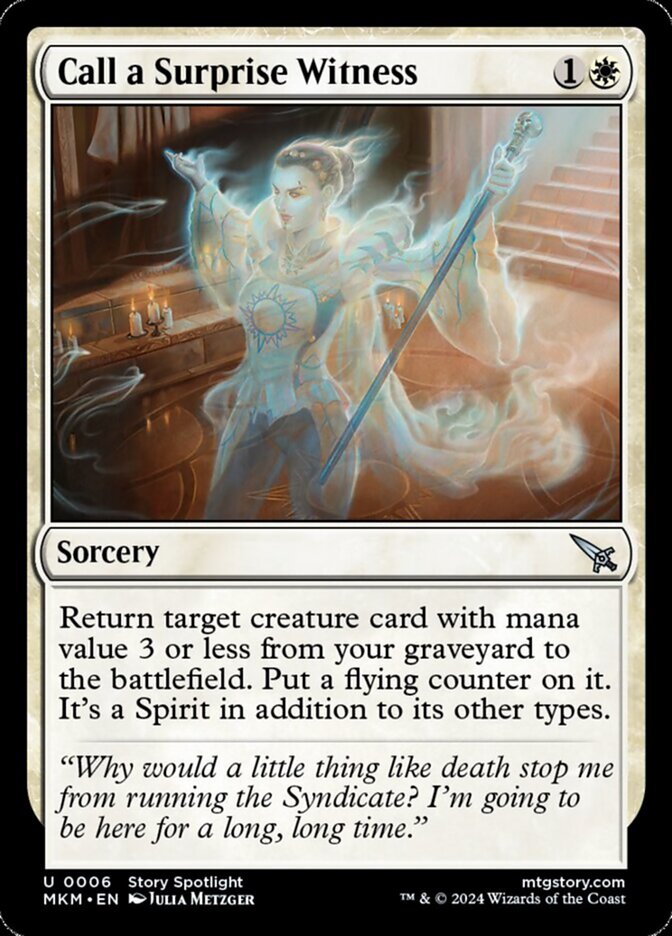
Rating: 3/10
These 2-mana “reanimate a small creature” spells have been fine in recent sets. Getting back a creature and giving it flying with Call a Surprise Witness should be a good upgrade on the formula, but not so much that you’d now be inspired to play this effect if you didn’t like it in the first place.
Case File Auditor

Rating: 1/10
This is a cute effect to have, but there are only about a dozen cases in the set, all at uncommon or higher, so I don’t see how Case File Auditor can possibly come together.
Case of the Gateway Express
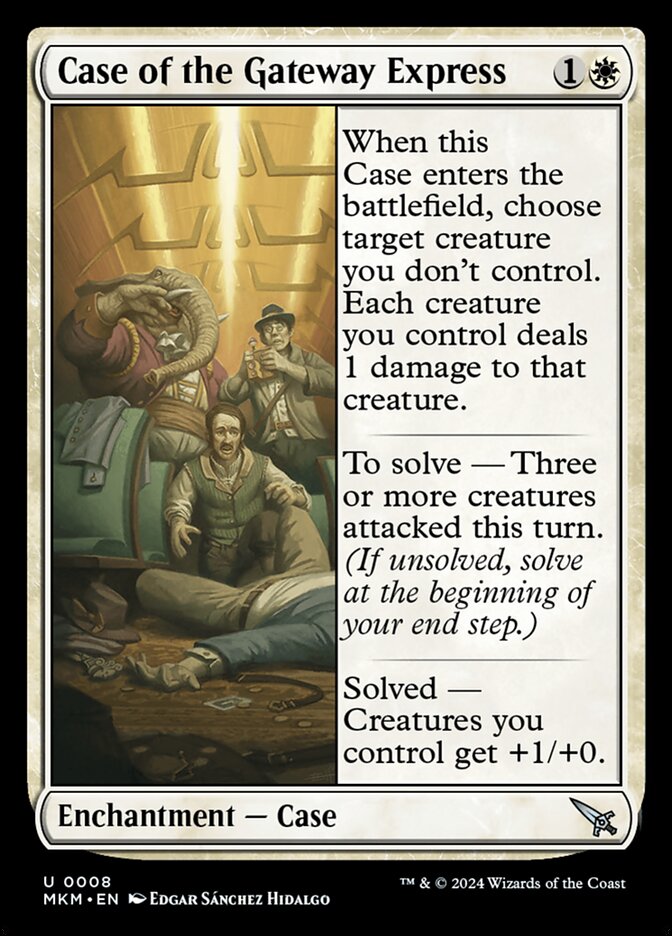
Flavor: 10/10
Rating: 6/10
I absolutely love Murder on the Orient Express. Few murder mystery stories are quite as iconic as this masterpiece, and Case of the Gateway Express is perfectly designed. I won’t spoil it for you if you don’t know the story, but trust me, this is brilliant. The card itself is also just good. It’s a very conditional removal spell, but one that’s very proactive, making it perfect for aggro decks, which is exactly the kind of deck that makes the most use out of the rest of the card, too.
Case of the Pilfered Proof
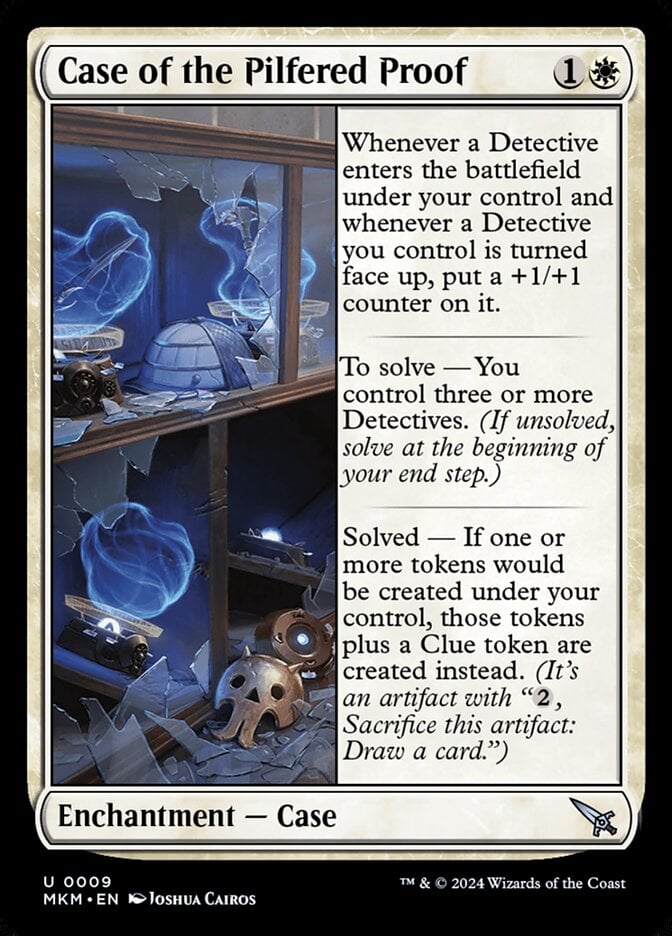
Rating: 3/10
This card is kind of all over the place. Getting +1/+1 counters on all your detectives is good, but it only works if you can play Case of the Pilfered Proof early. It’s probably reasonably easy to solve, but all it does is double up your investigate abilities. Investigate is already great, so we don’t really need to make it better. I’d only want this in a very particular kind of deck, and even then it’s not a high priority.
Case of the Uneaten Feast
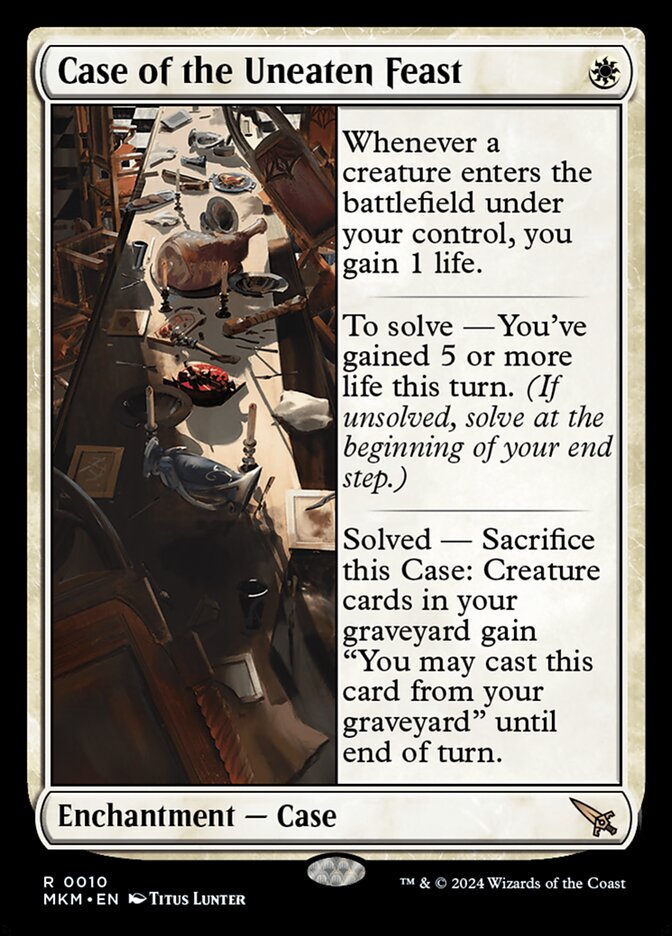
Rating: 5/10
Okay, Case of the Uneaten Feast is a very conditional 5/10. The first ability that you get isn’t enough to want to play this card, but the solved ability very much is. This entire card lives and dies by whether you can gain 5 or more life in a turn to solve it. There are some ways to enable that in the set, like Krovod Haunch. I’d absolutely go for it if I thought I could reasonably trigger it, but I don’t know how often it will happen.
Defenestrated Phantom
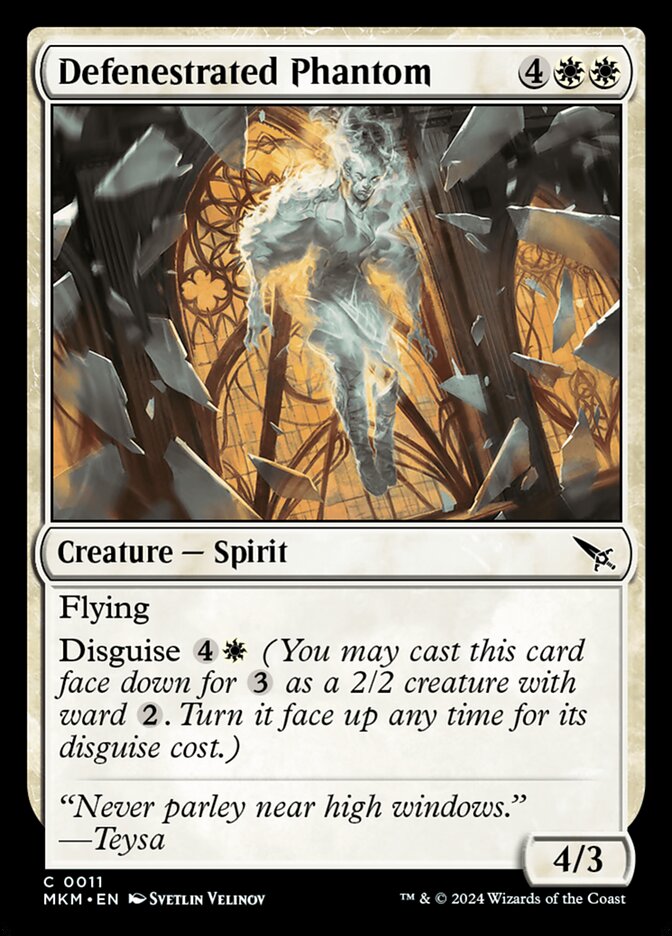
Rating: 3/10
Defenestrated Phantom is a nice, simple disguise creature. It’s always available as a 2/2 for 3 mana, which is great, and it can surprise a lot of players by turning face-up in the late game and smacking them out of nowhere.
Delney, Streetwise Lookout
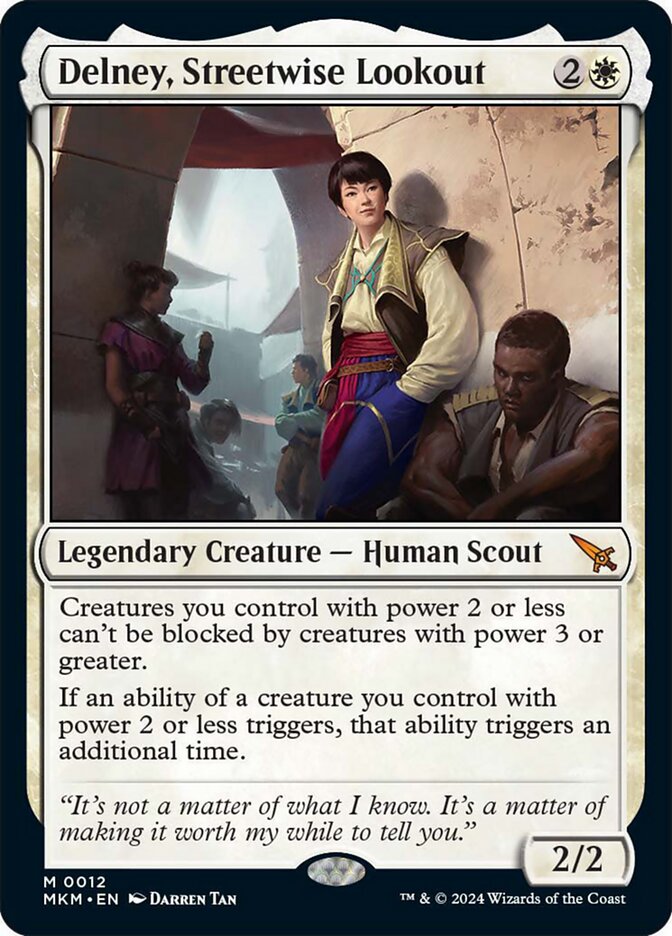
Rating: 6/10
Delney, Streetwise Lookout doesn’t look like it does much, but I think there’s enough here to like. I’m sure you can find enough cool triggers to double, and it really helps to break through board stalls. It’s worth noting of course that all the face-down creatures in this set have ward 2 that’s also doubled.
Doorkeeper Thrull
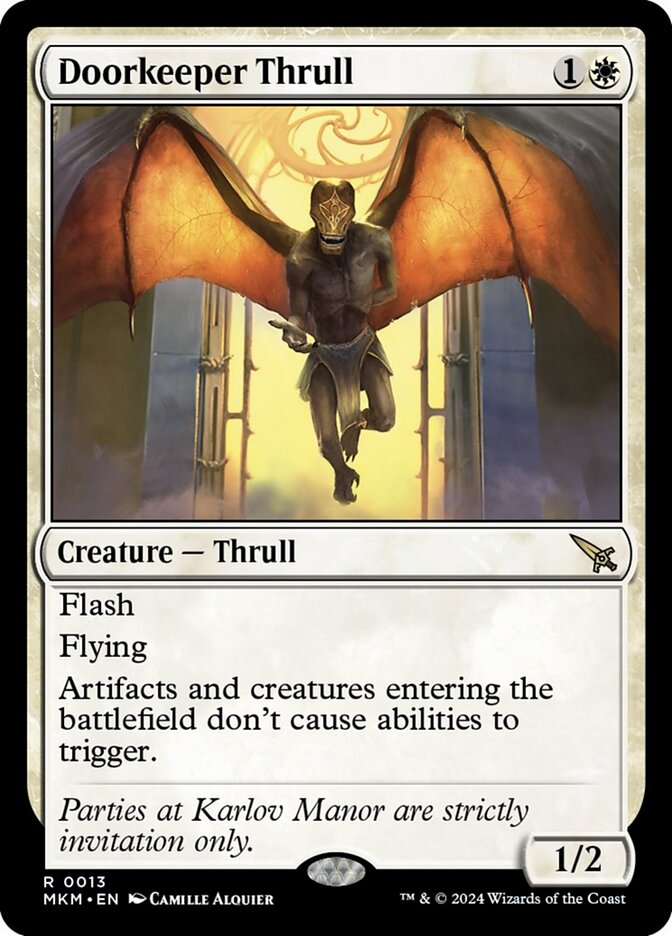
Rating: 3/10
Stopping ETB triggers from artifacts and creatures is really annoying, though not a reliable enough ability to make Doorkeeper Thrull a particularly good card. It’s a 1/2 flash flier for just 2 mana though, so it’s definitely not unplayable. It’s just designed more for Constructed use.
Due Diligence

Rating: 1/10
There are quite a few upsides to this card. It represents 4/4 of additional stats on the turn you play it, essentially with haste, which should let you get a good attack in. But still, for every game where you get a sweet attack in, there’s another one when you play Due Diligence, your opponent has a Shock, and you get blown out.
Essence of Antiquity
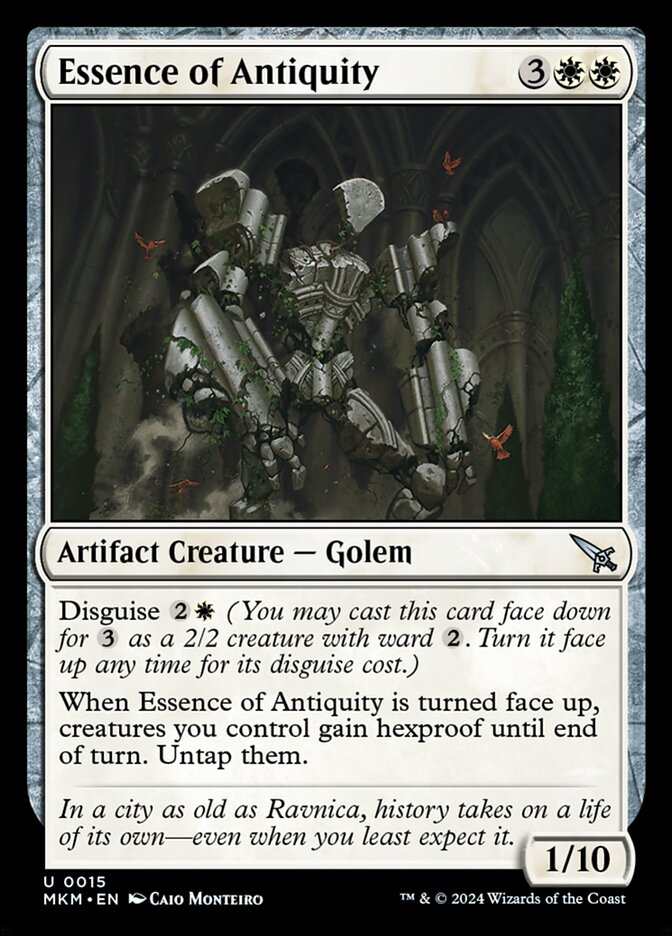
Rating: 4/10
I’m a bit of a sucker for creatures with weird power and toughness combinations, so I love seeing a 1/10. Essence of Antiquity has a situational ability, but not too hard to engineer a nice blow-out scenario. Also worth noting that this is a great way of enabling The Pride of Hull Clade, which is something I’m very interested in making work.
Forum Familiar

Rating: 4/10
Like Mischievous Pup, this effect can be very useful if timed right. Whether you’re picking up a creature in response to removal or getting to reuse a powerful enters the battlefield trigger, you should find some good uses for Forum Familiar. Plus, it’s a disguise creature, which automatically makes it playable.
Griffnaut Tracker

Rating: 3/10
I really don’t think that the graveyard decks will be any good (I can’t wait to be proven wrong), so I doubt Griffnaut Tracker’s graveyard hate ability will matter all that much. Still, it’s pure upside on top of a Snapping Drake, which is still a fine card for some decks.
Haazda Vigilante
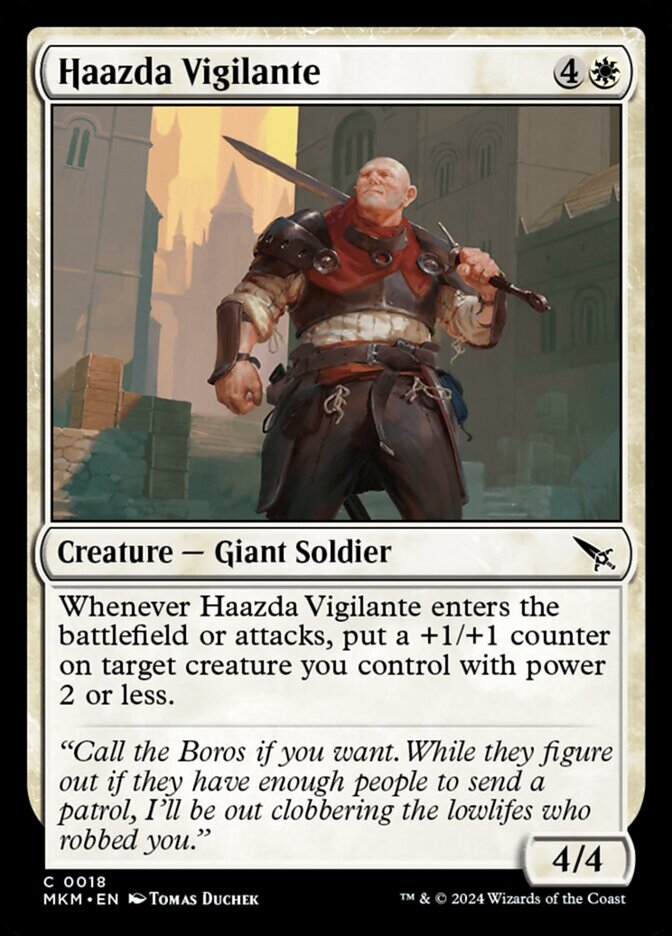
Rating: 2/10
“Technically playable” is a really low bar to clear, and Haazda Vigilante is just big enough that it does that, but not much else.
Inside Source
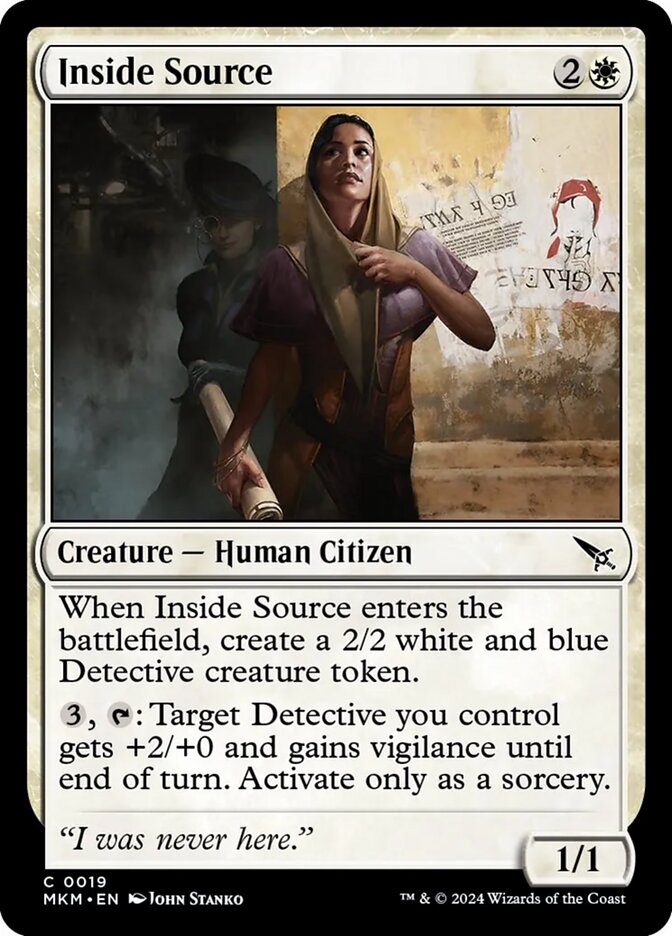
Rating: 5/10
Three mana for a 1/1 and a 2/2 is great. On top of that, the 1/1 has a very relevant ability for the late game. Inside Source also puts two creatures onto the board with 2 power or less, triggering all the relevant black/white abilities. White has some exceptionally good commons, and this is definitely one of them.
Karlov Watchdog
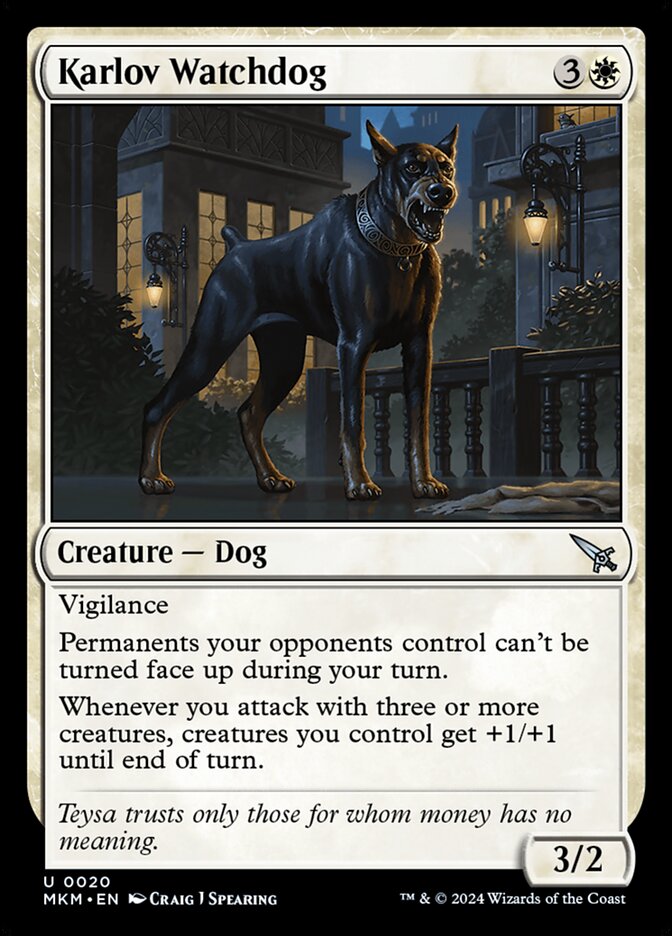
Rating: 4/10
Shutting down your opponent’s disguises is a really unique and potentially very annoying ability. If you attack with three creatures, Karlov Watchdog also forces your opponent to try to trade it off in combat, which puts you in an advantageous position if you have the ability to interact.
Krovod Haunch
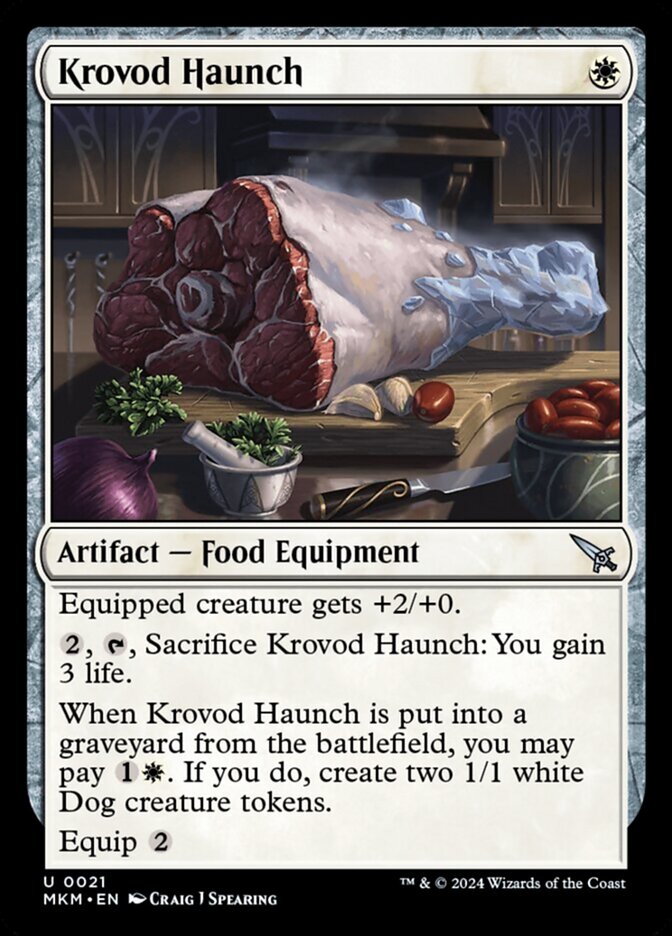
Rating: 5/10
This is such a cool design for a card. I’d be happy if it were just an artifact that you could put into play, then sacrifice to gain some life and create two 1/1s, but it’s also a fairly costed equipment on top of that. I also love that you can sacrifice Krovod Haunch to some other effect and still pay 2 mana to let the dogs out. I think you’ll definitely play this more often than not.
Make Your Move
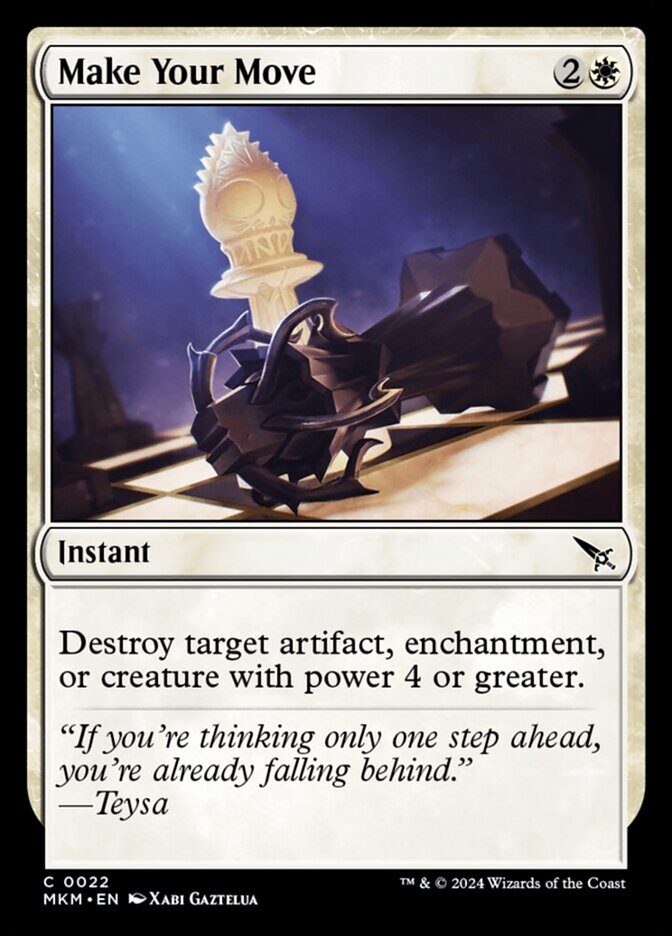
Rating: 3/10
Destroy an artifact, kill an enchantment, or get rid of a big body, all combined into one card? Yeah, I like that. I think I’d be happy running a Make Your Move in my main decks, and depending on how the format shapes up, you might be happy with more. No matter what, this is an exceptionally good sideboard card.
Makeshift Binding
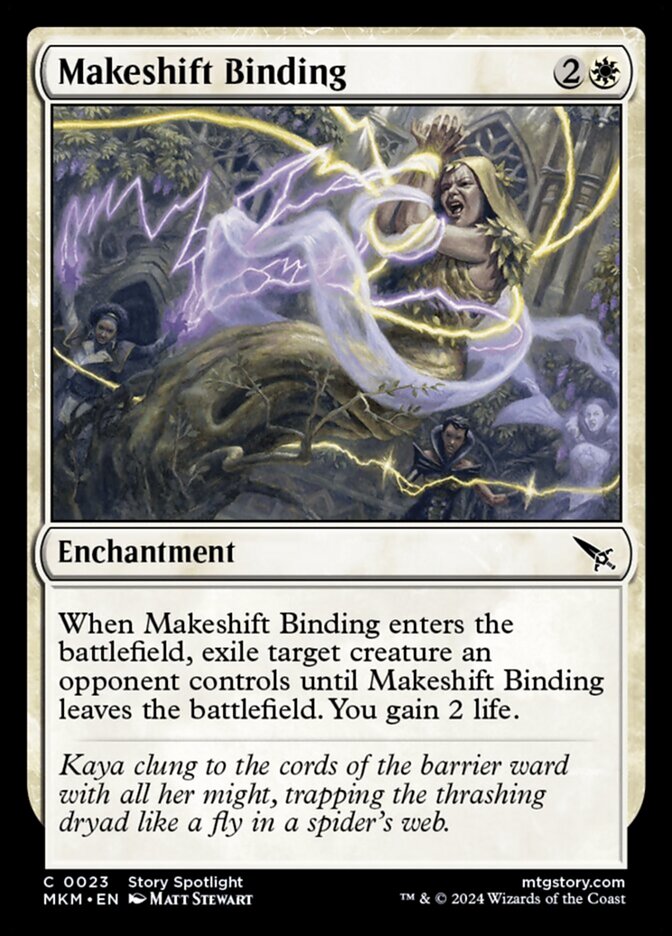
Rating: 5/10
Three mana to answer any creature and gain some life with Makeshift Binding is very good. Banishing Light is always a powerful removal spell, even if it can only hit creatures.
Marketwatch Phantom
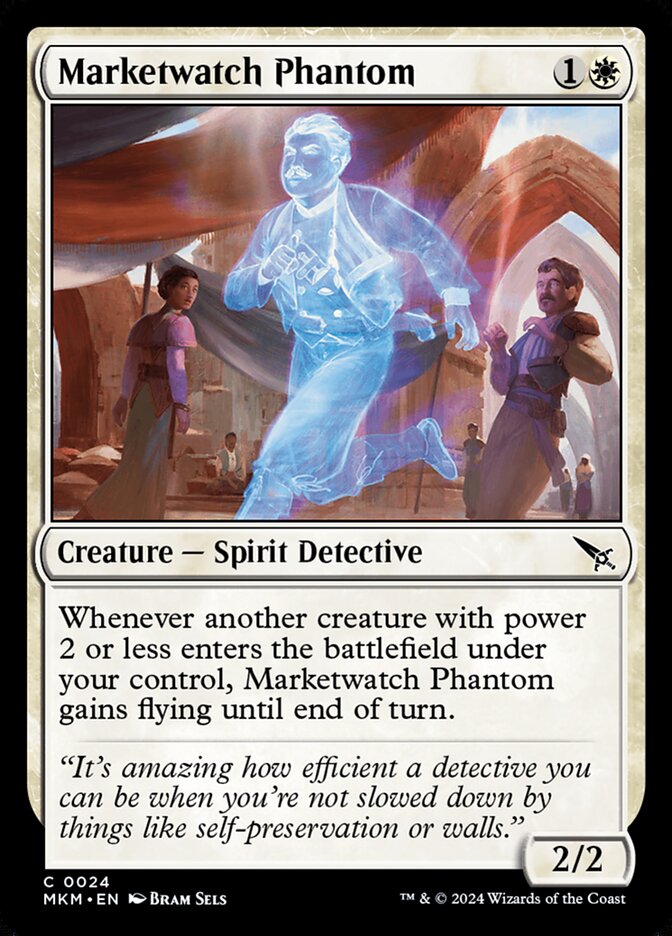
Rating: 5/10
Marketwatch Phantom feels a lot like the second coming of Gust Walker, one of the most aggressive 2-drops we’ve ever seen. You may not be able to control when this can fly quite as well, but the prevalence of disguise and cloak mean that you should be able to trigger this quite often, making it one of the best early plays you can make.
Museum Nightwatch

Rating: 4/10
This just looks like a great common all round. Four mana for a 3/2 that dies into another 2/2 is just really good on rate. Disguise is a nice touch too. You can cast Museum Nightwatch face-down, then flip it over when your opponent expects to simply trade, and you get your 2/2 Detective token out of the deal. Very nice.
Neighborhood Guardian
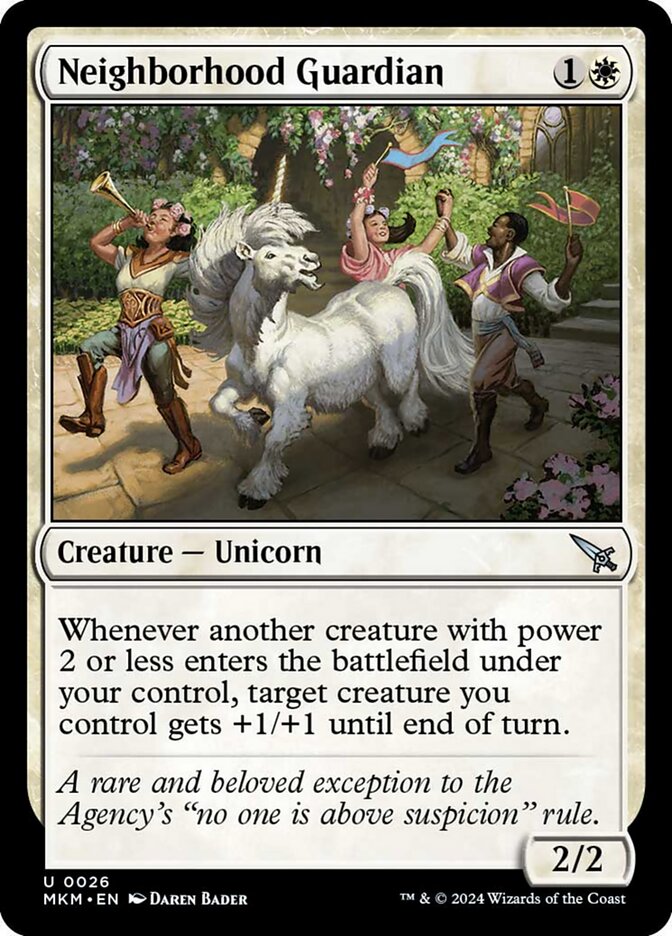
Rating: 4/10
Neighborhood Guardian is just adorable, and pretty solid too. These +1/+1 bonuses each turn should make it easy to swing combats in your favor or help you to get your disguised creatures over your opponents’ ones. I don’t like that it doesn’t trigger when you play it, but I guess we can’t have everything.
No Witnesses
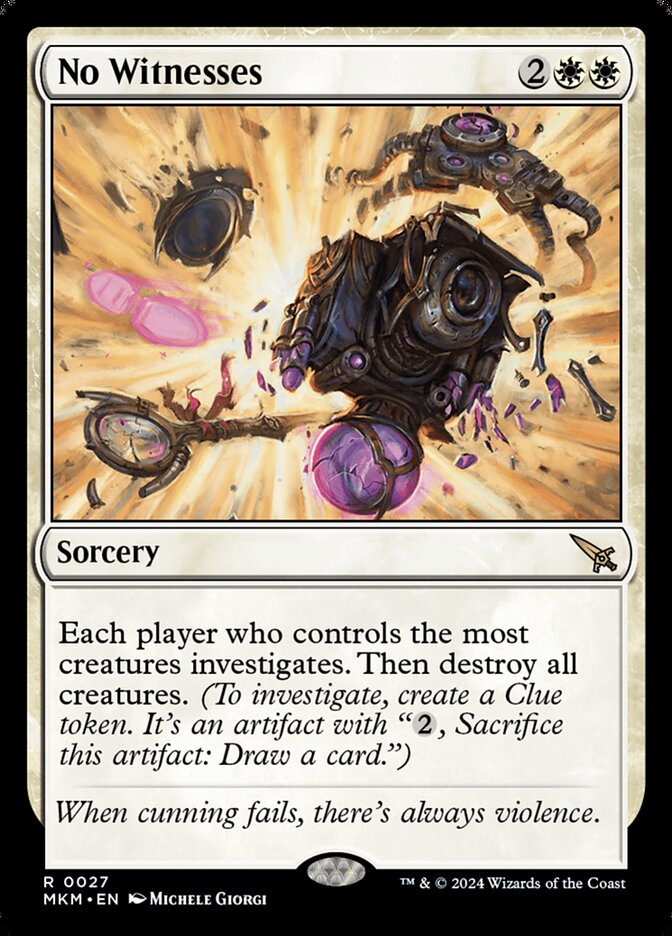
Rating: 8/10
This is the latest in a long line of “Day of Judgment needs a little downside” cards. At the end of the day, board wipes are good, especially because if you know it’s coming, you can hold back your creatures, let your opponent overextend, and clean up the board from there. Having your opponent investigate isn’t all that relevant if No Witness trades for several creatures.
Not on My Watch
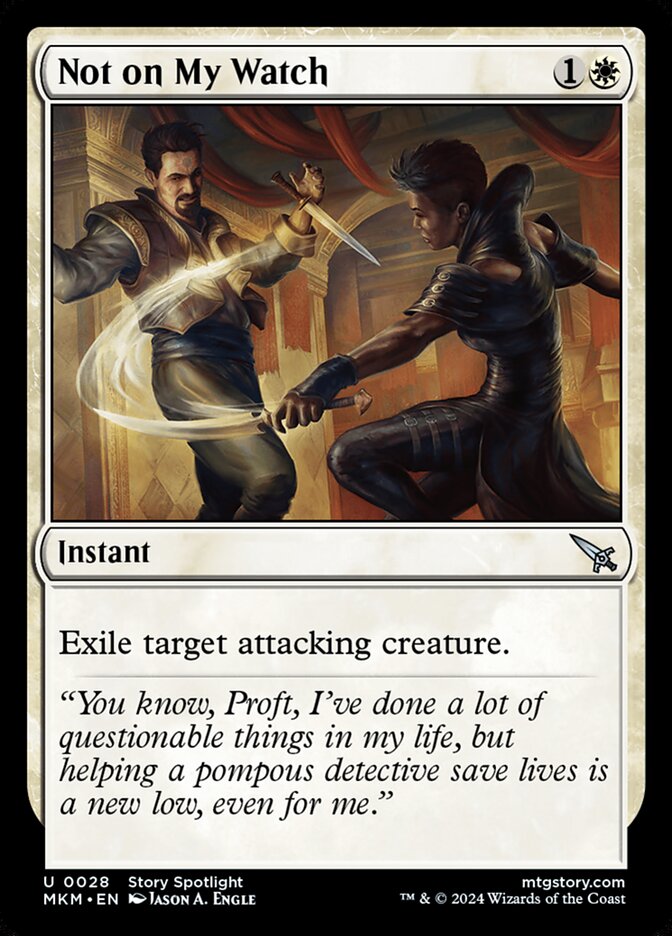
Rating: 5/10
I’m a fan of nice, clean removal spells. Two mana to exile any attacker is pretty great, but it’s pretty useless in an aggressive deck, since most of the time you’ll want to press your advantage, or your opponent’s creatures will be left back to block. Still, if you’re a slower, more controlling deck, Not on My Watch looks like exactly what you’re after.
Novice Inspector
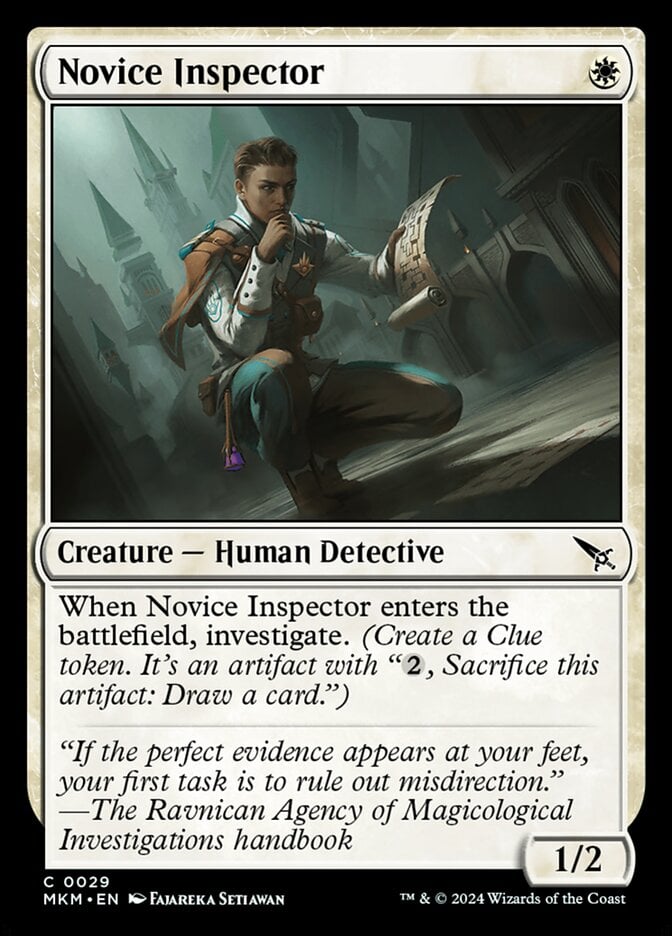
Rating: 6/10
Yes, you heard me. Novice Inspector is an easy 6, maybe even a 7. Thraben Inspector is one of white’s best 1-drops ever, so to see a functional reprint of it isn’t something I expected to see in this set. I’d be happy with any number of these in any white deck, investigate is just that good on a cheap creature. It’s just very good.
On the Job

Rating: 3/10
Inspired Charge is always a card I’m happy to play in a go-wide deck since it can finish games really quickly. On the Job works just the same, but you can also fire it off earlier without worrying since it replaces itself with investigate. This could even generate you a two-for-one blowout, which is something I’m always eager to keep an eye out for in Limited.
Perimeter Enforcer
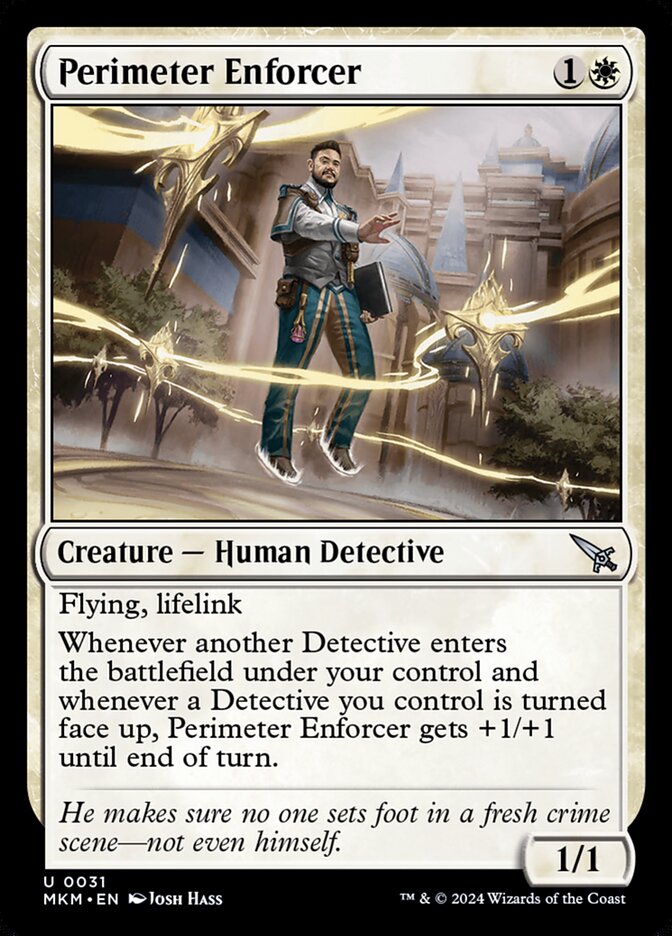
Rating: 4/10
Never underestimate the cheap flying lifelinker. Perimeter Enforcer will often be able to attack as a 2/2 in the right deck, and the combination of flying and lifelink makes it absurdly hard to race. It’s also great at carrying equipment. There are some better 2-drops in the set, but this is definitely up there.
Sanctuary Wall
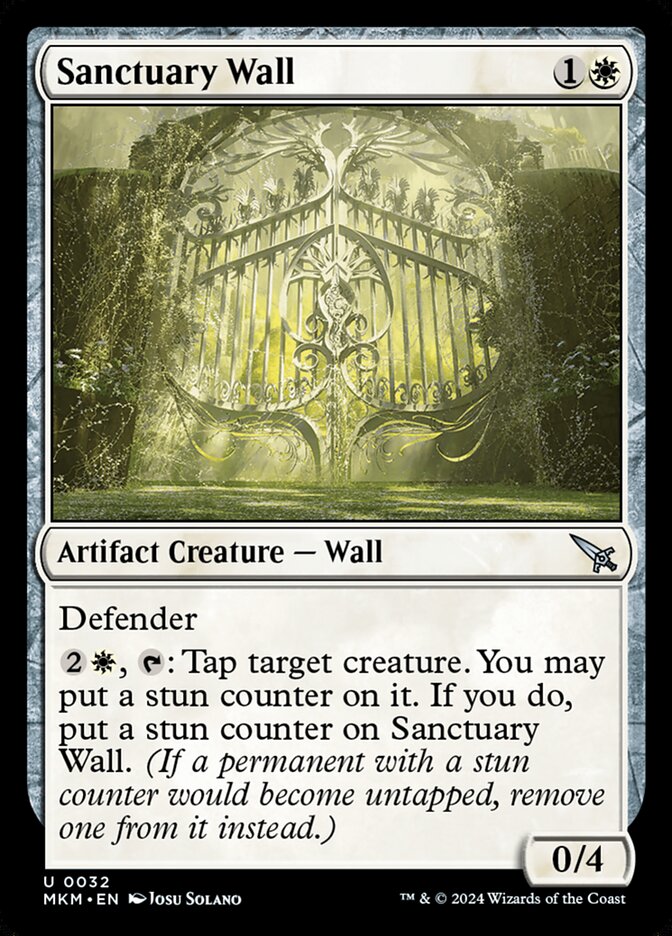
Rating: 2/10
These modern creature tappers look so bad. Was Gideon's Lawkeeper really that overpowered? Oh wait… yeah, it was. To be fair though, Sanctuary Wall is probably quite a bit better than others we’ve seen recently. Choosing to put a stun counter on this defending wall means you only need to pay mana every other turn to keep your opponent’s best thing tapped down. It’s still not good enough to be exciting, but it’s better than other recent versions at least.
Seasoned Consultant
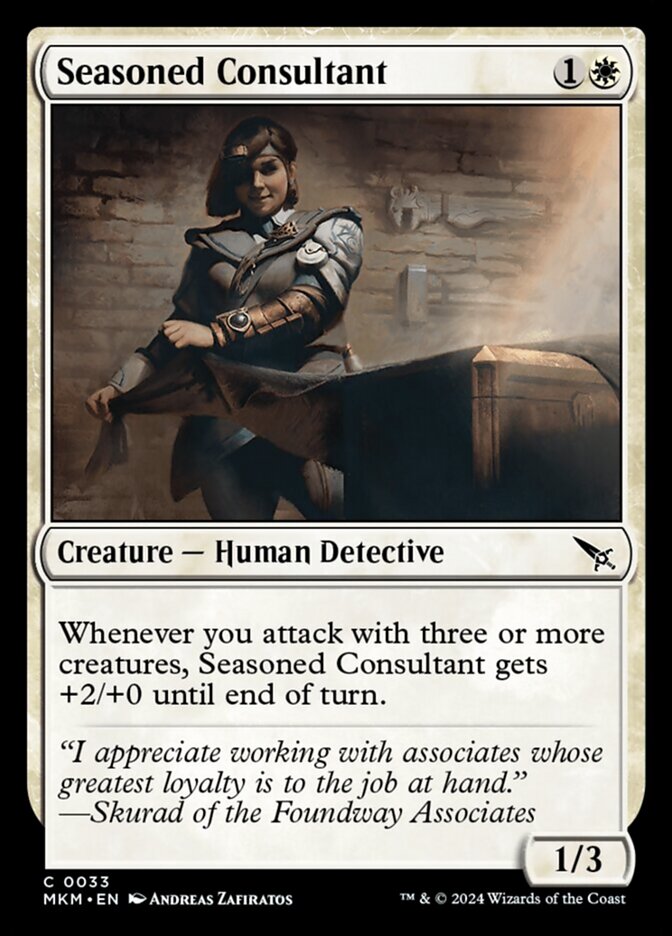
Rating: 2/10
If you’re attacking with three creatures, then being a 3/3 isn’t bad. But being a 1/3 when you’re not is actually really bad. Seasoned Consultant is just the quintessential definition of a weak, replaceable common.
Tenth District Hero
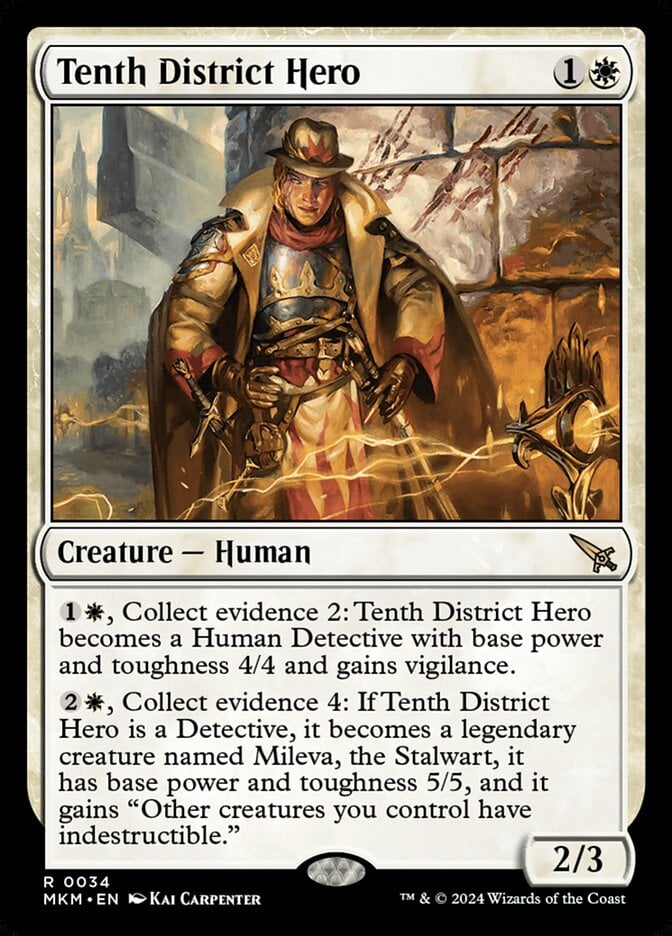
Rating: 6/10
Tenth District Hero is probably something you can convince me on with collecting evidence. You get a very real upgrade for activating these abilities, and the evidence numbers are pretty low, so I think you’ll be able to do this pretty easily. Not to mention that a 2/3 for 2 is very good in a format full of 3-mana 2/2s.
Unyielding Gatekeeper
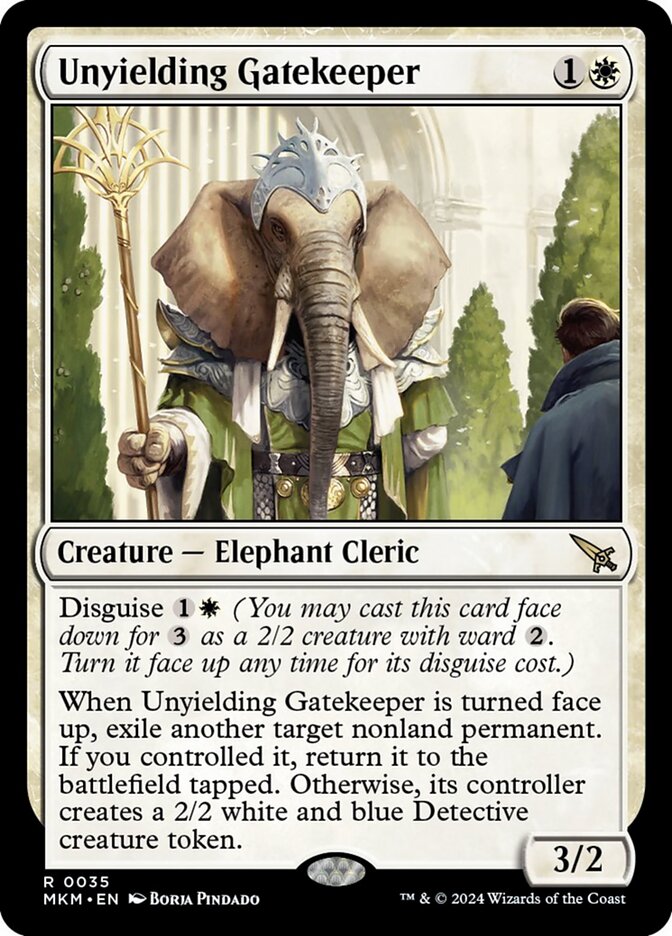
Rating: 6/10
I like the combination of options this card gives. Unyielding Gatekeeper can be a 3/2 for 2 if that’s what you need. By disguising this cleric, you can flicker a creature to save it from removal or swap out a big opposing creature for a 2/2 token. Also worth noting that flicker effects are very powerful in a set with face-down creatures, allowing you to effectively flip them up for cheaper than usual.
Wojek Investigator
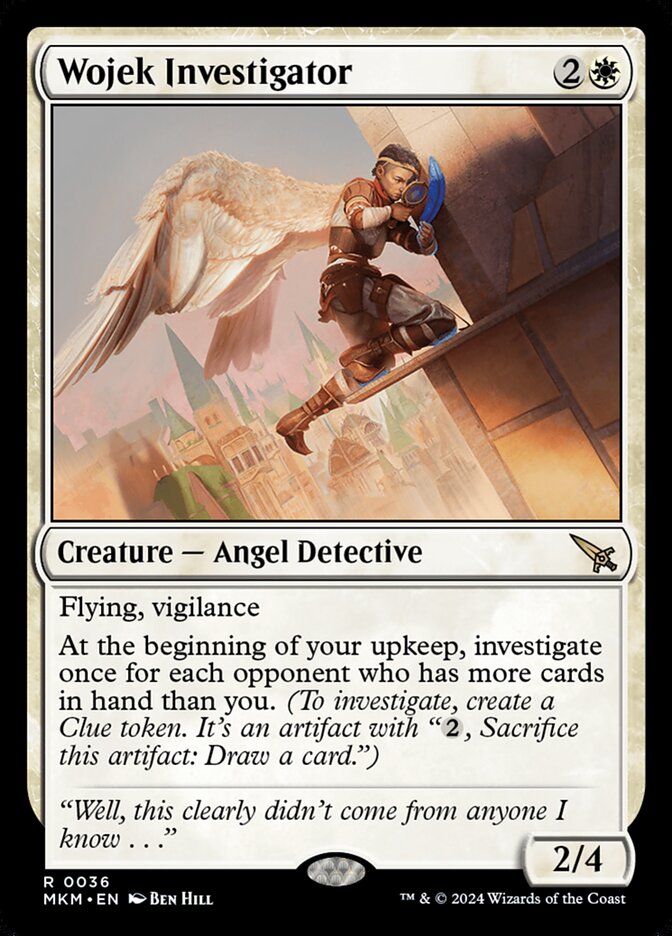
Rating: 8/10
Assuming you’re an aggressive deck, this angel‘s ability should be very easy to make work. Just prioritize getting all your creatures onto the battlefield and empty out your hand so that Wojek Investigator can churn out Clue tokens every turn. Heck, even if that’s not doable, this is a 2/4 Serra Angel for only 3 mana. It just does it all.
Wrench
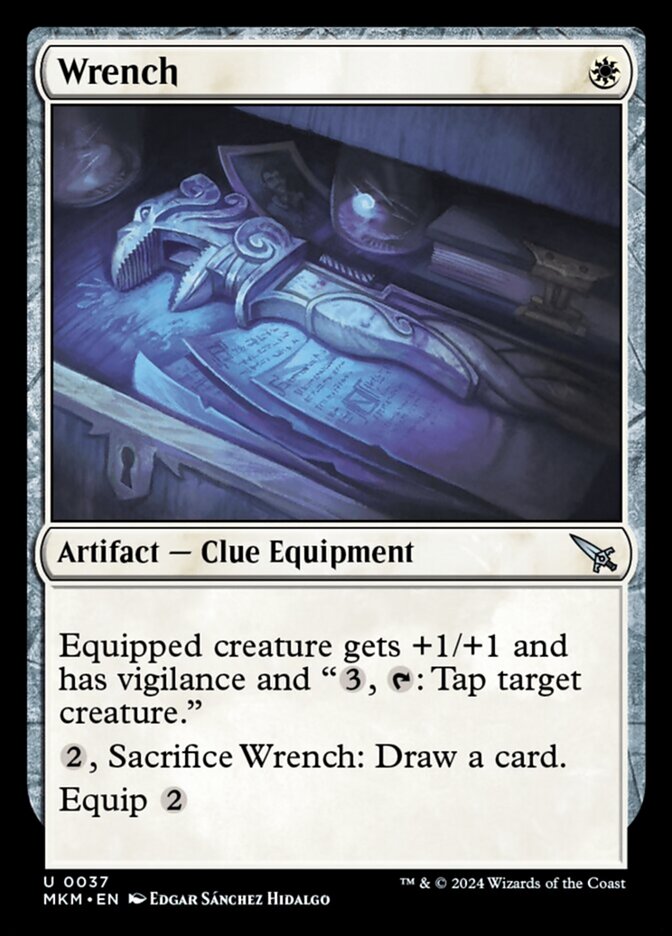
Rating: 3/10
I’ll be saying this a lot in regards to the Clue(do) weapons in the set, but they’re all kind of weak equipment with the very nice buyout option of being cheap clues. I’d be happy playing Wrench in most decks, but especially detectives, where I can make the most use of the clue half of it.
Blue
Agency Outfitter
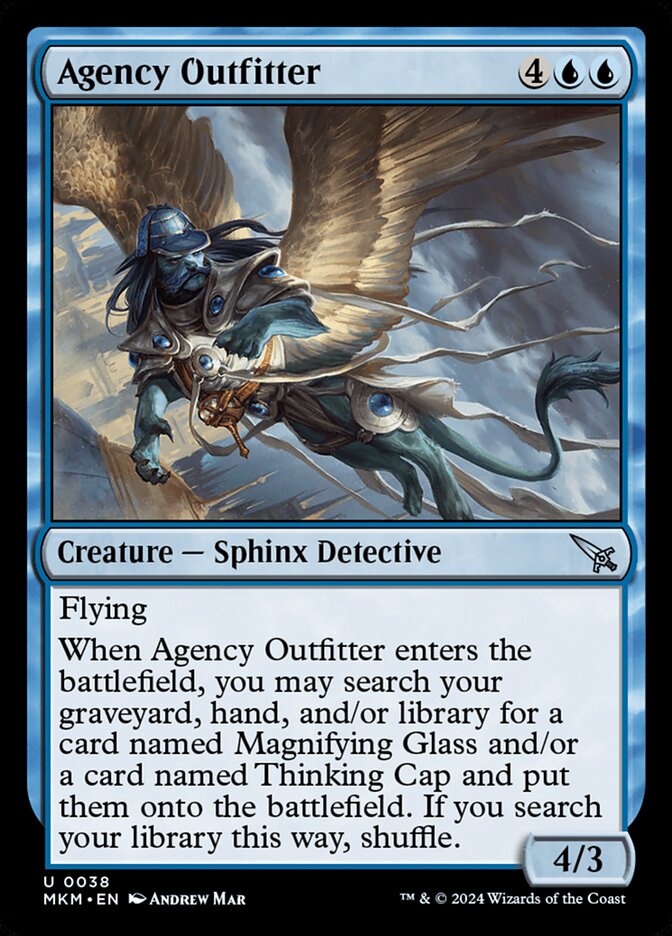
Rating: ?/10
This card is very hard to give a rating to. Agency Outfitter isn’t playable if you don’t have any Magnifying Glass or Thinking Cap, but it does seem actively good if you do have them. As it’s a detective, you’ll also get to immediately equip the Thinking Cap using the mana from the Magnifying Glass, immediately turning this into a 5/5 that draws you two relevant cards.
Behind the Mask
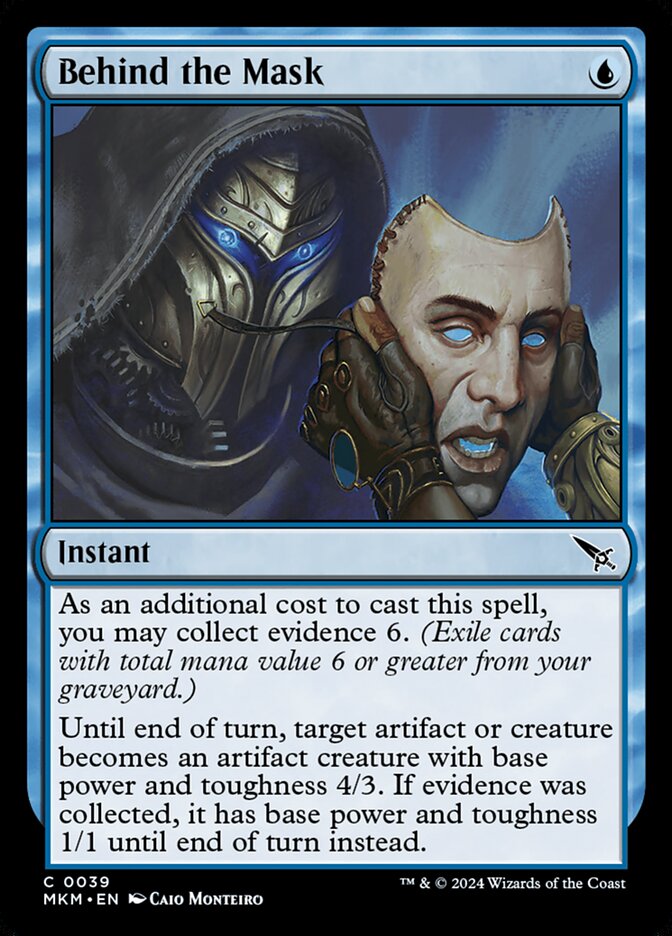
Rating: 1/10
You can only collect evidence a couple of times during a game, so why would I ever want to waste it on Behind the Mask? No matter which mode you get, this is just a bad card that I’m sure you might die to once in the whole format and never see again. Just do yourself a favor and leave this in the sideboard.
Benthic Criminologists

Rating: 2/10
Drawing cards is nice and all, but you’re most likely going to sacrifice that artifact to draw a card anyway. Benthic Criminologists needed to be better than a 4/5 for 5 to be interesting, but as it is, it just seems replaceable.
Bubble Smuggler
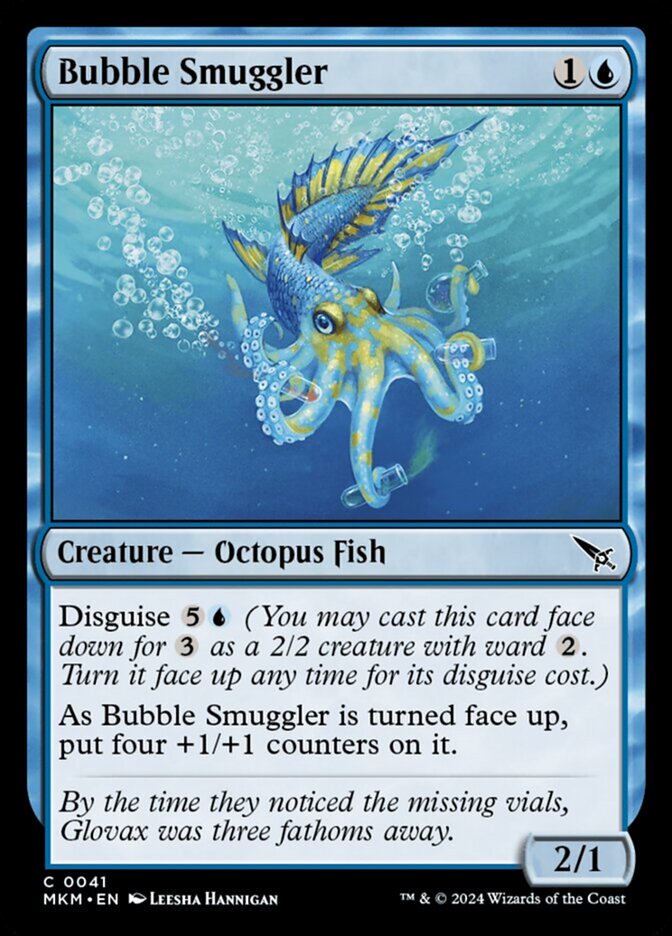
Rating: 2/10
Your choice of a 2/1 for 2, or a 2/2 ward 2 for 3 that can turn into a 6/5. That’s not the best, but being a disguise creature does make Bubble Smuggler playable. It reminds me a lot of Glacial Stalker, and that was a card that ended up a lot better than it looked on paper. Maybe this will be better than it looks, too.
Burden of Proof

Rating: 4/10
Flash auras are pretty cool, giving you a lot more control over when they’re played. They become combat tricks that stick around after use, and this one being just 2 mana to cast makes it really appealing. Burden of Proof is a little restrictive in its application, but in the right deck you should still find plenty of situations where it works nicely.
Candlestick
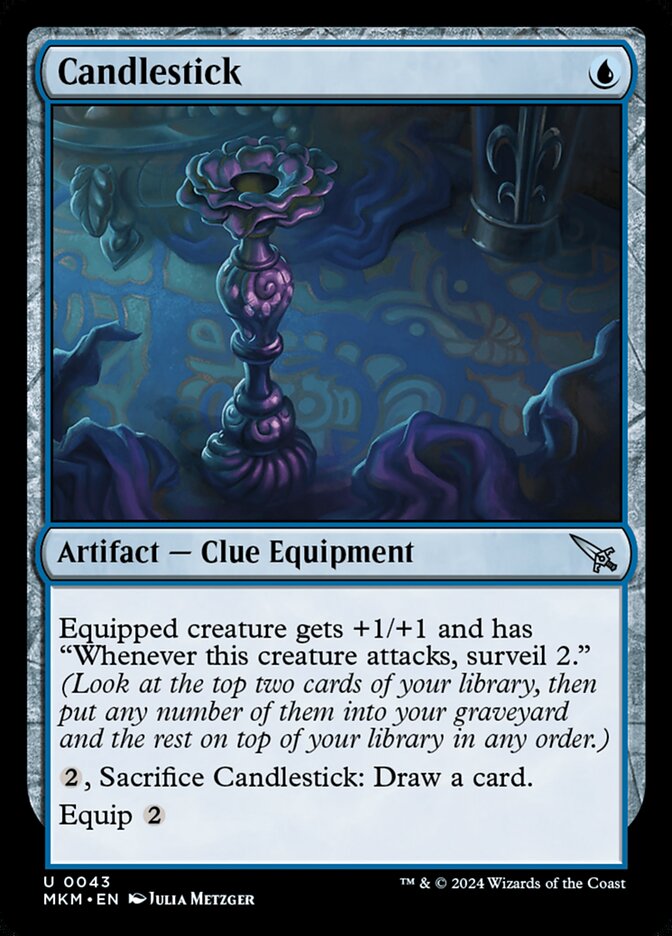
Rating: 4/10
While the equipment side of Candlestick isn’t doing a great deal, 1-mana artifacts in a set that cares about them to some extent should always end up playable. Clues are very relevant, and getting one for 1 mana is a great deal, so I’d be very surprised if this didn’t see any play.
Case of the Filched Falcon
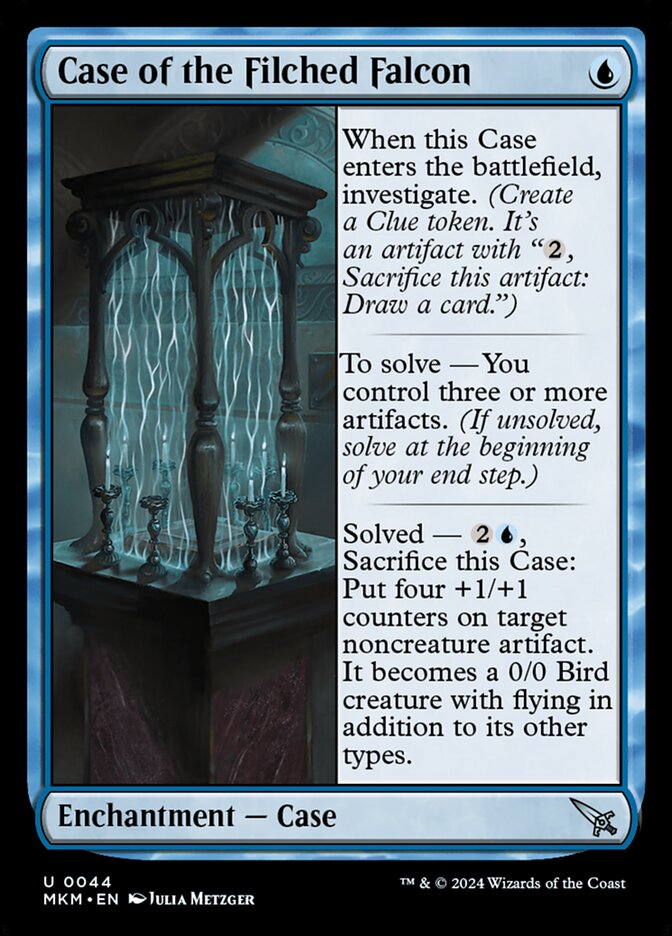
Rating: 7/10
Assuming you have plenty of artifacts and can solve this quickly, it looks great. One mana to get on board and investigate, but then getting to turn a clue (or whatever else) into a 4/4 flier for an absurdly low cost is just incredible. You could even get Case of the Filched Falcon going as early as turn 2, thanks to Gleaming Geardrake. If you do this on a clue, you can even leave open the 2 mana needed to sacrifice it and draw, in case your opponent has removal for it. This is so much value in a single card, it just has to be good.
Case of the Ransacked Lab
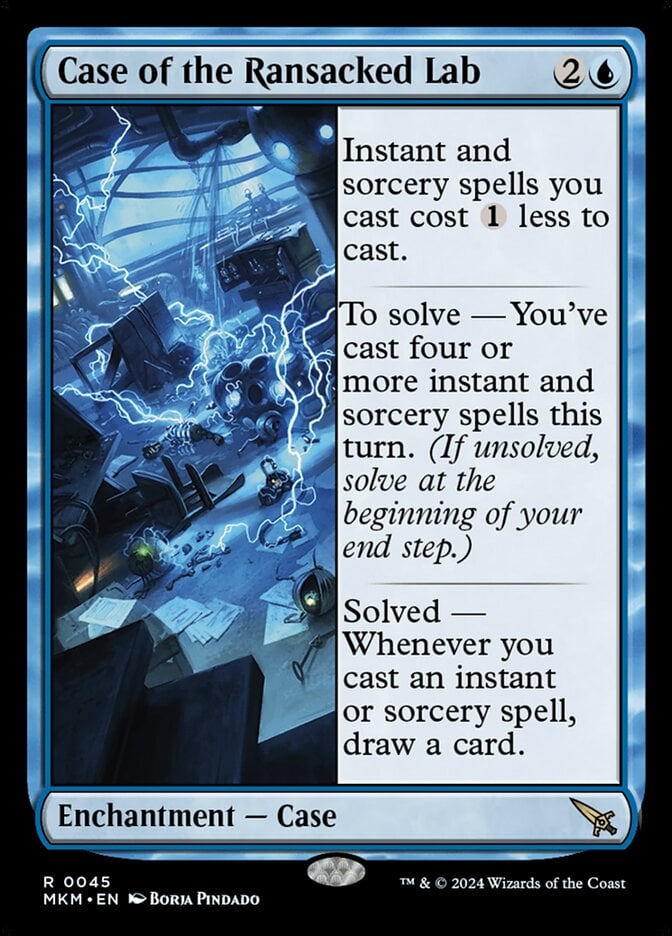
Rating: 0/10
Case of the Ransacked Lab looks like such a cool card to build around in Constructed. I might even see if it can earn a slot in Pioneer Izzet Phoenix. But yeah, you can’t get any of these abilities to work in Limited.
Cold Case Cracker
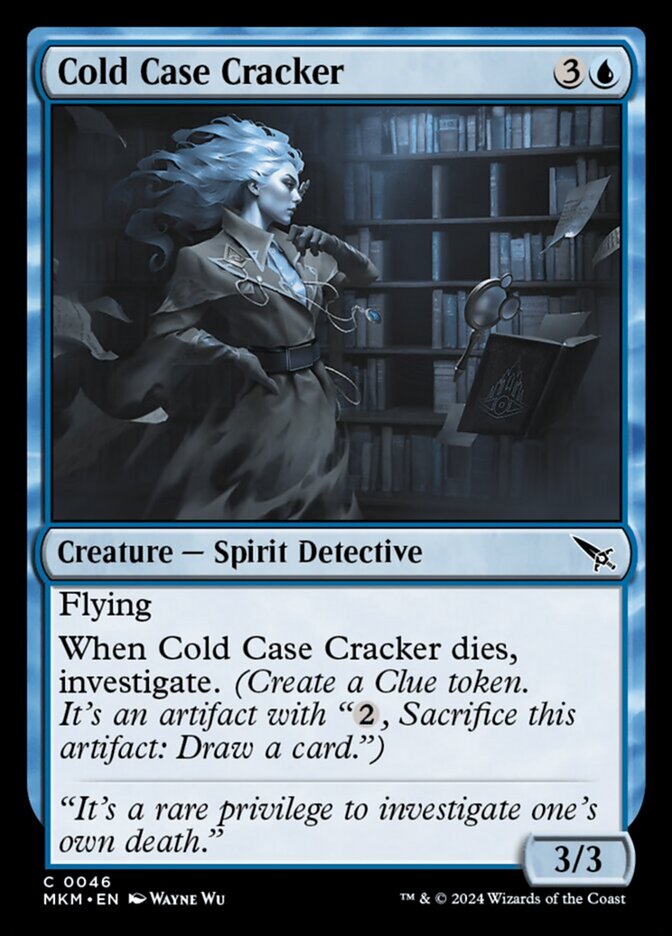
Rating: 5/10
Perhaps it’s pure nostalgia that keeps me enamored with Phantom Monster variants, but I feel like other content creators and streamers don’t like them, but then I keep seeing them overperform. Of course, a free Clue when Cold Case Cracker dies is a great upside, but I’m just very happy with a 3/3 flier for 4 mana.
Conspiracy Unraveler
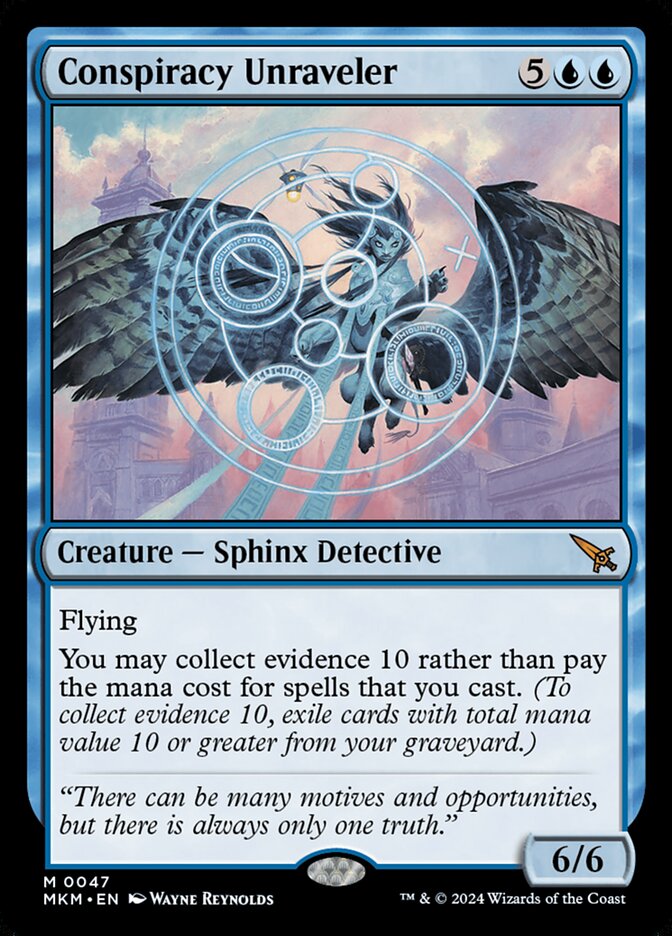
Rating: 4/10
This is a pretty cool line of text, but is it even that good? You won’t be comboing off with Conspiracy Unraveler like you potentially could in Constructed. Most likely, the best you can do is cast this and then cast one more spell for free, which is okay. But between “collect evidence 10” being quite hard to enable and you likely not having a lot of cards left by the time you can play a 7-drop, I don’t think you’re likely to do much else.
Coveted Falcon
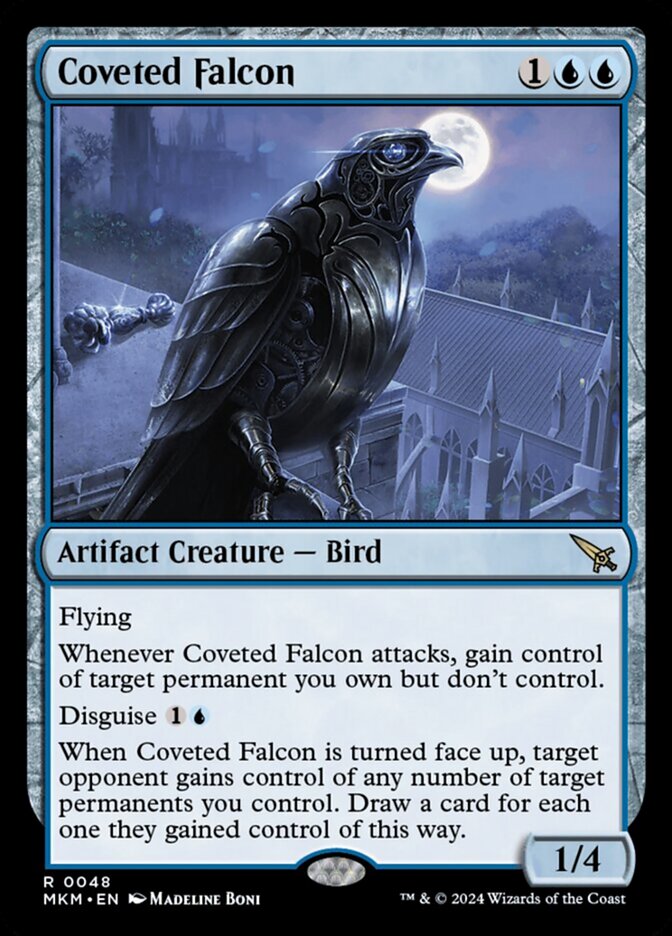
Rating: 5/10
What a quirky design. The obvious thing to do here is to Donate a land or something to your opponent, draw a card, then steal it right back. Other than that, Coveted Falcon isn’t doing much. I essentially want to look at this as a disguise 1/4 flier that draws you a card when you flip it over, which is okay, but hardly game breaking. I doubt you’ll get the opportunity to do much else with it.
Crimestopper Sprite
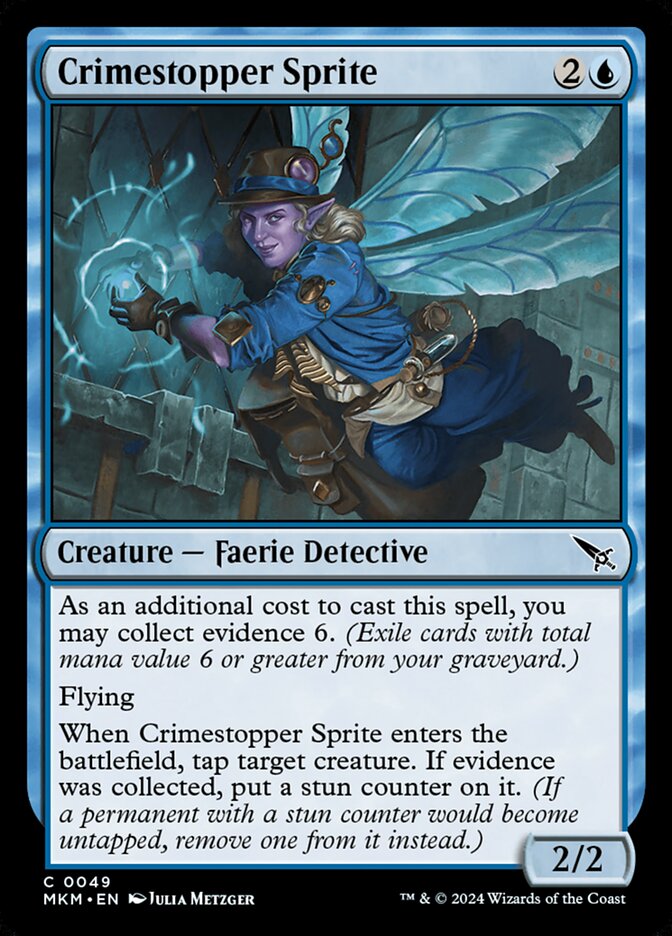
Rating: 4/10
I just don’t think you’ll be able to collect evidence 6 with any kind of reliability. That said, Crimestopper Sprite is still a Wind Drake with some upside. Even just tapping a blocker for one turn is good enough that I’d want this in plenty of decks, it’s just not likely to become a fully-fledged Frost Trickster.
Cryptic Coat
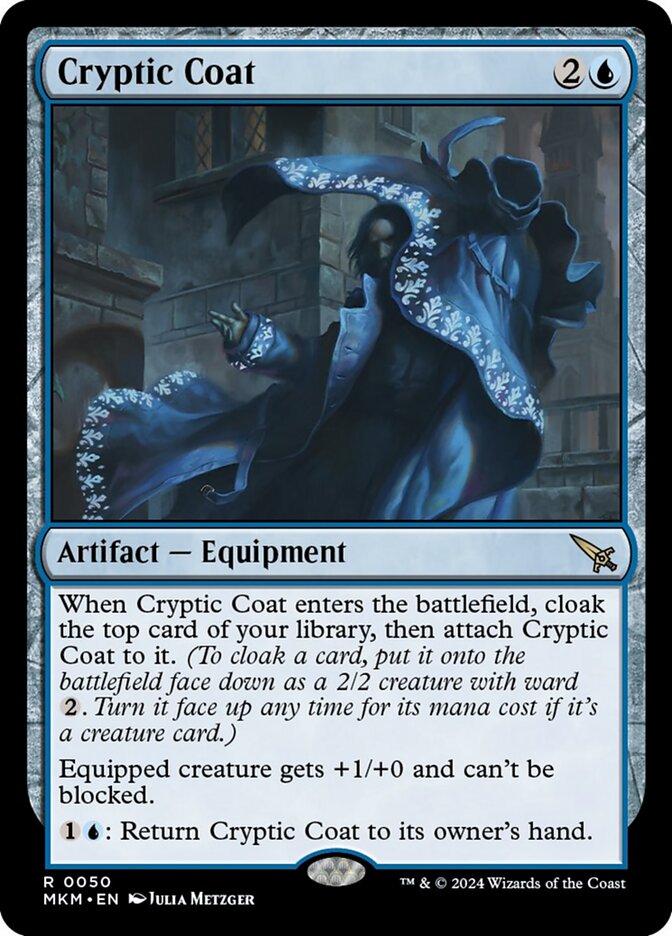
Rating: 10/10
Are you being serious right now? Cryptic Coat is flat out disgusting. It gives you a 3/2 unblockable creature right off the bat. Your opponent has to deal with it, or you can keep this back to block and trade, plus you can turn the cloaked creature face up if you hit something nice. But what really makes this go nuts is the fact that you can keep bouncing the Coat to your hand and replaying it to keep cloaking new creatures. It’s basically everything I’m looking for in a 10/10.
Curious Inquiry
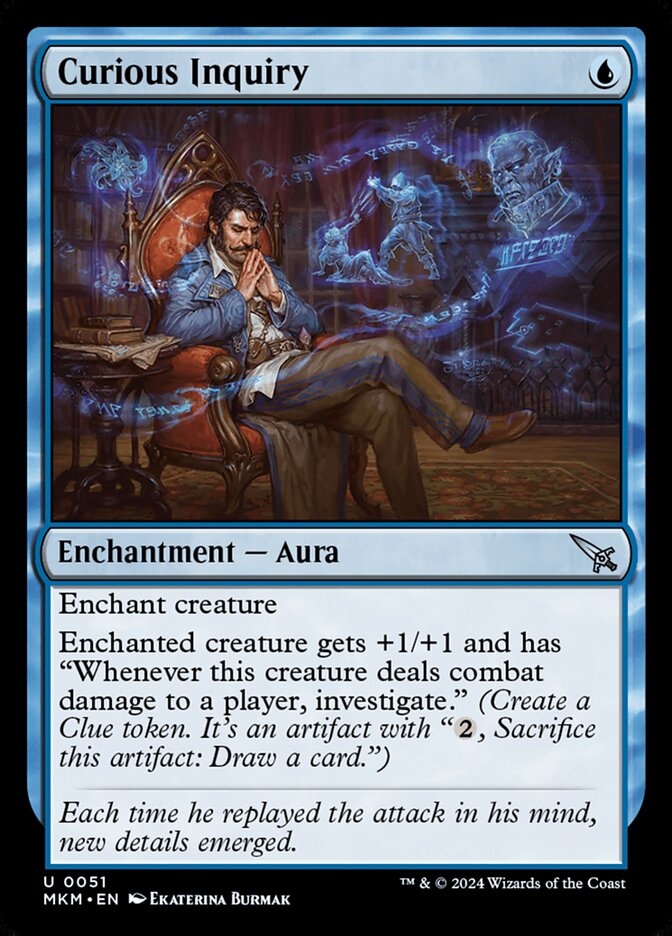
Rating: 5/10
This is likely one of the better Curiosity variants that we’ve had. +1/+1 is a nice buff to help your enchanted creature get its attack through a blocker, and investigating gives you a lot more synergy with the set’s mechanics and archetypes. I’d recommend not just jamming Curious Inquiry without thinking, but once you’ve gotten just one hit in, it’s already replaced itself.
Deduce
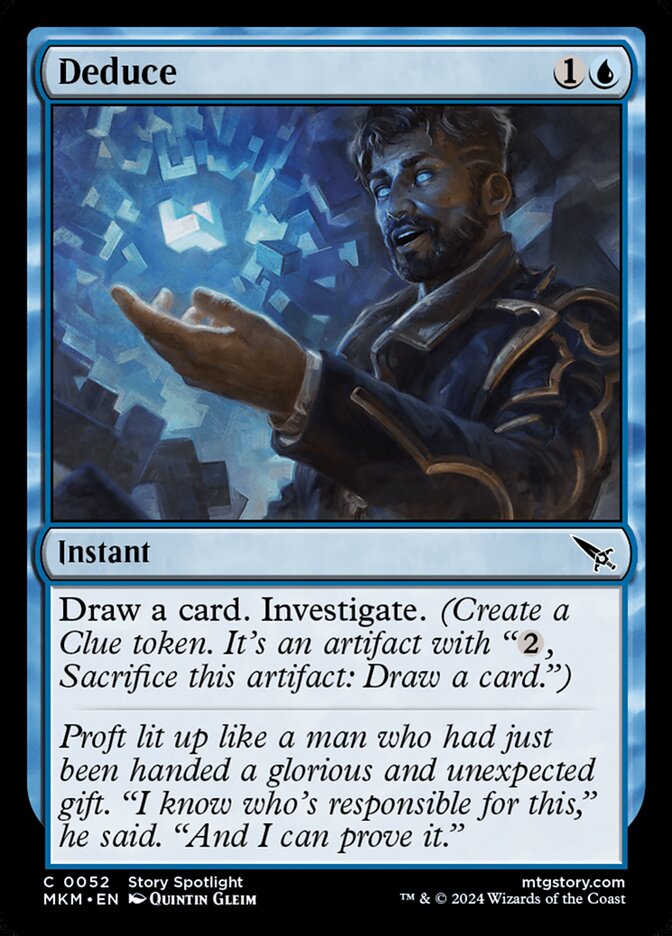
Rating: 3/10
I like drawing cards, but I just don’t know how many decks will be willing to spend their time doing this over playing something that directly affects the board. Assuming that I’m in an archetype that actively wants the Clue token, I’d probably be able to find room for Deduce.
Dramatic Accusation
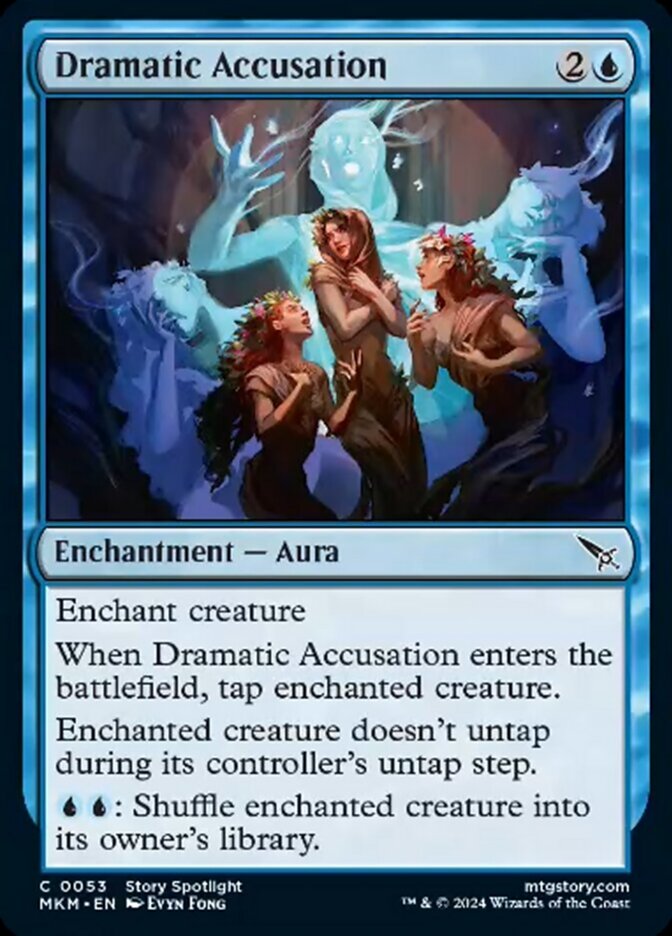
Rating: 4/10
It’s been a while since Claustrophobia has been playable, but adding in the ability to “permanently” deal with the enchanted creature should be enough to make Dramatic Accusation good. Blue is the weakest color in Limited when it comes to removal spells, but this one should at least be decent.
Eliminate the Impossible

Rating: 6/10
“Once you have eliminated the impossible, whatever remains, however improbable, must be the truth.” Blue combat tricks kind of suck, but a cheap combat trick with investigate on it is really good. Better yet, Eliminate the Impossible has the potential to be a real blowout, letting you ambush multiple creatures as well as replacing itself.
Exit Specialist
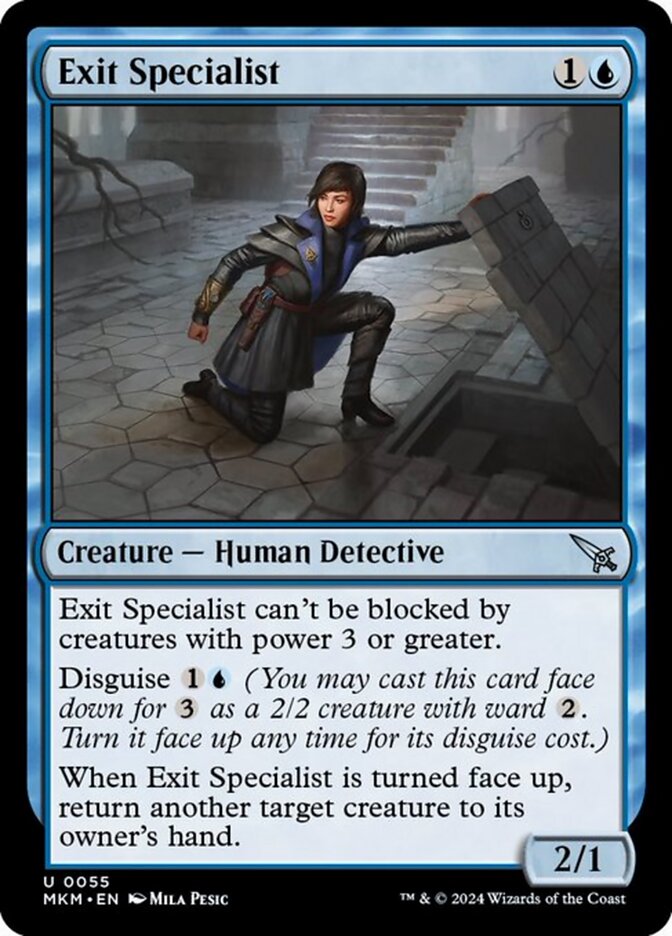
Rating: 6/10
Naturally, what I’m paying attention to here is the fact that Exit Specialist is a simple disguise version of Man-o'-War, which in this set should be extremely good. Many disguise creatures require a heavy mana investment, so bouncing them once your opponent has spent 8 or 9 mana on them is a huge tempo swing. This is just solid interaction, which blue decks always look for.
Fae Flight

Rating: 3/10
These kinds of cards, like Cradle of Safety and so on, have usually ended up quite strong. It’s unfortunate that Fae Flight doesn’t have any functionality as a combat trick; it’s really only useful as a hexproof trick to counter removal. It’s a bit on the situational side, but you should still be able to find some good opportunities for it.
Forensic Gadgeteer

Rating: 8/10
The line of text “Whenever you cast an artifact spell, investigate” is just absurd. The red/blue artifacts deck in particular is just going to love this, though I don’t know how many artifact spells it’s likely to have. Regardless, you only need one or two triggers for Forensic Gadgeteer to pay for itself and should be really easy to accomplish.
Forensic Researcher
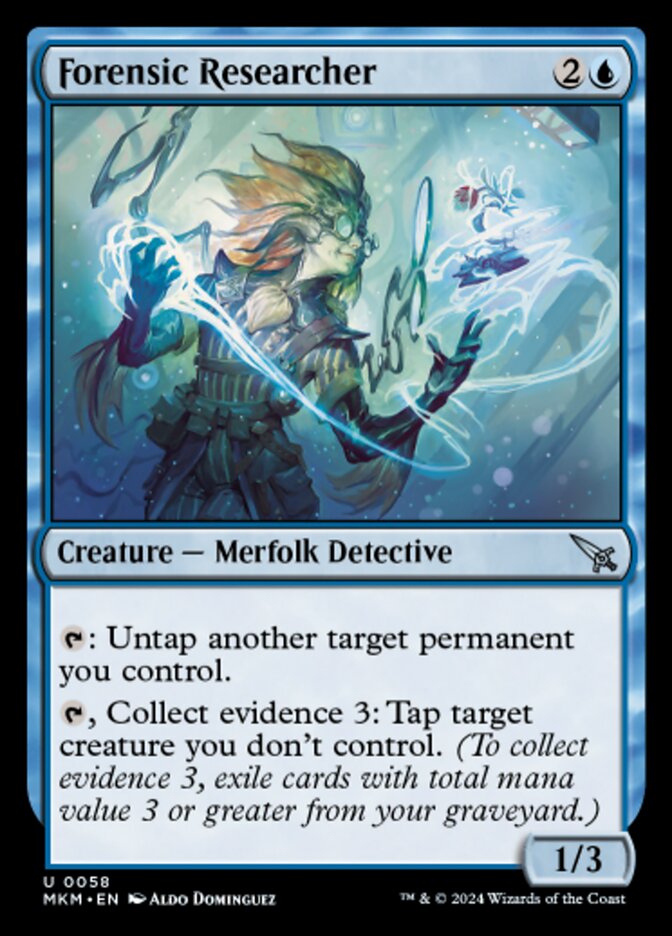
Rating: 3/10
I don’t like how costly the second ability is, but it’s a strict upside, as I’d already play this card as a blue mana dork. Forensic Researcher kind of reminds me of Kelpie Guide, only quite a bit worse, though it still has enough going for it to make it playable.
Furtive Courier
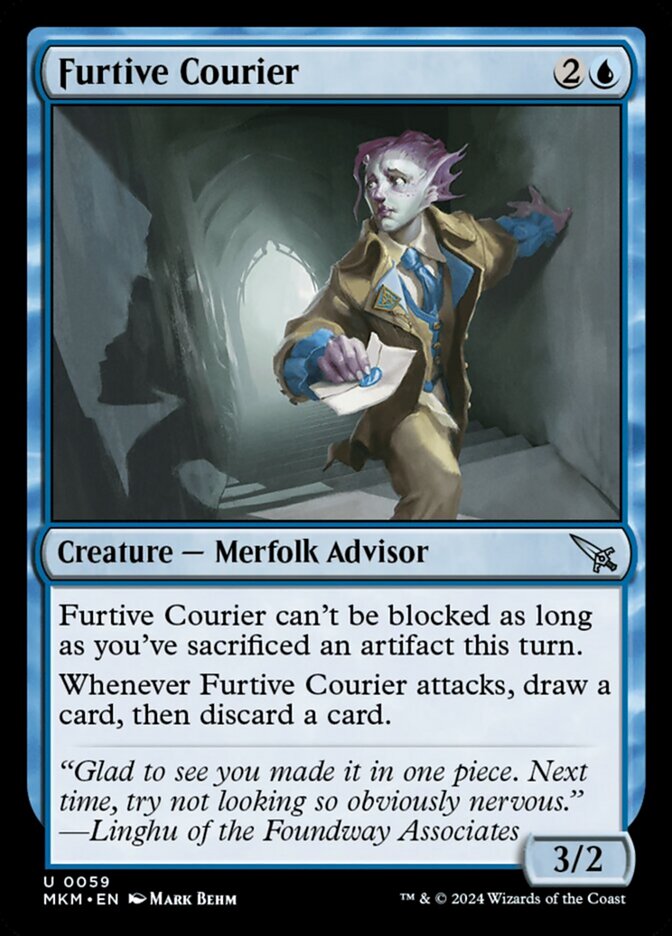
Rating: 4/10
Sacrificing artifacts should be pretty easy to do, but the times when you can’t and this is just a 3/2 vanilla creature will balance that out pretty quickly. It’s odd that this isn’t a detective, because it looks like it would be a good payoff and enabler for their archetype. It’s a reasonable card to play, but I just think there are enough little knocks against Furtive Courier to stop me wanting to take it too early.
Hotshot Investigators

Rating: 3/10
Big Man-o'-Wars are still pretty strong, and I’d be happy to run Hotshot Investigators at the top of the curve in my detective decks. I think back to how good Moonlit Scavengers was in Throne of Eldraine, and this might end up being better than that was.
Intrude on the Mind
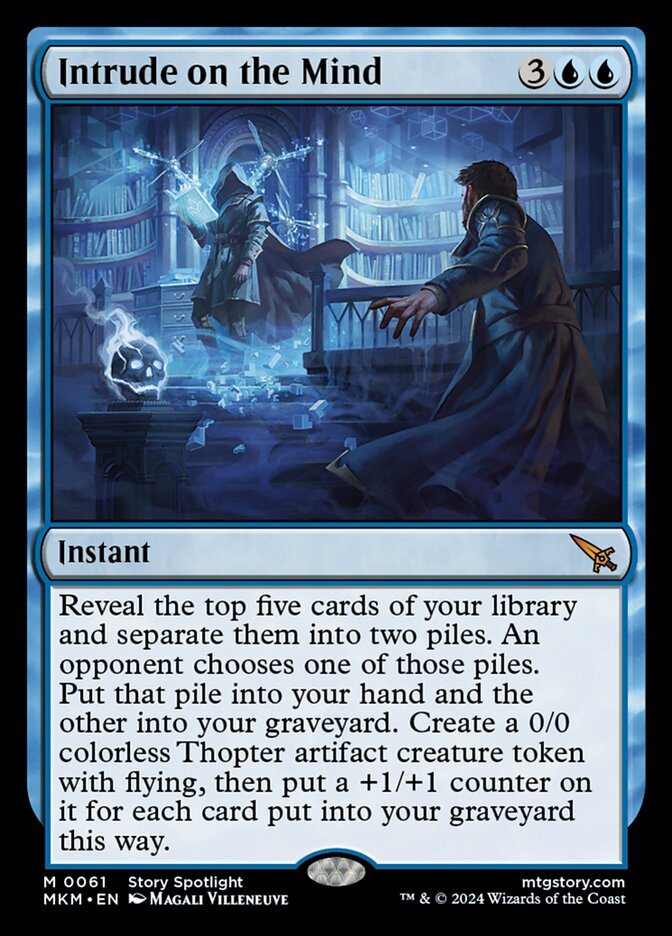
Rating: 9/10
I love a good Fact or Fiction. The more I think this one over and come up with new scenarios for it, Intrude on the Mind just gets better and better. First, being an instant is incredible because you get to treat it as a flash blocker. Imagine a scenario when your opponent attacks with a 4/4 creature, you cast this and split the cards into a pile of five and a pile of zero. Your opponent could deny you all the cards, but then you get a 5/5 flier out of this, eat their attacker, and carry on. If you just split the cards into a pile of two and a pile of three, your opponent has some control over which cards you get, but you’ve still effectively cast a flash Mulldrifter. There are so many more applications for this card, and it’s hard to not get anything good out of it, so it just has to be busted.
Jaded Analyst
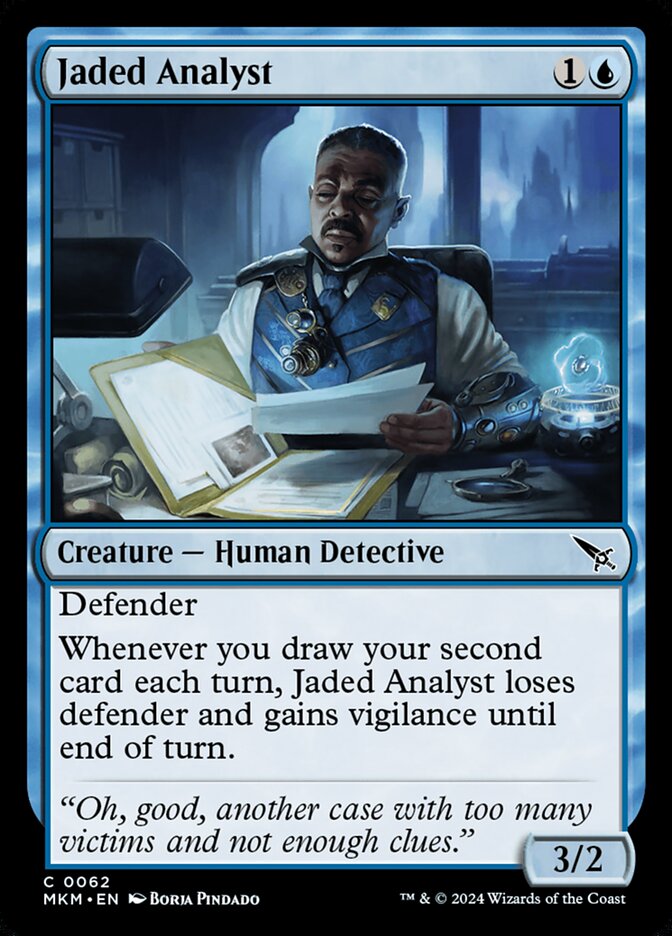
Rating: 3/10
Jaded Analyst makes for a really nice blocker. With all the disguise creatures in the set, it’s fine to just play this and trade off with one. Drawing your second card for the turn isn’t too difficult to manage, and then it even gets to apply pressure for you. Overall, it’s just a nice, solid common.
Living Conundrum
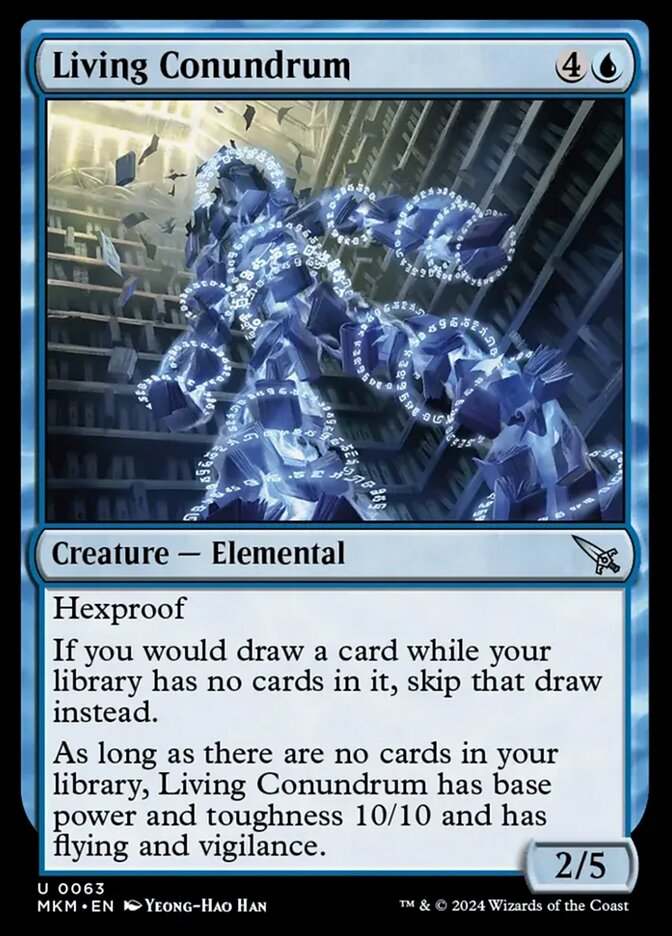
Rating: 1/10
This is one of the funnier designs the set has to offer, but it’s sadly not very good. Getting down to zero cards in your library is far from a trivial thing to do. Even in formats like Shadows over Innistrad with a heavy focus on self-mill, it wasn’t easy to do. If you can make it happen, Living Conundrum is of course a solid win condition for that deck, but I just don’t have any faith in being able to do that.
Lost in the Maze

Rating: 7/10
This is such a weird and tricksy design. If you’ve been playing with Khans of Tarkir recently, you may very well have lost a game to Icy Blast, which is basically a slightly cheaper version of Lost in the Maze. This has the extra functionality of protecting your creatures from removal. There’s enough going on here, and it’s a card that can end games almost single-handedly.
Mistway Spy
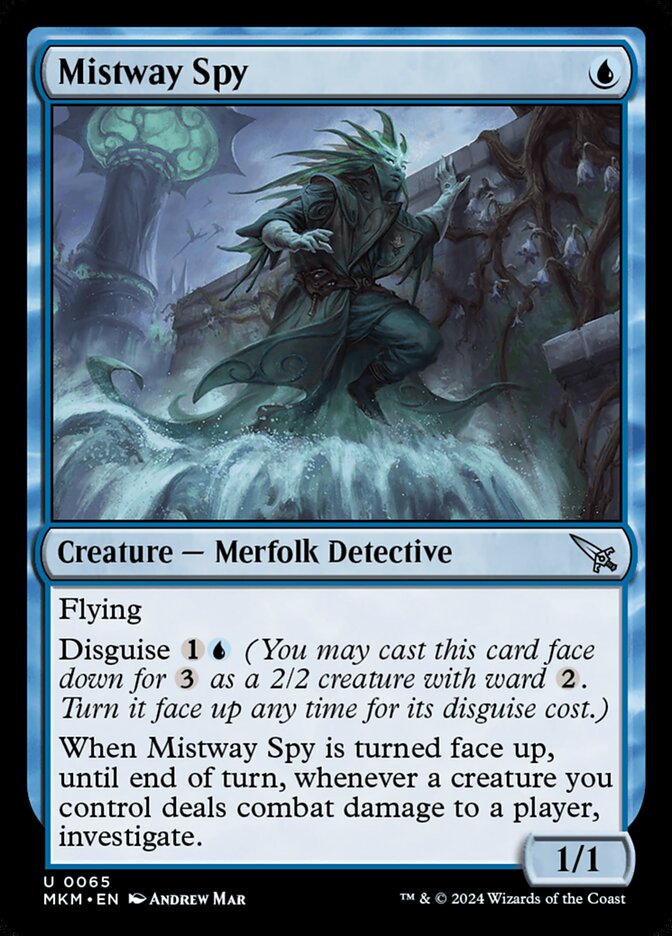
Rating: 5/10
Never underestimate a 1/1 flier for 1 mana these days, even though disguising it is what you’re aiming to do. It’s definitely worth noting that turning Mistway Spy face up allows you to investigate for each creature that hits your opponent, so timing it for a turn when you get several Clues should see you heavily rewarded for it.
Out Cold

Rating: 3/10
I was ready to talk about how Out Cold is just a mediocre Frost Breath, but it also investigates, so it’s probably fine to play.
Proft’s Eidetic Memory
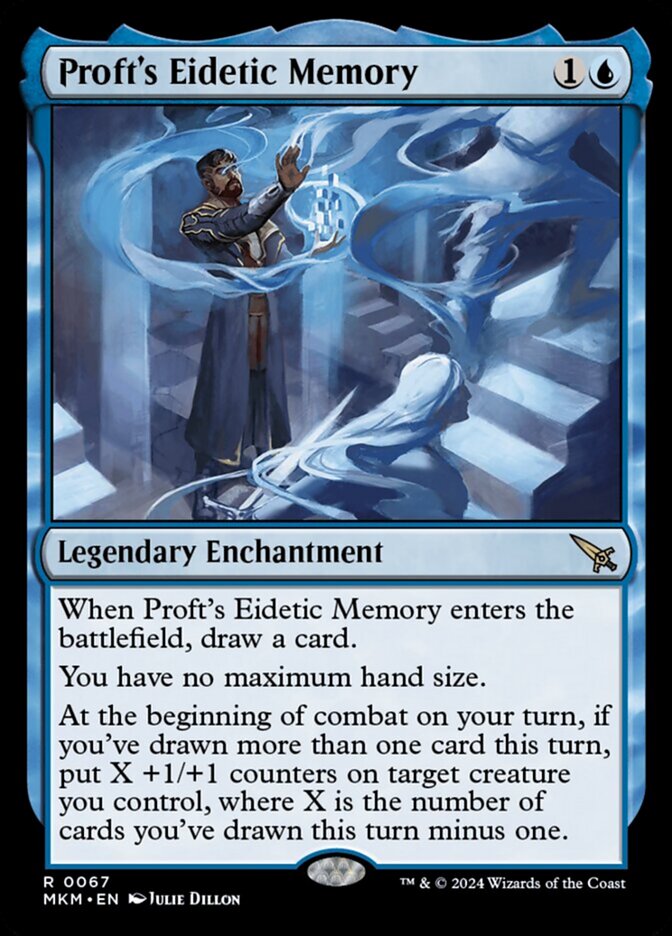
Rating: 9/10
On first read of this card, I wasn’t that impressed. I have absolutely no idea why though, because having read it a few times, Proft's Eidetic Memory looks obscene. The detectives deck already has a subtheme of drawing extra cards, all of which trigger this. You can even draw multiple cards, and this gives multiple +1/+1 counters. Even without enabling it, this is just 2 mana to draw a card and get a +1/+1 counter, then it sits in play, and you get free counters if you ever crack more clues before going to combat. And you get an infinite hand size. The card is pretty much never bad to draw, it’s very cheap to cast, and it just does so much. I can’t wait to try it out for myself.
Projektor Inspector

Rating: 3/10
I like this for the detectives deck. Filtering your card draws while also enabling your draw two theme is pretty good, and Projektor Inspector is a detective itself. Seems like a solid playable to fit into that deck.
Reasonable Doubt
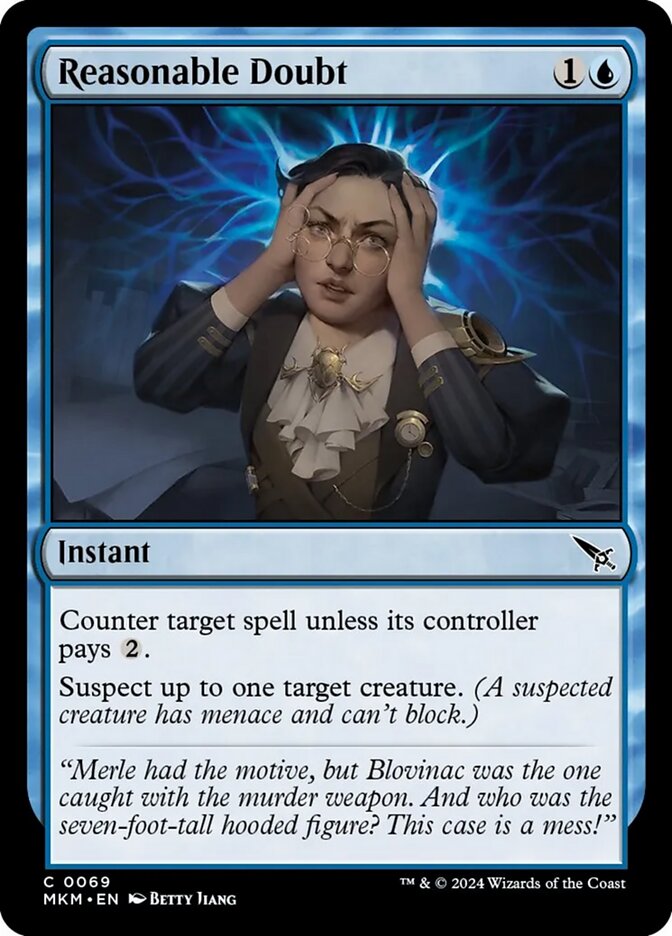
Rating: 2/10
Quench is a pretty weak counterspell overall. Reasonable Doubt is obviously strong in the early game, but it’s too easy to play around in the late game, especially if an opponent knows it’s coming. On top of that, getting to suspect a creature is a completely disparate ability that I don’t think meshes well together with a cheap counterspell.
Reenact the Crime
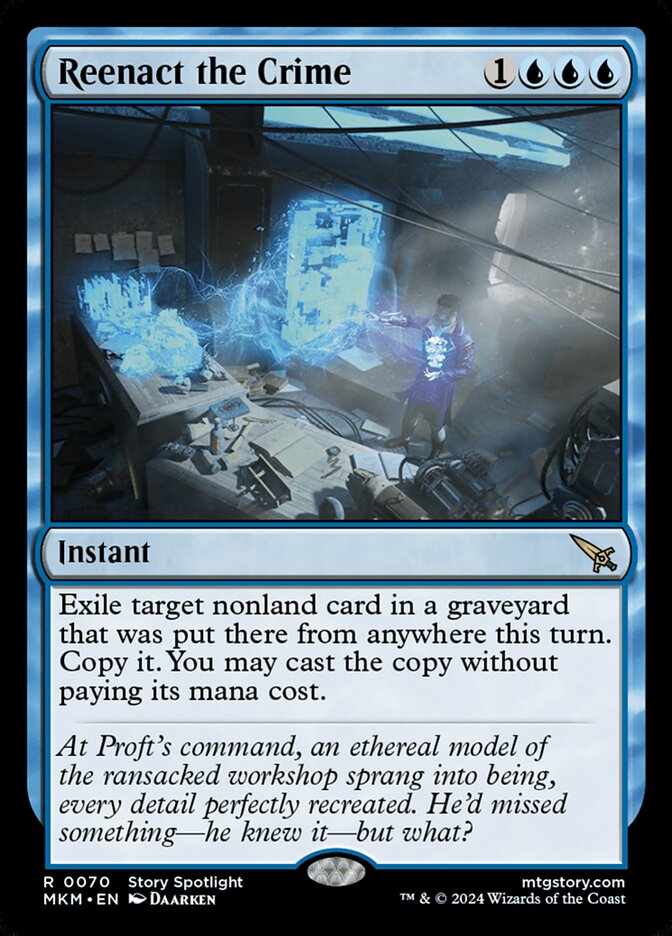
Rating: 0/10
I’m sure there’s some weird situations when Reenact the Crime could be good, but it has too many red flags for me. This is a situational card that you could have in your hand for a whole game and never cast, which sounds pretty unplayable to me.
Steamcore Scholar
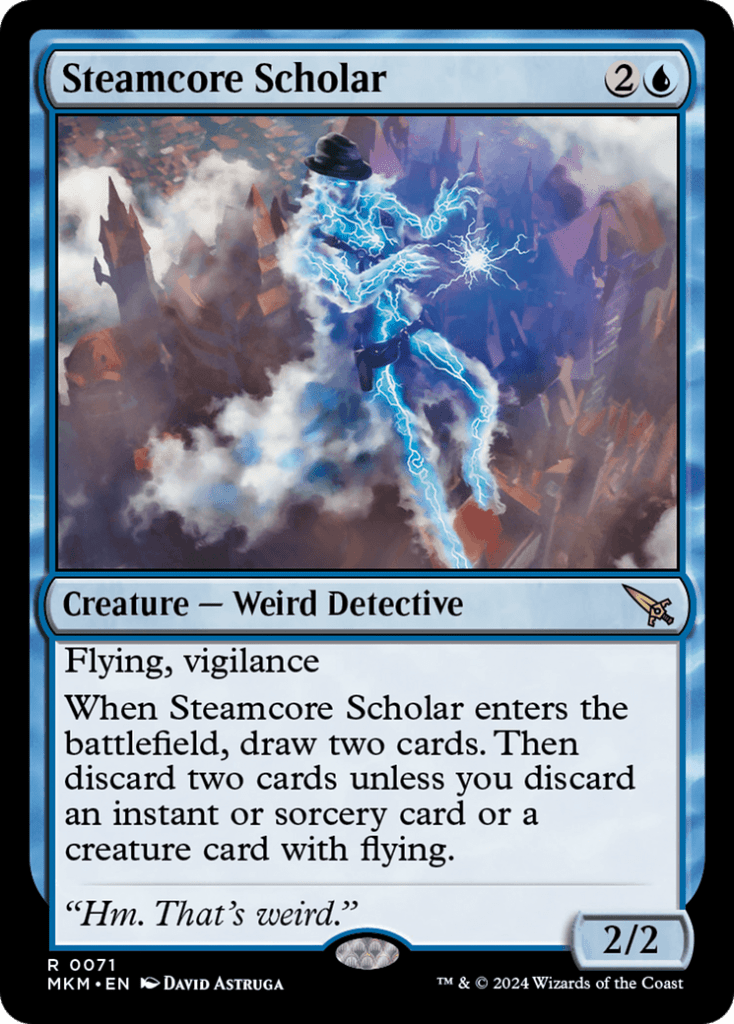
Rating: 7/10
What’s not to like here? Steamcore Scholar is a good size creature, and it draws you cards. Yeah, you need to discard card(s), but whether you discard two excess lands or the weakest spell in your hand, you’re up on the transaction. This is just a solid card with nothing bad I can say about it.
Sudden Setback
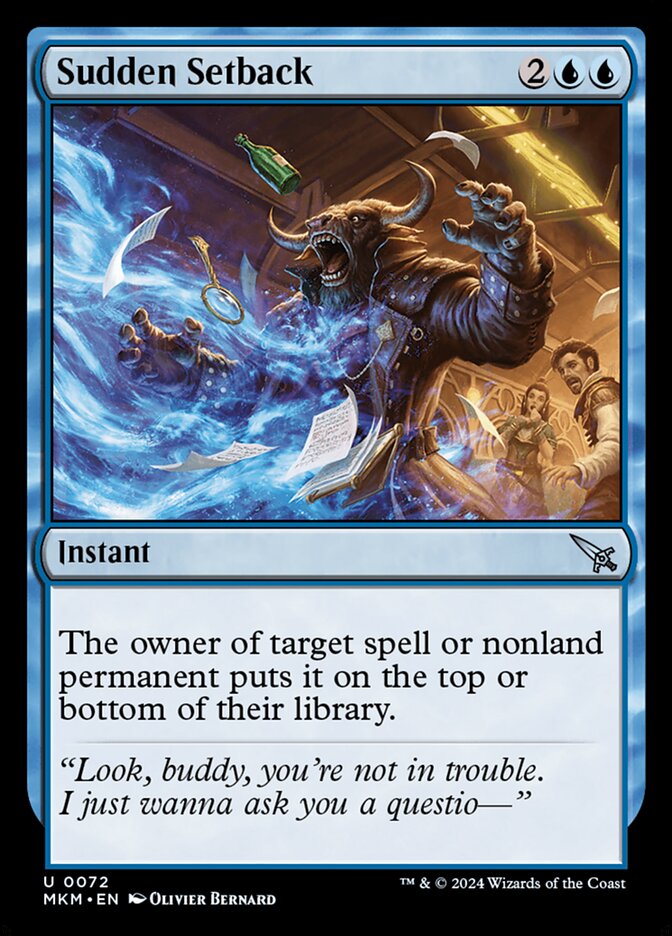
Rating: 4/10
Cards like Misleading Motes and Run Out of Town have had varying amounts of success in recent sets, so it’s hard to figure out where Sudden Setback lands. It’s really nice that this can counter a spell on the stack though, making it much more flexible against powerful enters the battlefield effects that you otherwise wouldn’t be able to interrupt.
Surveillance Monitor

Rating: 5/10
I should be excited about a creature that has a very good trigger that happens whenever you do a set’s mechanic. Getting a Thopter token is awesome, but I just don’t think collecting evidence is very good. If you can reliably get the first trigger off, then Surveillance Monitor is a 3/3 plus a 1/1 flier up front, which is a good card, but I don’t think you’ll trigger it much beyond that.
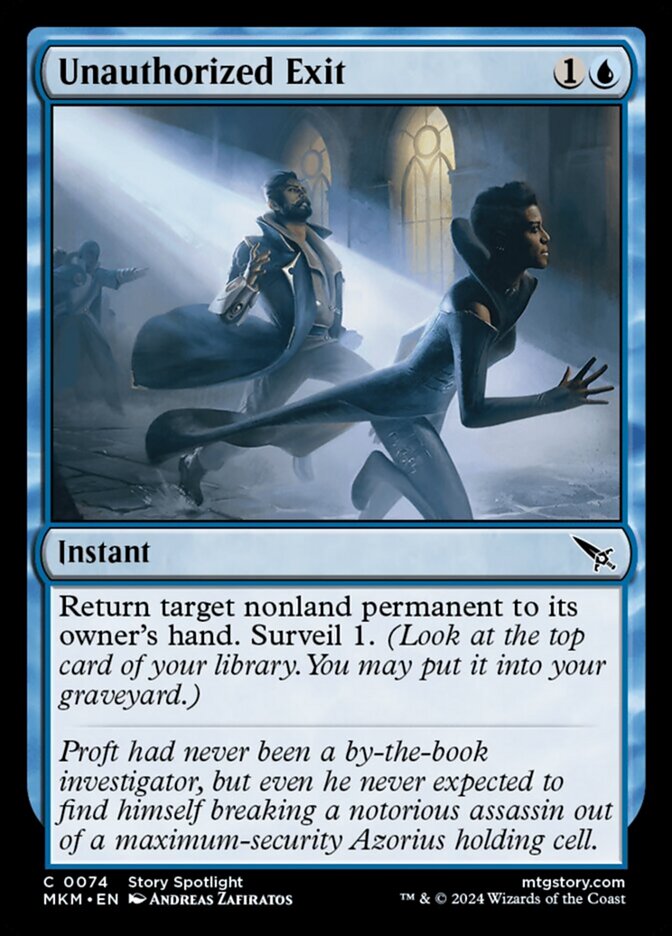
Rating: 3/10
Did I mention that I like bounce spells? A nice, catch-all bounce spell like Unauthorized Exit can be used to disrupt all sorts of plays from your opponent, especially when they try to line up double blocks against you. They’re not exactly the best type of interaction, but it’s good to have access to them, and getting one with a small upside tacked on is even better.
Black
Agency Coroner

Rating: 2/10
I started by reading this card’s ability and loving it. Then I saw its stats, and I was off it. You’re never short for 5-drops, and they have to be a lot stronger than Agency Coroner to grab my attention. Still, it’s functional and can be fine if you want something at the top of your curve.
Alley Assailant
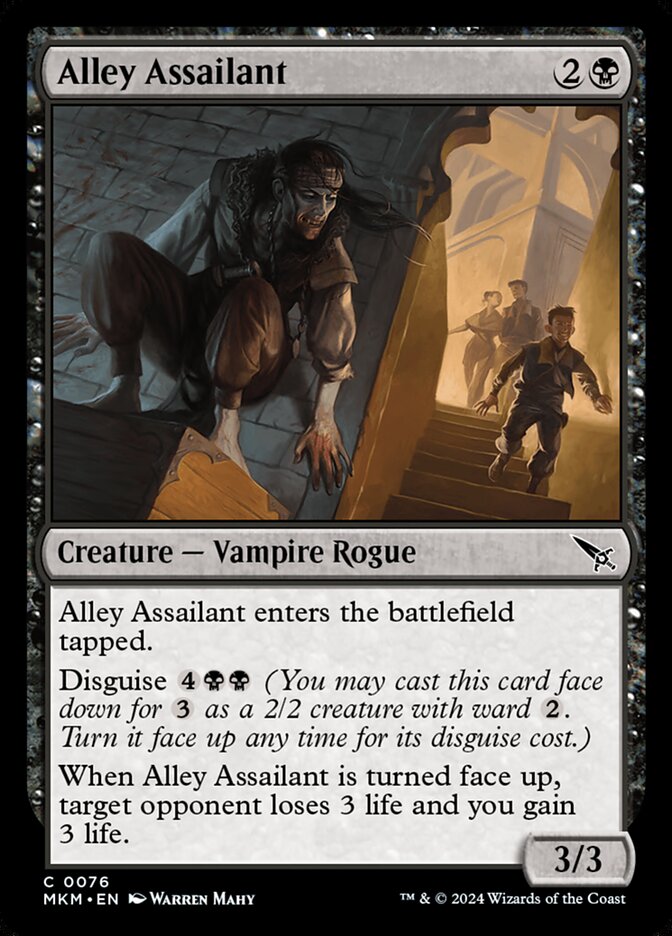
Rating: 4/10
Even if Alley Assailant enters tapped, a 3/3 for 3 in a world of 2/2s for 3 is very good. Getting to turn it face up when you draw it late can also make it a very dangerous card, and I can foresee losing to this out of nowhere quite a lot.
Barbed Servitor
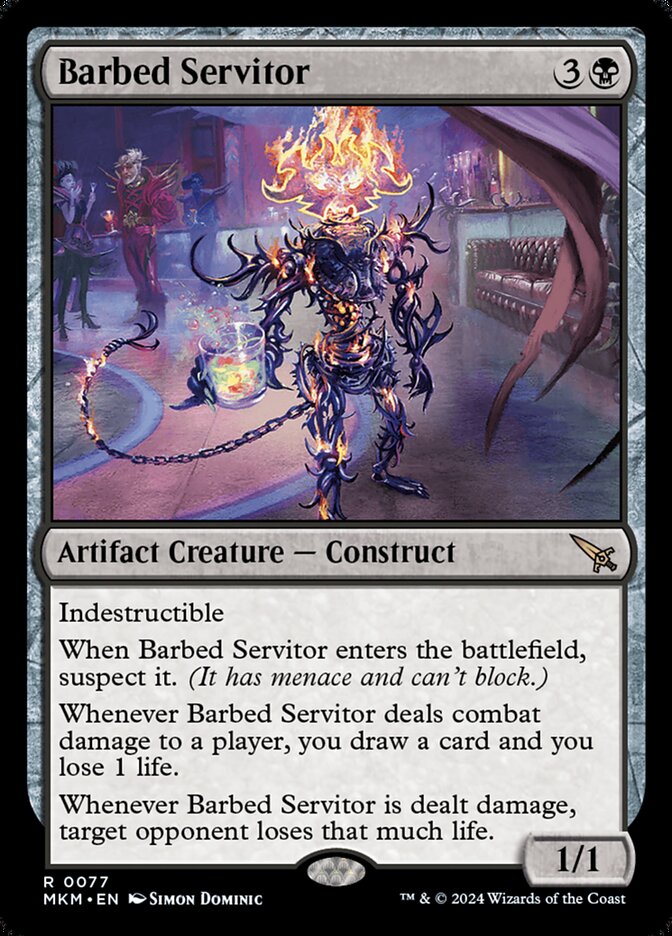
Rating: 7/10
This is probably my favorite design in the set. It might be a touch expensive for a card that essentially says you draw an extra card each turn and each player loses 1 life. But Barbed Servitor can be so much more than that. Your opponent is of course never blocking it, but there are some cards in the set that remove suspicion from a creature, which allows this to turn into a very annoying blocker itself. It requires some amount of work to reach its full potential, but I think it’s worth the effort.
Basilica Stalker
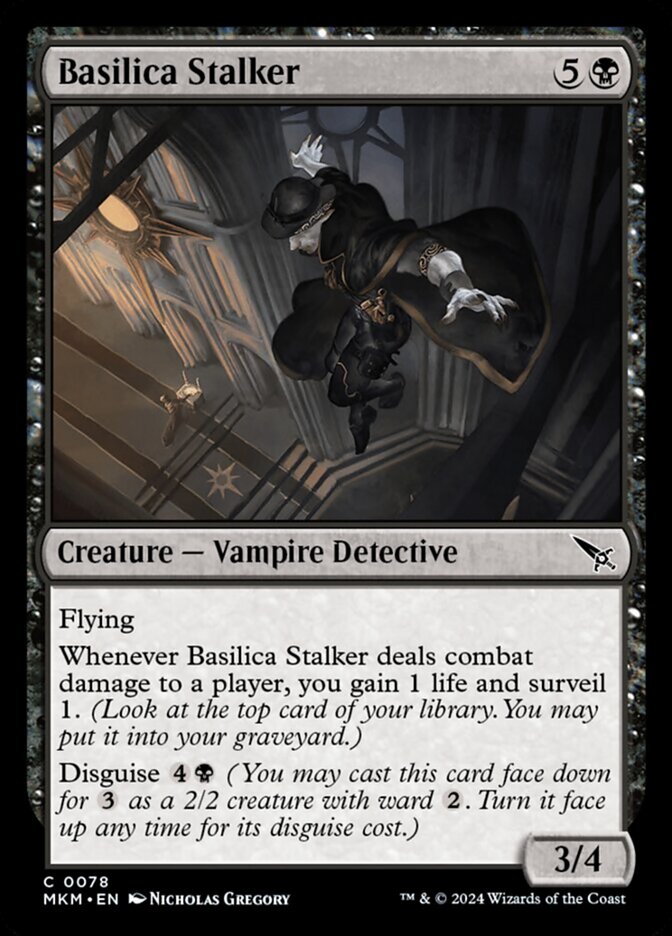
Rating: 2/10
I don’t think I care about gaining 1 life when Basilica Stalker connects. Is that enough of an upside? Nah, I don’t think so. Basically every disguise creature is at least playable, but this is still one of the weakest we’ve seen.
Case of the Gorgon’s Kiss

Rating: 2/10
If you can solve Case of the Gorgon's Kiss, this is obviously pretty busted. One mana of investment to give you a 4/4 with deathtouch and lifelink? Naturally, it’s not that simple. I think the key to this card is just to ignore the first ability and play this for no value on a turn when three creatures have already gone to the graveyard. Even if that lines up, I don’t know that this is worth playing. It seems like it’s just too much work.
Case of the Stashed Skeleton

Rating: 8/10
I think this card is pretty incredible. Two mana for a 2/1 suspect is fine, but given that Case of the Stashed Skeleton turns into a free Demonic Tutor if your opponent deals with that, I reckon it’ll be quite the threat. Demonic Tutor isn’t actually a playable Limited card, but getting one for free after getting a decent creature is extremely good.
Cerebral Confiscation

Rating: 3/10
How has Cerebral Confiscation never existed until now? It makes perfect sense to combine Coercion and Mind Rot into the same card! Both are mediocre discard spells that are only conditionally good, but the split card of one or the other looks much more playable.
Clandestine Meddler
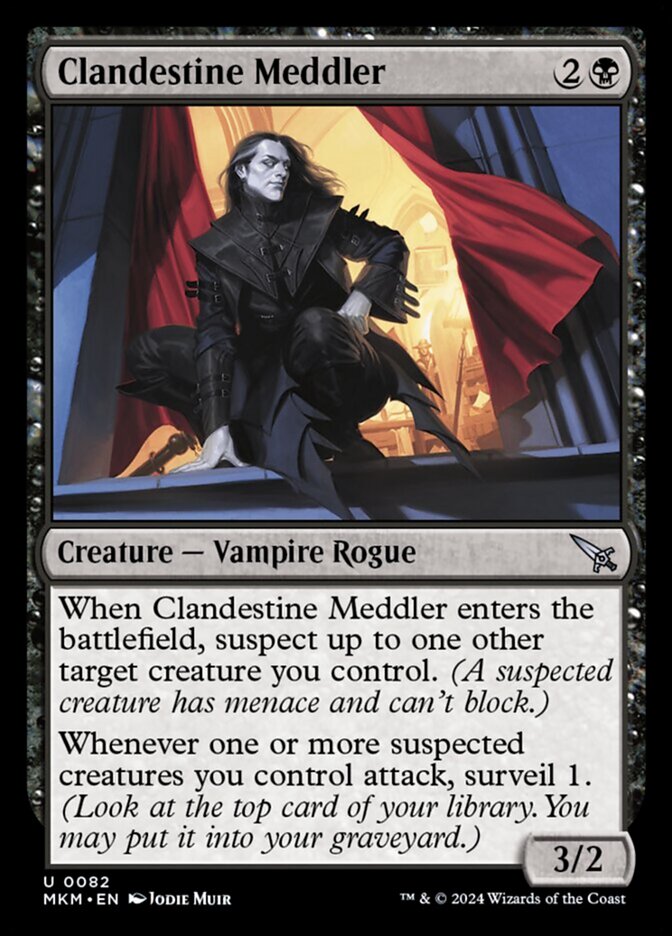
Rating: 4/10
Suspecting a creature presumably is a good enough upside here. If you’re doing the suspect thing, Clandestine Meddler should be a solid playable for you, but if you’re not then you can just pass on it.
Deadly Cover-Up

Rating: 7/10
The collect evidence ability on Deadly Cover-Up is completely useless. Extraction effects are bad in the first place and even more worthless in Limited when most cards only appear as one-ofs anyway. How good is 5 mana to destroy all creatures? Yeah, it’s pretty good. Like No Witnesses, board wipes are good, and since you know it’s coming, you can let your opponent overextend into them. Just don’t collect any evidence, it’s not worth it.
Extract a Confession
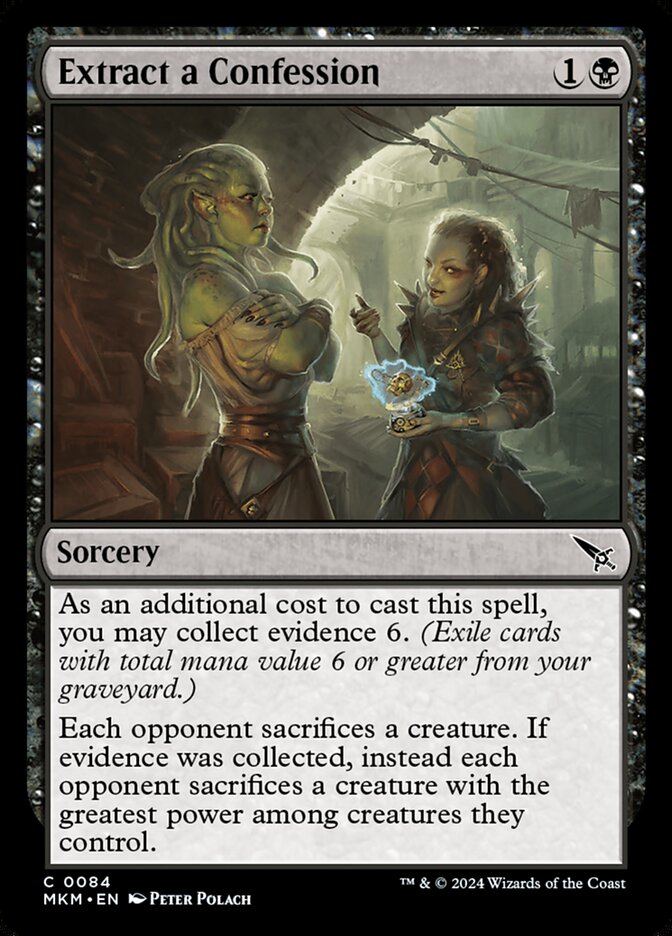
Rating: 4/10
Cruel Edict has never been a particularly good Limited card, but the option of being an edict early and then later being a reliable way of killing your opponent's biggest creature seems like a decent card. I’ve been very low on collecting evidence, but Extract a Confession is the kind of card that makes it worth doing.
Festerleech
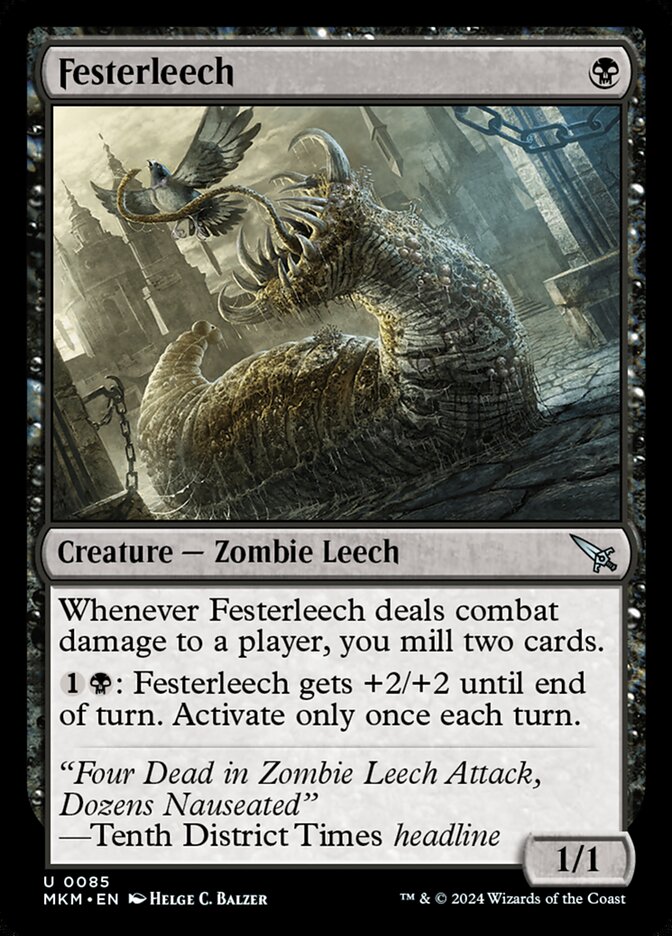
Rating: 5/10
This might look awful at first glance, but Festerleech is actually a great enabler for the self-mill plan. If your opponent has 2 mana available, are you ever blocking this with a 2/2? If you do, they just pay the mana, and you lose your creature for nothing. You’ll just have to let it through and then the mill ability goes off.
Homicide Investigator
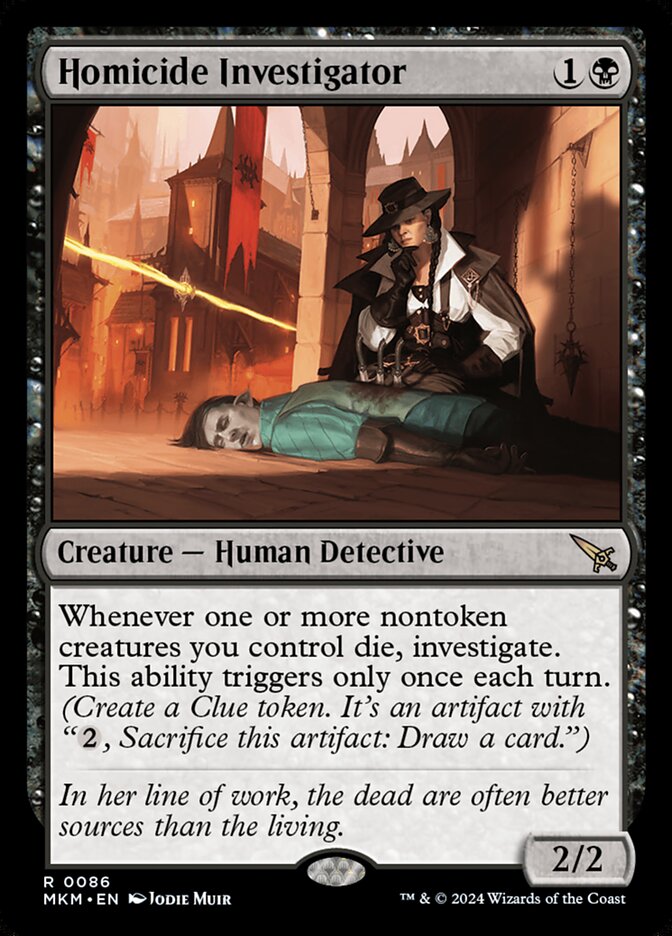
Rating: 7/10
Morbid Opportunist was the mythic uncommon of Innistrad: Midnight Hunt for a very good reason. Getting a free card whenever a common thing happens is a huge game. Homicide Investigator is a fair bit worse than that, which is silly given that it's rare, but it’s still an extremely powerful ability that will feel at home in any black deck in the format.
Hunted Bonebrute
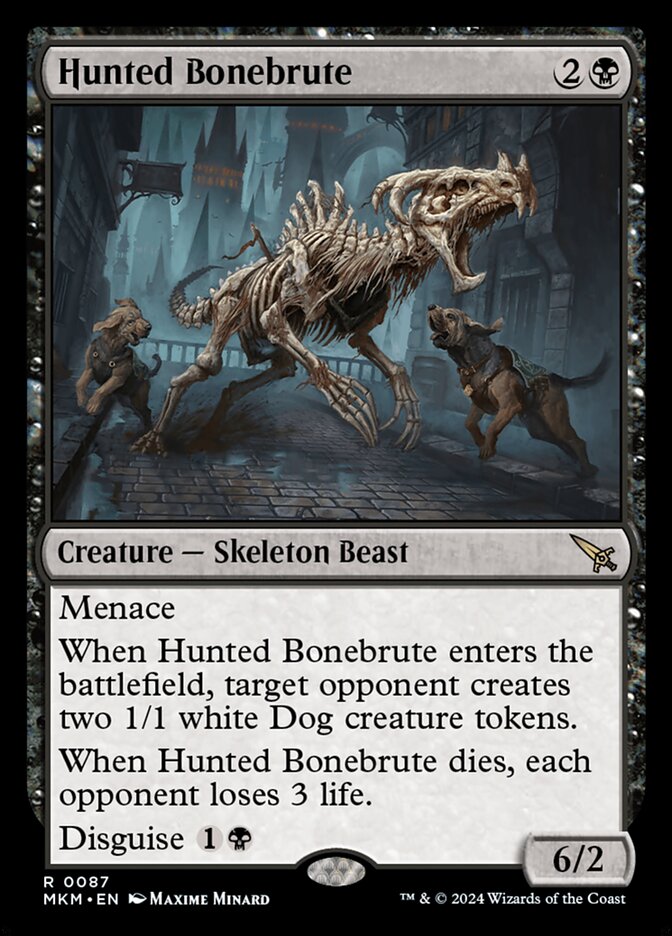
Rating: 5/10
We’ve seen plenty of “hunted” creatures in the past, and it’s been proven time and time again that they’re just bad. Hunted Bonebrute has a bit more potential due to disguise, and a 6/2 menace hits really hard, trading for at least two creatures (or one big one) in combat.
Illicit Masquerade
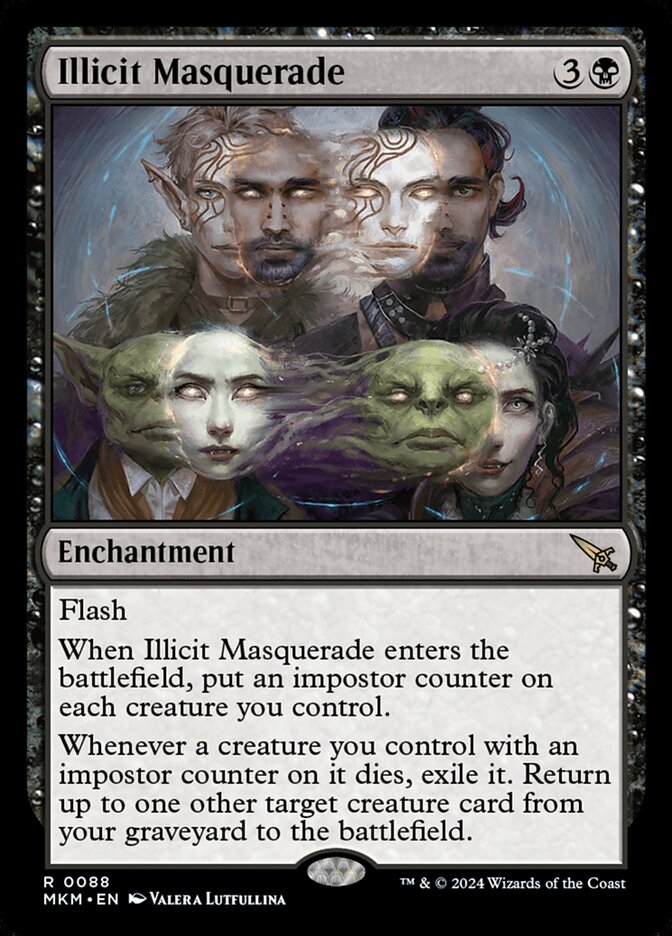
Rating: 5/10
Every time I review a new set, there’s one card that I just can’t figure out. Illicit Masquerade is the one for this sett. It’s just baffling. It seems to have a lot of potential in the late game. Flash gives you the ability to play this right before you lose some creatures in combat, letting you reanimate two or three creatures all at once. But that’s highly situational at best. I wouldn’t be surprised if this was unplayable, but for now, I’d like to stay optimistic and assume you can find some good ways to use this.
It Doesn’t Add Up
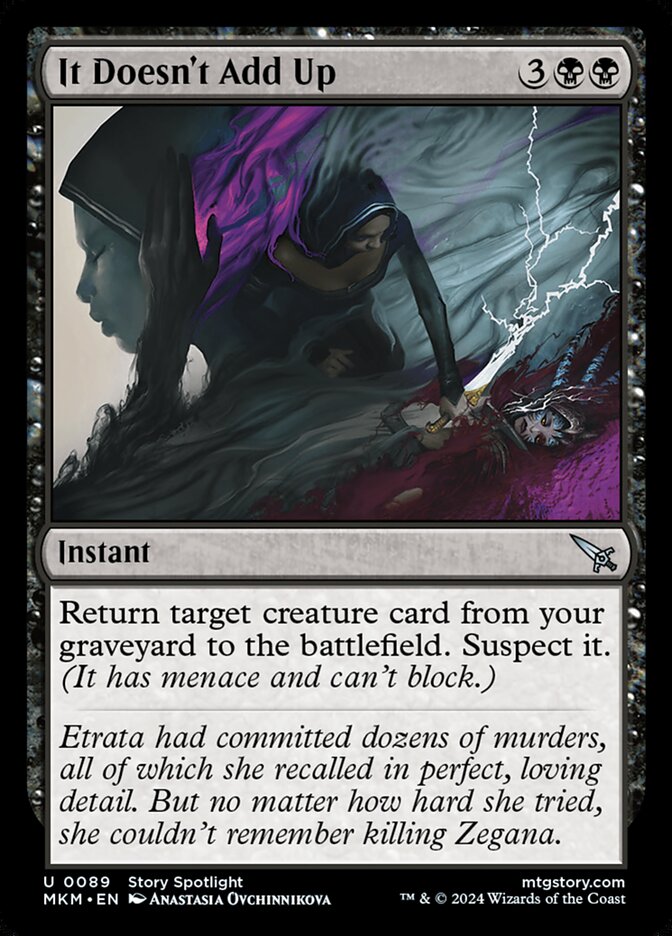
Rating: 2/10
Reanimation spells are very hit or miss. You don’t usually have anything good enough to reanimate in the first place, plus you’d have to get them into the graveyard somehow. The only thing It Doesn't Add Up has going for it is the fact that there’s an amount of self-milling in the set, but as the name suggests, something doesn’t add up here.
Lead Pipe
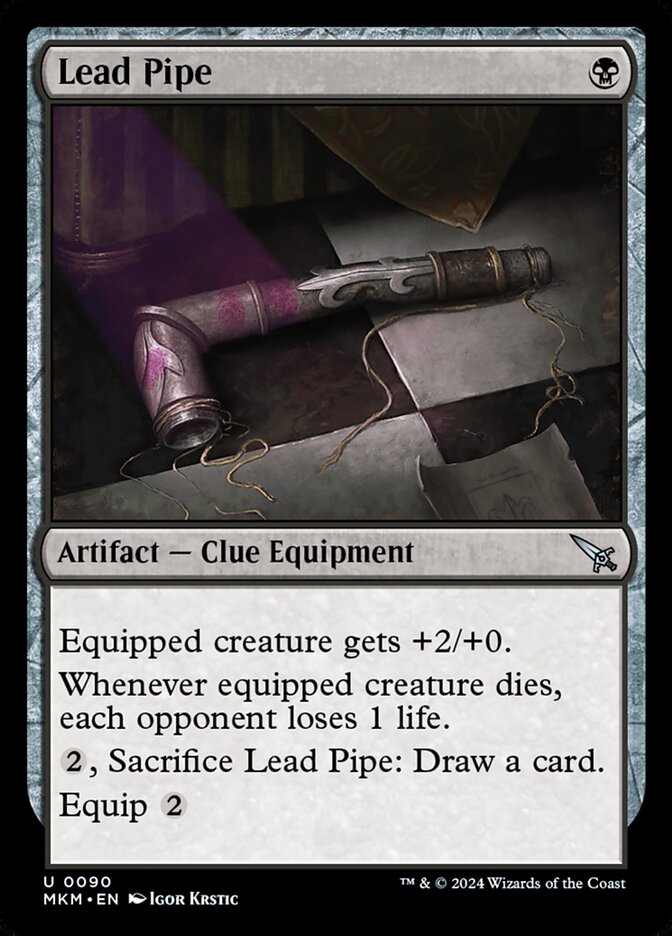
Rating: 3/10
The equipment itself is kind of mediocre, but like the other Clue(do) weapons, this is a clue, so you always have the buyout of being able to crack your Lead Pipe and draw a card, which makes this at least a playable card.
Leering Onlooker

Rating: 6/10
I love getting free value out of my graveyard. I’d rather not be casting Leering Onlooker to be honest. Instead, I’d like to discard it or mill it and get a pair of bats without spending any cards. Yet, a 1/3 flier for 2 mana is also pretty decent. No matter how you play it, this is a great card that works really nicely with a lot of the things black is trying to do in this set.
Long Goodbye
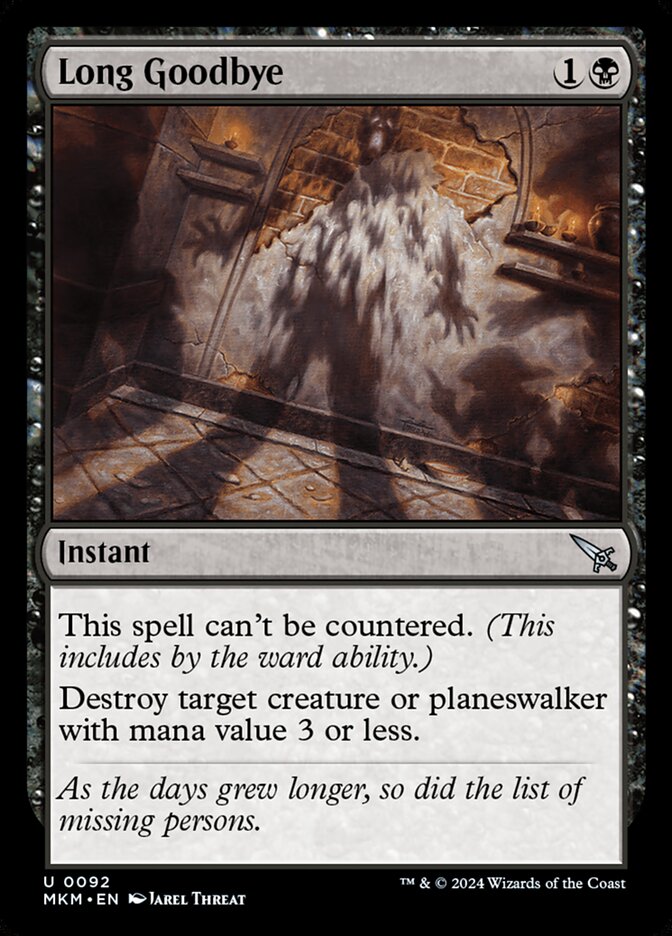
Rating: 6/10
Ward makes it extremely difficult to remove disguised creatures profitably, so what I really like about this removal spell is that it’s able to do that. Two mana to kill off a disguised creature sounds very good, along with also just being a solid removal spell against a lot of early starts. Long Goodbye looks premium to me, and I’ll always be looking to add it to my black decks.
Macabre Reconstruction
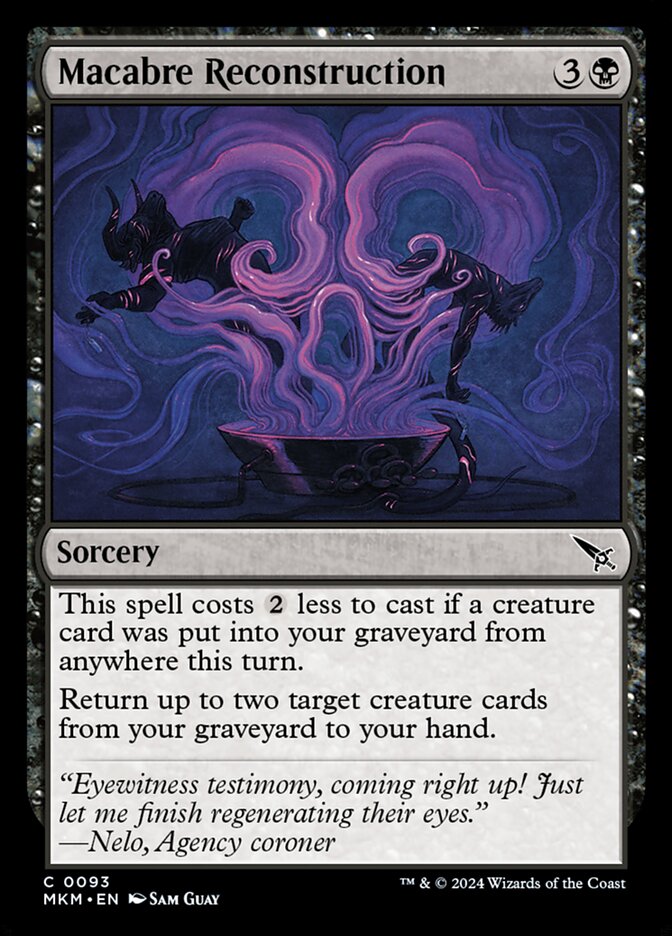
Rating: 3/10
We’ve seen plenty of Soul Salvage variants over the years, and they’re always decent playables. I’d imagine I’ll always be happy playing a Macabre Reconstruction in my deck. If I’m on the self-mill plan though, I could see extra copies to pay me off for doing that.
Massacre Girl, Known Killer
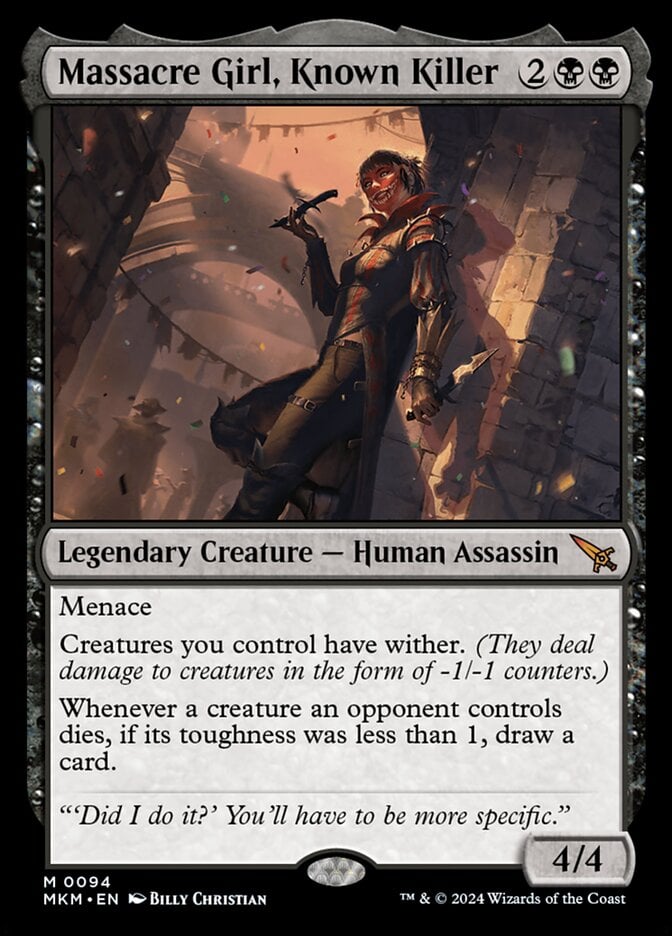
Rating: 8/10
Massacre Girl, Known Killer is a really interesting card. We haven’t seen wither in a main set since before I started playing Magic. There’s a reason for that, because wither is an absurd mechanic, so thankfully it’s only on this one mythic. While you’ll obviously play Massacre Girl in any black deck, given its stats and three upsides, it’ll be most at home in a hyper aggressive deck, where the combination of its abilities makes it really awkward for your opponent to block for fear of you drawing free cards.
Murder
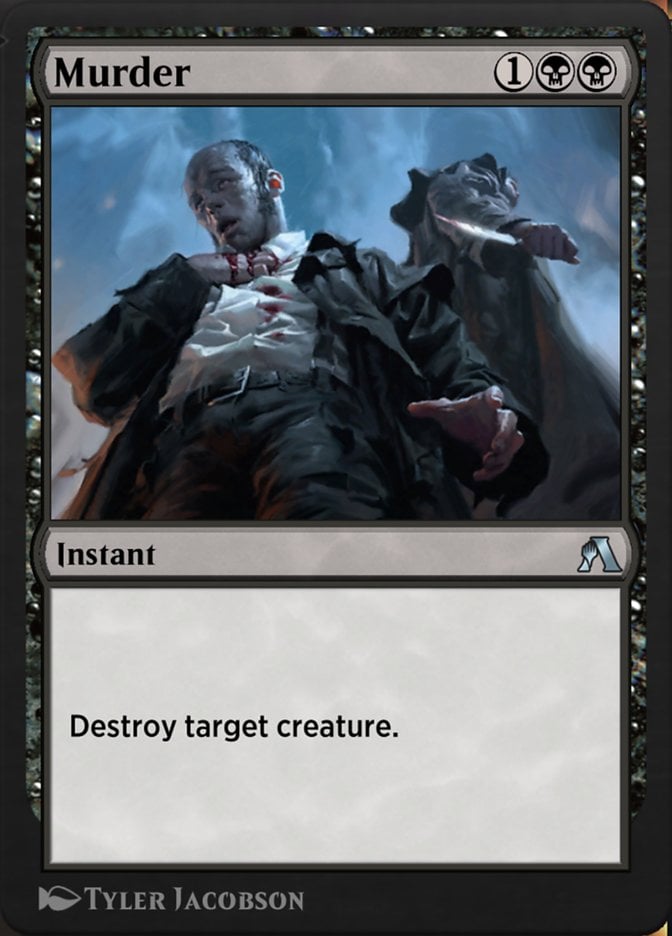
Rating: 6/10
Come on, was there ever any doubt that Murder would appear in the set? This has been the gold standard for common black removal ever since M13, and I doubt it’s going anywhere now.
Nightdrinker Moroii

Rating: 4/10
Getting a 4/2 flier on the board is pretty enticing, but spending a total of 5 mana to do it doesn’t seem the best. More than likely, the best use of this is to play it along with some other disguises, then on one turn you can flip it over while casting another spell and take your opponent off guard with it.
Outrageous Robbery
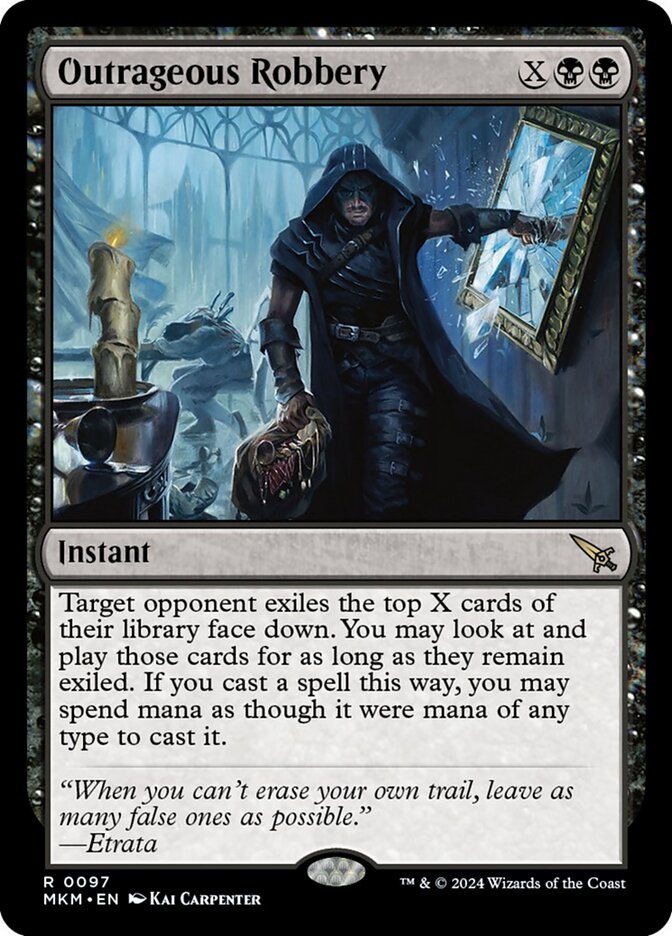
Rating: 5/10
“Draw X cards” spells have fallen out of favor in recent years. This one gives you the benefit of being instant speed, which means you never have to tap out to play it, but you draw the cards from your opponent’s deck. That’s not an inherently bad compromise, but when your deck is heavy on synergy, your opponent’s cards likely don’t help you as much as they could. On balance, Outrageous Robbery is a fine card to top your curve in a control deck, but it’s hard to know if you’ll have enough time to resolve this and make use of it.
Persuasive Interrogators

Rating: 3/10
I’m looking at Persuasive Interrogators as mainly a big 6-drop that gives you a Clue, which is pretty nice. Now then, giving your opponent poison counters. This ability has a massive downside to it. Nothing else in the set poisons your opponent, so this is an all or nothing effect. Either you get this off five times and win the game, or it does nothing. Getting four triggers is no different from never triggering it. It’s hard to look at it as much of an upgrade, but it’s an interesting option and I’m sure I’ll lose to it at least once.
Polygraph Orb

Rating: 1/10
I think Polygraph Orb looks really bad. Five mana to draw the best two cards out of your top four is pretty overcosted. Given that, I’d be hoping for something nice on top of it, but you just don’t get that. Collecting a small amount of evidence to use this is okay, but your opponent gets to choose how they’re punished, meaning you’re never getting the effect you want. I just think this is bad, and I don’t want to play it in most situations.
Presumed Dead
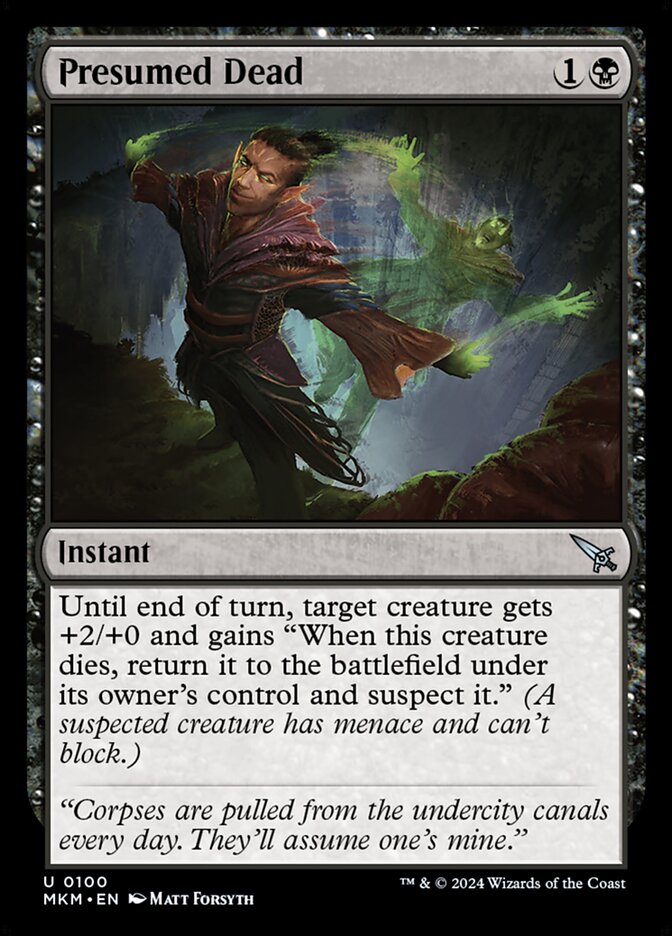
Rating: 2/10
These effects, your Supernatural Staminas and the like, show up in most sets but are pretty weak overall. Presumed Dead isn’t even offering much on top of what we normally get. Unless your black/green deck is short on enablers, I don’t think it’s good enough.
Repeat Offender

Rating: 1/10
Repeat Offender is a very weak card to start out with, and paying mana into it doesn’t actually make it much better. I just wouldn’t bother with it.
Rot Farm Mortipede
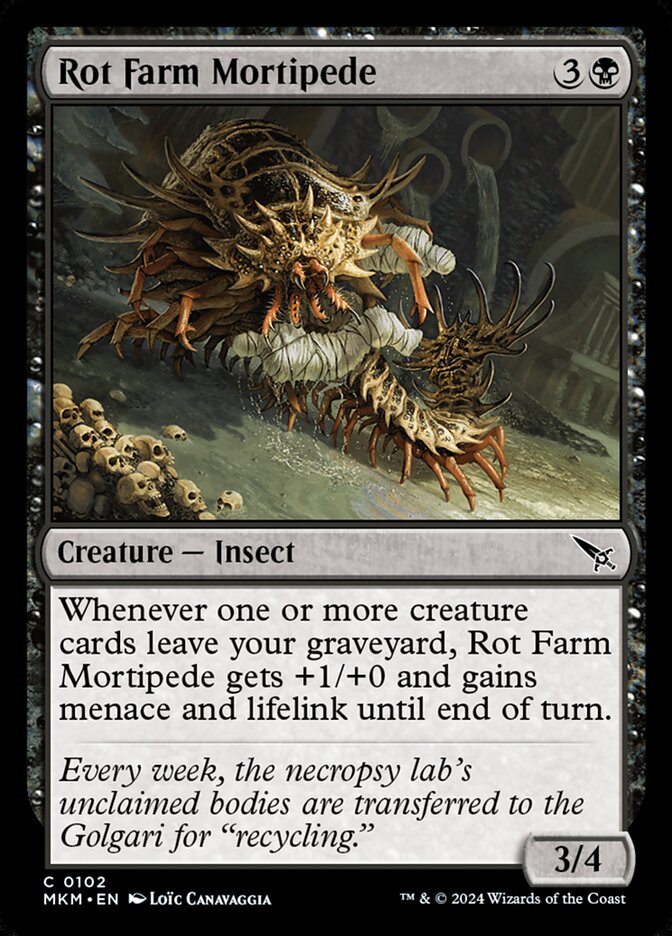
Rating: 3/10
You need to be able to trigger Rot Farm Mortipede to play it, but once you have a couple of good ways to do it, I’d be happy with it. A 4/4 with menace and lifelink is really nasty, on both offense and defense, but you just need to be able to put the effort in to enable it.
Slice from the Shadows
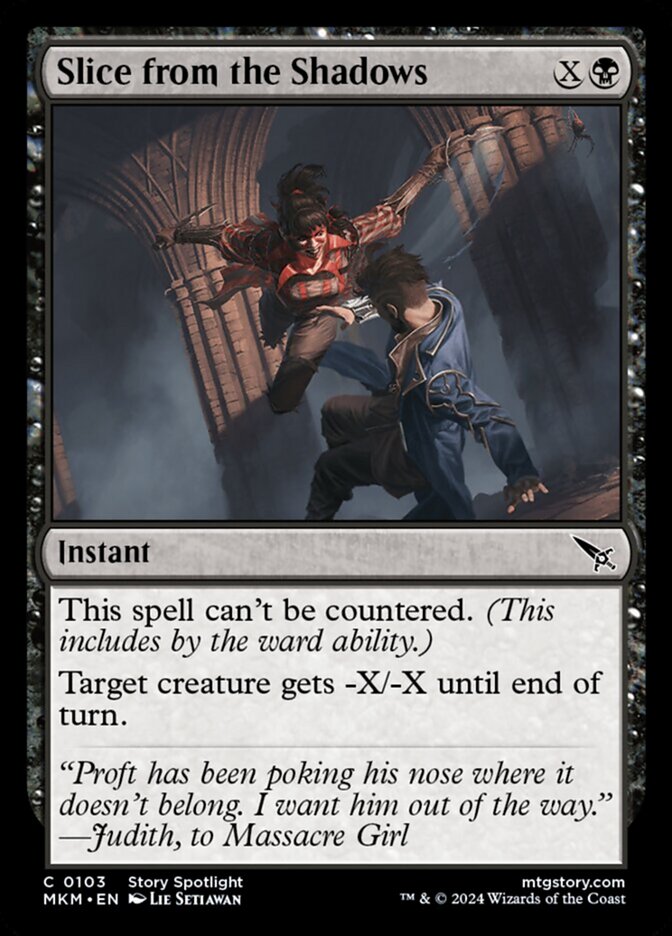
Rating: 3/10
Death Wind is an aggressively mediocre card at the best of times. Adding an uncounterable clause is relevant for getting around ward to kill a disguised creature for 3 mana, but that’s not enough to make Slice from the Shadows any more than a below average removal spell.
Slimy Dualleech
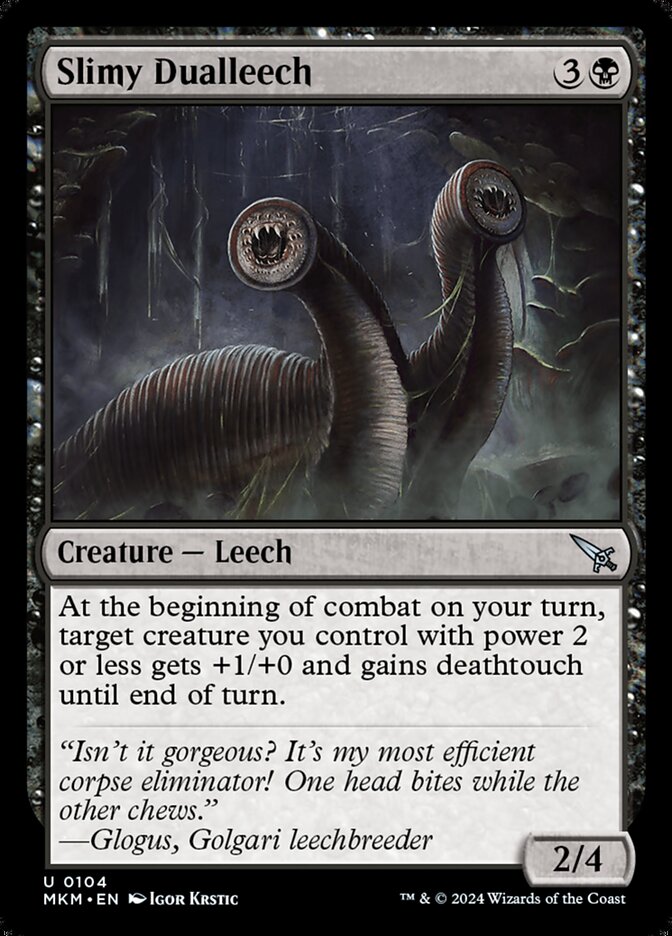
Rating: 6/10
I really like the look of this. 2/4s are really well positioned in the format, and Slimy Dualleech can also attack as a 3/4 with deathtouch. Its best use is probably to sit back on defense while you send your disguised creatures in as 3/2 deathtouchers, which sounds like it’ll be really tough to beat.
Snarling Gorehound
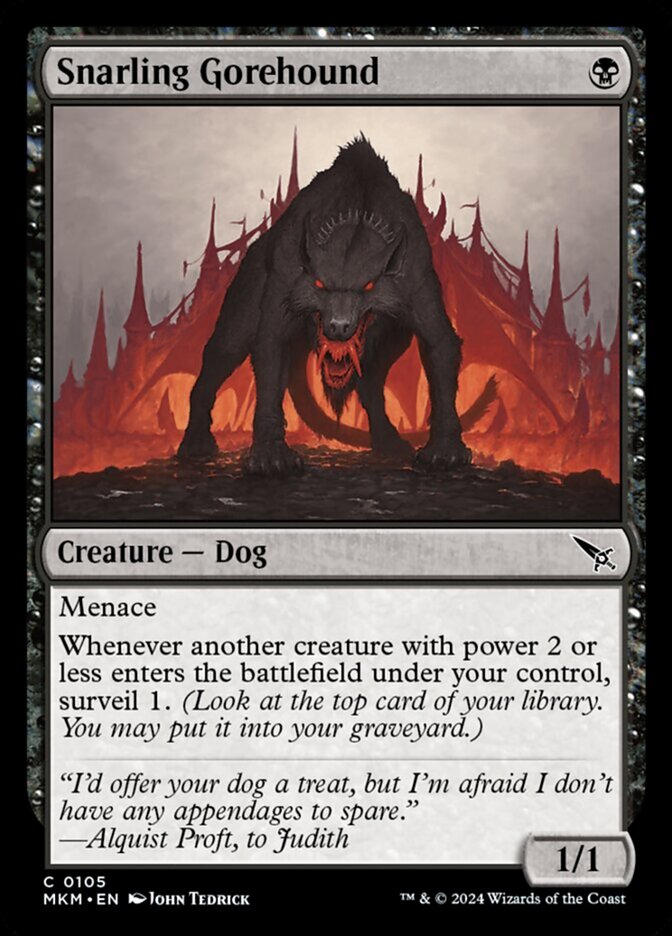
Rating: 2/10
I know, I’m not supposed to underrate 1-drops these days, but this still looks awful to me. Menace is nice, but you still can’t attack with Snarling Gorehound into a board of 2/2s or whatever else. Surveilling each turn is nice though, so if you get this early, you’ll get a good amount of value. It’s just not strong enough to grab my attention.
Soul Enervation
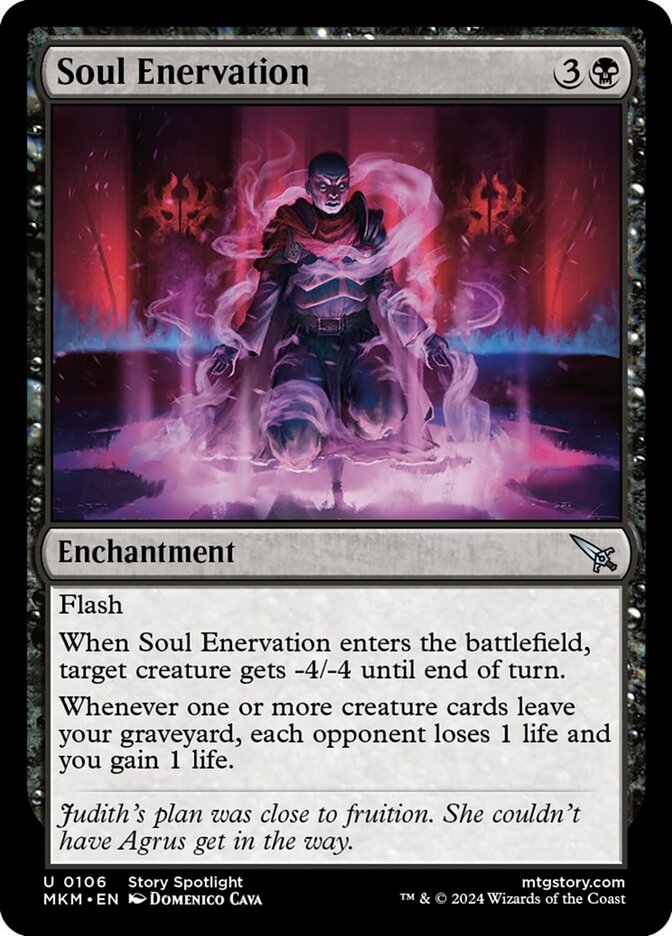
Rating: 5/10
Four mana to give -4/-4 at instant speed is always solid. The upside you get is that Soul Enervation is an enchantment that triggers when you remove creatures from your graveyard. Funnily enough, this card might have been better for the graveyard decks as an instant that can then be collected as evidence. Still, this is removal with a little bit of upside on top, not too much to complain about.
Toxin Analysis
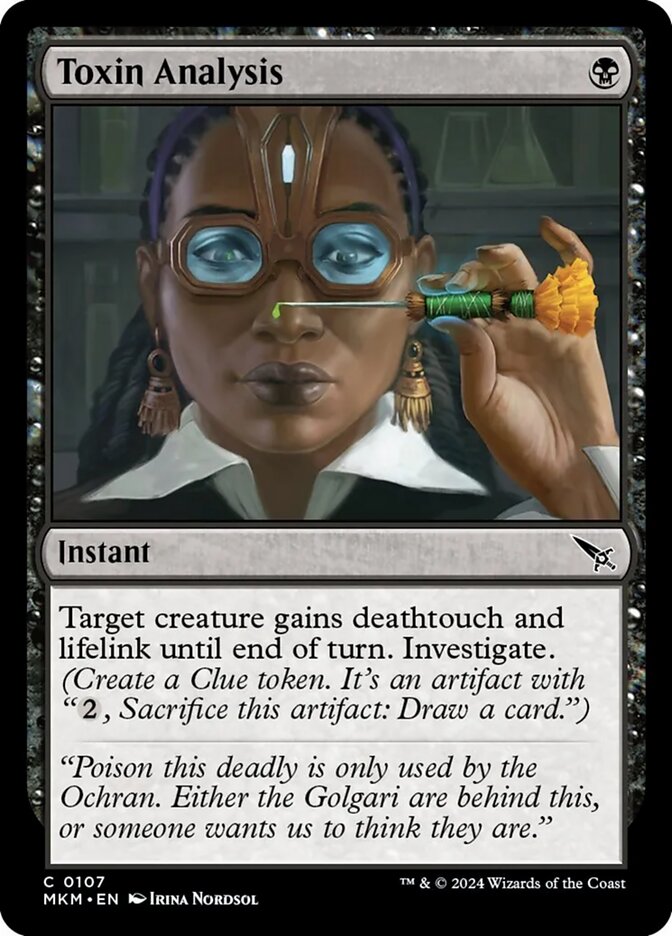
Rating: 3/10
Bladebrand was a pretty nasty card in its day. Toxin Analysis might not have the same kinds of combos, but allowing your small creature to trade for a big one and drawing a card off it is a very reasonable trade off. Lifelink is a nice touch, too.
Undercity Eliminator
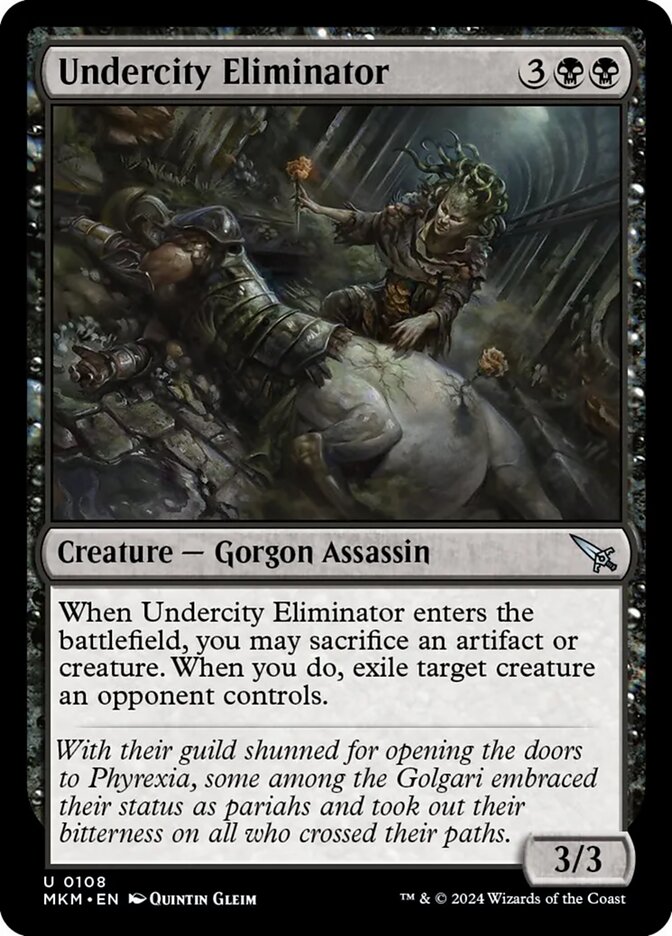
Rating: 7/10
It may come with a hefty cost, but a Nekrataal is still a Nekrataal. Exiling the target makes this an incredibly clean answer to nearly any annoying threat, and that’s just about all there is. Undercity Eliminator is very good. Take it, play it, you’ll be happy with it.
Unscrupulous Agent
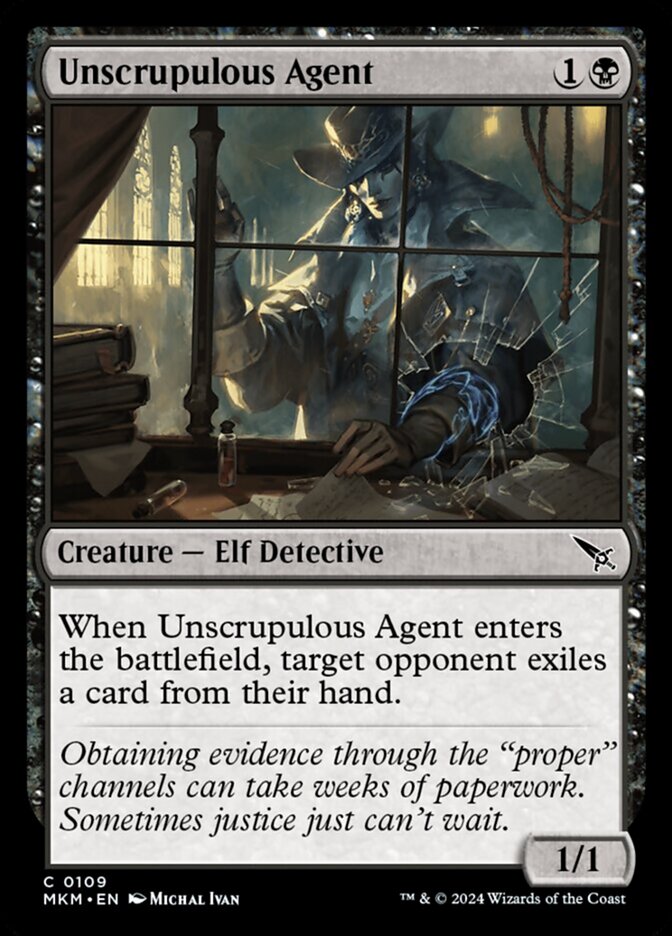
Rating: 4/10
Ever since Virus Beetle, we’ve tended to pay a lot more attention to black 2-drops like Unscrupulous Agent that attack the hand. They’re generally very good, giving a nice bit of early card advantage that can help take an early lead.
Vein Ripper

Rating: 9/10
I guess a mega Blood Artist is a real thing. Blood Artist variants tend to make good Limited cards already, so a massive one like Vein Ripper has got to be. I love the synergy between its ward cost and its trigger. Your opponent has to spend at least two cards and lose 4 life just to get this off the board, which they often won’t even be able to do. This is a nasty card that just dominates the board whenever you play it.
Red
Anzrag’s Rampage

Rating: 1/10
Anzrag’s Rampage should be nowhere near your main deck. Given the blue/red archetype is focused around artifacts, it seems like it would be a solid sideboard card against them. Outside of that matchup, this is as close to unplayable as it gets.
Bolrac-Clan Basher
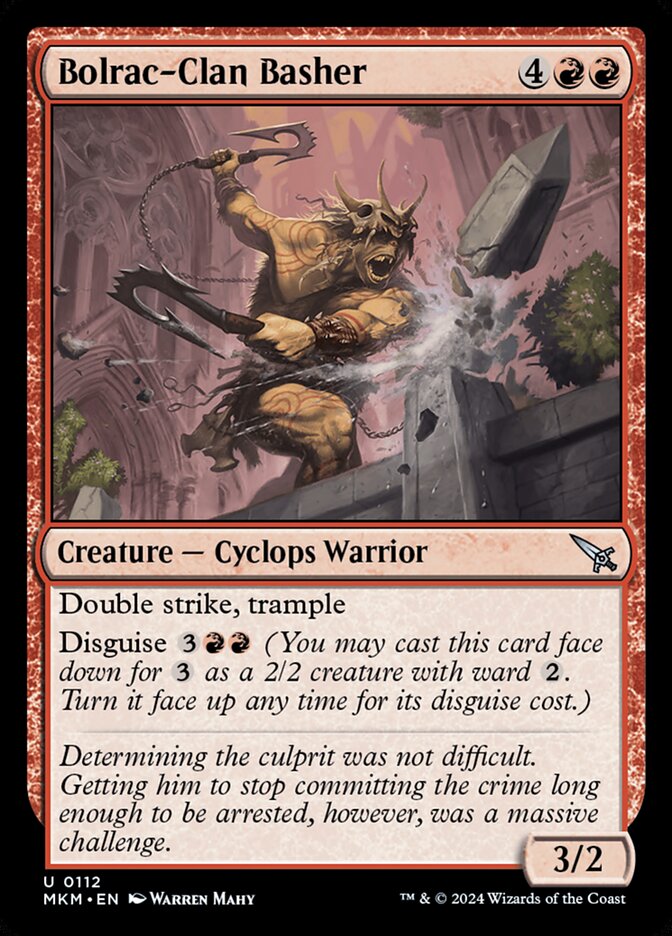
Rating: 5/10
It may only be a 3/2, but double strike and trample hits really hard, especially when it comes practically out of nowhere. Of all the creatures in the set to modify with equipment and the like, Bolrac-Clan Basher is top of the list. Regardless, this is a dangerous disguise creature that’s sure to do some good work as part of an aggressive curve.
Case of the Burning Masks

Rating: 7/10
Removal spells that draw you a card are extremely powerful, and this is pretty much just that. Three damage for 3 mana is fine, but then once the case is solved, you can trade it in for the best card out of your top three. It’s even really easy to solve, since you only need your sources to deal damage to anything, so you can play Case of the Burning Masks, attack with two creatures, and it’s done.
Case of the Crimson Pulse
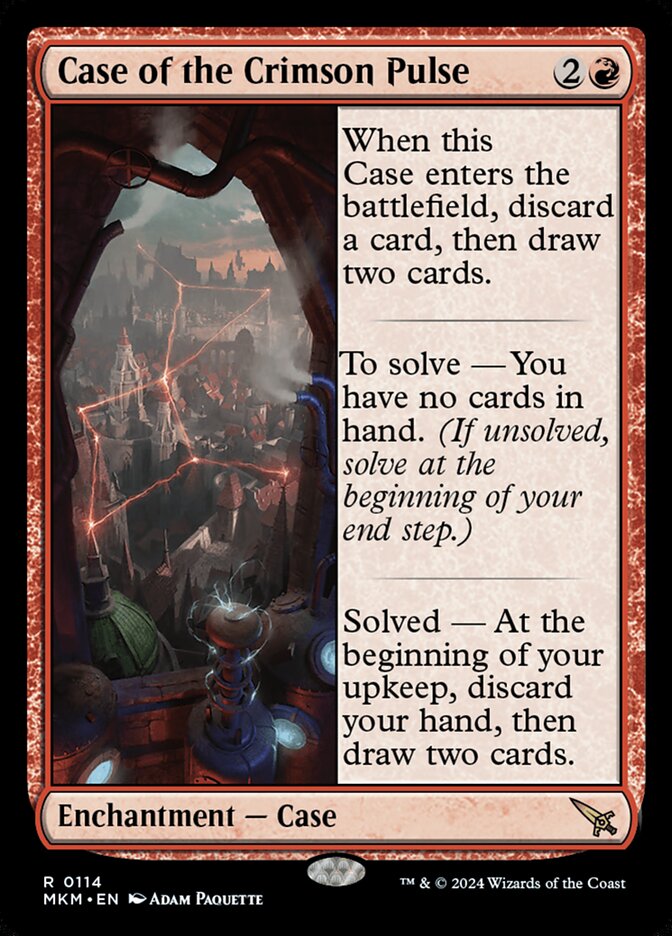
Rating: 1/10
This seems like a card with some potential, but not one that I think is good enough to explore. Tormenting Voice is only a marginally playable card already, so costing 3 mana isn’t going to help matters. Then it doesn’t do anything until you’ve used up the cards in your hand. Case of the Crimson Pulse seems like it could work in a really aggressive deck, but a deck like that is never going to want to spend mana to cast it in the first place.
Caught Red-Handed
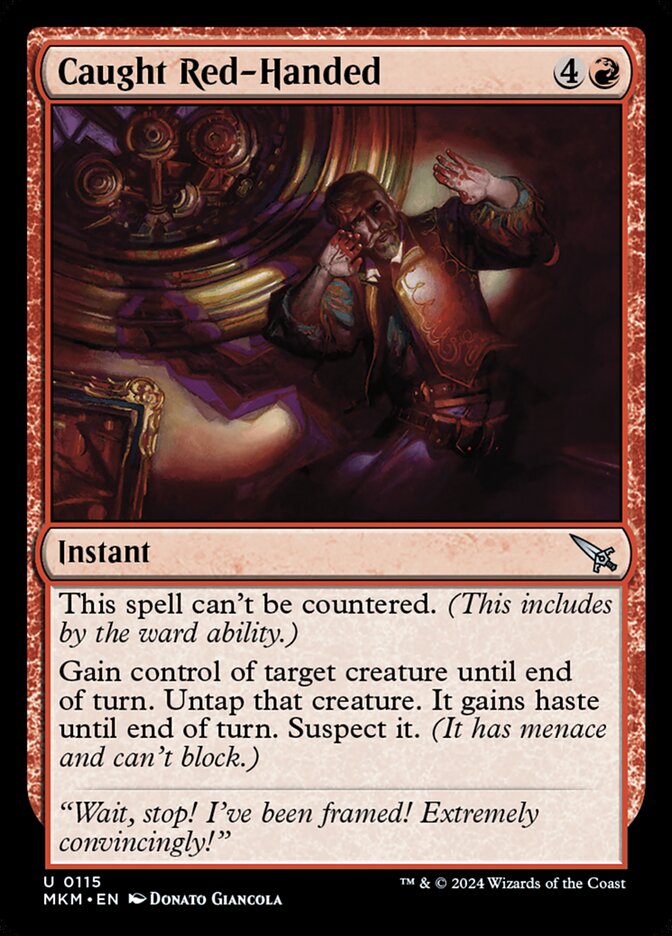
Rating: 3/10
I was excited when I saw this was instant speed, but then I realized that by suspecting the creature you steal means you can’t do the old Ray of Command trick of stealing an opponent’s creature to block with it. Without that functionality, Caught Red-Handed is little better than an Act of Treason that costs 5 mana, which I’m not so keen on.
The Chase Is On

Rating: 3/10
+3/+0 and first strike makes for a strong combat trick, and although The Chase Is On costs a bit more mana than you’d like, it replaces itself with a Clue. We’ve seen in the past that combat tricks that replace themselves in some way tend to overperform, and I assume this one should do that, too.
Concealed Weapon
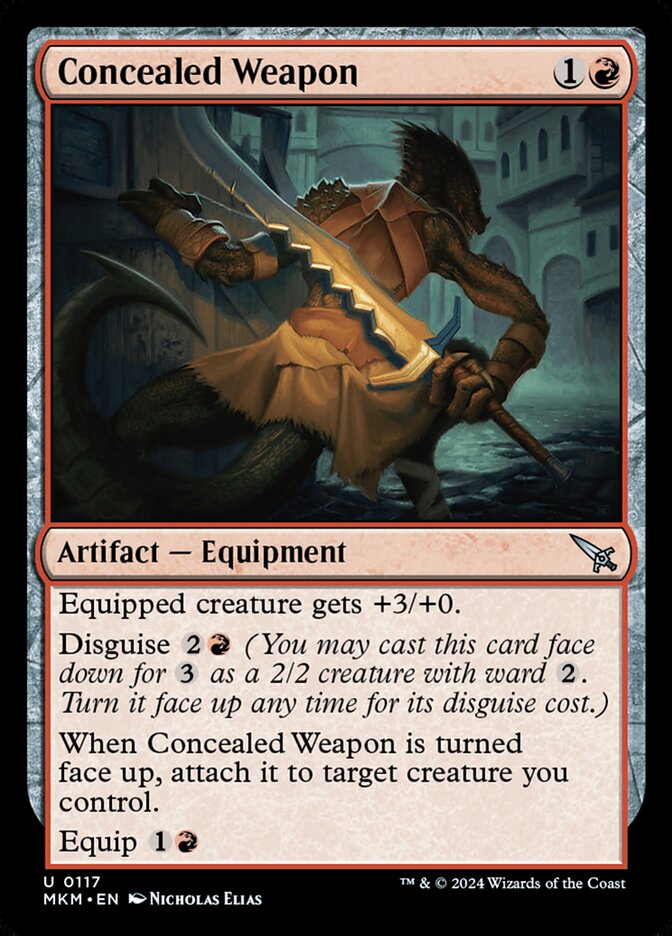
Rating: 2/10
I like the design of a disguise equipment, but Concealed Weapon feels lackluster at best. +3/+0 is so weak that it’s really hard to make any kind of an impact. You might be able to get a bit more value from it if you have first strike and double strike creatures, but overall I think this is a bit of a miss. Still, any disguise creature is at least playable, so there’s that.
Connecting the Dots

Rating: 8/10
Bomat Courier had the issue of getting outclassed quickly, limiting the cards you could draw with it, and it was still one of the best cards in Standard back in its day. This looks like the same ability on a whole other level. Connecting the Dots costs so little mana and can easily turn into a one-sided Wheel of Fortune, assuming you’re attacking regularly. That just has to be incredible.
Convenient Target

Rating: 2/10
There was a time when Hammerhand was a broken Limited card for aggro decks, but it fell short of the mark every time it was reprinted. Convenient Target has much of the same feel as that card, but with the bonus of getting to rebuy it from the graveyard. I don’t think this is particularly good, but it’s probably playable alongside some of the good suspect payoffs.
Cornered Crook
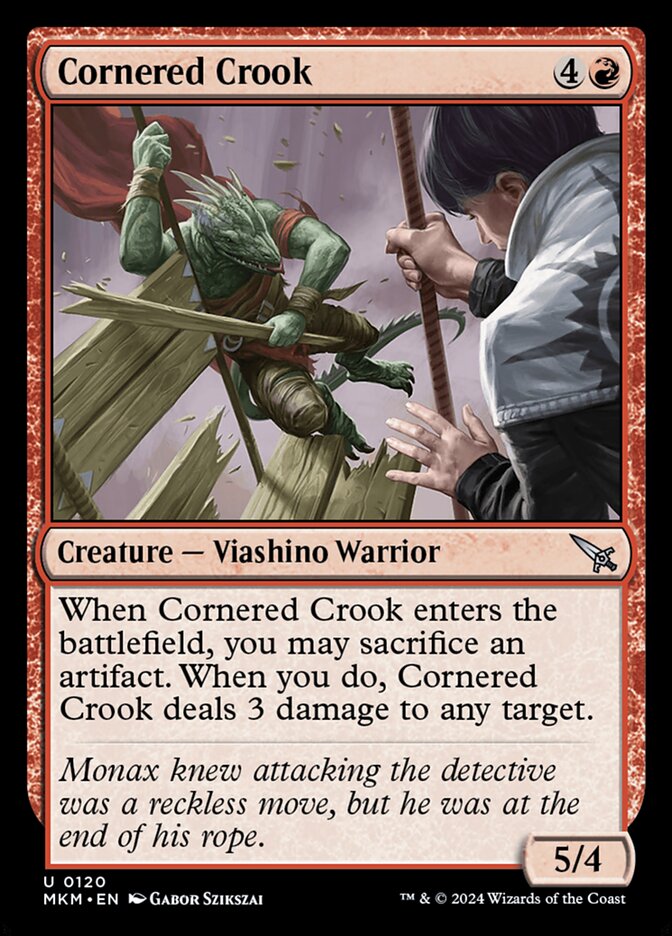
Rating: 7/10
This is one of the weakest Flametongue Kavus I’ve ever seen. I mean, being an FTK still makes it a very good creature, but I don’t like how Cornered Crook matches up so poorly against disguised creatures, costing you a total of 7 mana to deal with them. I know I’m being negative, and this is probably one of red’s best nonrare cards, but the numbers are so weak compared to many other versions of this effect. I like that it can go to the face though.
Crime Novelist
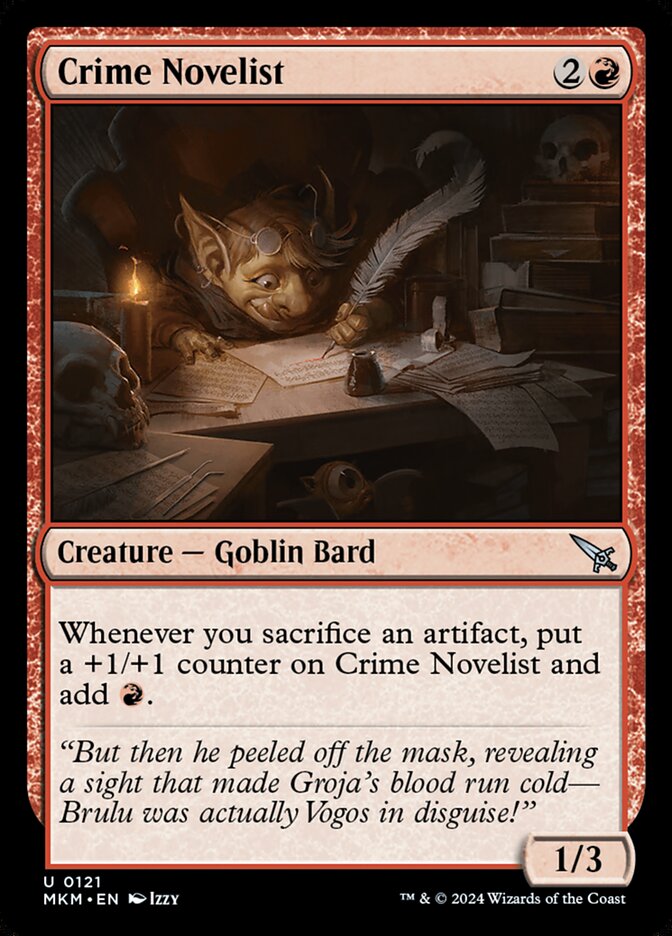
Rating: 6/10
Just look at this little guy! Having the time of his life, writing away, truly living the dream. It’s pretty damn good, too. Crime Novelist is another card that essentially makes clues cost 1 mana to sacrifice, while also growing really big, until it becomes a threat that has to be dealt with. Red/blue artifacts has a lot of great build-around cards, and this is definitely one of them.
Demand Answers
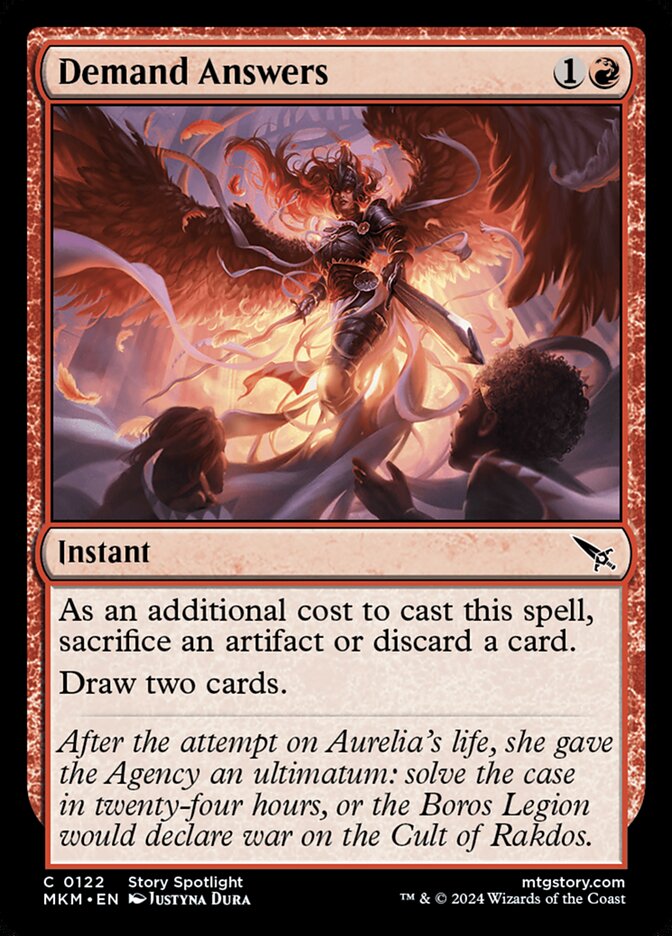
Rating: 4/10
Given the blue/red sacrificing artifacts theme, Redly Dispute looks like a really good fit. I think you’ll be more likely to sacrifice an artifact, but being given the option of discarding is great. Demand Answers is flexible and therefore a powerful card to have around.
Expedited Inheritance

Rating: 0/10
There’s a lot wrong with Expedited Inheritance. It’s symmetrical and unintuitive. It triggers whenever your creatures are dealt damage, so if you use a proactive burn spell to kill a blocker, it triggers for your opponent, not you. This just isn’t designed for Limited, and I’d steer well clear of it.
Expose the Culprit
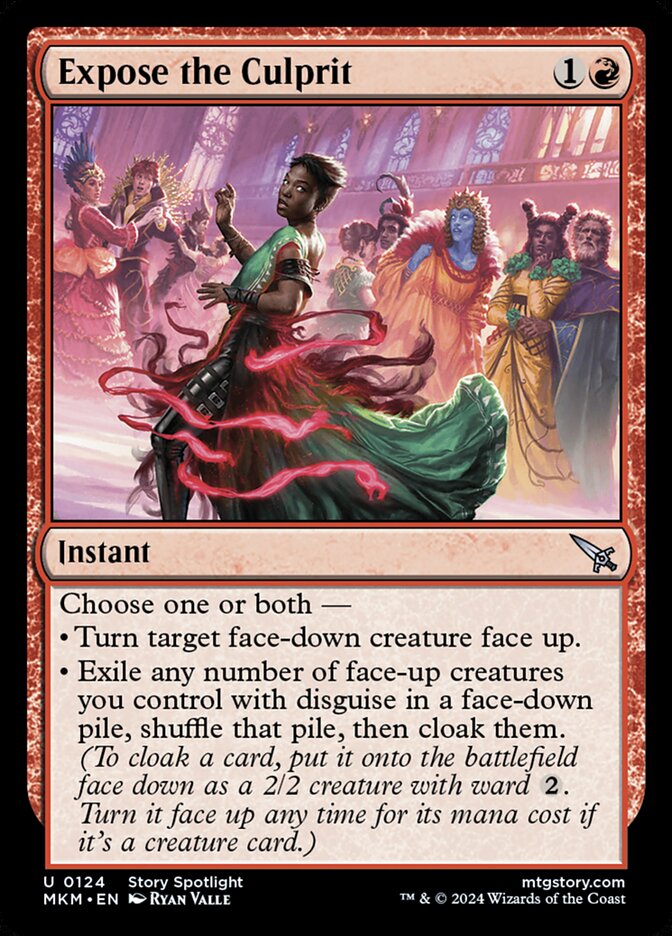
Rating: 1/10
This might have some specific uses, but neither of these modes sound like they’re worth spending a whole card on. I’d use Expose the Culprit if I had some niche combos to make use of, but in a general deck it shouldn’t be worth it.
Felonious Rage
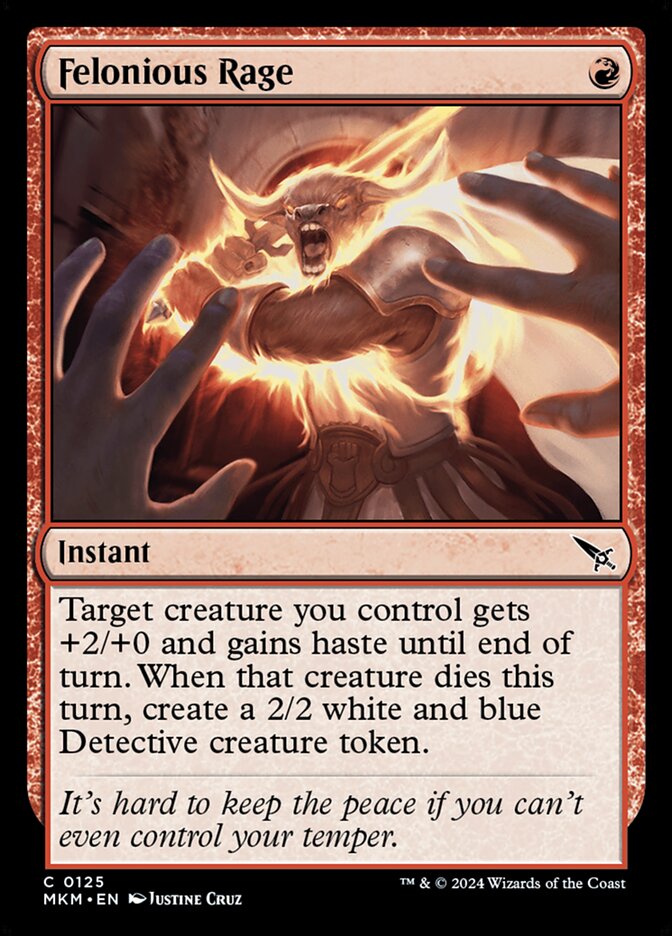
Rating: 4/10
I was really low on Make Your Mark, but it ended up being a really strong card. Allowing your creature to trade up and then leave behind a very relevant creature is a very good effect, and Felonious Rage even helps you trade up into bigger creatures.
Frantic Scapegoat
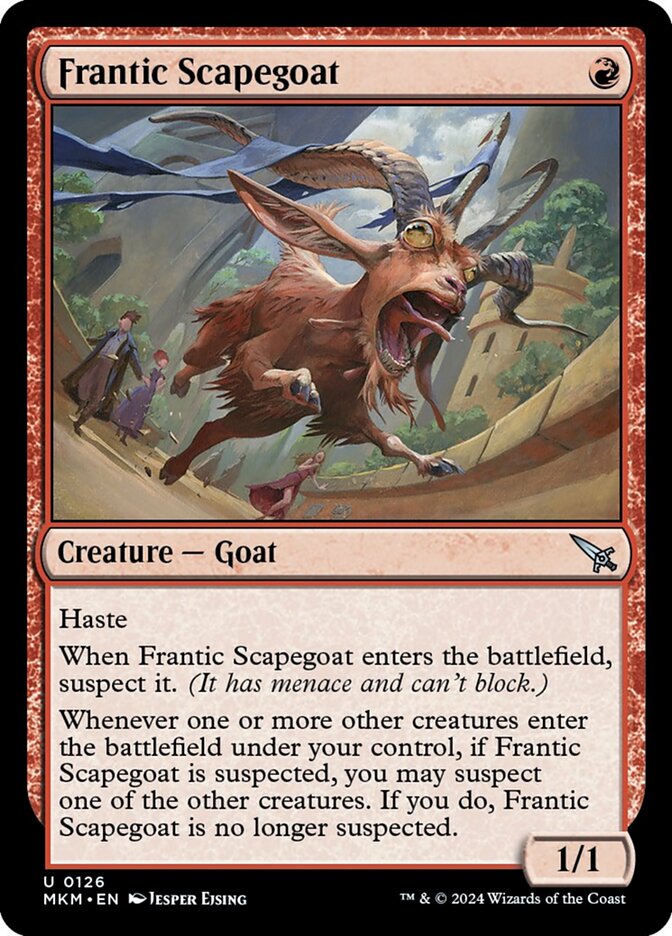
Rating: 3/10
One mana for a 1/1 haste menace isn’t too bad, especially with some relevance later in the game. Frantic Scapegoat isn’t too exciting though, as it does very little to stop it getting completely outclassed from about turn 3 onwards.
Fugitive Codebreaker
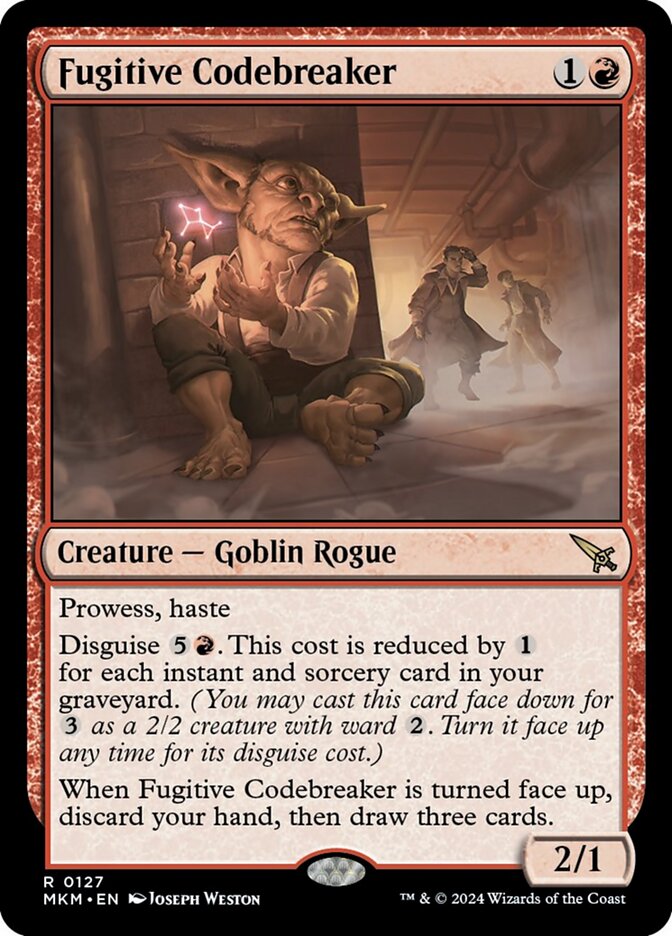
Rating: 5/10
Fugitive Codebreaker is clearly quite a powerful card. Bedlam Reveler with set’s mechanic is usually going to be good after all. My only concern is that with no dedicated theme for instants and sorceries, I don’t know how often you can get this cost reduced too low. Still, you should have at least a couple, and 4 or 5 mana to refresh your hand is still fine.
Galvanize

Rating: 6/10
The generic “2 mana deal 3” burn spell that we get in every set these days is always a welcome sight. Especially when it can very easily turn into a 5 damage spell and take out bigger creatures for so little mana, like Galvanize.
Gearbane Orangutan
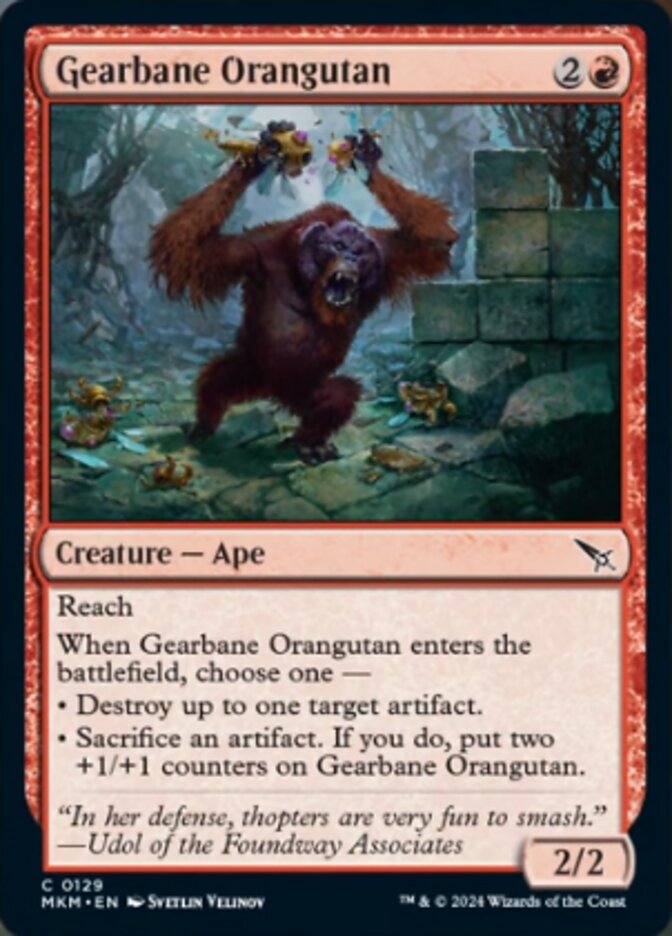
Rating: 3/10
Whether you trade a clue for two +1/+1 counters or you take out one of theirs, getting that on a 3 mana 2/2 like Gearbane Orangutan is pretty good. Oh, and beware of “secret reach”!
Goblin Maskmaker

Rating: 1/10
Attacking unimpeded on turn 2 to cast a face-down creature sounds awesome. But Goblin Maskmaker can only do that if you have it on turn 1. Any other time, it’s horrendously bad and just not worth spending a whole card on.
Harried Dronesmith
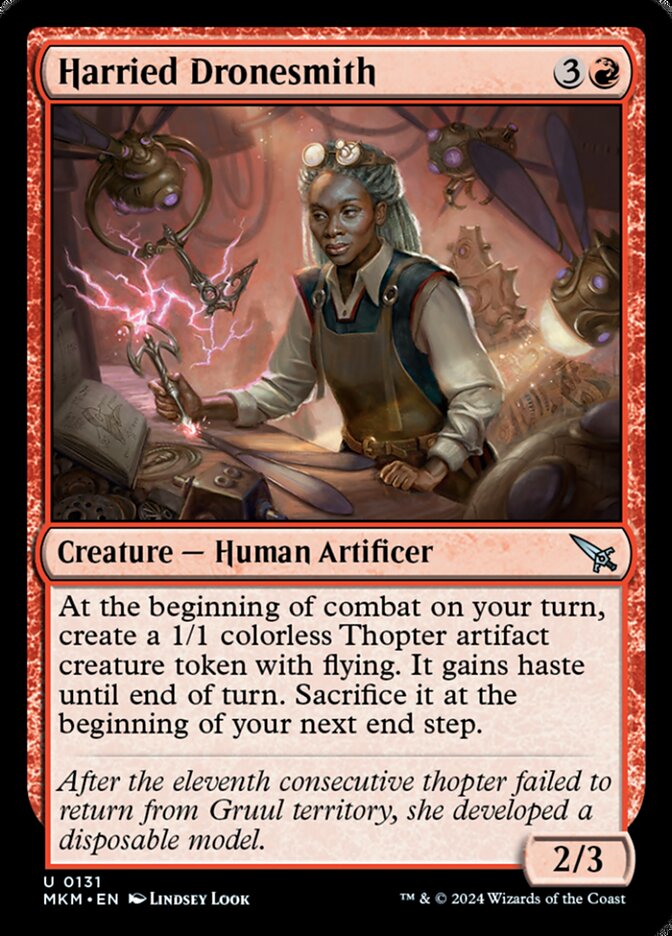
Rating: 3/10
This effect on its own isn’t good enough to carry the card. If you have anything to go along with it, perhaps something that cares about artifacts entering the battlefield or being sacrificed every turn, then this can do some work. Sadly, Harried Dronesmith is a bad enough card in a vacuum that it won’t be good enough anywhere else.
Incinerator of the Guilty
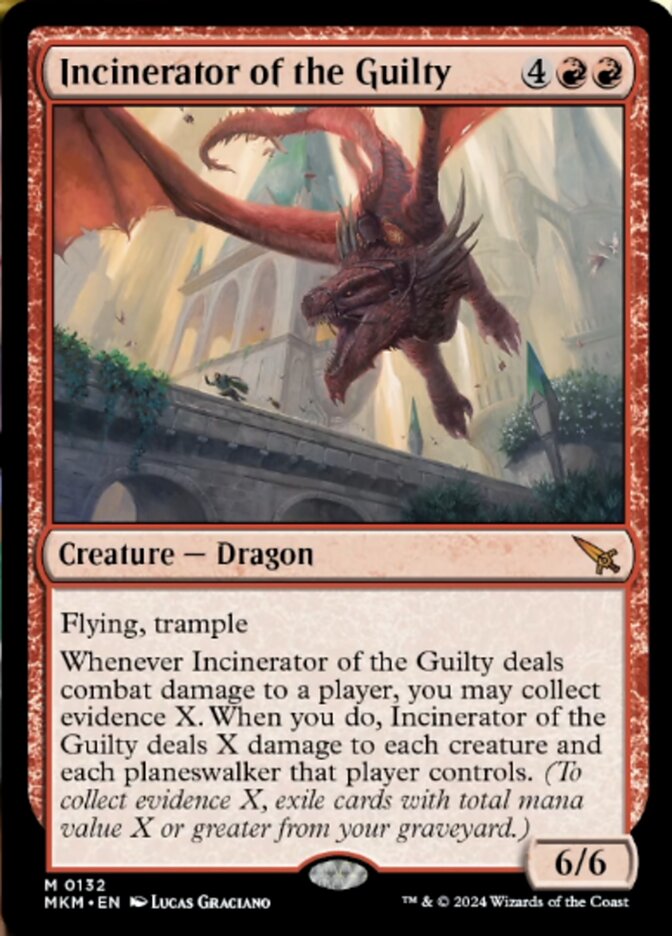
Rating: 10/10
Oh my! Now this is a reason to be collecting evidence. I’m sure the Commander players reading this are familiar with how busted Balefire Dragon can be, and in many ways this dragon is even better. Incinerator of the Guilty only needs to connect for 1 point of damage to trigger, then it wipes your opponent’s entire board. It’s just disgusting and has to be one of the most powerful cards in the whole set.
Innocent Bystander

Rating: 2/10
I guess you get to investigate if Innocent Bystander trades off with a 3/2 or something. That’s great, but it doesn’t seem all that likely to happen, and you wouldn’t bother with a vanilla 2/1 for 2.
Knife
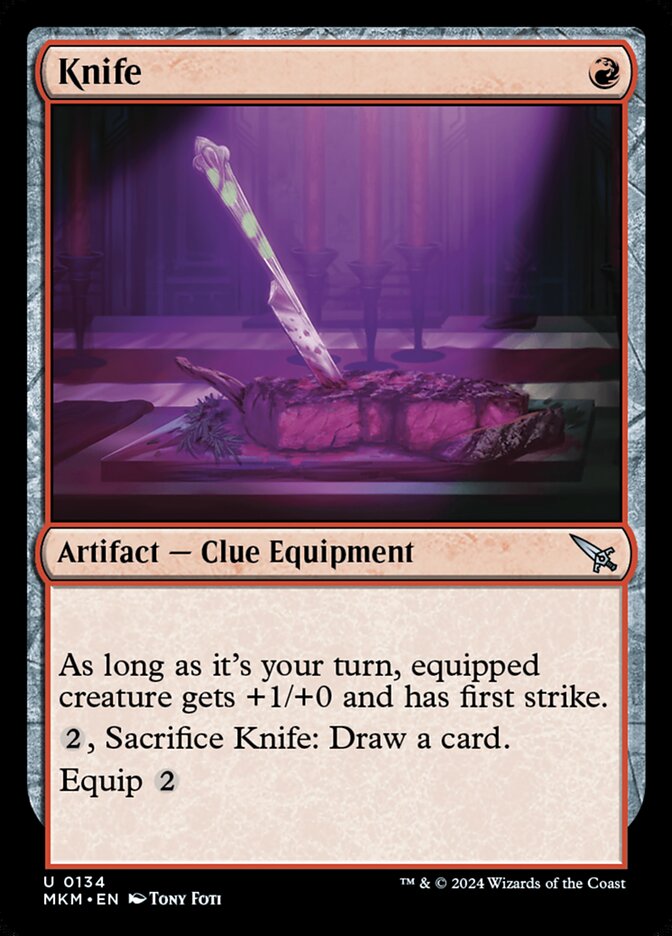
Rating: 3/10
This looks like one of the better Clue(do) equipment cards, as first strike is much better at helping your creature survive combats than extra points of toughness might be. Still, Knife is a cheap clue that helps to enable some of the set’s archetypes, and that makes it playable.
Krenko, Baron of Tin Street
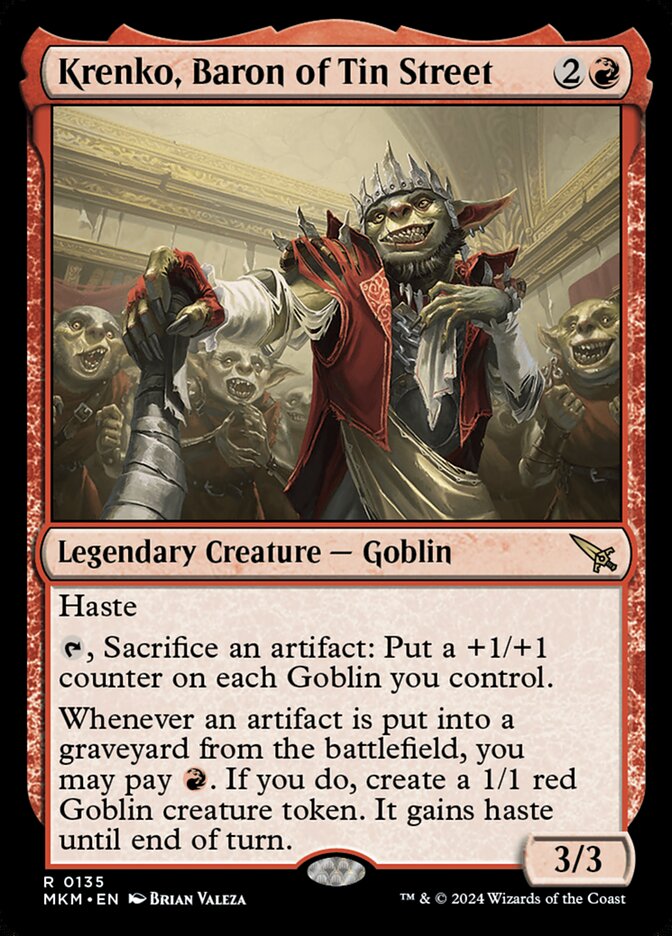
Rating: 10/10
The legendary Krenko, Baron of Tin Street just does it all. For starters, I’d give a 3/3 haste for 3 an easy 6/10 and put that in any aggressive red deck. Getting free goblin tokens whenever you do the thing you were going to do anyway is awesome. Whether you sacrifice clues or trade off artifact creatures in combat, this should be triggering a lot. Then there’s its activated ability to round things out. A free way to sacrifice an artifact each turn that, thanks to how the stack works, puts a counter on the token you make with Krenko’s trigger as well as itself and your other goblins. Krenko is clearly best suited for the red/blue archetype, and that’s what this grade is mainly based on, but it can go in any red deck and be a valuable card.
Krenko’s Buzzcrusher
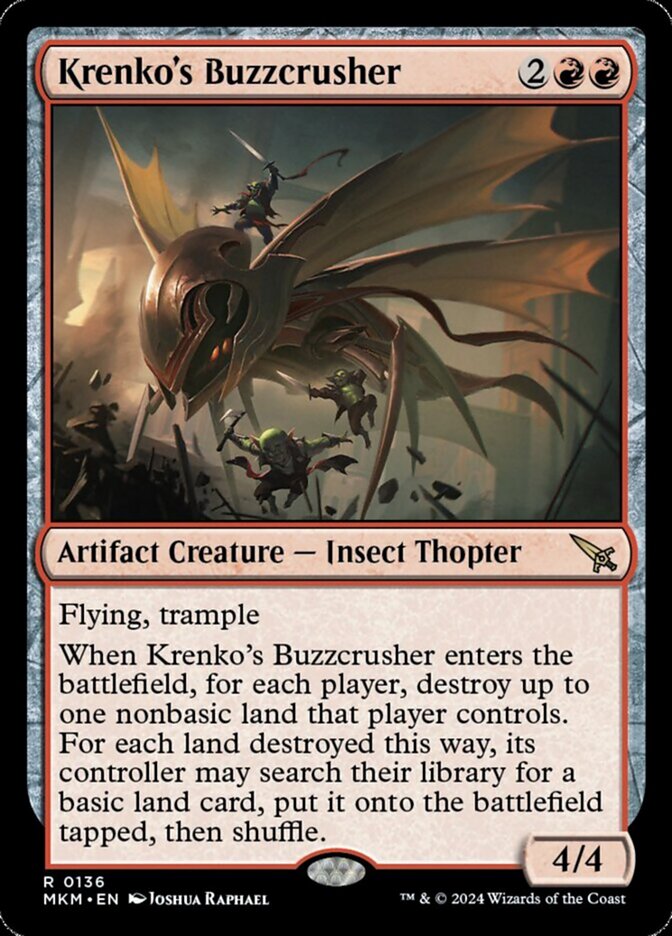
Rating: 6/10
Destroying non-basic lands is basically irrelevant text, so all you’re looking in Krenko's Buzzcrusher at is a 4/4 creature with flying and trample for 4 mana. I say “all”, but that’s honestly pretty good in its own right.
Lamplight Phoenix
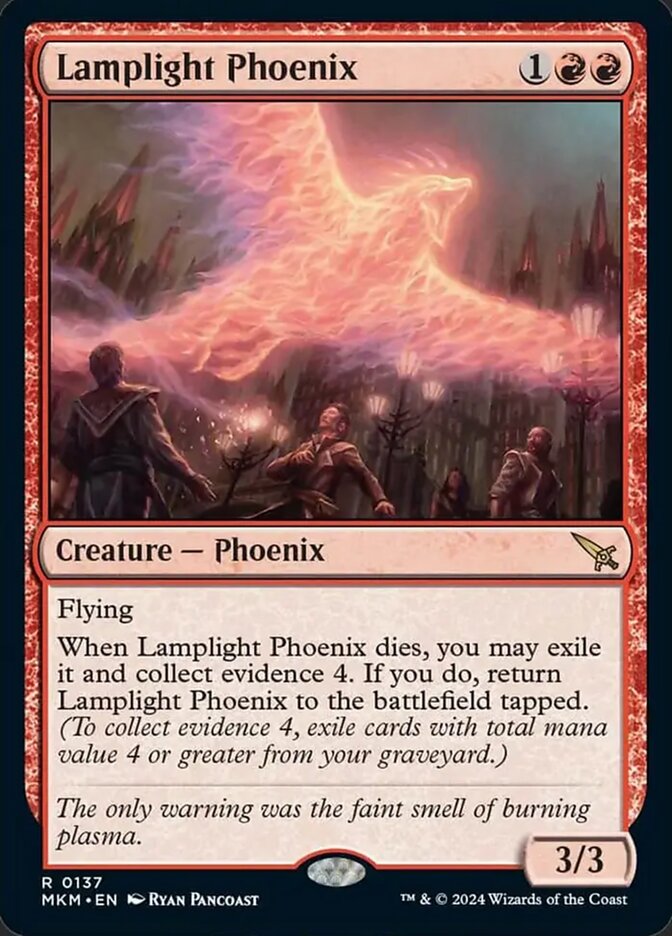
Rating: 8/10
Lots of the generic phoenixes end up being a bit weak because they’re too small, can’t block, or are forced into attacking. The fact that none of those issues are present in Lamplight Phoenix is exactly what makes me excited for it. Three mana is great value for a 3/3 flier and no downside, plus only needing to collect evidence 4 to get it back when it dies means you should be able to keep it around for quite a long time.
Offender at Large
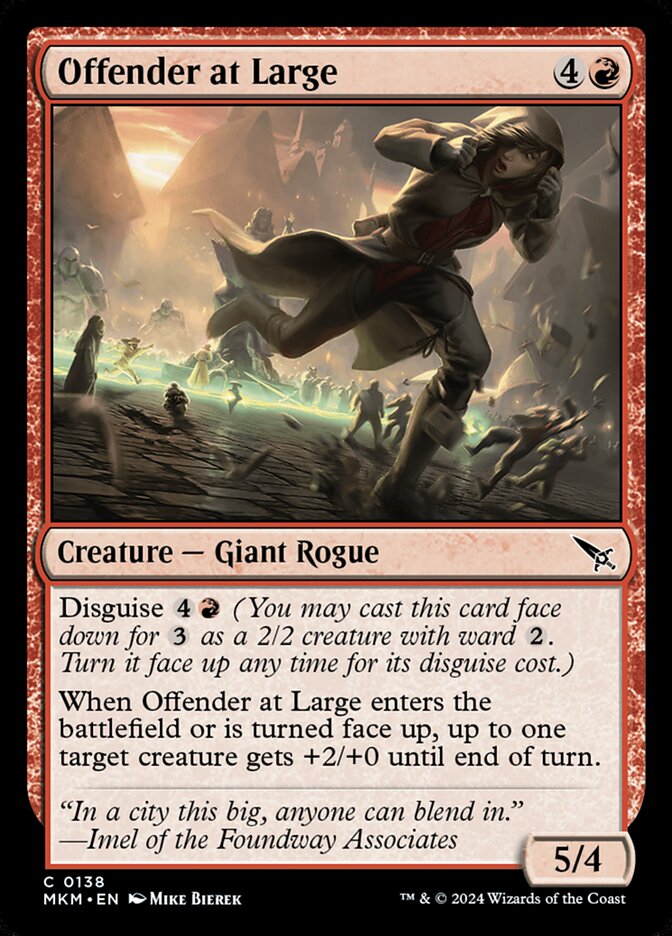
Rating: 2/10
Once again, Offender at Large is at least playable because it has disguise, but its ability is so minor that it’s not going to be too good beyond that.
Person of Interest
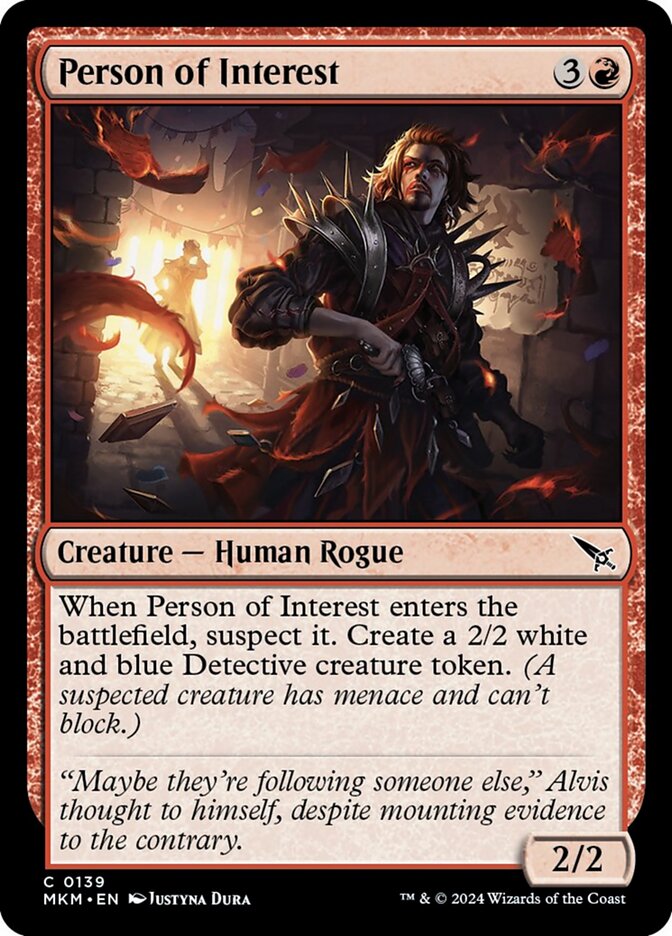
Rating: 4/10
Person of Interest is a proper common. Four mana for a pair of 2/2s is a formula we’ve seen be successful time and time again, and I don’t expect that to stop now.
Pyrotechnic Performer
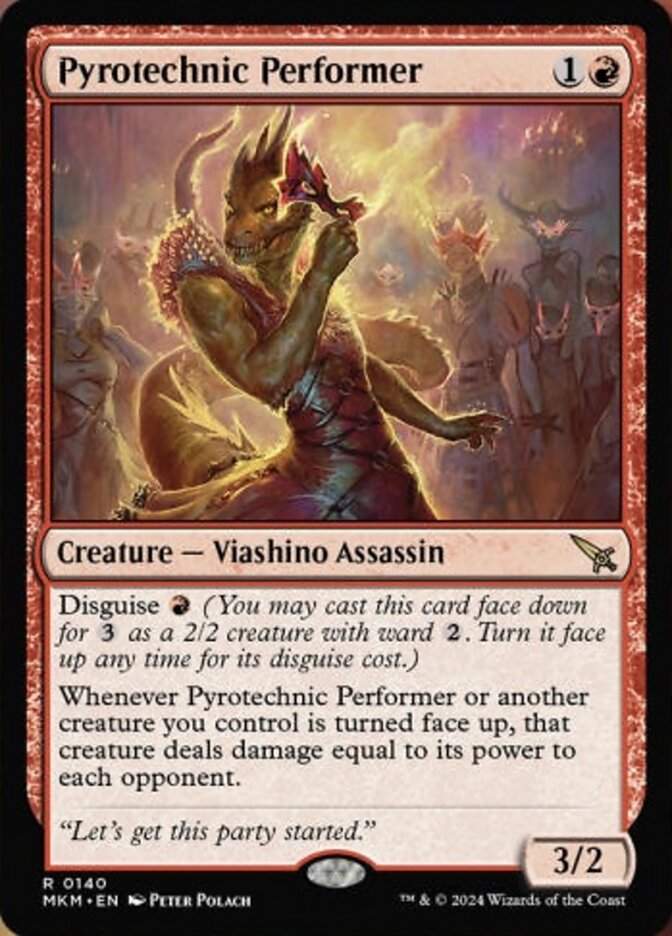
Rating: 7/10
If you’re in one of the disguise archetypes, there are going to be few payoffs quite as aggressive as Pyrotechnic Performer. It does so much damage that you won’t even need to attack to close out games. Just get your opponent down to about 12 life with your early attacks, then sit back and flip over a couple of big fatties and you’re done.
Reckless Detective
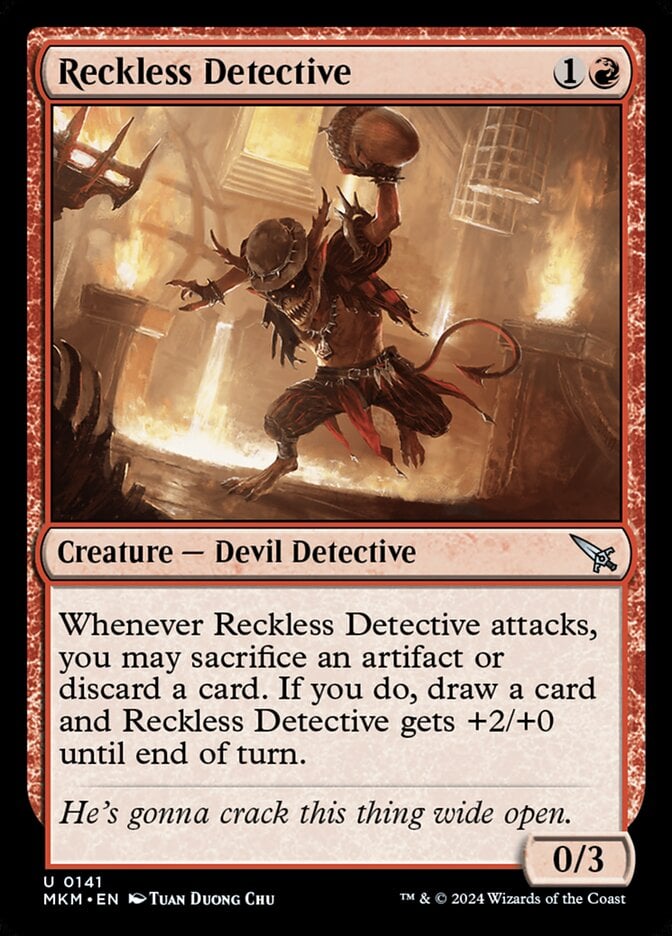
Rating: 5/10
I really like how this gives you a card back. It really makes Reckless Detective good enough, letting you crack clue tokens for free or loot away excess lands while attacking as a solid 2/3 for two. I think it’s a really strong early play that I’ll be happy to play in virtually any red deck.
Red Herring
Name: 10/10
Rating: 3/10
Valley Dasher was a decent aggressive card the last time we had face-down 2/2s, so I’d assume that this card also has its place. You’re priced into sacrificing Red Herring to get your card back the minute that an opponent puts down a bigger creature, but that isn’t too likely to happen until much later in the game.
Rubblebelt Braggart
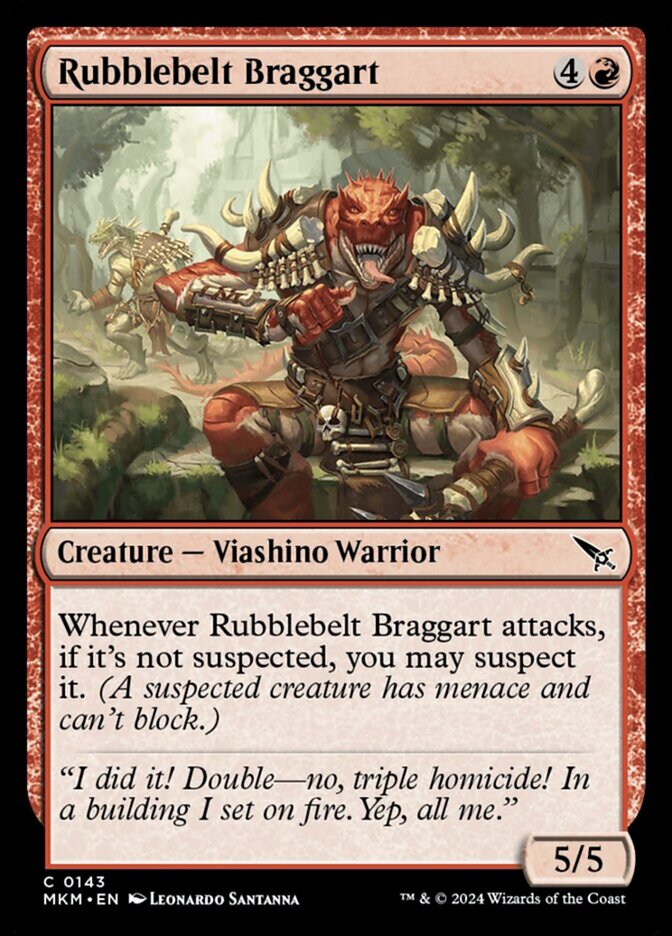
Rating: 3/10
We’ve had very few 5/5 menace creatures for 5 mana, but similar cards have always been reasonable. Five-drops are never a high priority to pick up, but Rubblebelt Braggart is likely among the stronger options available if you do want one.
Shock
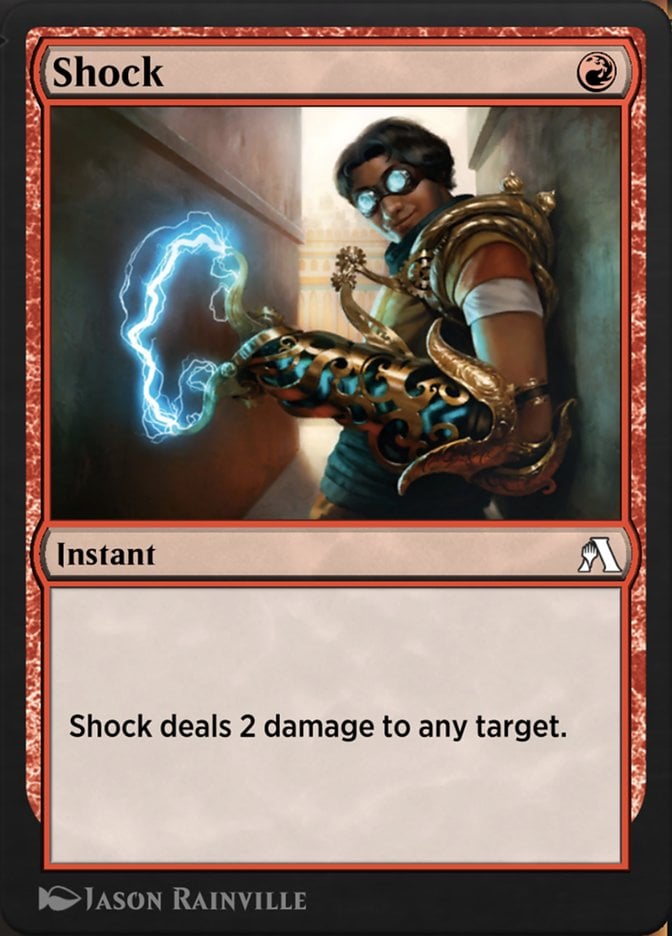
Rating: 5/10
Shock is a classic at this point, and it looks quite good in this format. It costs 2 extra mana to destroy a disguised creature, but there are also a lot of creatures that naturally have 2 toughness for you to target.
Suspicious Detonation
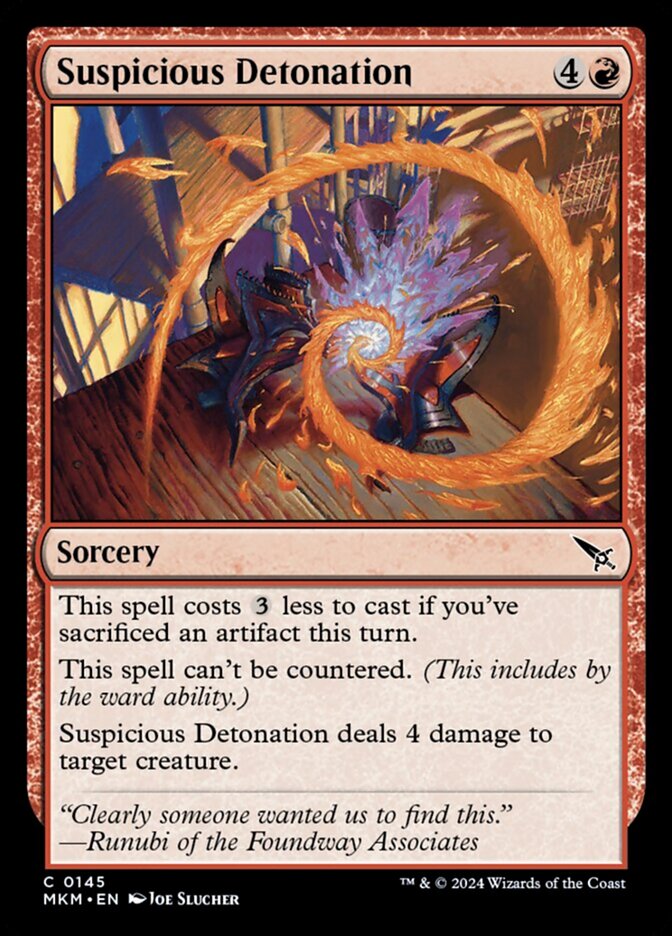
Rating: 4/10
Most decks should have access to at least a couple of clues to turn Suspicious Detonation into a 2 mana burn spell. Being uncounterable also makes this a really efficient answer to disguised creatures. If you really can’t enable the cheaper cost on it, it’s not strong enough to run, but most decks should have some outs to do so.
Torch the Witness
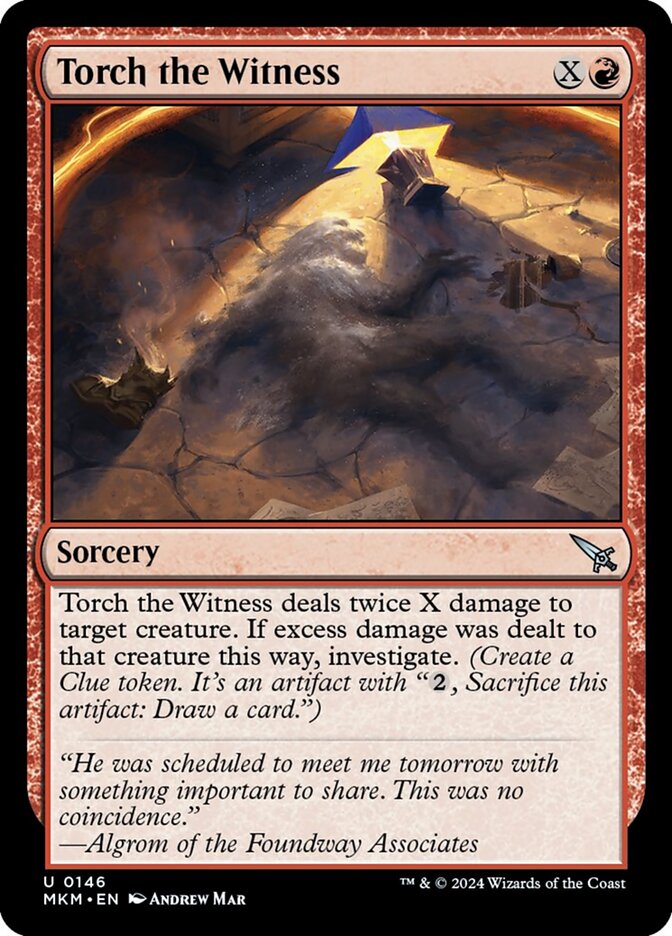
Rating: 7/10
Scalable burn spells are great for killing any creature you need to. Better yet, it’s incredibly easy to deal excess damage and have this get you a Clue, too. Any removal spell that gives you an easy two-for-one is just incredible, and this had to be one of the set’s best removal spells.
Vengeful Tracker

Rating: 5/10
Good 2-drops are at a premium in this set, and they match up well against disguise creatures. Vengeful Tracker is definitely a reasonable one and should be pretty effective at punishing decks that want to sacrifice a lot of clues. If you put this in an aggressive deck, you’ll end up putting your opponents into situations where they can’t sacrifice anything or they’ll just die, and that seems very valuable to me.
Green
Aftermath Analyst
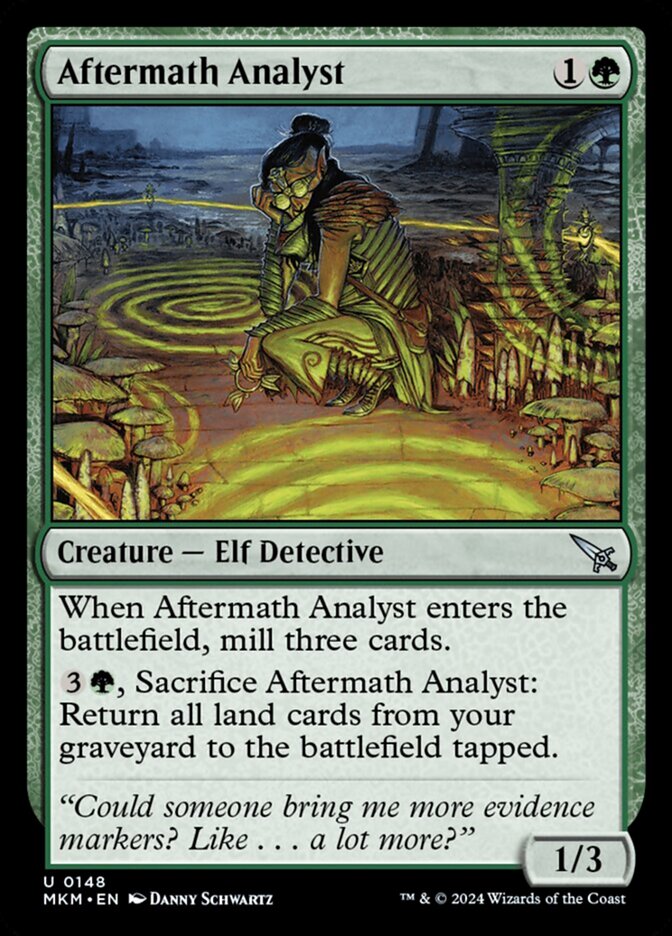
Rating: 4/10
This seems like a nice self-mill enabler. It’s worth noting that because they have a mana value of 0, there’s no advantage to exiling lands to collect evidence, so you should be able to get a few lands if you sacrifice Aftermath Analyst later in the game, but the milling is all you really care about and it’s fine at that.
Airtight Alibi
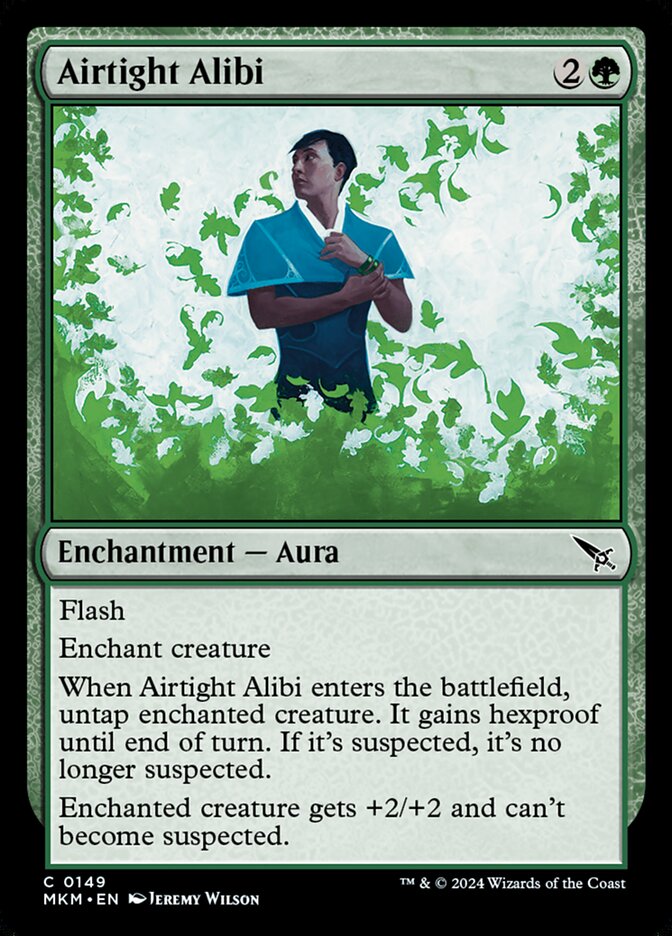
Rating: 2/10
My estimation of these flash auras has gone way down in recent years. I doubt that removing suspicion from the enchanted creature is enough of an upside that it changes my views on it. Airtight Alibi is technically playable, but I don’t think it’s all that good.
Analyze the Pollen
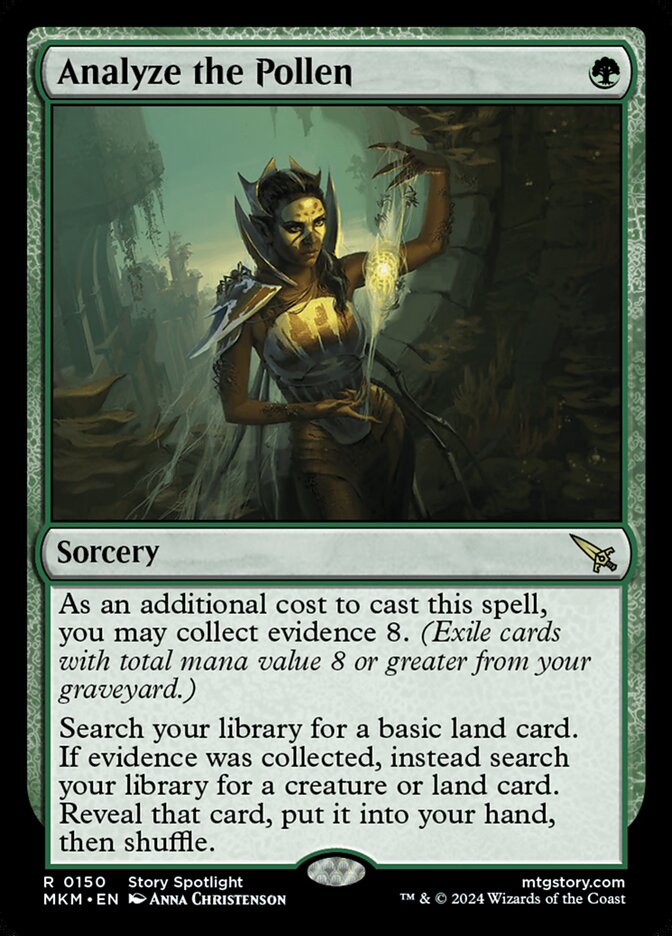
Rating: 5/10
The fact that Analyze the Pollen is a playable card without collecting evidence is what makes it good. Lay of the Land is fine to help your fix colors, and then in the late game it can just grab the best creature in your deck. Seems good to me.
Archdruid’s Charm
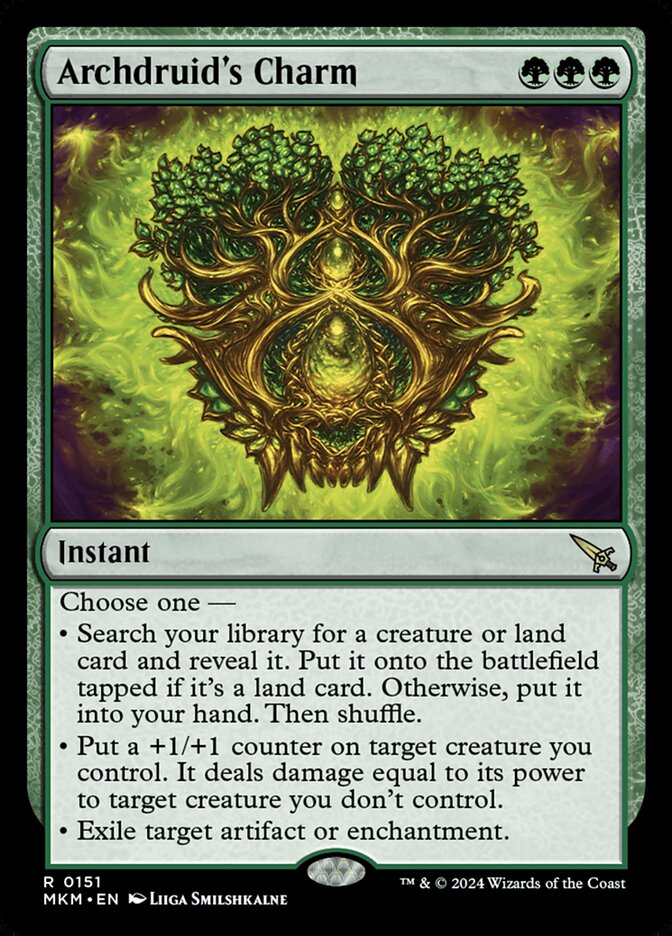
Rating: 5/10
The green Archmage's Charm isn’t something I expected to get from this set, but here we are. The first and third modes of Archdruid's Charm are largely irrelevant, so I’m mostly looking at the second one. Clear Shot is an absolutely ridiculous trick, and this is even better, plus you get access to what the other does as a bonus. However, that triple green casting cost is pretty scary and really holds it back from being a phenomenal removal spell.
Audience with Trostani
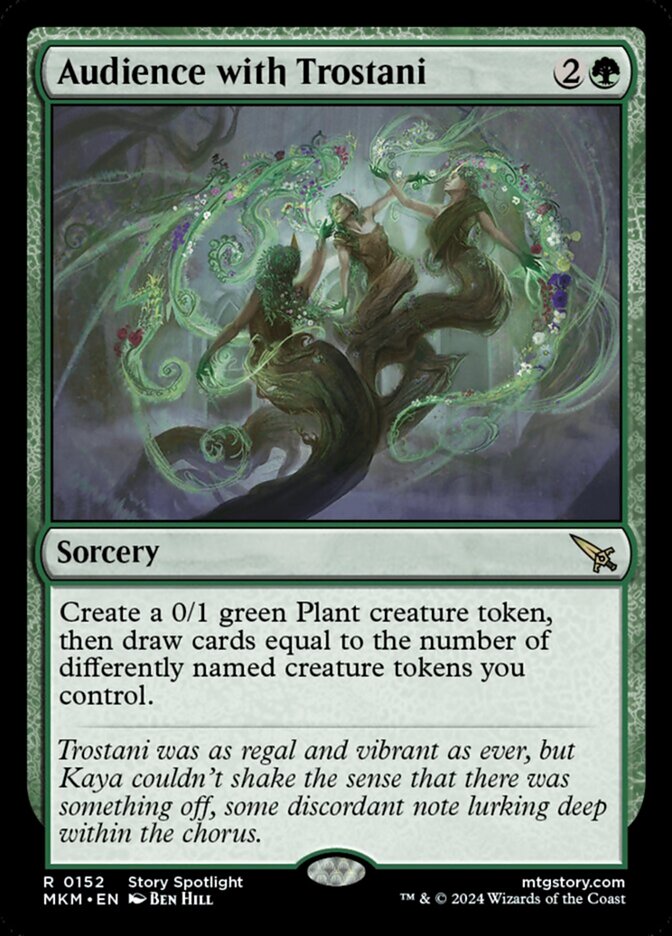
Rating: 4/10
How good is a 0/1 that draws a card? It’s fine, just not too exciting. You only need one other token out to make Audience with Trostani a very good Divination, and with all the 2/2 Detective tokens lying about, I’m sure that’s doable.
Axebane Ferox
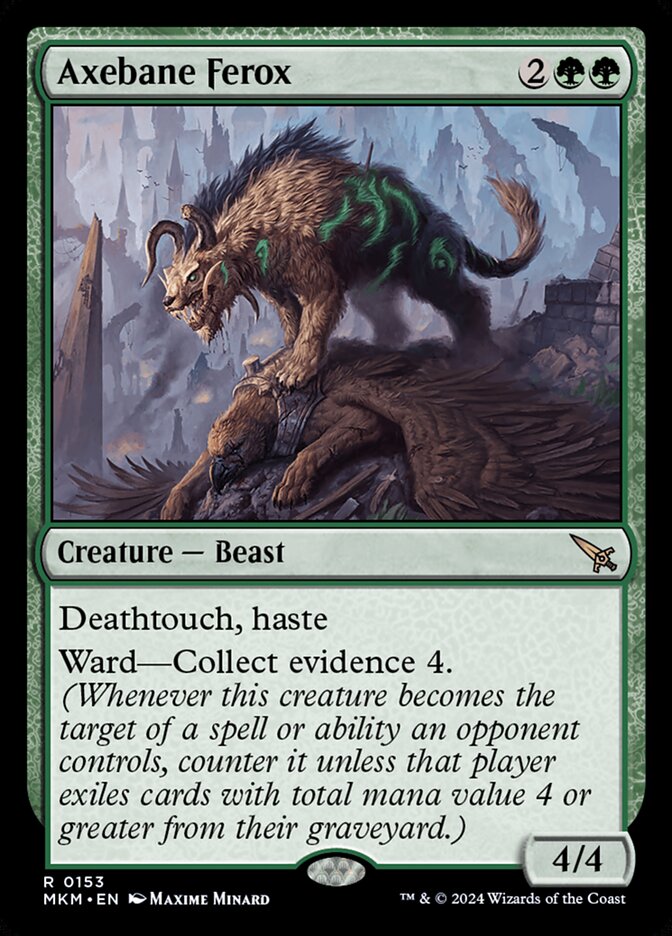
Rating: 8/10
These big haste creatures out of green are always pretty nasty. This is an odd collection of abilities to see on it, but they’re all free upsides when you’re happy enough hitting them with a 4/4 haste.
Bite Down on Crime

Rating: 4/10
The fact that you don’t need to collect evidence with this for it to be a solid card makes all the difference. Casting Bite Down on Crime for 4 mana isn’t ideal, but also not the worst. The +2/+0 buff should allow you to kill off most annoying creatures your opponent has, just be sure to get your timing right so you don’t get blown out by an instant of some kind.
Case of the Locked Hothouse

Rating: 6/10
I don’t care about getting additional land drops at first, but Case of the Locked Hothouse should be fairly easy to solve. Once you do, it becomes a very versatile Future Sight. You’ll even be able to play those extra lands each turn and be almost guaranteed to find a creature to play. Green doesn’t tend to get good card advantage engines, but this definitely looks like a good one.
Case of the Trampled Garden

Rating: 7/10
I don’t know if you’ve ever gotten to play with Curse of Predation, but the card is absolutely nuts in one-on-one games. Case of the Trampled Green is very similar. You get a pair of +1/+1 counters right away, then once it’s solved (which is trivially easy to do), it gets you an extra counter every turn. Not to mention that trample makes a huge difference to combat. Everything here adds up to a pretty strong card, and I’d look to take it very early.
Chalk Outline
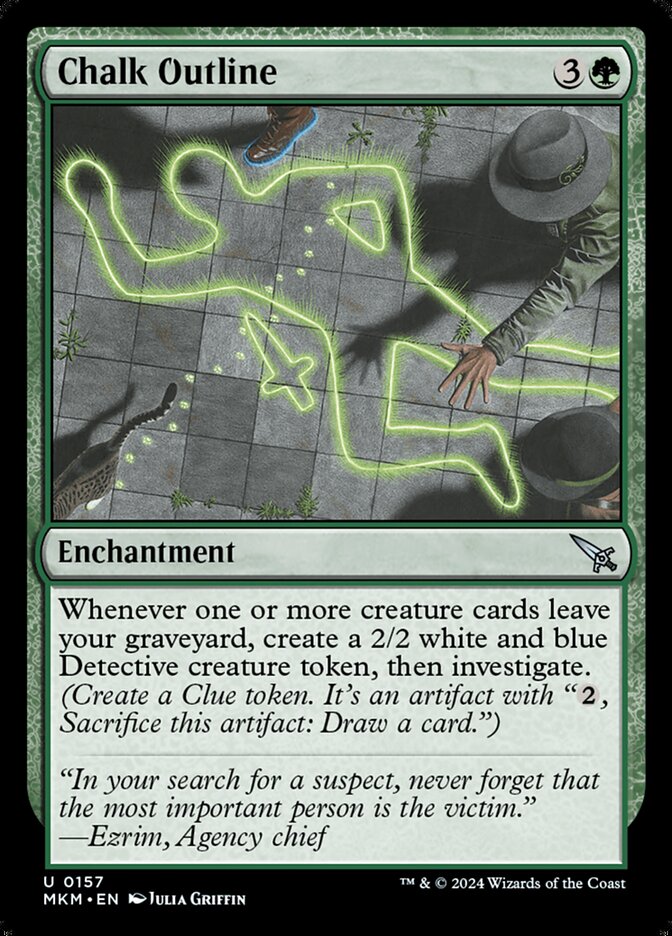
Rating: 5/10
I absolutely love build-around enchantments like Chalk Outline. Getting paid off with a huge bonus whenever you do the thing is something I really want to try doing. I’m not sold on this green/black archetype of having creatures leave your graveyard, but getting a Detective and a Clue is enough to sell me on it being worth trying.
Culvert Ambusher
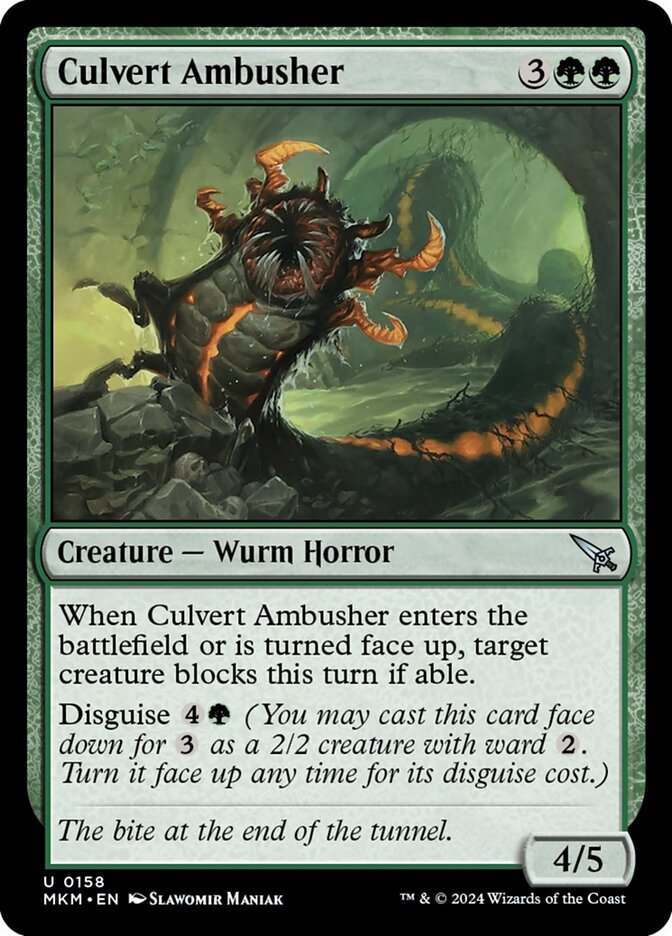
Rating: 3/10
The ability to force a target creature into blocking sounds like it would be great, but in practice it’s far too situational. If you want to use this to kill something big, you need to be attacking with something bigger or with deathtouch, and there’s nothing stopping your opponent from double blocking to make it a trade. It’s definitely not nothing, but it’s not something that makes Culvert Ambusher better than just a medium playable.
Fanatical Strength
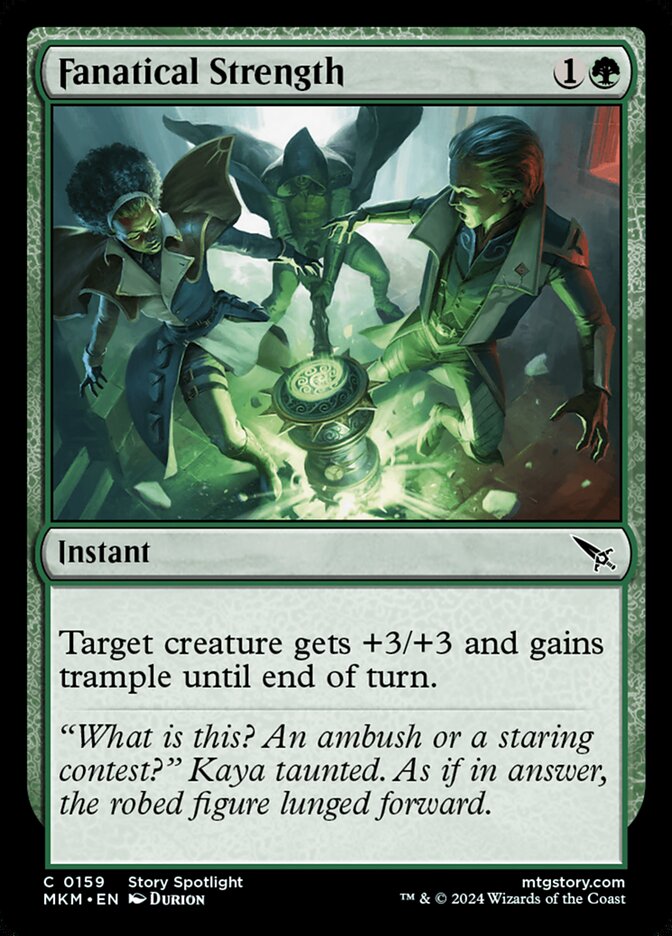
Rating: 3/10
Trample really shines here, and Staggering Size really showed that off by being one of green’s best commons in The Lost Caverns of Ixalan. We can’t tell if Fanatical Strength will be just as good yet, but the potential is there, and it’s just a good combat trick.
Flourishing Bloom-Kin
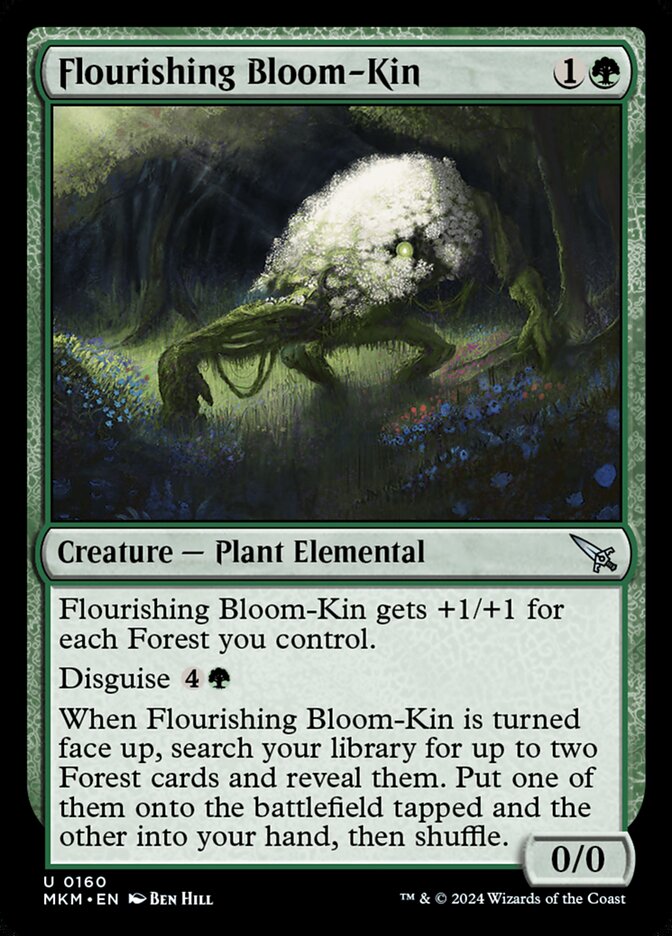
Rating: 2/10
As much as I love ramp, I don’t think spending 5 mana to flip Flourishing Bloom-Kin up sounds all that appealing. If you happen to end up drafting mono-green then it looks exceptionally good as a 2-drop, but I don’t like it much elsewhere.
Get a Leg Up
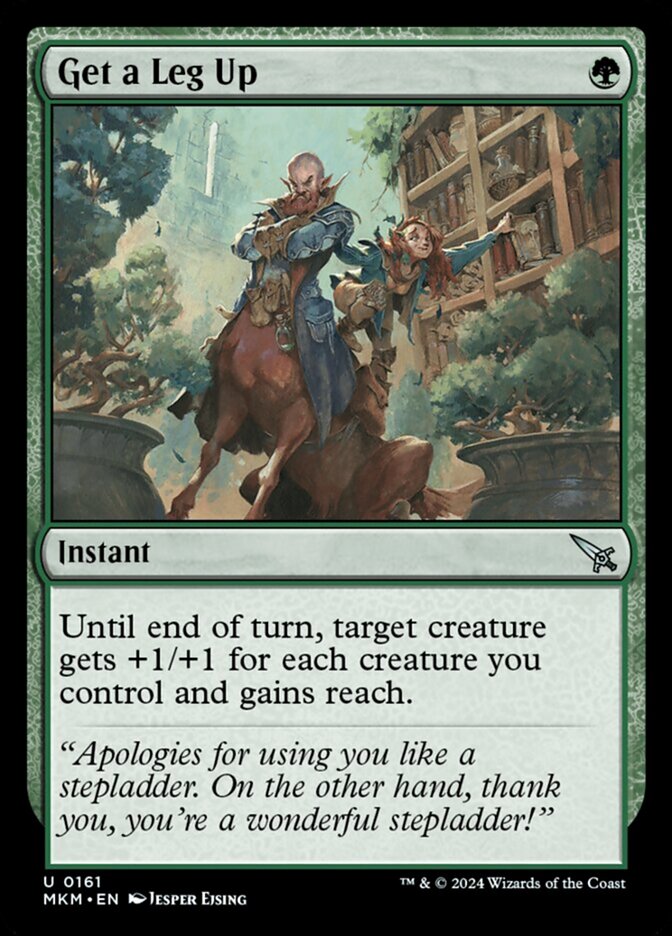
Rating: 2/10
One mana combat tricks always have potential, but needing several creatures in play for Get a Leg Up to do anything really holds it back. Some decks can’t make use of this, so be careful where you play it.
Glint Weaver
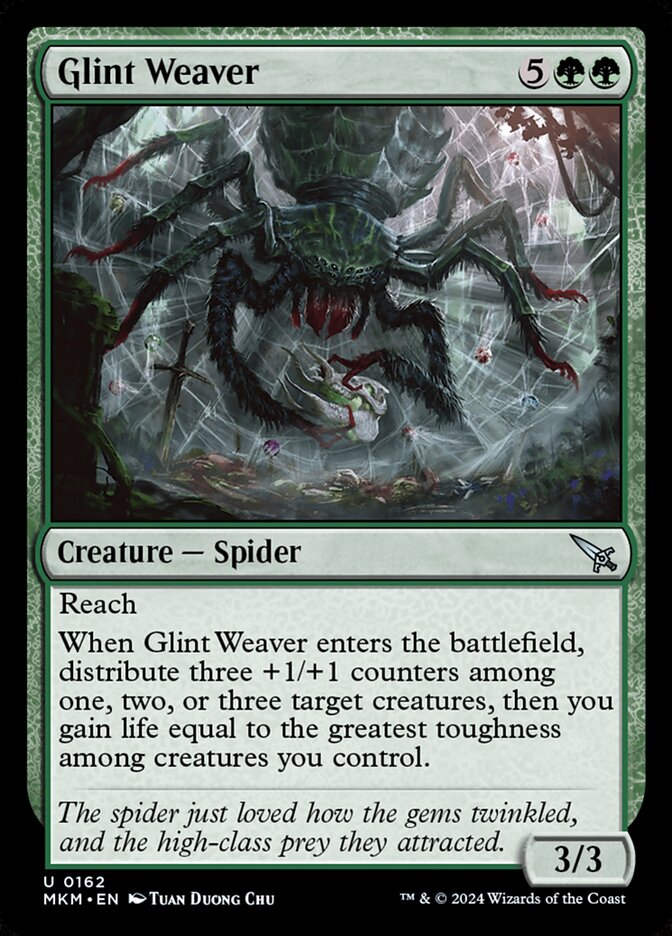
Rating: 6/10
The best part about Glint Weaver is the fact that in a vacuum, it’s a 6/6 reach for 7 that gains you 6 life. We’ve seen that same type of card be extremely good in previous sets. But it doesn’t stop there. The ability to spread counters around and give yourself profitable attacks on the turn you play it is huge, and it really puts this card over the top for me.
Greenbelt Radical
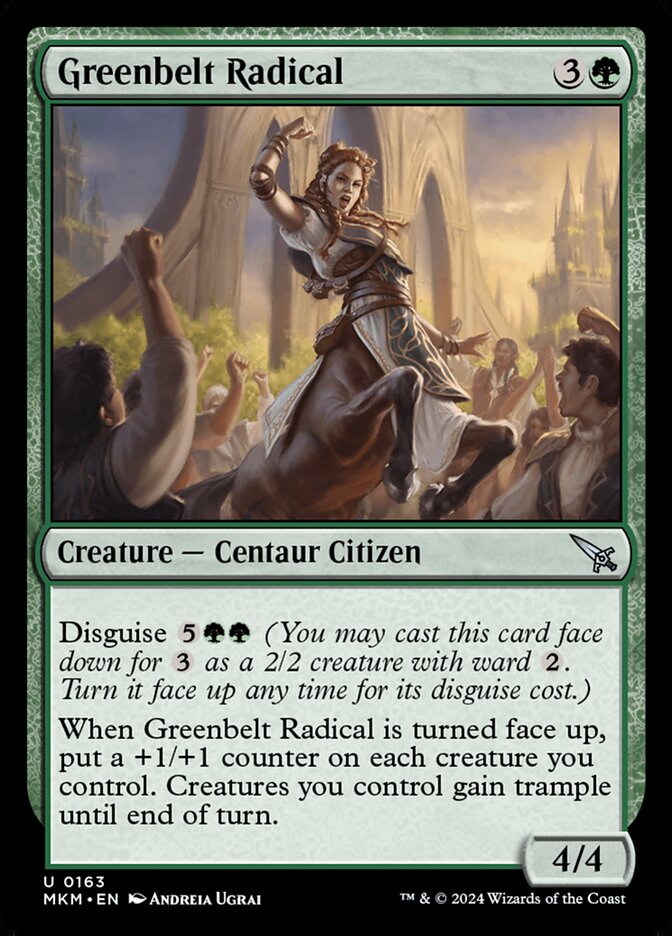
Rating: 5/10
Seven mana is a lot to turn this face up, but the set has a lot of ways to help you mitigate that, and the ability you get is well worth doing so. Even if you’re not set up to do that, putting Greenbelt Radical down as 4-mana 4/4 is honestly a really good backup plan, and I don’t even know which mode I’m more likely to use.
Hard-Hitting Question
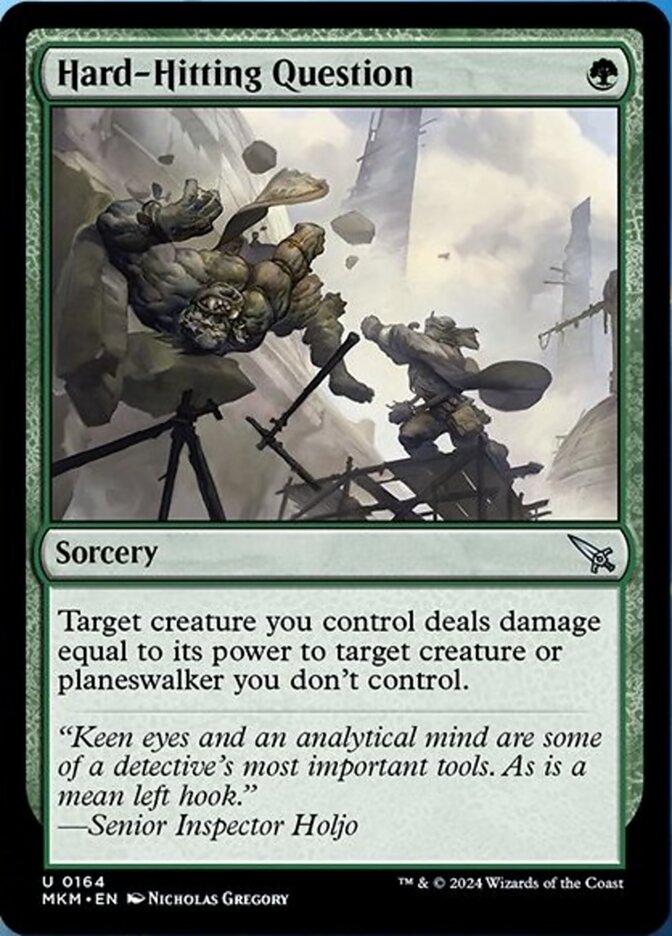
Rating: 5/10
Rabid Bite is always good, so making it cost 1 mana less has got to be even better. Not much else to say; Hard-Hitting Question is just great removal for green.
Hedge Whisperer
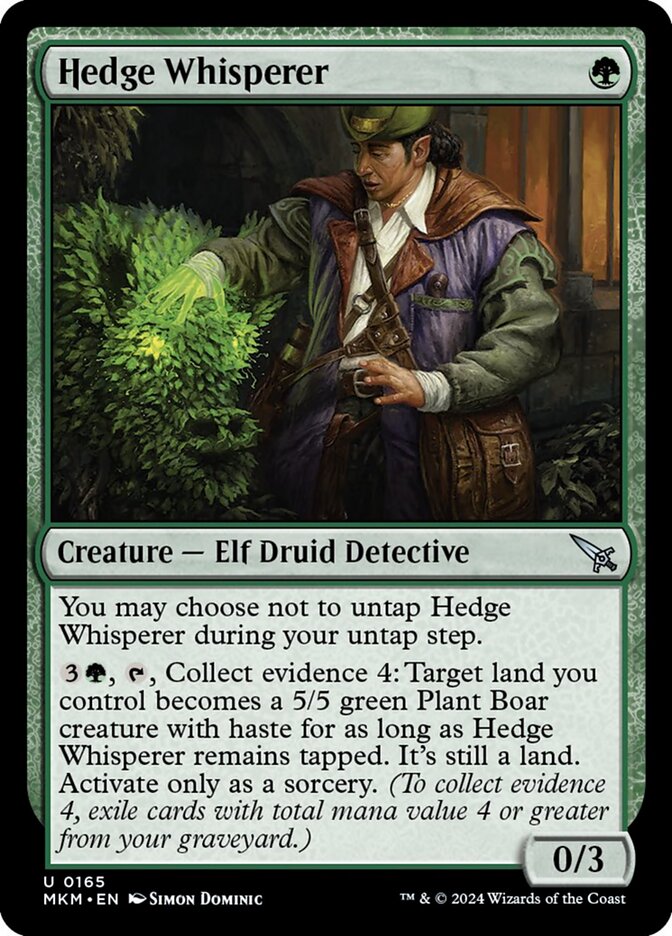
Rating: 2/10
I don’t know how much I like this ability. It costs a lot of mana (5 if you count the land you’re animating, since it won’t tap for mana this turn) as well as needing to collect evidence, and you only have a 0/3 in the meantime. I think you’ll have better ways to spend your time and mana, though making 5/5s is a good enough ability that I could easily be wrong about Hedge Whisperer.
Hide in Plain Sight
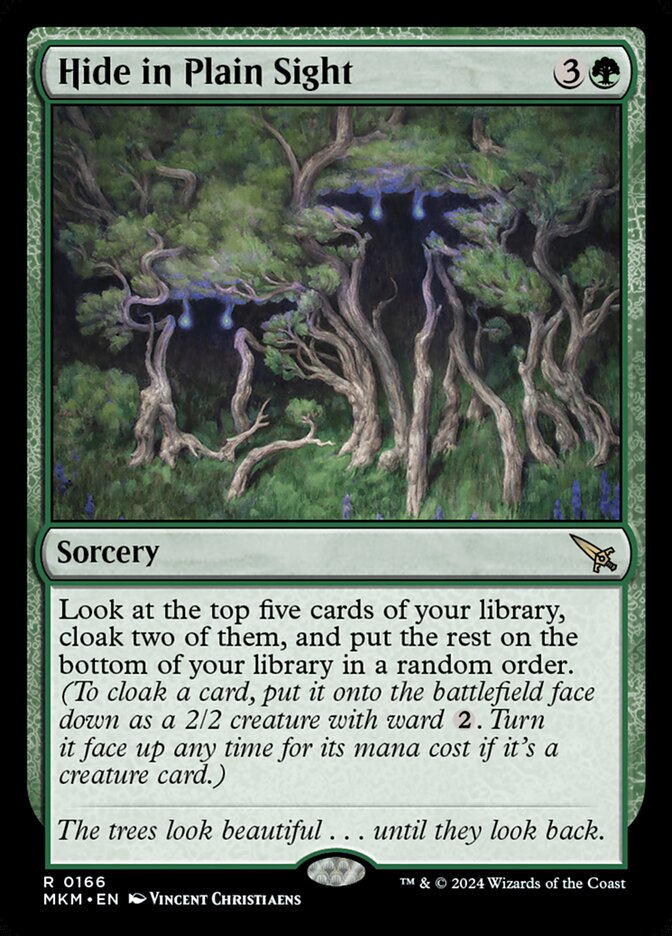
Rating: 5/10
Four mana to make two 2/2s is already really good, but Hide in Plain Sight goes so much harder. Sometimes that’s all it will be, but finding a good creature off of this will feel like you drew a whole extra card for free.
A Killer Among Us
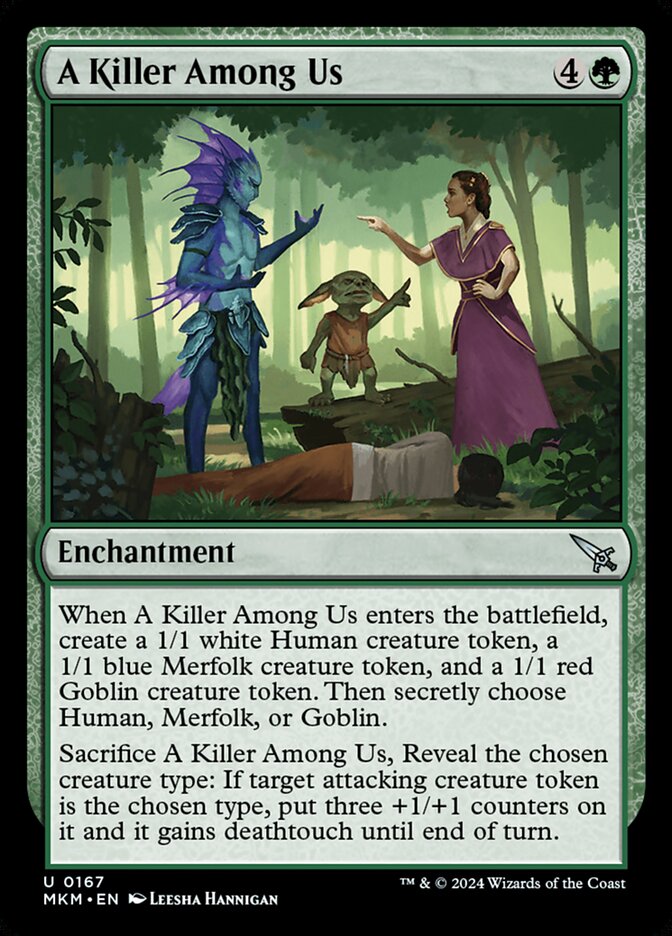
Rating: 6/10
This has a lot of text but ultimately says you get a 4/4 deathtoucher and a pair of 1/1s. That’s a great deal, but you also get to play this guessing game with your opponent as they won’t know which of your three creatures is the 4/4. If you leave them all as 1/1s, your opponent won’t have any profitable blocks, giving you the upper hand. This is a hilarious card, and I’m sure playing it will be a lot of fun, but it’s also just good.
Loxodon Eavesdropper
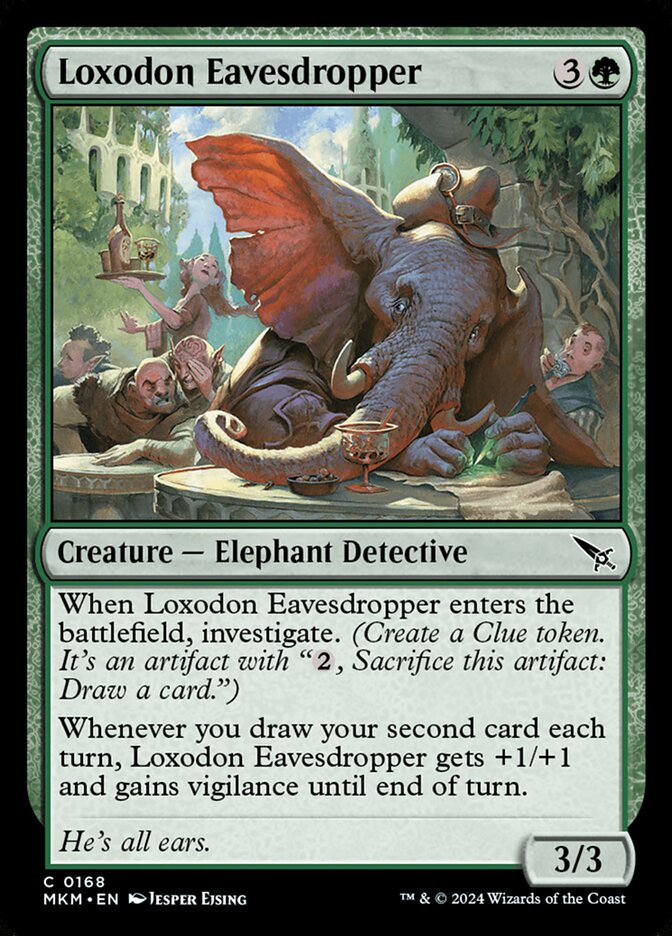
Rating: 4/10
Four mana for a 3/3 plus a Clue sounds perfectly fine to me. It shouldn’t be too difficult to get some extra value out of your Loxodon Eavesdropper attacking as a 4/4 with vigilance, too. It just looks like a very solid common that I’d be happy to play in a lot of decks.
Nervous Gardener
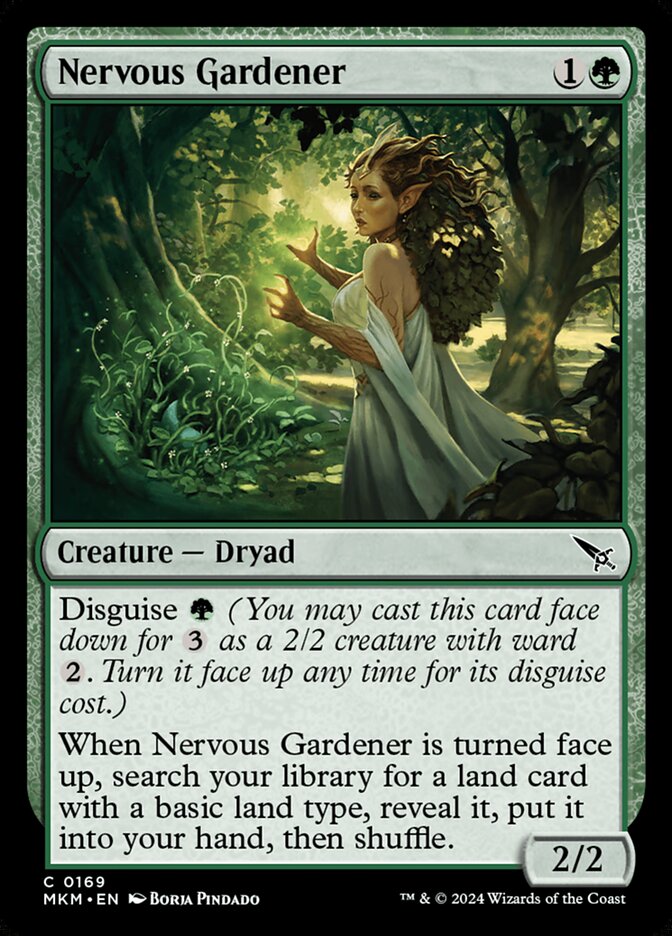
Rating: 4/10
This isn’t quite Borderland Ranger, but it’s not too far off. I’d say Nervous Gardener is a very important common for green decks in this format. Fixing your colors, plus being a disguise creature, plus the ability to just be a Grizzly Bears all adds up to a multi-purpose card that any deck will be happy to play.
Pick Your Poison
Rating: 1/10
Pick Your Poison is the textbook definition of a sideboard card. I could see wanting to play a main deck copy in Sealed to hate on all the big flying rares you’re more likely to see, but other than that it should stay in the sideboard until you need it.
Pompous Gadabout
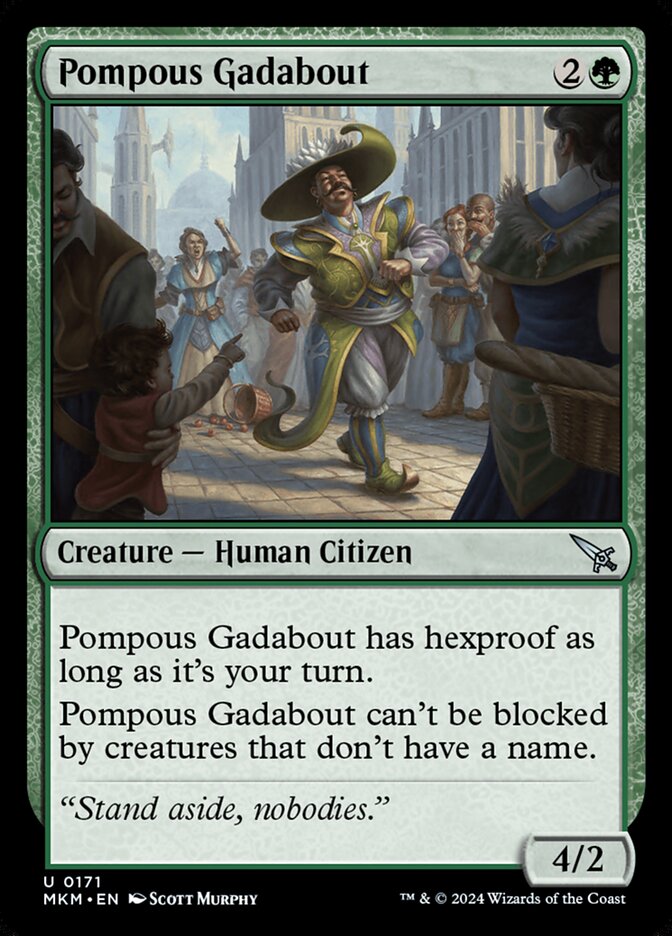
Rating: 1/10
The thing about being pompous is that more often than not, the feeling is completely undeserved. Surprise, surprise, Pompous Gadabout isn’t that good. Sure, there’ll be some situations when it works, but there are too many ways to deal with it, and I don’t think it’ll be worth bothering with.
The Pride of Hull Clade
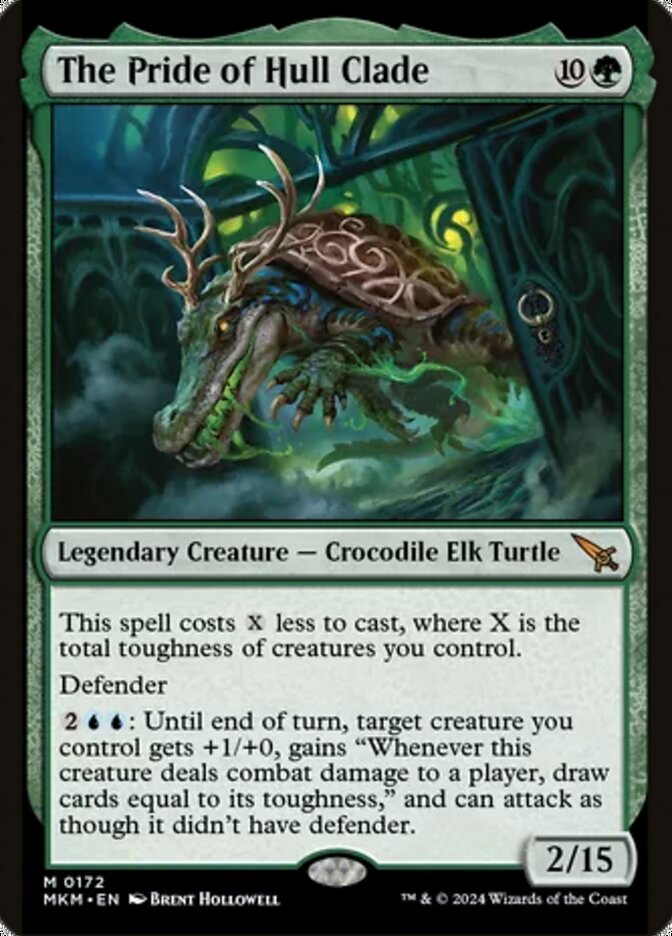
Rating: 7/10
I love it. I’m playing it as soon as I get the chance to, and nothing can stop me. Is it actually good? I think it is. You don’t need much of a board to make The Pride of Hull Clade cost a reasonable amount of mana, and a 2/15 is kind of dumb to play against. What sells it for me is something that you might overlook when you look at this card. Its activated ability can target any creature. You can use it on anything that’s able to get through your opponent’s blockers to guarantee drawing some cards. Attacking with the Pride isn’t guaranteed to do that, but a flier might do the trick. That detail sells it for me, and I can’t wait to try it out for myself.
Rope
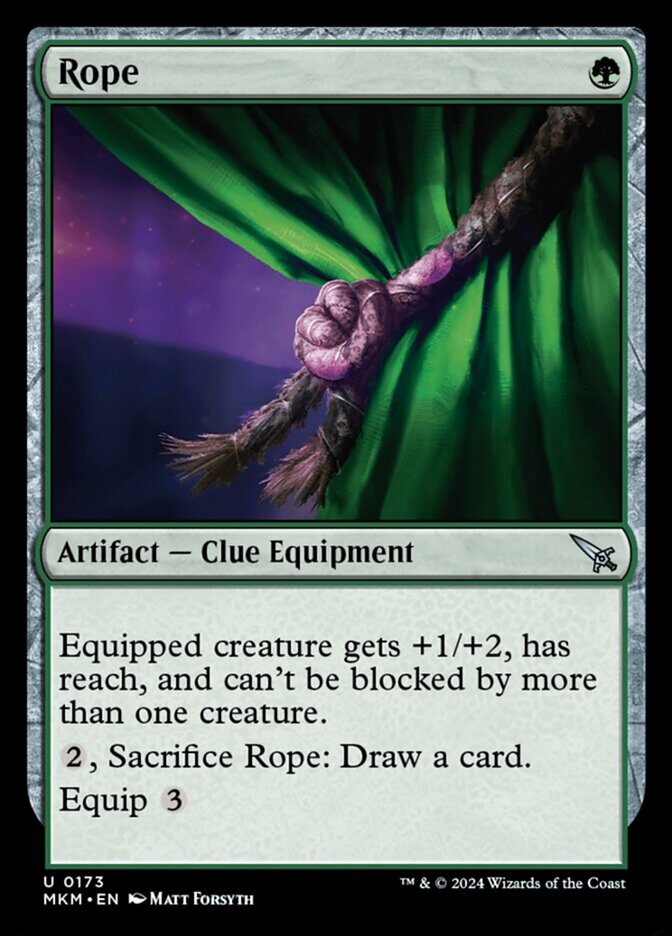
Rating: 2/10
At 3 mana to equip, I think Rope is easily the worst of the Clue(do) weapons. So much so that it’s probably the only one I’m not happy to play. That said, it’s a 1-mana artifact that you can sacrifice to draw a card, and that can probably find a home somewhere.
Rubblebelt Maverick

Rating: 3/10
This doesn’t look particularly special, but we’ve seen a couple of nice payoffs for the green graveyard decks. Rubblebelt Maverick seems like it would be a solid enabler for them, so I think it’ll actually be good in those decks.
Sample Collector
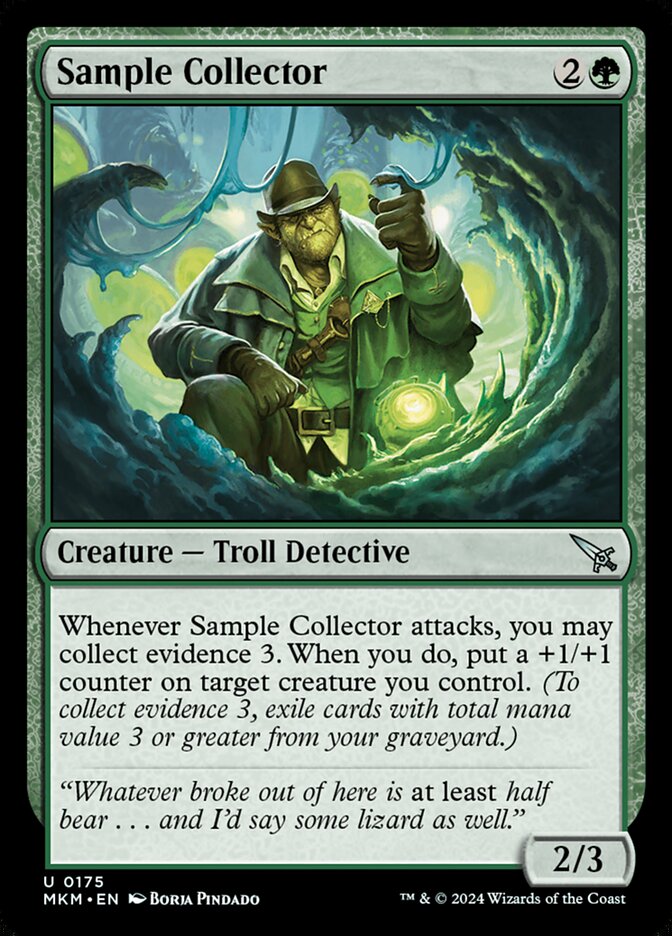
Rating: 1/10
Sample Collector is undersized and needs to attack, which doesn’t lead to a good card. I just don’t think I’d ever want to do this. Being a 2/3 in a format of 2/2s might be interesting, but I don’t see this coming together.
Sharp-Eyed Rookie
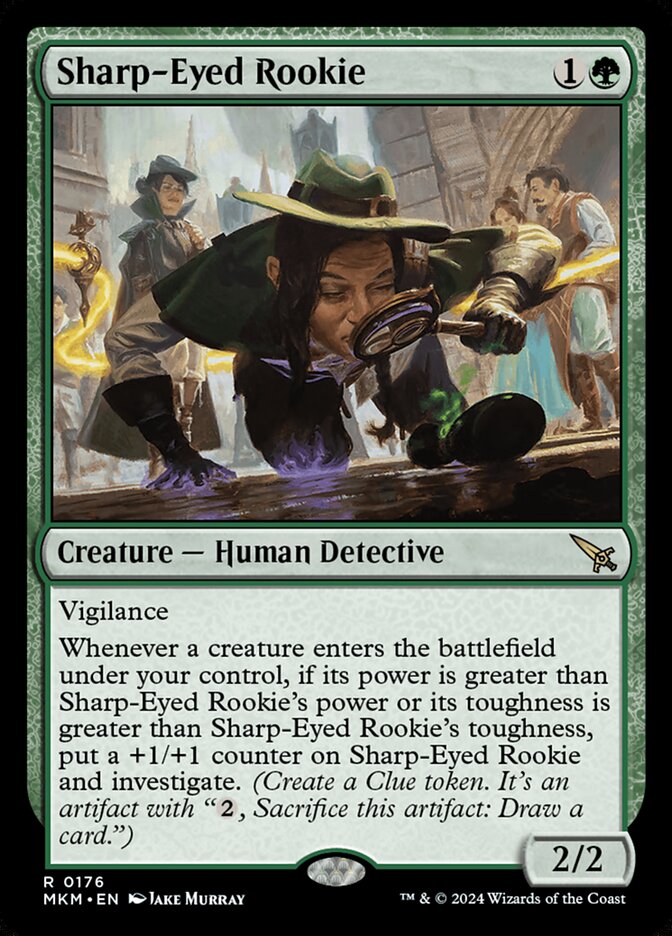
Rating: 9/10
What an exceptional card. Not only does Sharp-Eyed Rookie get bigger whenever you play a bigger creature, but you get a Clue token, too? There’s a cap on how big it can get, but you only need the first couple of triggers for this to have been a great play. This is something that just has to be killed on sight or it’ll get out of hand really fast.
Slime Against Humanity

Rating: 3/10
I love a good challenge. My personal record with Goblin Gathering was seven, and I hope to beat it with Slime Against Humanity. I think it’s worth going for, because only the first token you make is below rate. Once you’re making 4/4s and 5/5s, it starts to look really good. Plus, you can discard or mill the first couple, and they’re great to exile to collect evidence. I think there’s a lot to like here, and it’s great fun to try to make it happen.
They Went This Way

Rating: 3/10
Just like with Weirding Wood back in the day, 3 mana to ramp plus “draw a card” is good. It’s hard to know if you’ll be afforded the time to do this, but assuming you can, They Went This Way should be worth playing.
Topiary Panther
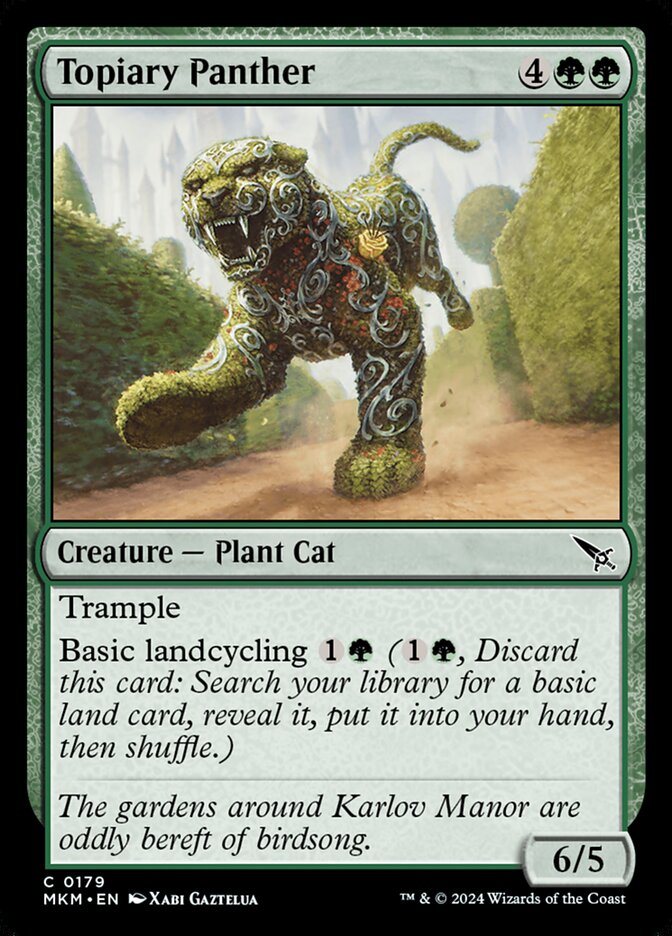
Rating: 4/10
Funny that Topiary Panther is the only landcycler in the set, but that’s likely because green is the color that cares about collecting evidence. It should be great to fix your colors with and set up your graveyard, but it can also be a Colossal Dreadmaw when you draw it late. It hits enough of the notes that green wants to be doing that I really like it.
Tunnel Tipster
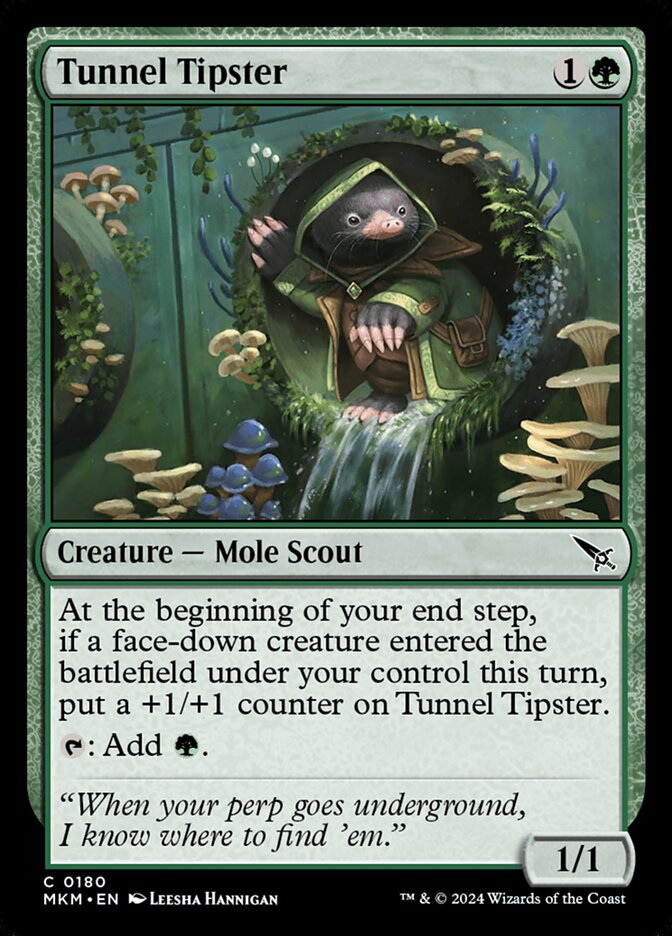
Rating: 4/10
It might not be able to fix your colors, but Tunnel Tipster is a solid mana dork that turns into a legitimate threat the longer it stays in play. Few mana dorks have the ability to ramp you early but then attack as a 4/4 later on, which is something I honestly wished more of them could do.
Undergrowth Recon
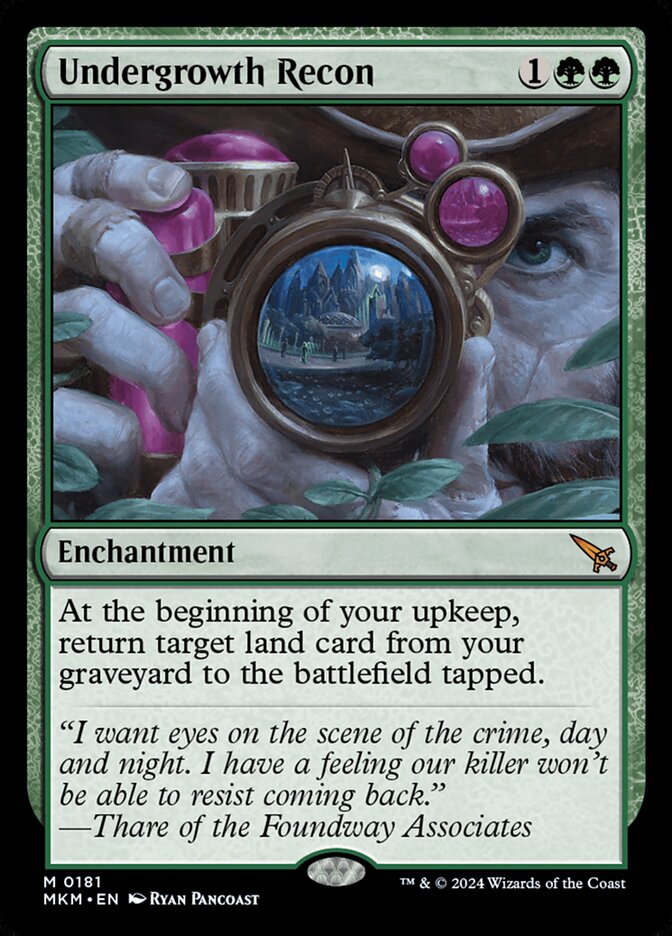
Rating: 0/10
I can’t stress enough how bad Undergrowth Recon is. This is so far away from playable it’s actually funny. Just avoid at all costs.
Vengeful Creeper
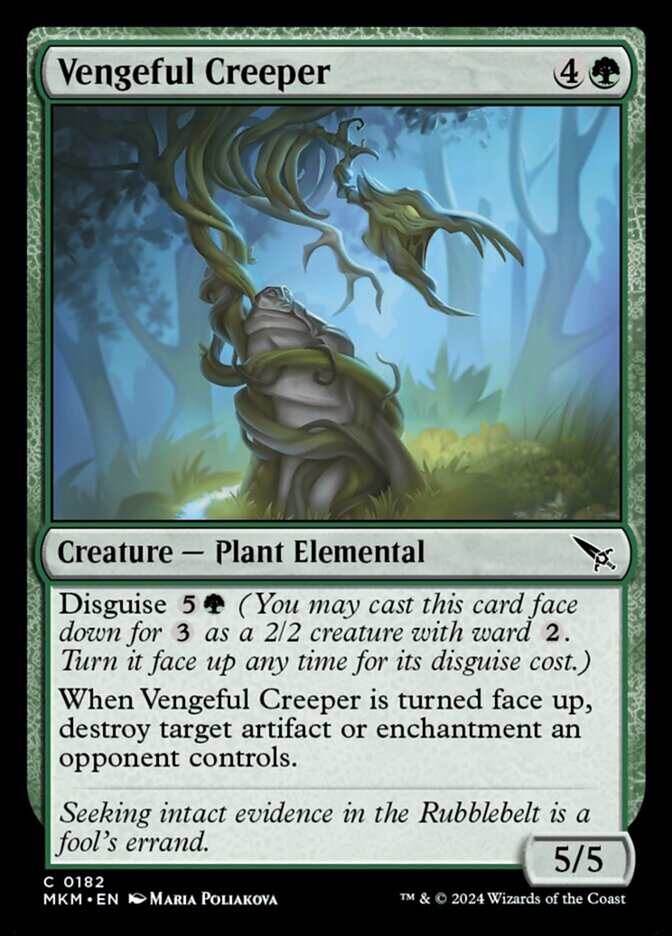
Rating: 4/10
Between Clue tokens and cases, there should be plenty of free targets lying around that make it worth disguising this and flipping it over. It’s also just a 5/5 for5, which is a decent enough stat line if you draw it late and need a relevant play.
Vitu-Ghazi Inspector
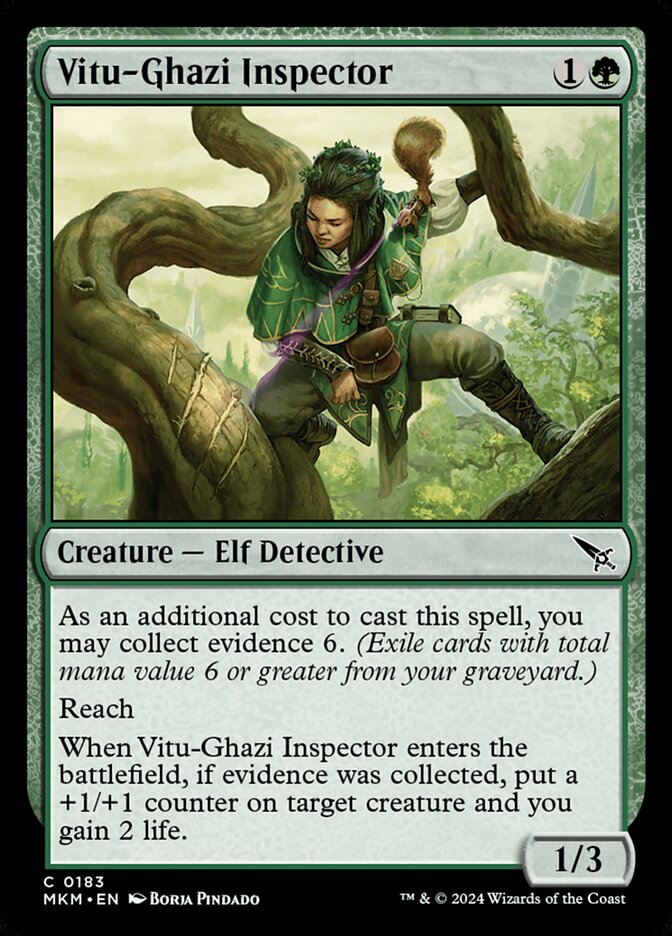
Rating: 1/10
Here’s a perfect example of why I don’t like collecting evidence. Vitu-Ghazi Inspector isn’t good enough without it, and collect evidence 6 is a huge cost for really not that much gain. I don’t think this is ever going to be worth it, and you should be able to do a lot better.
Multicolor

Agrus Kos, Spirit of Justice
Rating: 10/10
We expecting to get some spice out of multicolor cards, and Agrus Kos, Spirit of Justice doesn’t disappoint. If you have anything that lets you suspect other creatures, this spirit is a really broken Nekrataal that hits something else by attacking. Even without that, you can suspect something when it enters and kill it next turn. Did I mention it has double strike and vigilance? I can’t imagine losing a game if this card goes unchecked for multiple turns. I’d also try prioritizing Convenient Target once I have this for a ridiculous way of exiling an opposing creature every turn.
Alquist Proft, Master Sleuth
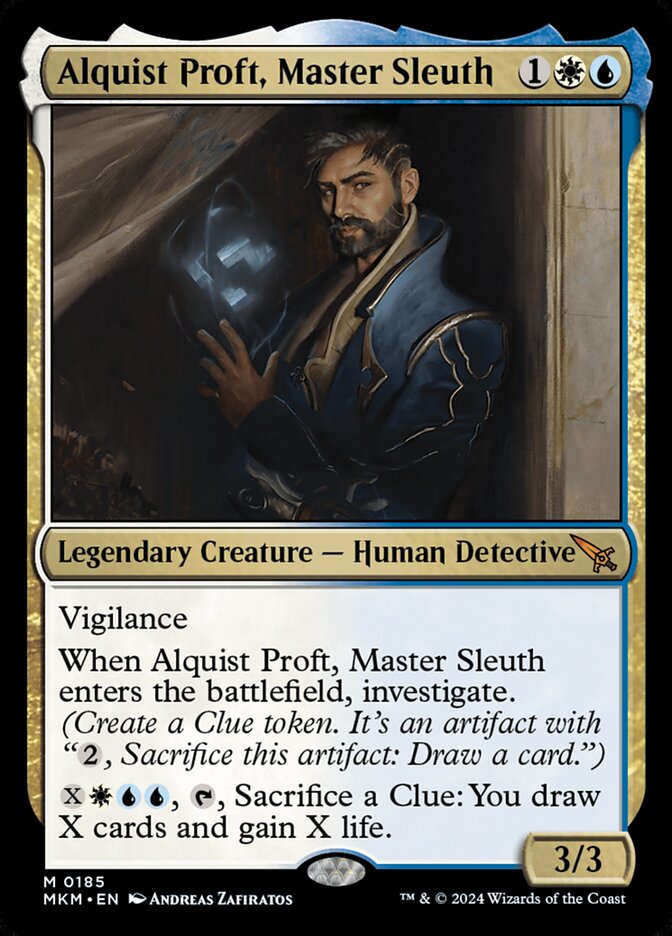
Rating: 8/10
Say hi to our set’s Poirot, our Columbo, our Sherlock. Turns out that it’s not just sphinxes that can have revelations. Alquist Proft, Master Sleuth looks like a very strong card to be headlining the set. It’s got good stats, comes with a Clue, and is near enough unbeatable in the late game, turning your clues into piles of new cards plus a chunk of life. It just has no downsides, which I guess is what you’d expect from the main character of the storyline.
Anzrag, the Quake-Mole
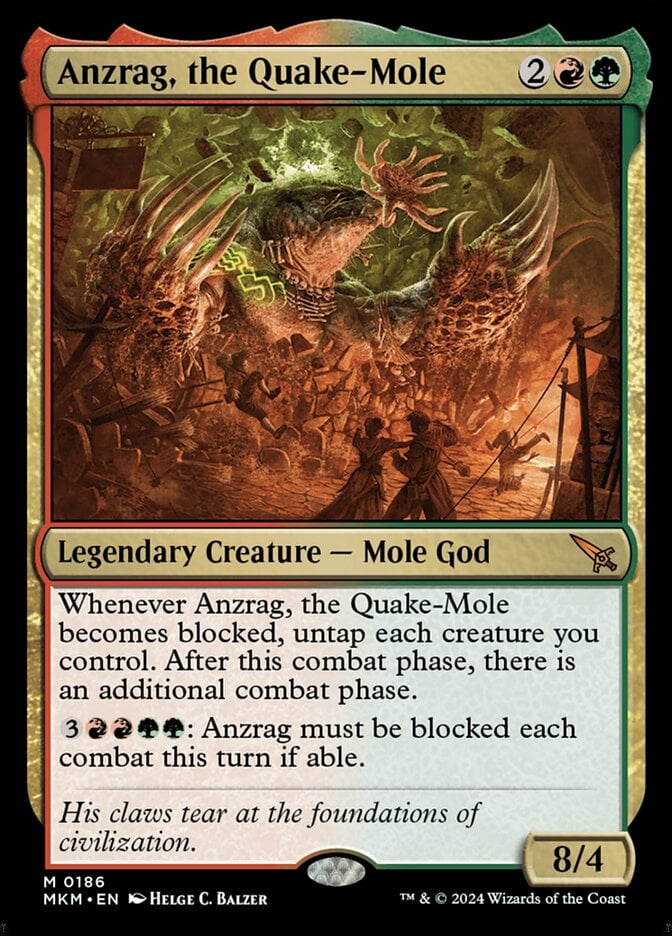
Rating: 7/10
I’ve gone back and forth on this card, but I think it looks legitimately strong. An 8/4 hits really hard and really demands an answer, but blocking Anzrag, the Quake-Mole triggers its ability and gives you an extra combat phase. The big downside here is that it just dies to removal without giving you anything in return, which is why it’s not deserving of a higher grade. But if it survives a turn or two, it should give your aggressive curve a way to close out the game.
Assassin’s Trophy
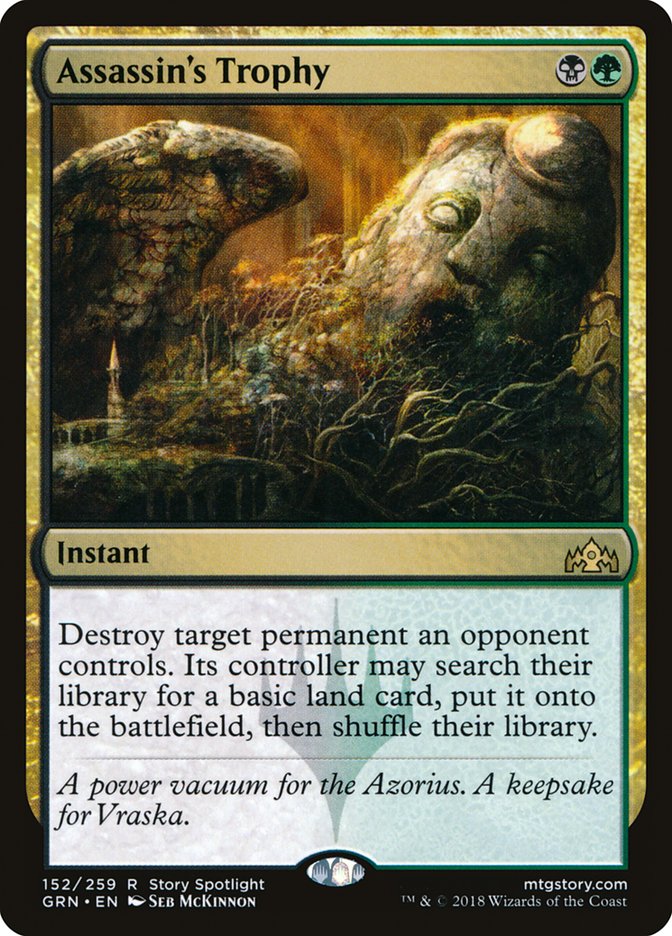
Rating: 7/10
The downside of giving your opponent a land isn’t enough to dampen what’s otherwise a very cheap and versatile removal spell. Assassin's Trophy was great last time, and nothing has really changed since the last time we saw it.
Aurelia, the Law Above
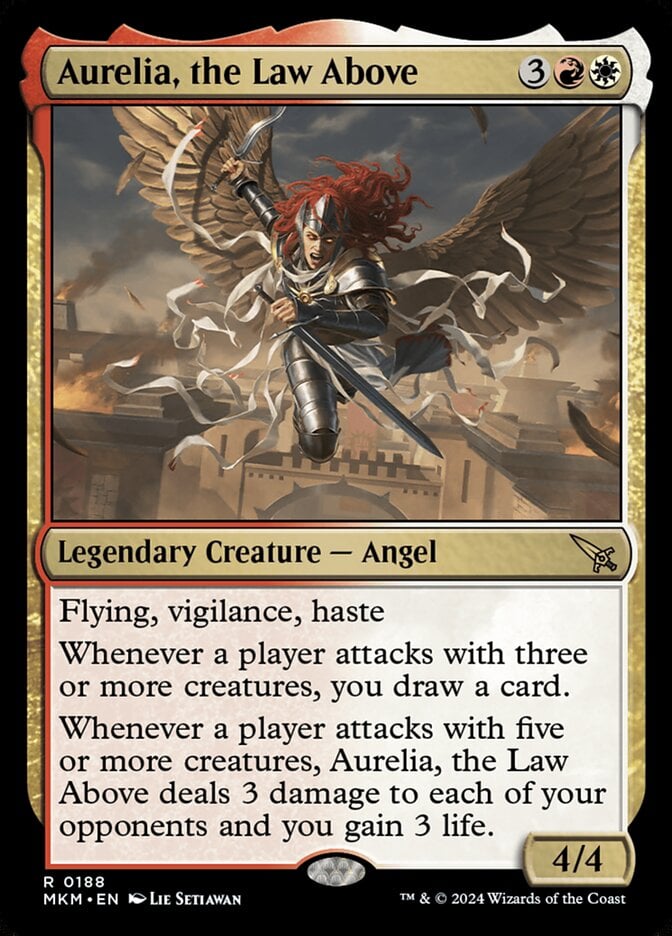
Rating: 10/10
Lightning Angel has never looked so good. Aurelia, the Law Above is likely going to be the most valuable threat from the moment you play it, especially since it gets to stay back on defense at the same time as attacking. Its second trigger doesn’t seem too likely to go off, but the first one definitely will. All you need is to play Aurelia and attack with two other creatures. That’s not all that hard to do, and you get a huge reward for it. Plus, your opponent can’t attack you back with their team, or they’ll probably trigger Aurelia for you, too.
Blood Spatter Analysis

Rating: 7/10
I love removal spells with generous upsides. Two mana for 3 damage is the rate we expect from a burn spell anyway, but on top of that it eventually gets you a creature back from the graveyard? Love it. It likely won’t do that if you draw it really late, but it still does 3 damage, so it’s hardly a bad draw.
Break Out

Rating: 3/10
These kinds of cards don’t typically make the cut because they might miss. They also don't commit anything to the board. Break Out addresses both of those issues, which makes me think it could be useful, but I doubt you’ll ever want to prioritize this over good creatures or removal.
Buried in the Garden
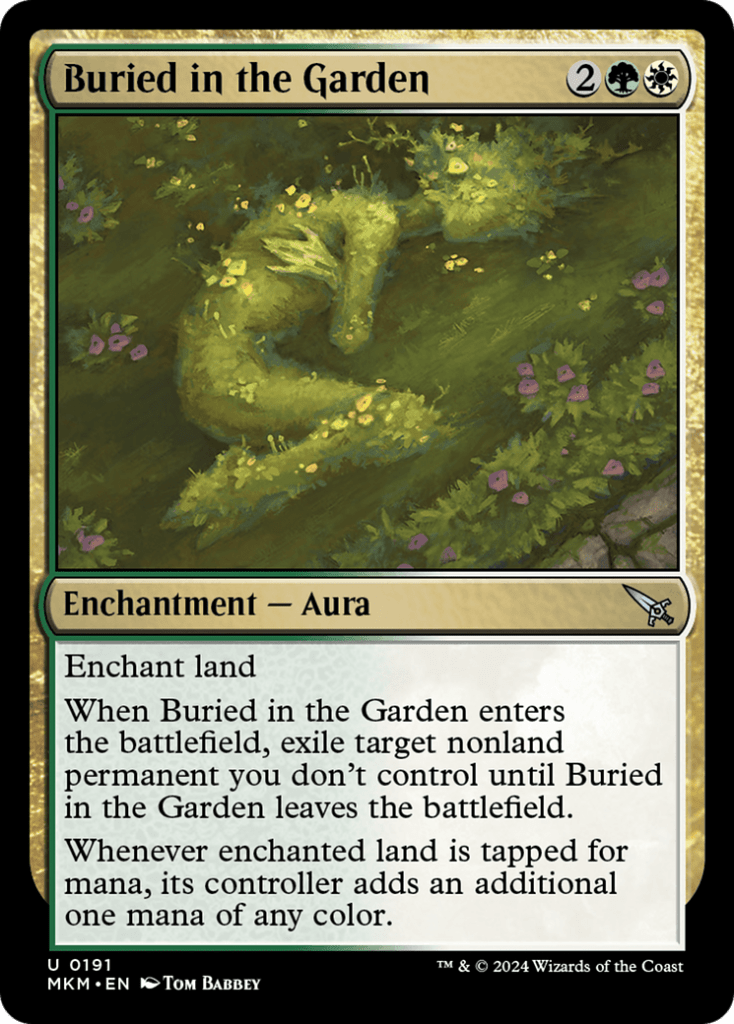
Rating: 6/10
This is a really sweet new take on the classic Oblivion Ring design. You deal with any problem and then get accelerated a little bit, so what’s not to like? Play Buried in the Garden on curve and you’ll get to play a 6-drop on turn 5, though play it late and you’ll barely notice the extra ramp. Still, it’s a great upside to have on a removal spell that we’d always play.
Cease // Desist
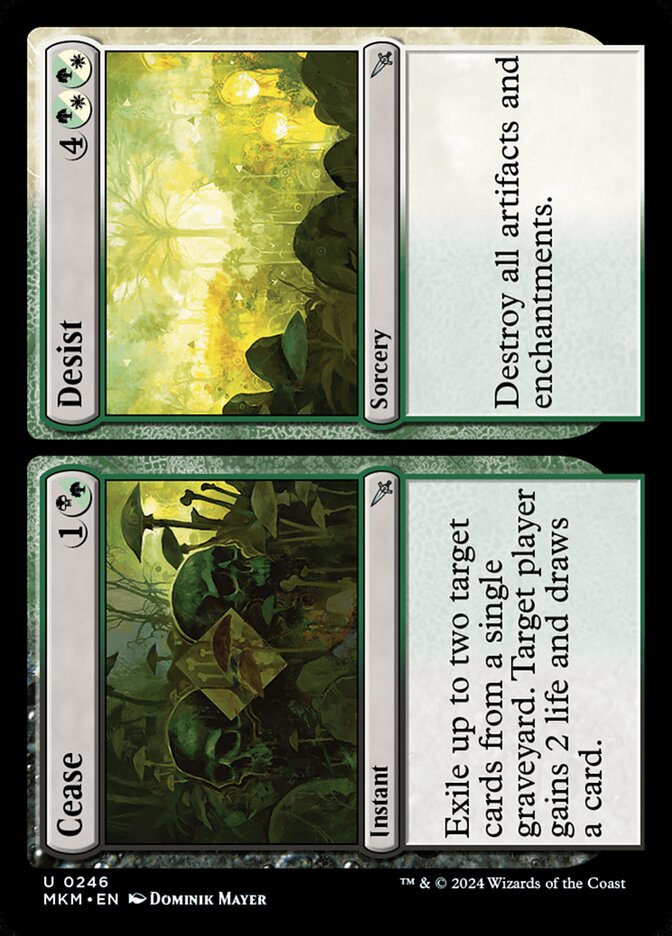
Rating: 3/10
This set features a cycle of split cards where both sides use hybrid mana from different guilds. Cease // Desist is an Abzan card, but you can play both halves if you are green, Cease if you’re black, and Desist if you’re white. You only can’t use the card at all if you happen to be in blue/red. Another thing to note is that they’re all 6+ mana spells that fuel collect evidence, even if you only play their cheaper sides. How good is this one? Meh, not that good. Cease is a solid cantrip that can trigger the black/green theme or hate on a self-milling opponent, but other than that, the card is too niche. Desist might make for a good sideboard card though.
Coerced to Kill
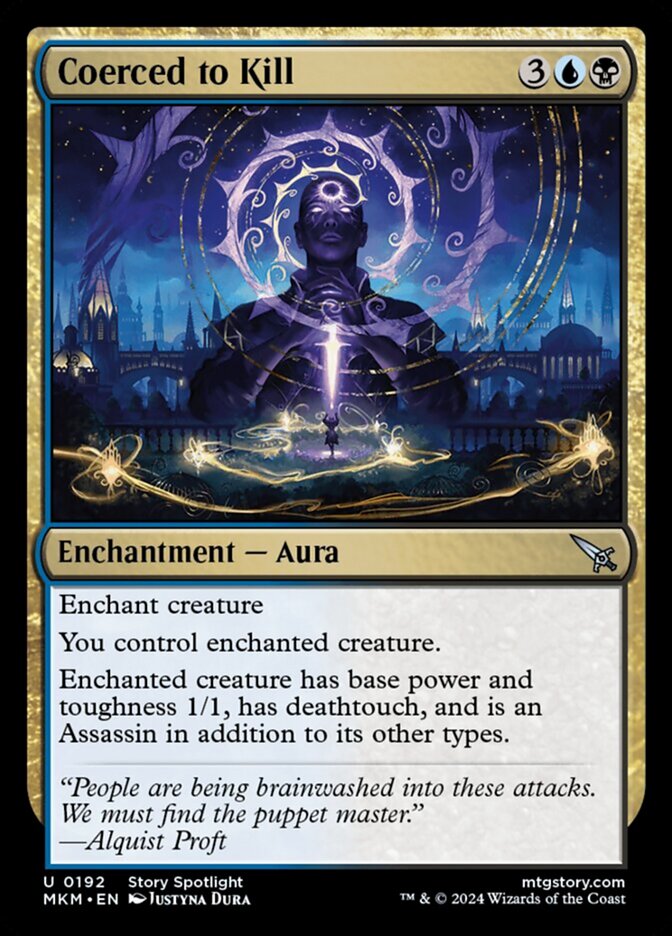
Rating: 8/10
Mind Control is among the most powerful effects that uncommons in Limited are allowed to be. The ability to deal with the best creature on your opponent’s board by stealing it for yourself is sometimes enough to win the game on its own. I like that Coerced to Kill is a much more balanced version of that. You aren’t just going to have the best creature on the board, yet dealing with any big creature and giving yourself a 1/1 deathtouch with that creature’s abilities is still incredible. I’d guess this is the mythic uncommon of the set, or at least it’s the clear frontrunner at this early stage.
Crowd-Control Warden
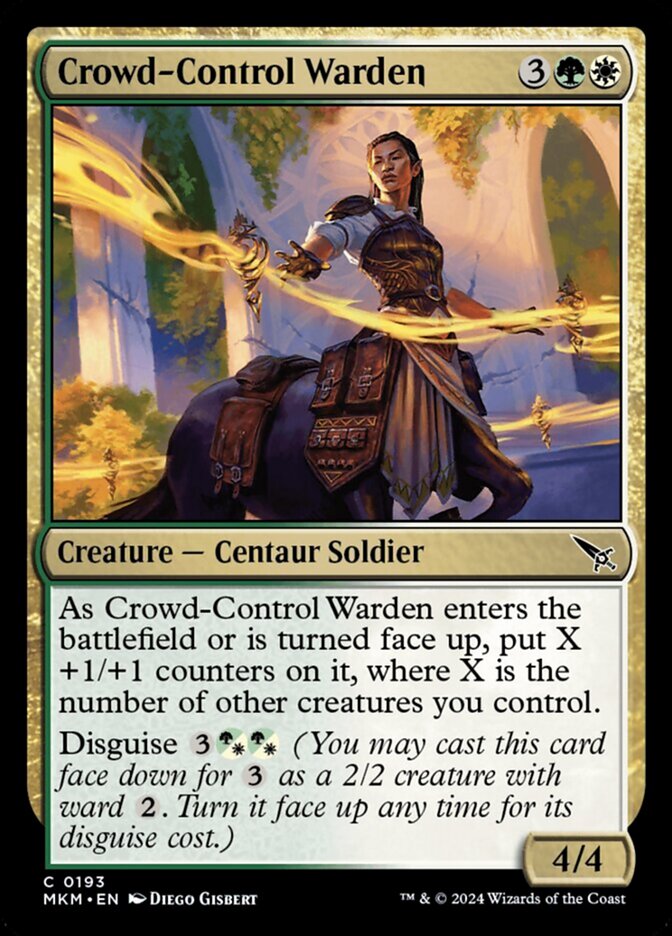
Rating: 3/10
Just a note about this whole cycle. All of these hybrid cost disguise creatures are awesome. The hybrid mana cost to flip them over means they can be played in one color or the other, making them extremely flexible. It helps that most of them are very good cards in their own right, too. Anyway, Crowd-Control Warden is just a vanilla creature, so it's less exciting, but it could be a 7/7 or something, which is kinda nice. But still, it’s only a big vanilla creature.
Curious Cadaver
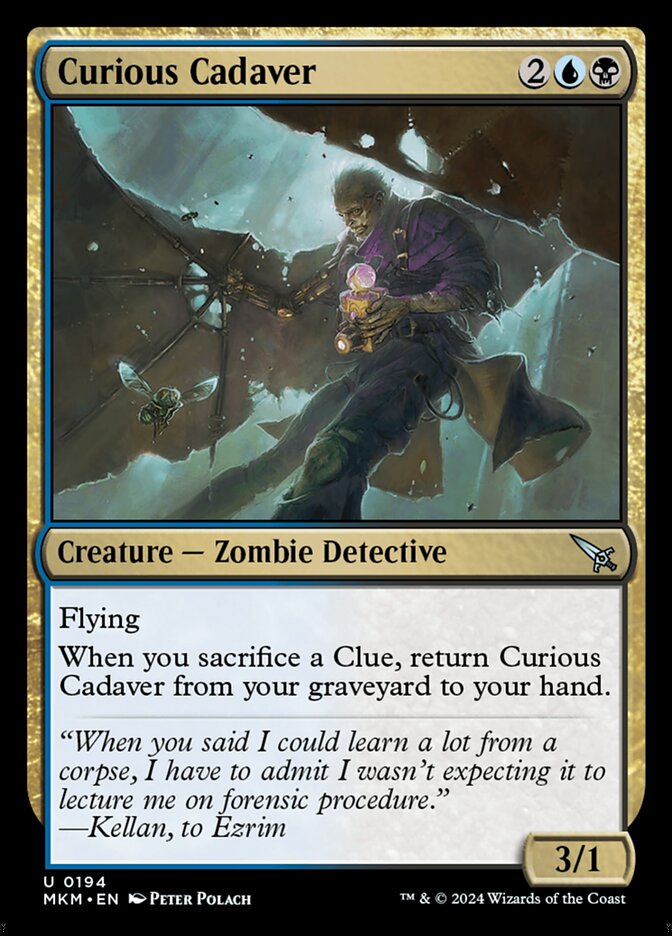
Rating: 6/10
I love the design of the solid creature that you can return to your hand whenever you do the thing you were going to do anyway. Why yes, I’d like something for free whenever I crack a clue! Curious Cadaver is a good creature to cast, but I’d especially love to see this in a deck where I can discard it for value and get it back later.
Deadly Complication
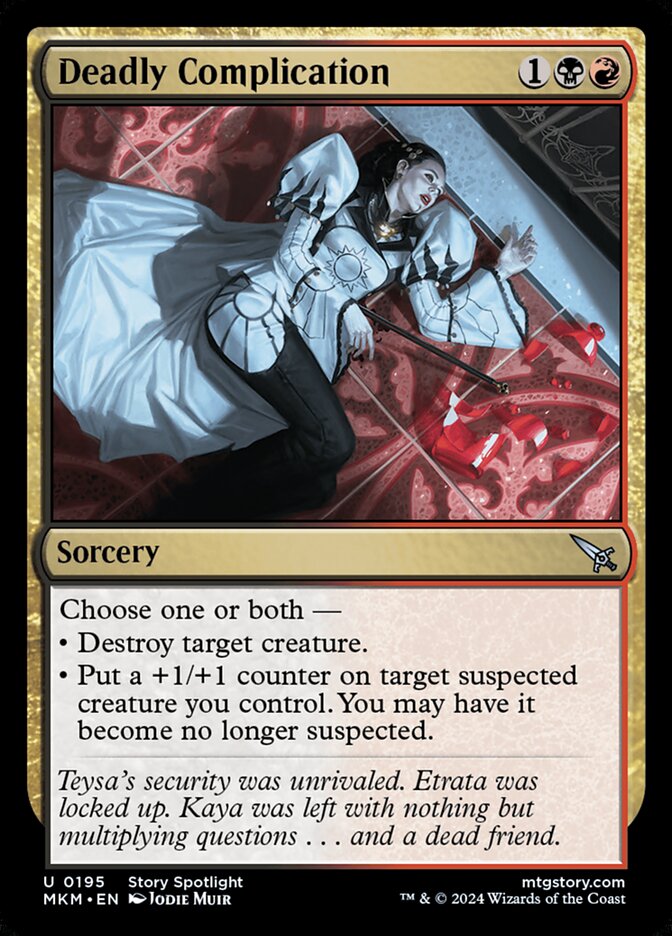
Rating: 7/10
Love getting more unconditional removal. I’m giving Deadly Complication a slightly higher grade than Murder entirely because it may end up being easier to cast, and the extra +1/+1 counter could end up making a big difference. No matter what, this kills any creature, so I’ll be prioritizing it over most other cards.
Detective’s Satchel
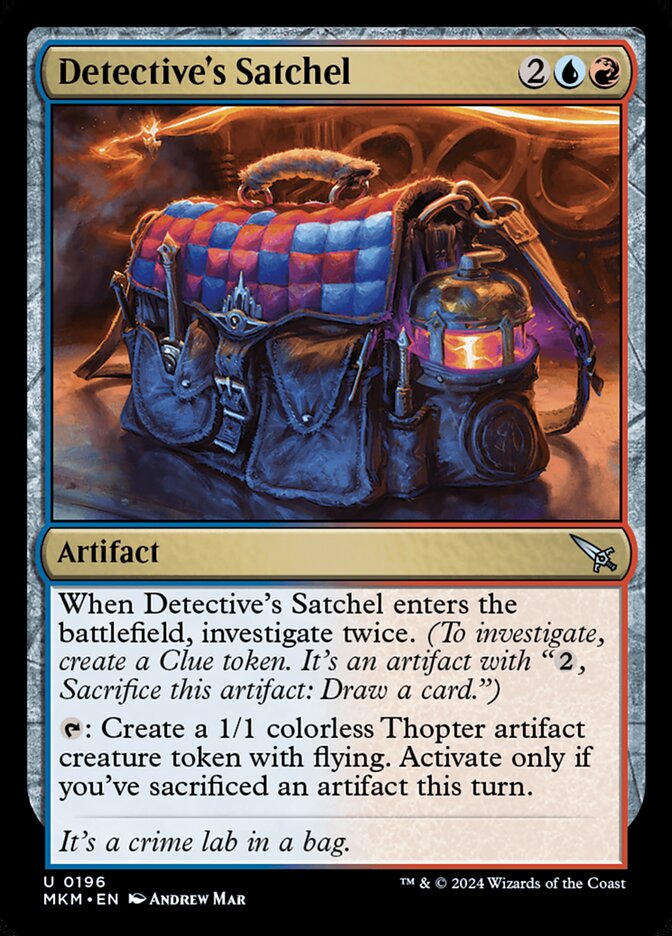
Rating: 7/10
When I read this card, I was absolutely stunned. Detective's Satchel isn’t only a fantastic build-around card for this sacrifice artifacts theme, but it’s also an enabler? And it effectively draws you two cards and makes two Thopter tokens even before factoring in other cards? Absolutely incredible.
Dog Walker
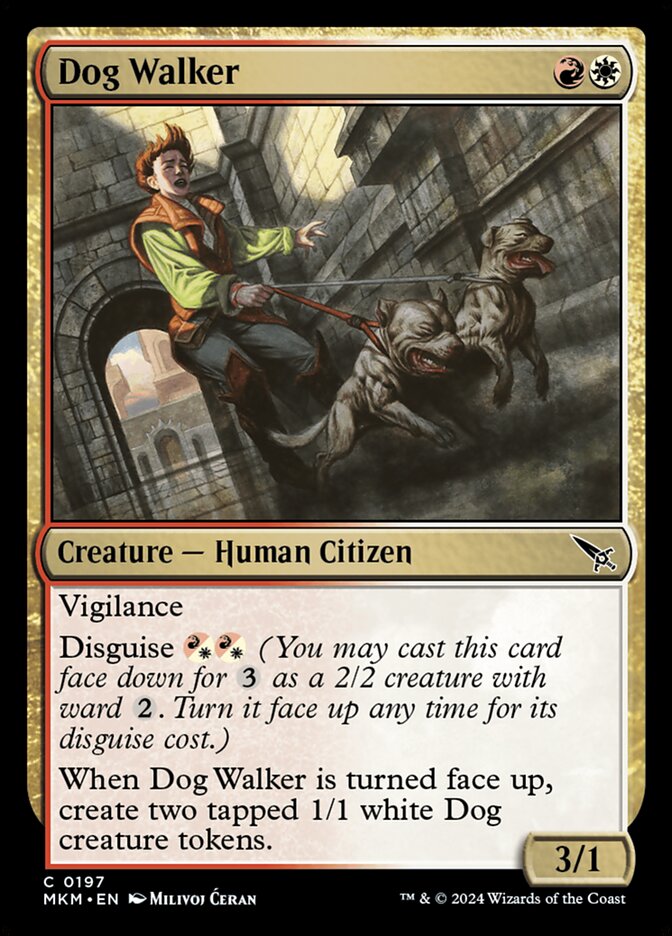
Rating: 4/10
Two mana for a 3/1 vigilance like Dog Walker is perfectly fine. Throw in 3 extra total mana and you get two extra 1/1 tokens? I’m in.
Doppelgang

Rating: 5/10
Five mana to clone any target permanent is a very reasonable card. Getting to 8 mana isn’t trivial by any means, but if it does happen, Doppelgang becomes really dumb. Still, I’m only really looking at it for if X=1, and yeah, it seems really solid to me.
Drag the Canal

Rating: 6/10
A 2/2 with flash for 2 mana isn’t that impressive. But tack on 2 life, surveil 2, and a Clue token and you have got yourself a deal! The downside is needing to keep this open in case a creature dies, then being out of luck if one doesn’t. However, Drag the Canal only cares that any creature died, so it should be reasonably easy to get going.
Etrata, Deadly Fugitive
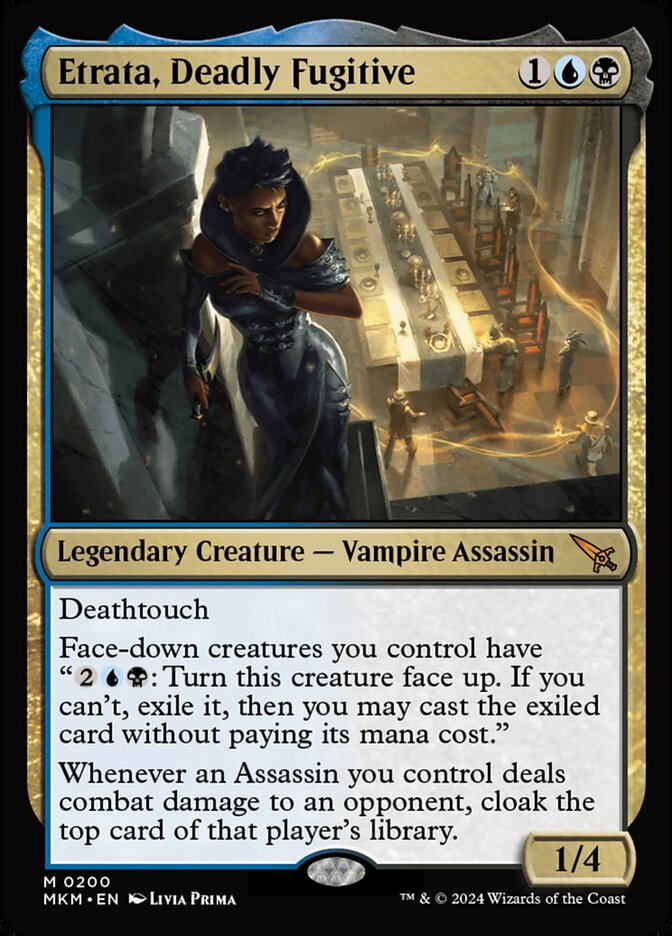
Rating: 8/10
Getting in the way of a 1/4 deathtouch isn’t usually a good idea, though if you don’t, Etrata, Deadly Fugitive overwhelms you with card advantage soon enough. Getting a free 2/2 every time it hits is pretty obscene, plus you can turn those cloaked creatures into even more advantage using its activated ability. There aren’t many assassins in this set, so you’re only looking at Etrata triggering by itself, but that’s more than enough to make it an awesome bomb mythic.
Evidence Examiner
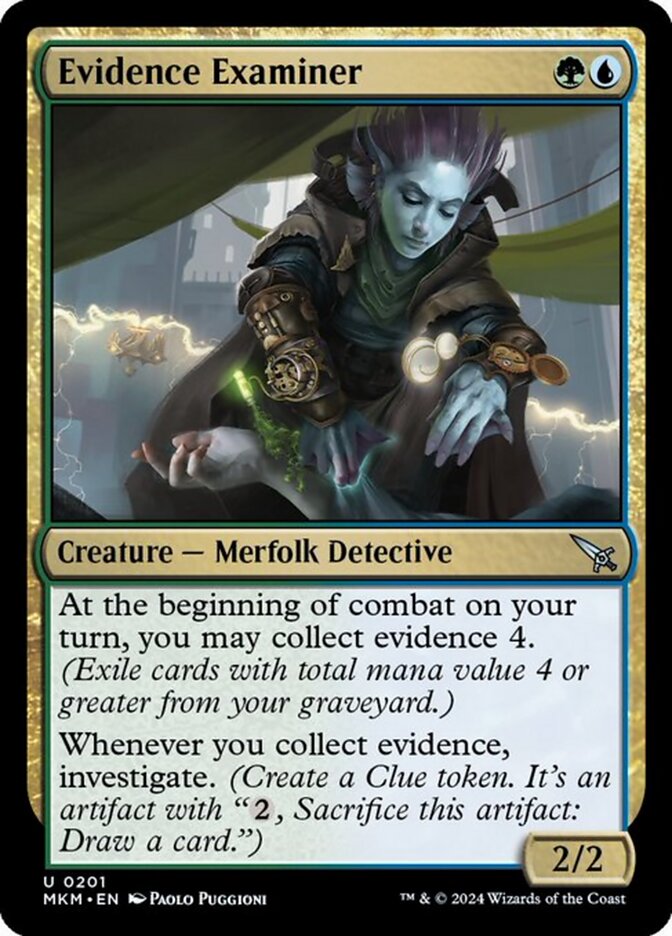
Rating: 4/10
See, I really don’t like Evidence Examiner. Collect evidence 4 is a very real cost to pay, and you only get an investigate for doing so? Nah, I think you can do better. I like that it investigates whenever you collect evidence with anything, but I have very little faith in this mechanic being any good, so this feels like the weakest signpost uncommon in the set.
Ezrim, Agency Chief

Rating: 9/10
Even with a difficult casting cost to meet, a 5/5 flier for 5 that can protect itself from removal sounds pretty busted to me. Or you can look at it as a 5/5 pseudo-Mulldrifter. However you use Ezrim, Agency Chief, it’s going to feel pretty good and will more often than not just dominate the game as soon as it’s played.
Faerie Snoop
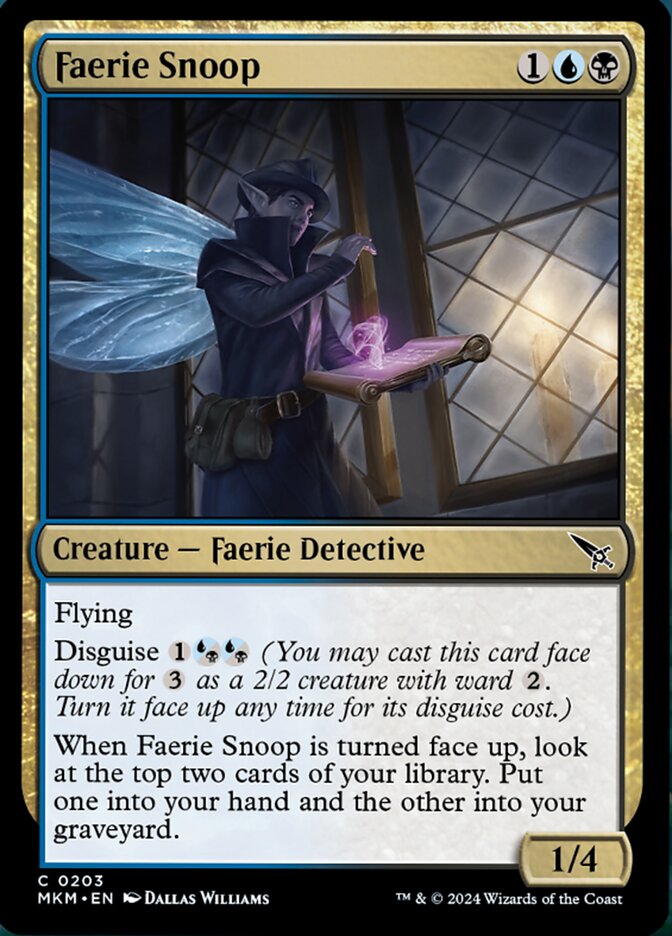
Rating: 4/10
Even if Faerie Snoop costs a total of 6 mana, I do love a nice, cantripping creature. A creature that replaces itself without costing too much should always be good, and this has good enough stats while also being useful as a disguise that I’m definitely on board with it.
Flotsam // Jetsam

Rating: 5/10
Flotsam looks like a nice self-mill enabler, which thanks to the hybrid cost, you can play in black/green as well as blue/green. Jetsam isn’t a card I’d typically run, but it’s a really nice option to have if you draw Flotsam // Jetsam late. Besides, big situational spells that have a good 2 mana buyout option tend to overperform.
Fuss // Bother

Rating: 5/10
White looks like the most aggressive color in this set, which makes me think Fuss // Bother will be really good. Fuss is a powerful combat trick that can swing a lot of combats in your favor or just randomly win the game out of nowhere. But few cards like it double up as 6-drop threats when you’re falling behind, which gives this a lot more flexibility.
Gadget Technician

Rating: 5/10
Oltec Cloud Guard ended up being the best common in The Lost Caverns of Ixalan, and it’s pretty easy to see why. A 3/2 flier that comes with a 1/1 is just a great deal. If we swap the flying onto the 1/1, it gets a bit worse, but Gadget Technician is still a sweet card. A 3/2 and a 1/1 is great for 4 mana, and you even have the disguise flexibility to make it playable in a wider variety of decks. Love it.
Gleaming Geardrake
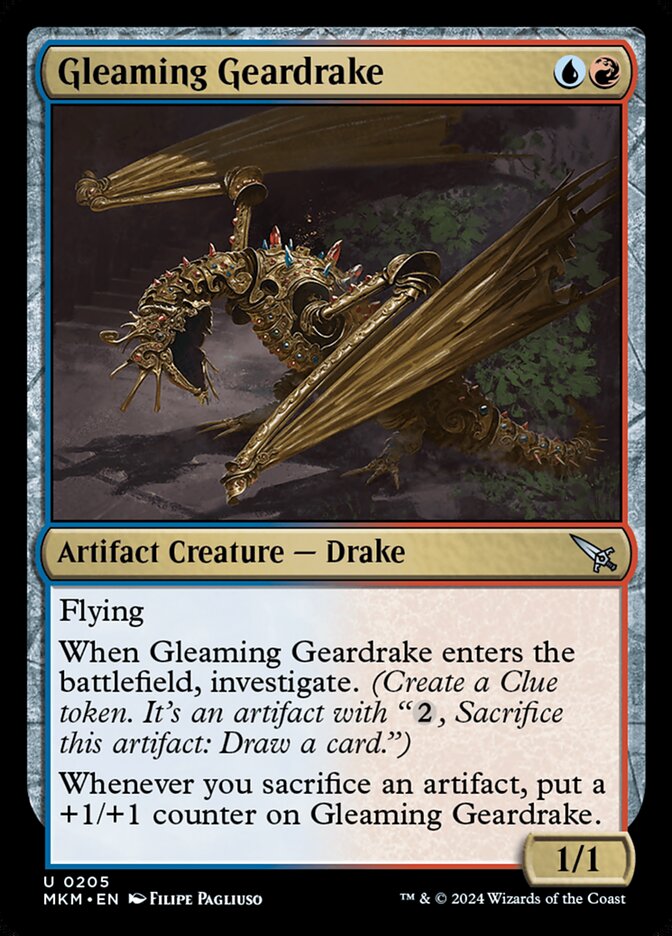
Rating: 7/10
Blue/red artifact sacrifice is my early pick for best deck of the format right now, partly because it has yet another ridiculous signpost uncommon. I mean, just look at this thing! A 1/1 flier that comes with a Clue and only costs 2 mana, but then Gleaming Geardrake keeps growing until it becomes probably the biggest threat on the board. It’s good any time you draw it, especially if you can get it down on turn 2. It’s just yet another great card with no downsides.
Granite Witness
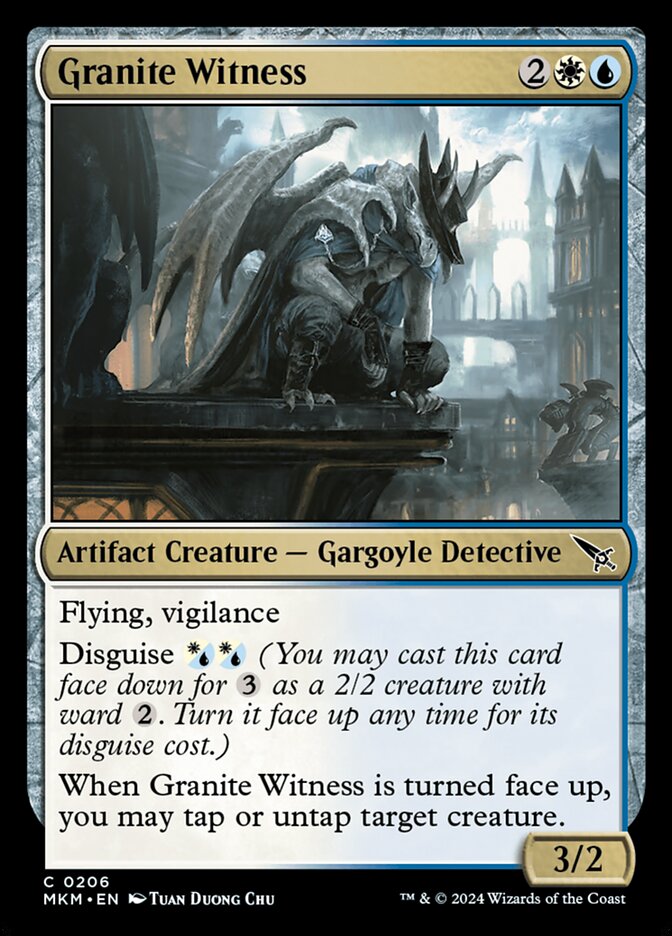
Rating: 4/10
I’m already pretty satisfied with Granite Witness, a 3/2 flying vigilance for 4. I don’t think the ability to tap or untap a thing is particularly relevant, but I bet it will feel good to untap something to surprise block with.
Hustle // Bustle
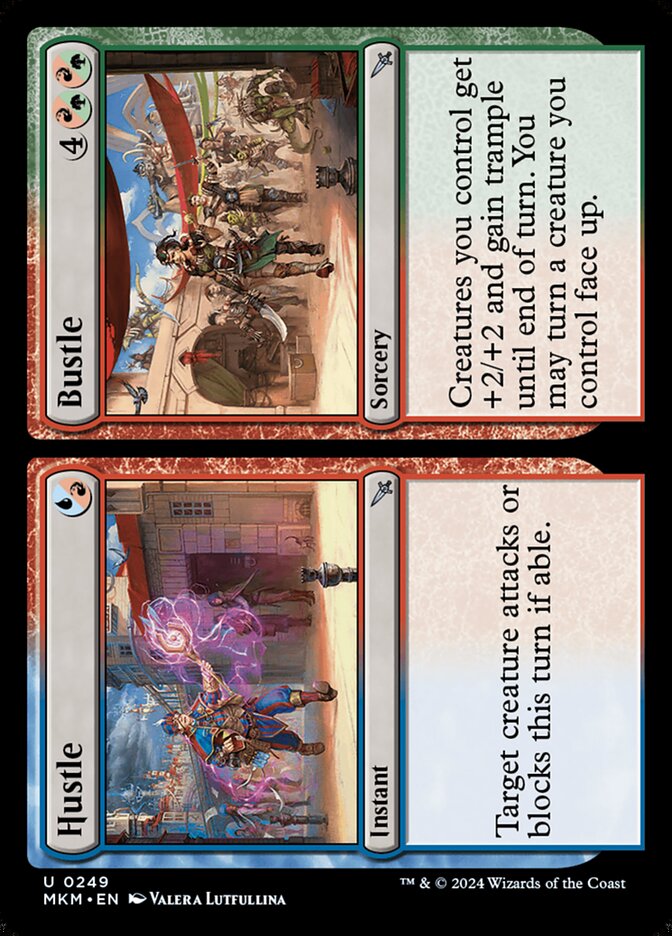
Rating: 4/10
I think the main reason to want Hustle // Bustle is for the Bustle half. A mini Overrun that also gives you a rebate on mana by turning something face up sounds pretty good to me. Hustle looks far too weak and situational, though it’s a nice option if you do find a situation where it lines up perfectly.
Ill-Timed Explosion
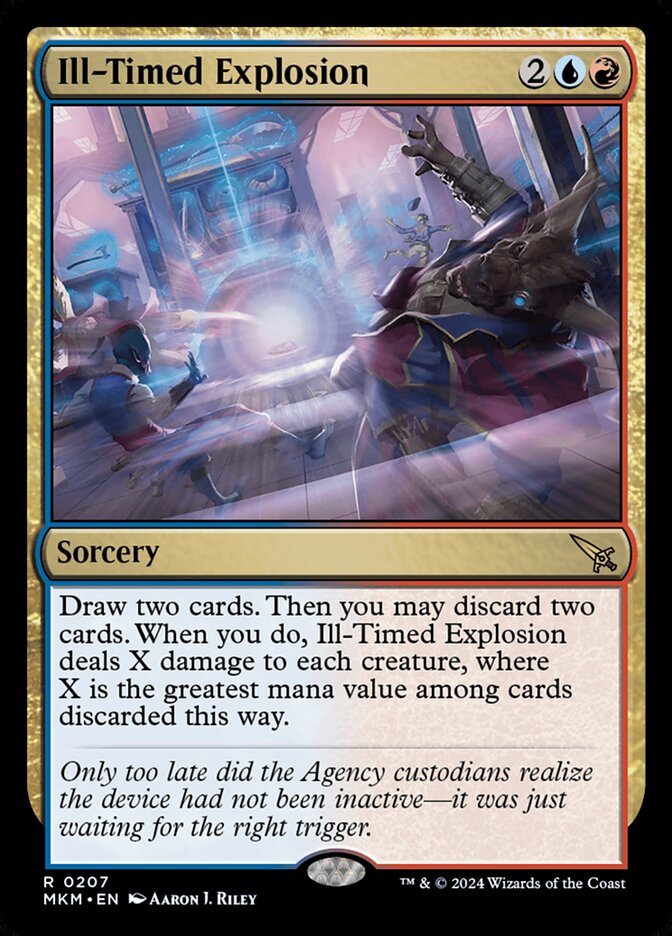
Rating: 6/10
Draw two, discard two, and wipe the board is an interesting mix of abilities. You have to discard something good to actually sweep the board, which I suppose is fair given the circumstances. Ill-Timed Explosion is also has some really nice flexibility as you have some control over the amount of damage you deal. Sometimes discarding a 2-drop kills your opponent’s board and leaves you with something, which makes this card even more appealing. Plus, you have a buyout of just having it be an expensive Divination if the board wipe part doesn’t look like it will work.
Insidious Roots
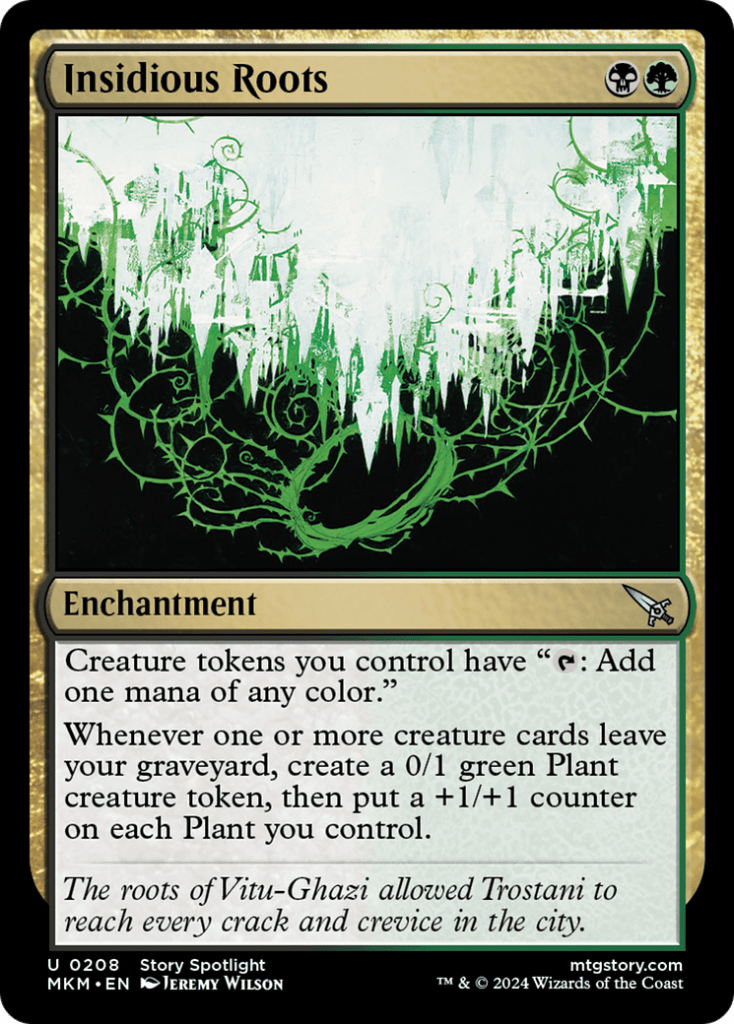
Rating: 4/10
I have a glimmer of hope that this black/green archetype of removing creatures from your graveyard might be somewhat viable, but it’s still not a thing I think you can do very often. If Insidious Roots were something you could easily trigger every turn, I think it would be amazing. It still remains to be seen just how often you can do this, which really limits its playability.
Izoni, Center of the Web
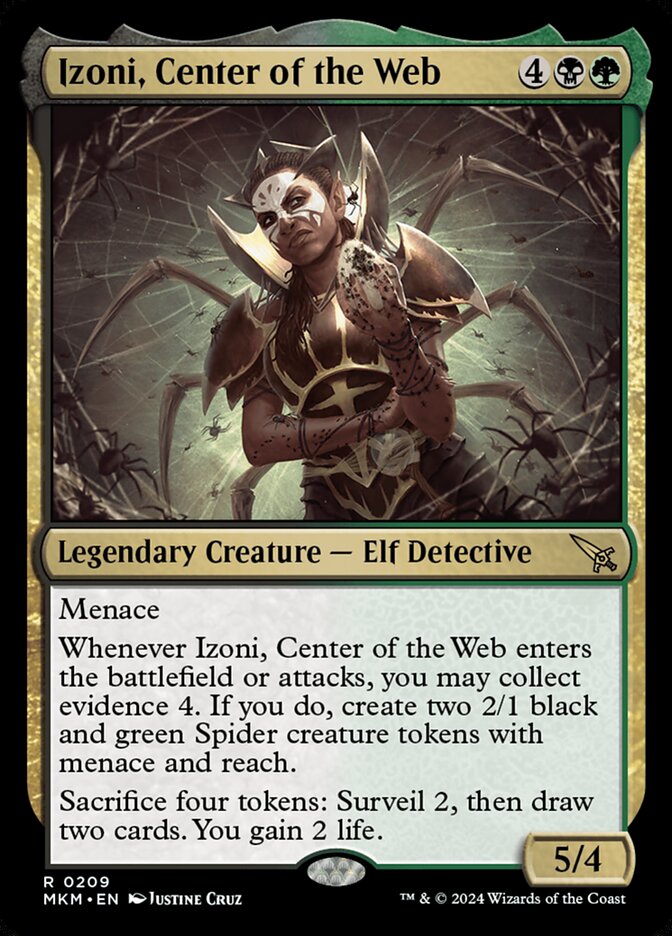
Rating: 10/10
I mean… Izoni, Center of the Web is just a Grave Titan, right? Sure, you have to collect evidence, but have you ever played against Grave Titan? It’s not even remotely beatable. Not to mention that black/green has ready access to multiple ways of getting Izoni back after it dies. Black/green might not have legs as an archetype, but Izoni and its Spiders are pretty disgusting without trying, and I’d easily splash for this whenever I could.
Judith, Carnage Connoisseur
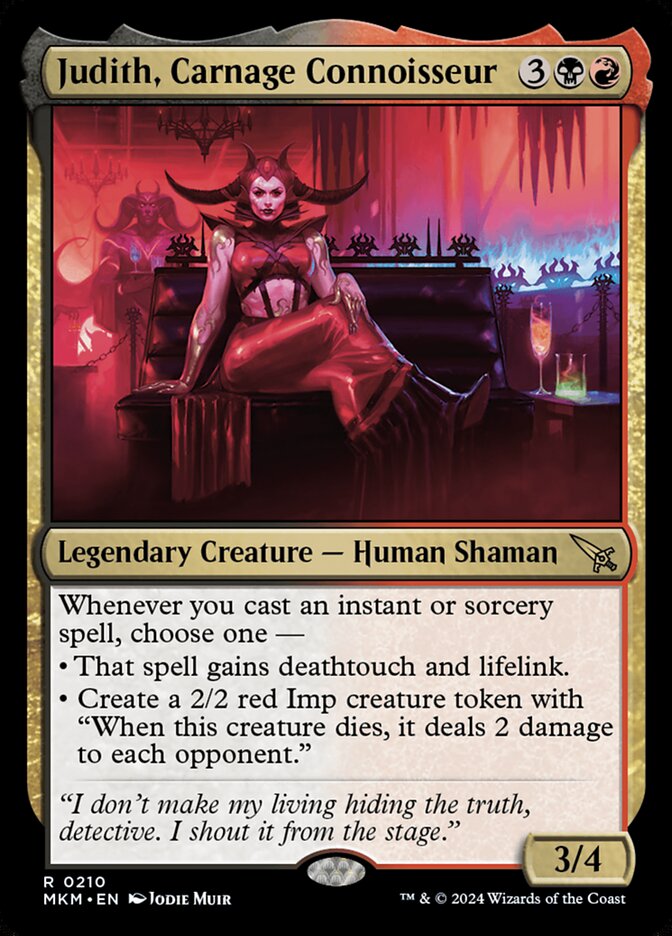
Rating: 8/10
You’ve gotta love turning Lightning Helix into “destroy target creature, gain 6 life”. Realistically, I think we’re only ever going to want to make the free Imp tokens with Judith, Carnage Connoisseur, and assuming you can get one or two of them for free without trying too hard, it looks incredible. There isn’t really an instant/sorcery theme in the set, so Judtih’s potential is somewhat limited, but it should still be very strong in most decks that can support it.
Kaya, Spirits’ Justice
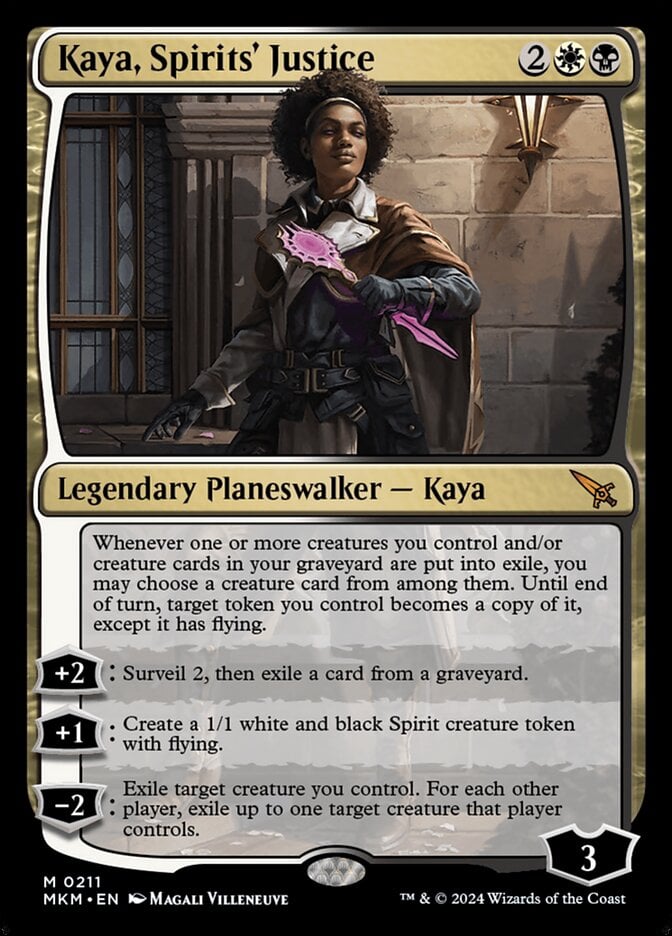
Rating: 9/10
Kaya, Spirts' Justice is quite a weird design that’s hard to make sense of, but how bad can a 4-mana planeswalker be if it +1s to make a 1/1 flying Spirit token? I think the token generation angle is the main thing to note here, though Kaya can also Bone Splinters any creature with its -2 while also turning, say, a Clue token into the creature you lost for the turn. I’m not sure if that’s all that useful, but hey, you exiled a creature and it ain’t coming back. Kaya has a lot more potential than I’m giving it credit for, though it’s difficult to figure out if it’ll be able to fulfill all of that in the context of Limited.
Kellan, Inquisitive Prodigy
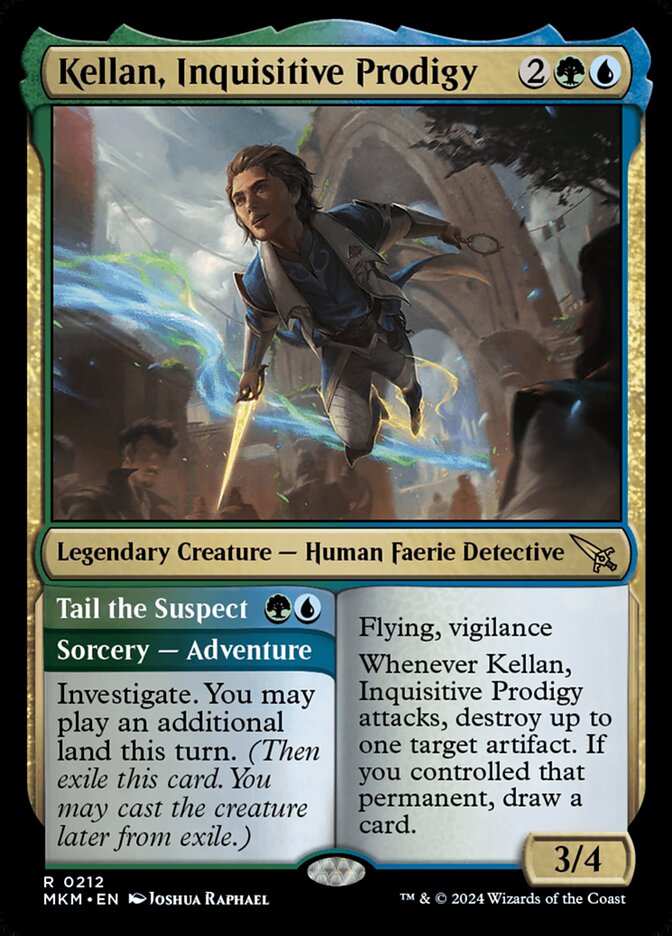
Rating: 9/10
This is the best version of Kellan that we’ve gotten so far for Limited. It’s basically a 4-mana Serra Angel crossed with a Trygon Predator, and it can cash in clues for free. Not only that, but you can just get a free investigate with Kellan, Inquisitive Prodigy’s adventure mode and potentially even get to cast it a turn ahead of time. If it all comes together, Kellan dominates an early board and puts you far enough ahead that it practically wins the game for you by itself, making this Kellan an incredible bomb rare.
Kraul Whipcracker
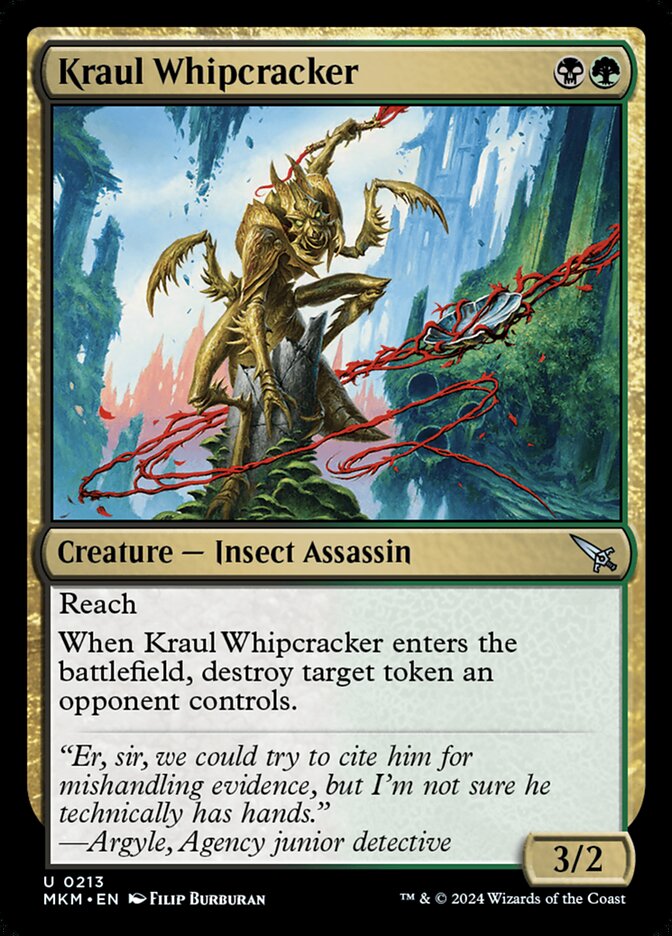
Rating: 6/10
There are a ton of cards in this set that make either Clue tokens or 2/2 Detectives, and killing either of those for free is really nice. At least, you’d be very happy with a 3/2 for 2 anyway, so killing one of those for free is a great bonus to get from Kraul Whipcracker.
Kylox, Visionary Inventor
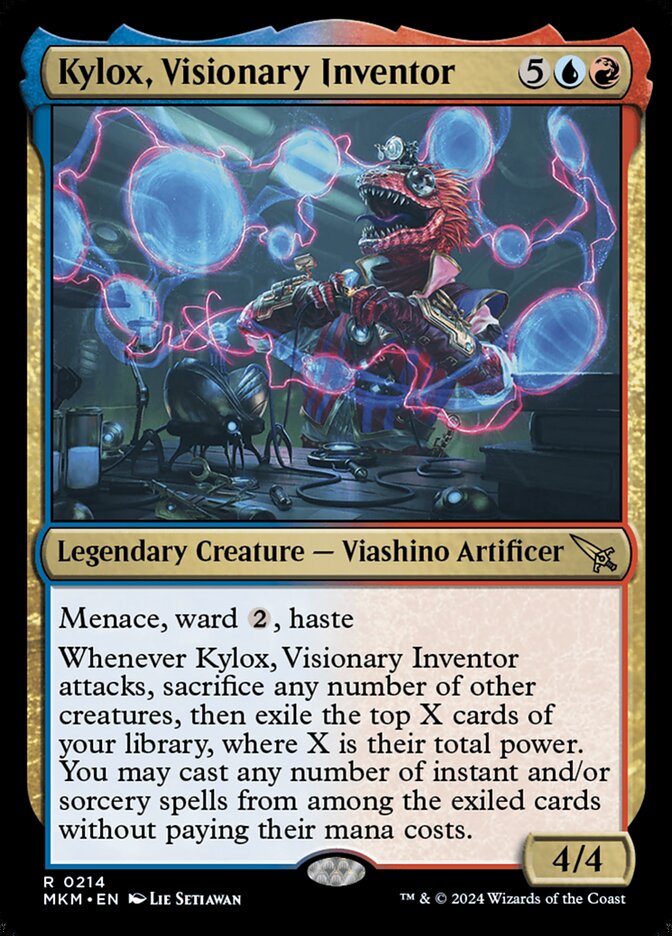
Rating: 0/10
Kylox, Visionary Inventor looks like a very weird design to me. I want a lot of instants and sorceries in my deck but also big enough creatures in play to sacrifice to dig through my deck and find those spells? This sounds like something that never will come together in Limited, meaning you’re left with 7 mana for a 4/4 haste menace, which I don’t think any deck is going to care about. Best leave this one for a cool Commander brew.
Kylox’s Voltstrider

Rating: 7/10
Isn’t it weird that Kylox is a mediocre rare, but his magical walking car is a strong mythic? Yeah, I think this card is great. The Kylox's Voltstrider is a cheap, efficiently-sized vehicle that gives you a nice out to cast some free spells. I think the best use of this is the cycle of split cards, which will satisfy the evidence that you need, and then you can cast either side of them with Voltstrider’s ability. Any number of free spells you can get from this is a great deal and well worth going for.
Lazav, Wearer of Faces
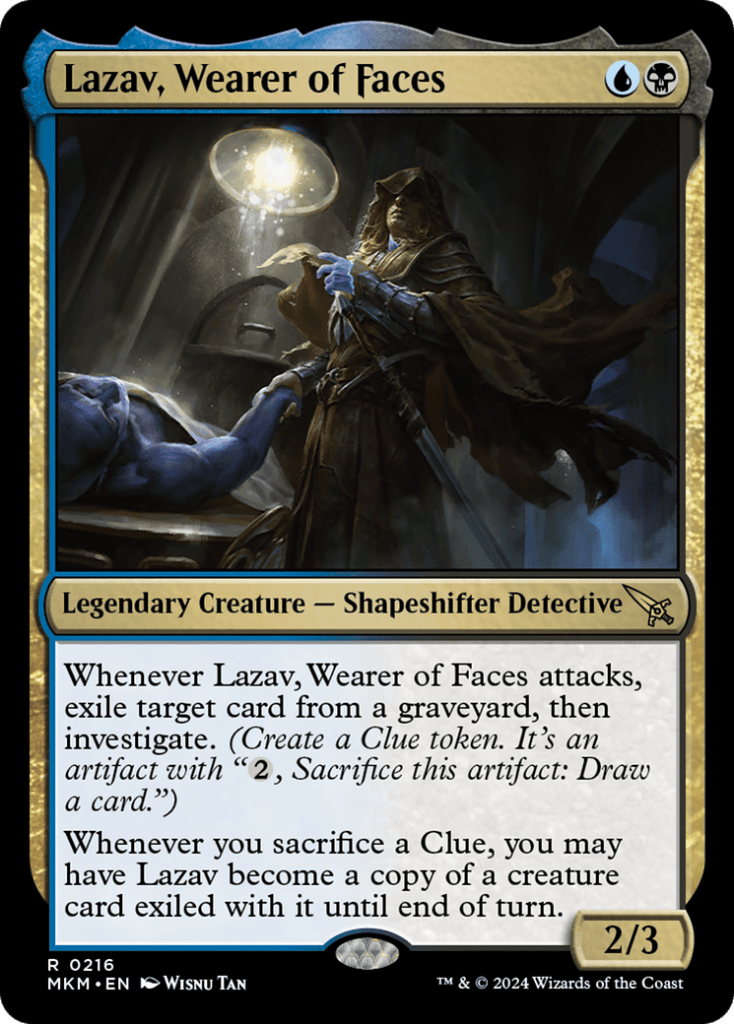
Rating: 6/10
There are going to be some situations where Lazav, Wearer of Faces just gets to attack and investigate every turn. If there’s a big enough creature in the graveyard for it to exile, you can leave a clue in play threatening to turn it into that big creature whenever you need to, allowing it to keep attacking unimpeded each turn. Given that you get a Clue whenever it attacks (assuming there’s something to exile), it’s really worth setting this up. Plus, you can just turn Lazav into some ridiculous bomb if you get lucky at some point.
Leyline of the Guildpact
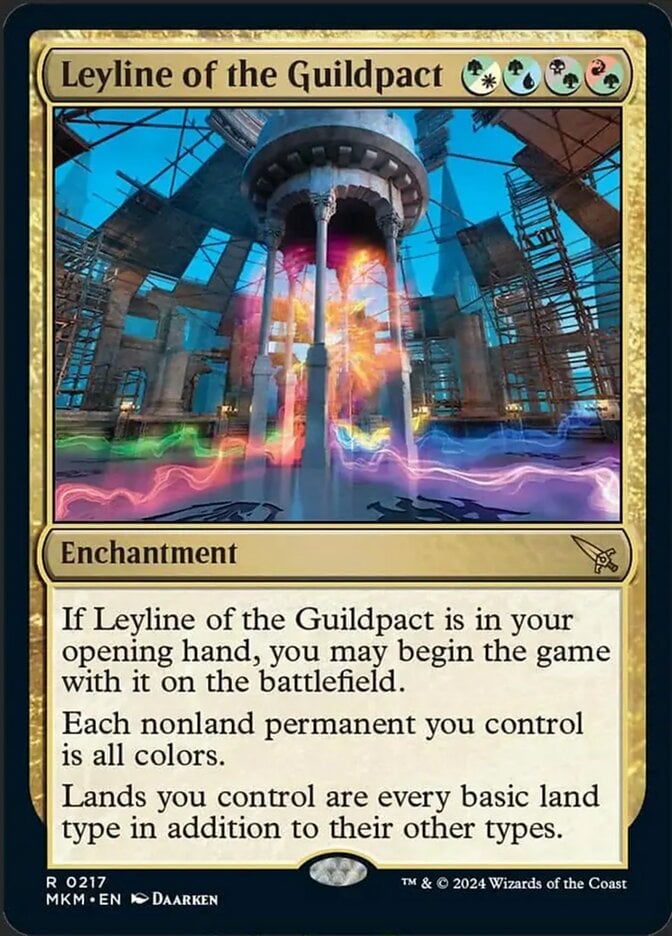
Rating: 0/10
Maybe someday they’ll print a leyline that actually does something relevant in Limited, but it’s definitely not Leyline of the Guildpact.
Lightning Helix
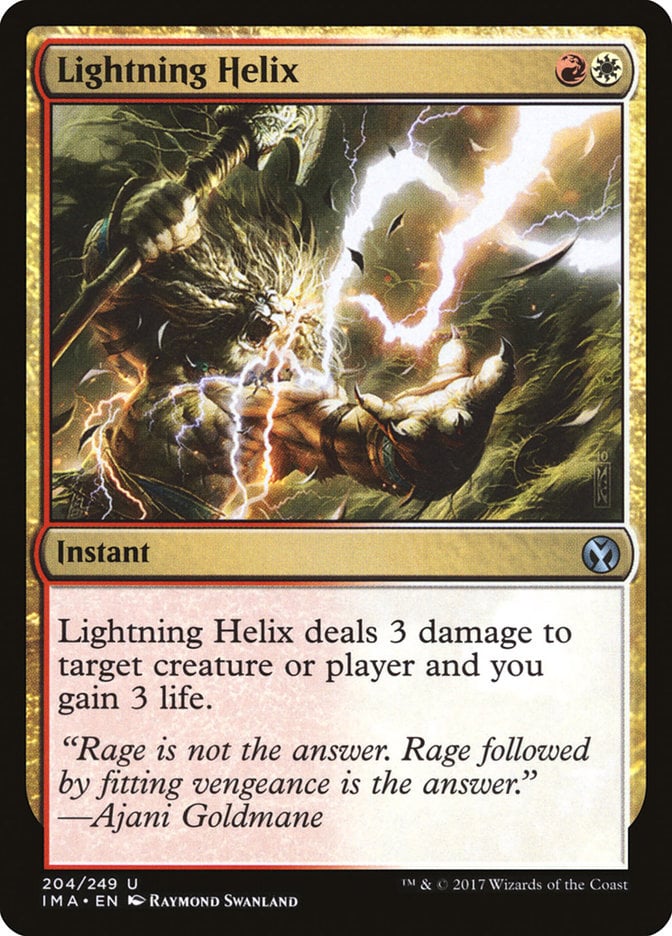
Rating: 7/10
Classics are so named for a reason. Lightning Helix has been a staple of Magic ever since it was first printed in 2005, and nothing suggests to me that that has changed 19 years later. Killing a creature plus gaining life is a massive tempo swing and it even goes to the face to close out a game for you.
Meddling Youths
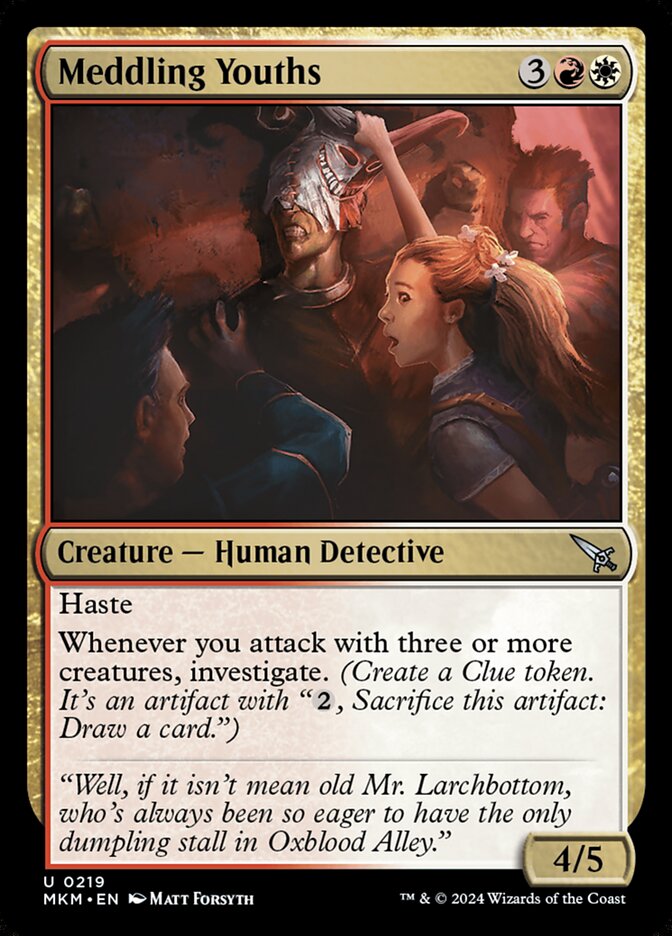
Rating: 7/10
We all know what Meddling Youths is referencing, and sadly the name Meddling Kids was already taken. Huge haste creatures have historically been very powerful. Just when your opponent thinks the board is stable, you drop this down and all of a sudden they’re dead, or at least have to make some bad blocks. Much like Aurelia, this is among the best ways to top your curve in a red/white aggro deck.
Niv-Mizzet, Guildpact

Rating: 0/10
Is Niv-Mizzet, Guildpact actually castable? We may be on Ravnica and have a lot of multicolored cards to play, but the set has surprisingly little mana fixing. As such, I don’t think five colors is realistic. I wish it was, because Niv looks absolutely bonkers if you get even one attack off with it.
No More Lies
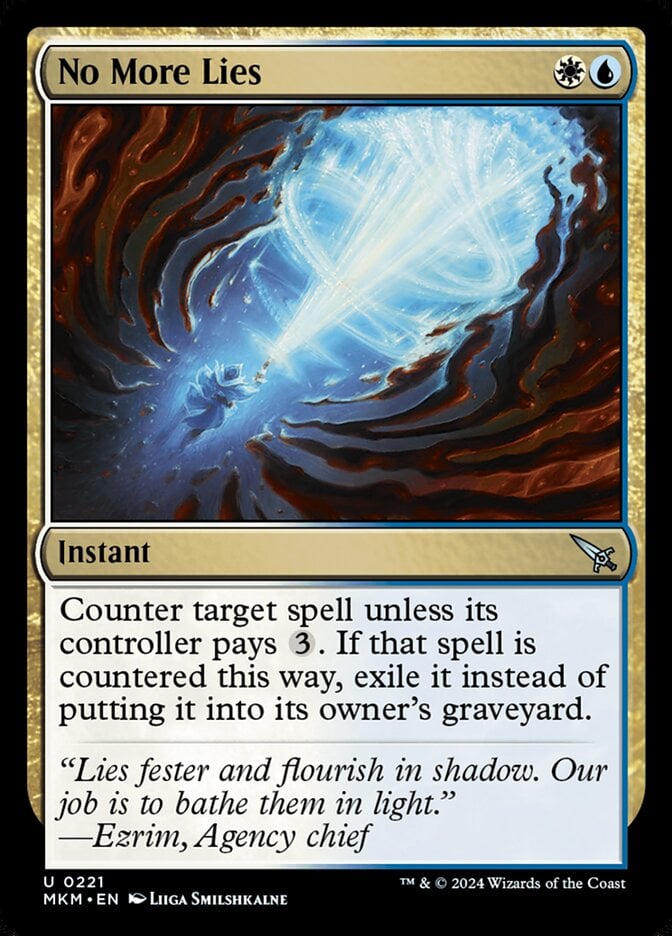
Rating: 4/10
Mana Leak is one hell of a card. Your opponent needing to pay 3 mana extra means this can stay relevant for much longer in a game than something like Quench can. Awkwardly though, Mana Leak’s biggest advantage is that it’s easy to cast, whereas No More Lies is quite difficult to cast. I think that’s enough to get in its way and ultimately make it fall short of the awesome reprint we all hope it will be, but I suppose only time will tell.
Officious Interrogation

Rating: 6/10
If you look at Officious Interrogation as a nice, cheap draw spell that has a lot of synergy with the set’s mechanics, it looks quite good. You only need to get a couple of clues for it to feel like a worthwhile play, and it should be pretty easy to get that. But sometimes you’ll get four, five, or even more, and it’ll feel especially dirty.
Private Eye
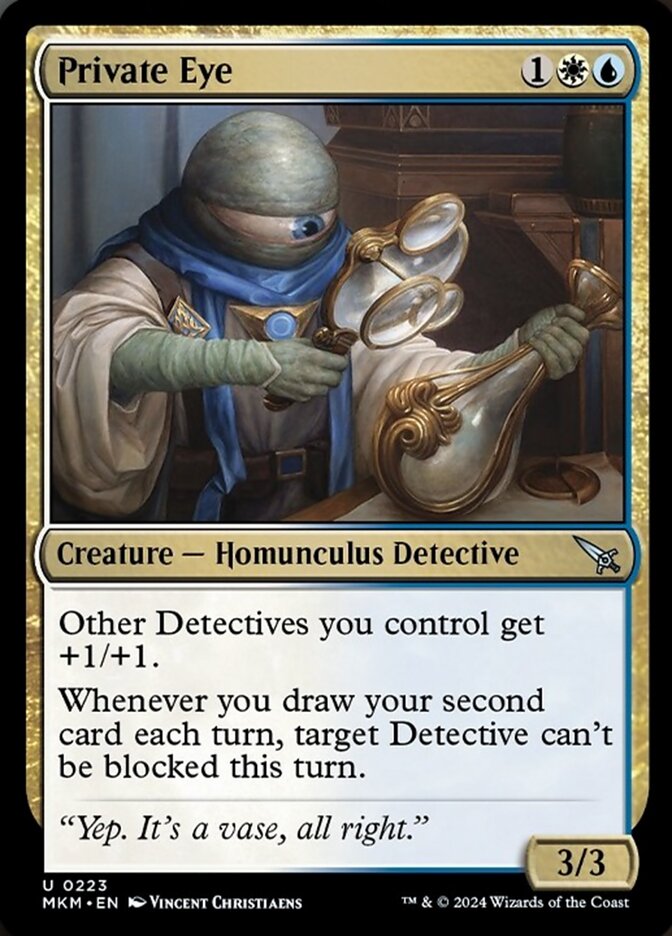
Rating: 7/10
I’d honestly just have been happy with a Kargan Warlord for detectives, so getting an extra ability seemingly for free really makes Private Eye a great signpost card for the deck and helps you really outshine the 2/2 disguises that will be roaming around the set.
Push // Pull
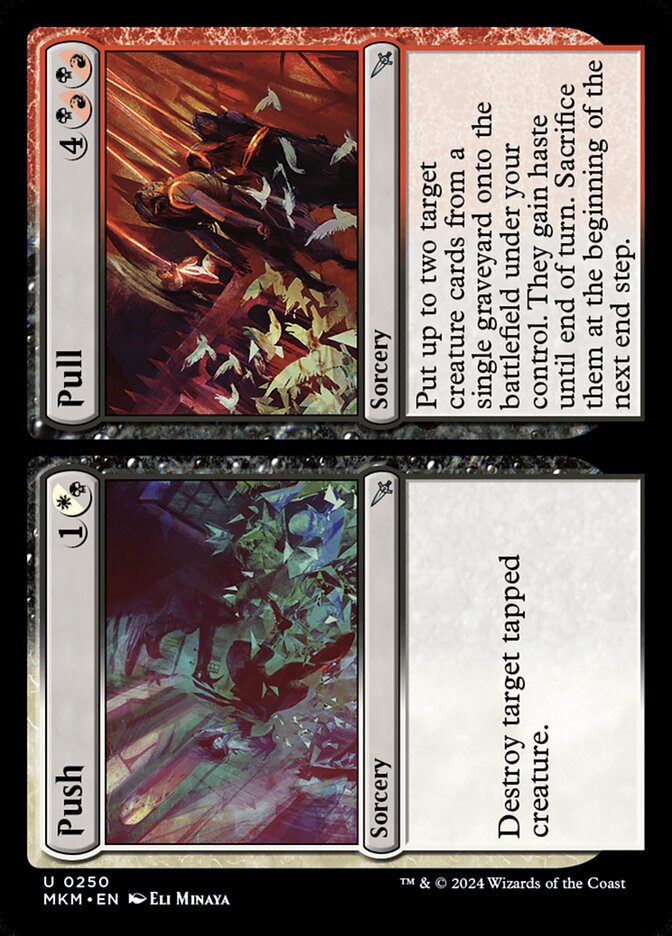
Rating: 5/10
A 2-mana Assassinate is fairly decent, even if it’s on the situational side like Push // Pull. Pull isn’t the best effect to have, though as an option to have on a medium removal spell, I’ll definitely take it. I like my removal spells to be able to randomly kill my opponent out of nowhere.
Rakdos, Patron of Chaos
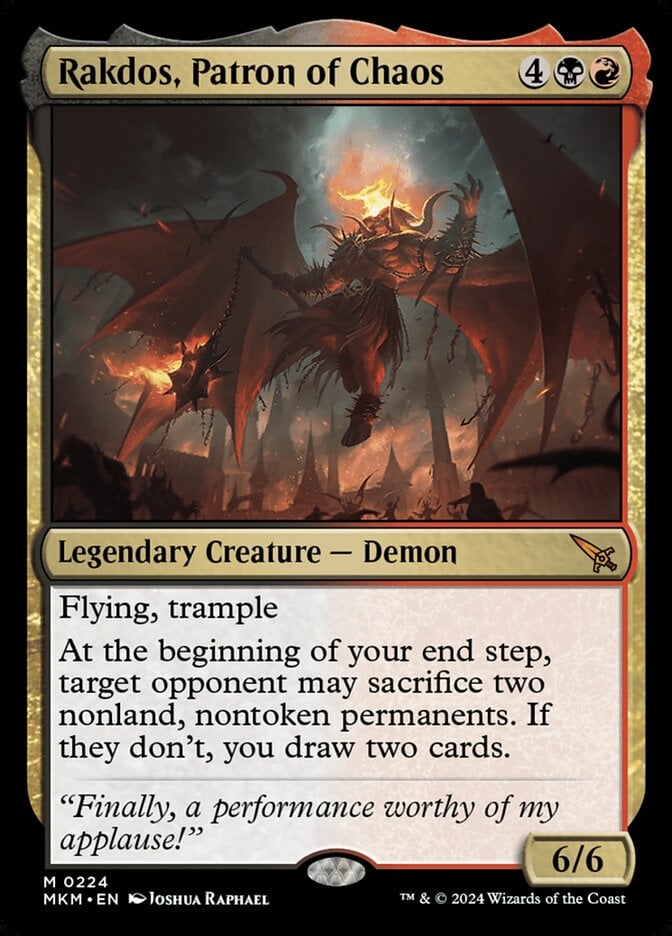
Rating: 10/10
You can obviously never go wrong with a 6/6 flampling demon for 6, so there’s that, but Rakdos’s trigger is just absurd. Because it triggers on your end step, it goes off on the turn you play it. Then, your opponent has to lose two very real permanents, and they can’t avoid it by sacrificing tokens or lands. And if they choose not to, you draw two? Rakdos looks like the most ridiculous Mulldrifter we’ve ever seen and will end the game in very short order.
Rakish Scoundrel

Rating: 4/10
Getting to use this ability at instant speed is a big deal, even if it costs 6 mana to flip over. Either you make this indestructible and it kills any creature in combat, or your opponent smartly avoids this and you just make something else indestructible so that you get a one-sided combat. It’s expensive, but definitely a powerful trick that’s worth playing towards. I also like the option of just playing Rakish Scoundrel on 4 and getting a free attack in with something that your opponent now won’t want to block.
Relive the Past
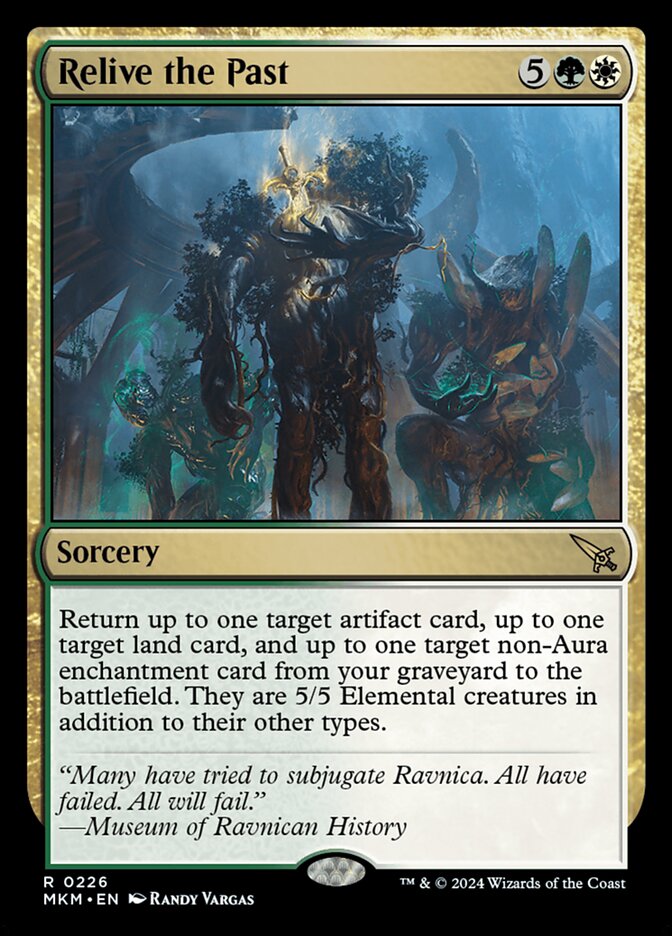
Rating: 1/10
On one hand, Relive the Past could be 7 mana to create three 5/5s. But on the other, much more likely side, you won’t have the right card types in your graveyard for this to do anything relevant. Green/white isn’t really trying to do this in the set, so I don’t get the point of this card and think it’s just bad.
Repulsive Mutation
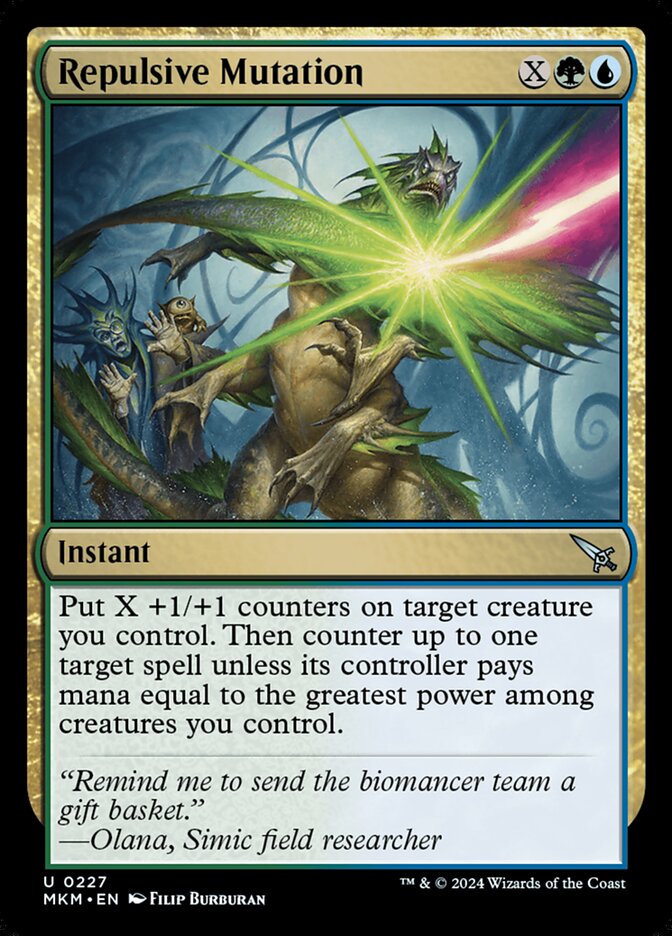
Rating: 5/10
I actually like this a bit more than No More Lies, despite them doing very similar things. Repulsive Mutation can’t counter anything in the early game, but it’s very close to a hard counter in the late game. Even for 2 mana, you can just counter most things by simply having a creature in play. Yet, on top of that, you also get to make one creature enormous if you have some extra mana lying around. You can even use it as a combat trick. This has enough play to it that I’m sure it’ll be able to find a home somewhere.
Riftburst Hellion
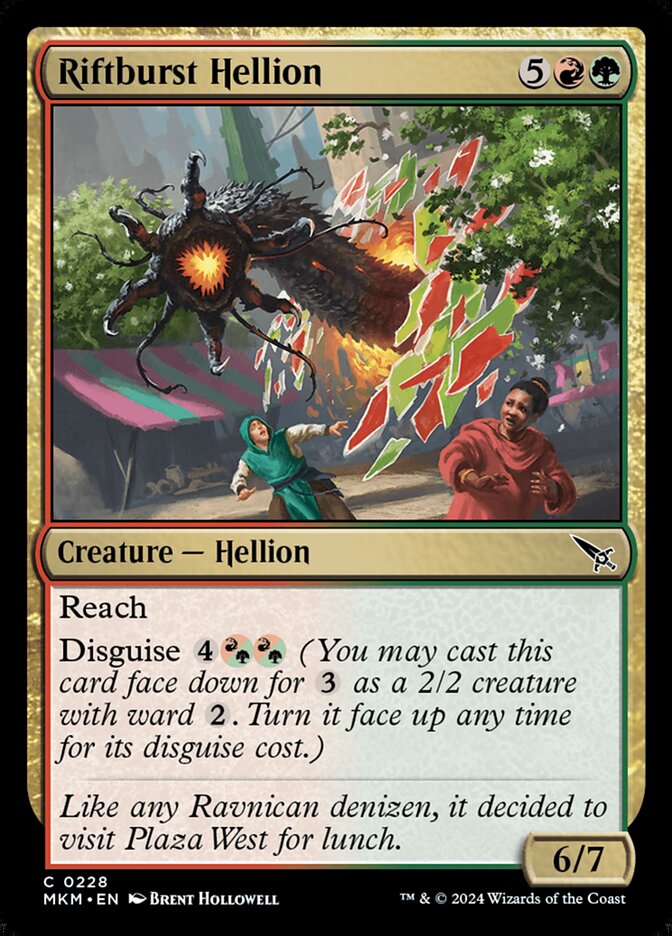
Rating: 4/10
This is going to be one of the funnier disguises to flip face up. “What’s the worst that could happen?” your opponent might think, attacking you with their huge flier, then you just flip Riftburst Hellion over and eat it. Woolly Loxodon was a sweet card in Khans of Tarkir, and this card is just better on every possible metric.
Rune-Brand Juggler
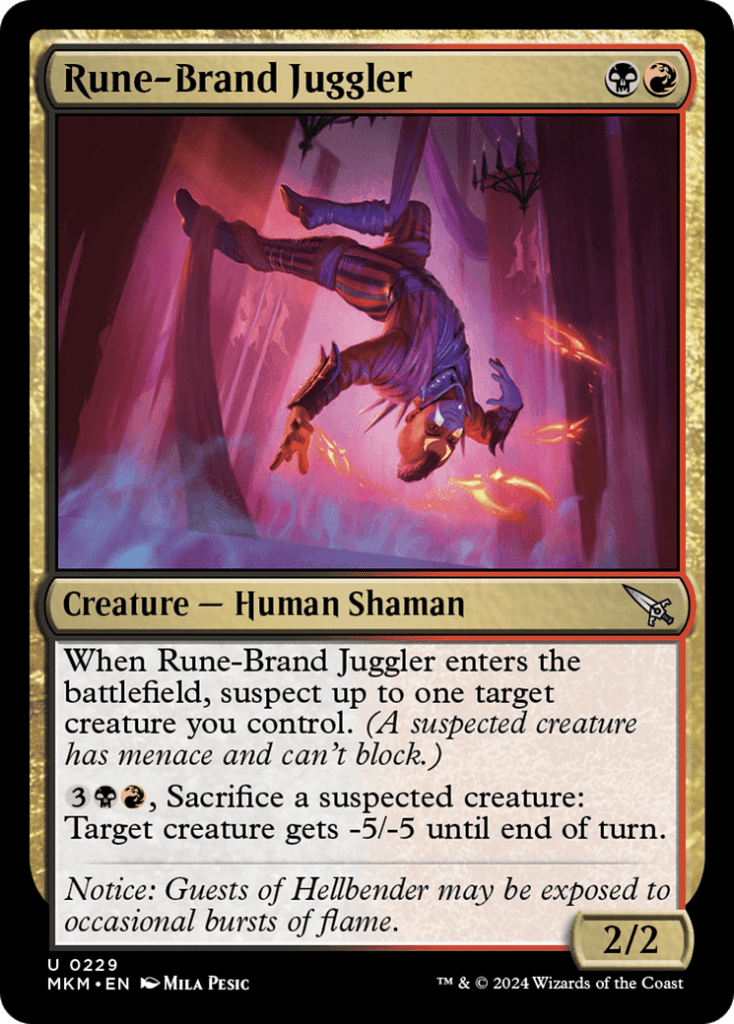
Rating: 6/10
Correct me if I’m wrong, but this seems to be the only real payoff for suspecting your own creatures, other than them naturally having menace? It’s a pretty good one though, and I like the idea of being able to combine Rune-Brand Juggler with Convenient Target to create a repeatable way of trading your replaceable creatures for your opponent’s good ones.
Sanguine Savior

Rating: 5/10
I think Sanguine Savior is one of the best of these common disguise creatures. For one, it’s perfectly serviceable as a 2/1 flying lifelinker, and it might sometimes be correct to run that out on turn 3 and win a race with it. But also, getting to give something else lifelink in a crucial situation could be the difference between winning a race and losing it, and being so cheap to flip over means that ability is very accessible.
Shady Informant
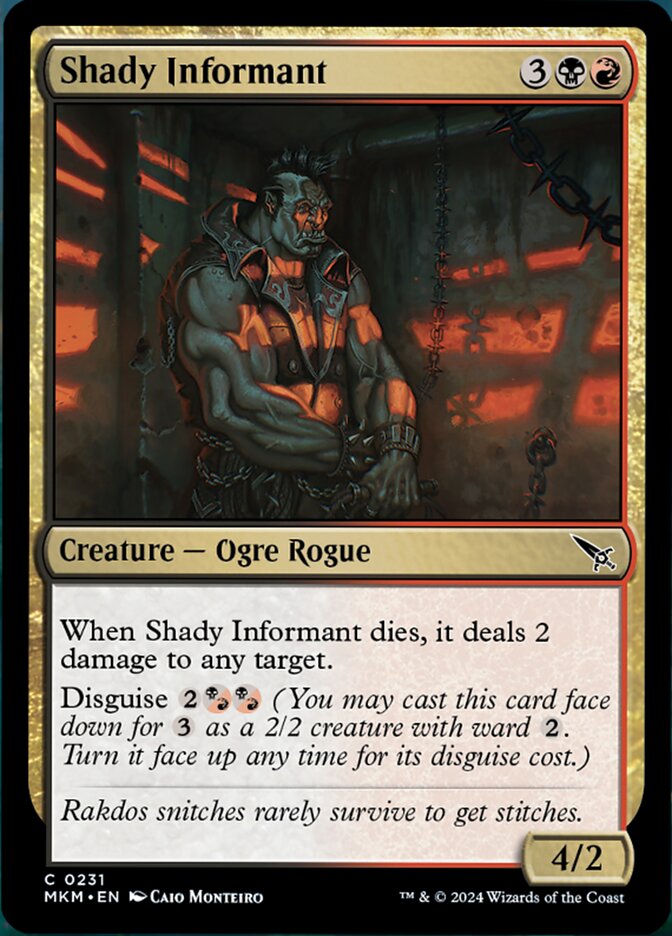
Rating: 4/10
This looks a tad too pricey for my liking. I don’t think Shady Informant is ever going to be worth hard casting, because catching your opponent off guard with the disguise ability makes or breaks it. You can do so to take down a 6/6 by itself, or trade for a 4/4 and a 2/2, which definitely seems to be the best way to use this card.
Soul Search
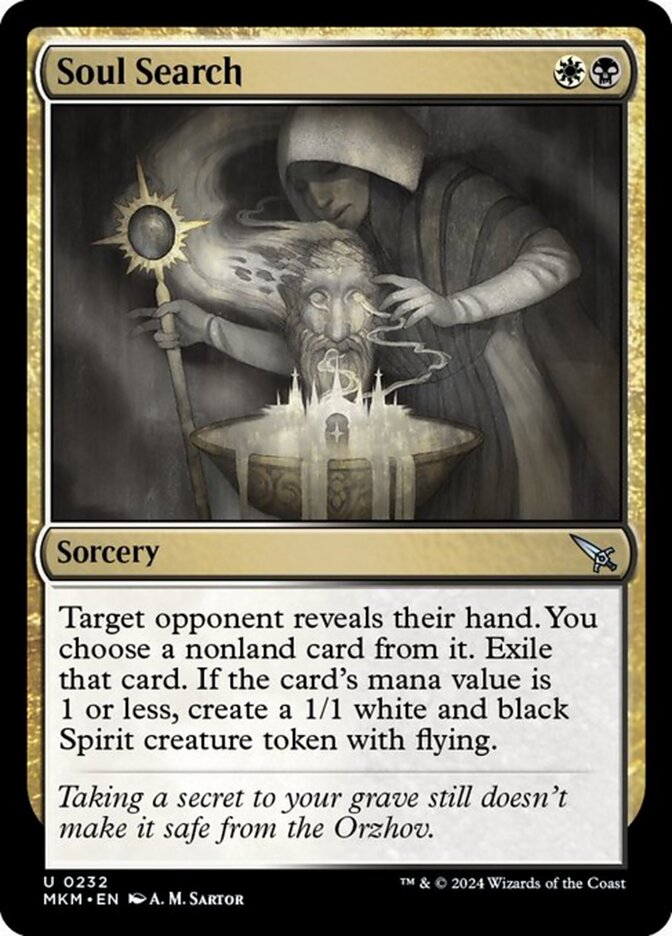
Rating: 3/10
I want my 2 mana Thoughtseizes to be reliable, but this just isn’t because it costs two colors. Sure, it’s playable, but missing the opportunity to cast this on turn 2 can be really painful.
Sumala Sentry

Rating: 6/10
I guess it’s pretty clear what the green/white archetype is. Turning your creatures face up isn’t going to happen very often, but it doesn’t need to happen a lot for this to be good. Not to mention we’ve seen plenty of creatures that can be turned over for just 1 or 2 mana, meaning you might get multiple triggers in the same turn. This makes Sumala Sentry a really annoying creature to play against, as your opponent never knows how big it actually is until they try swinging into it.
Teysa, Opulent Oligarch
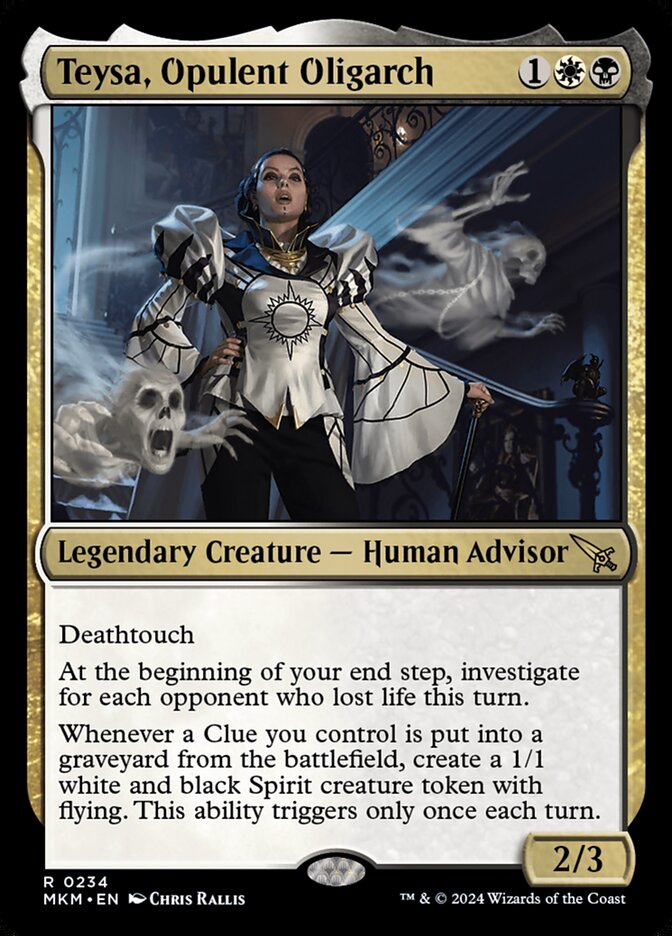
Rating: 9/10
Everything Teysa, Opulent Oligarch does is awesome. All you need is one clue available and it starts an annoying chain where you get a free Spirit, which in turn lets you hit your opponent and give you back a Clue, which then gives you another Spirit, and so on. The big downside of Clue tokens is needing to spend the time and mana to sacrifice them while not contributing to the board, but Teysa solves that problem for you very easily.
Tin Street Gossip
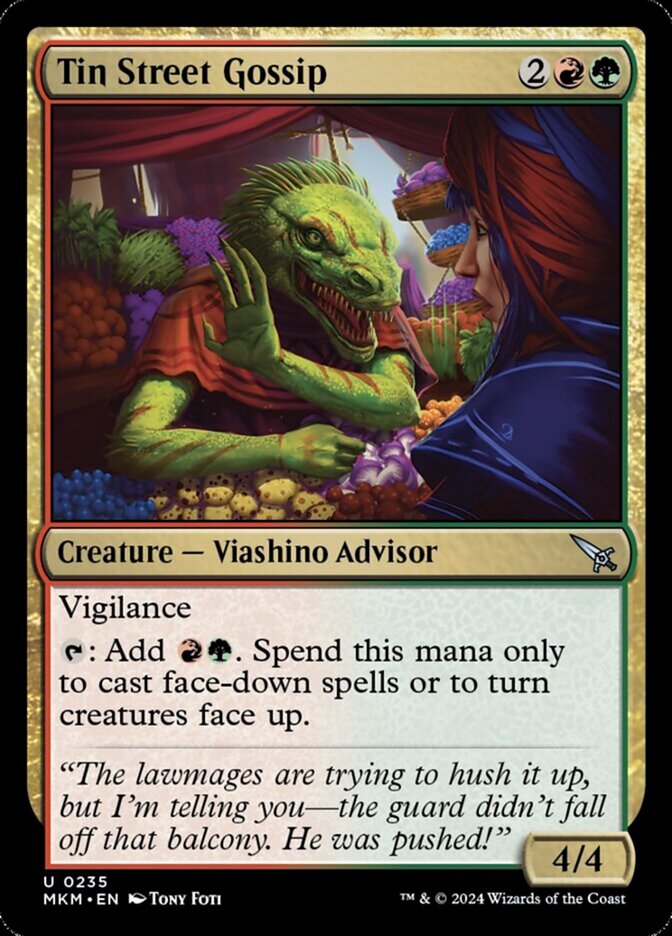
Rating: 7/10
Four-drop mana dorks that provide only situational mana are pretty bad… oh wait, this is also a 4/4 vigilance for 4. Never mind, Tin Street Gossip is awesome. Those stats really carry it, and 2 extra mana to turn something face-up could go a long way towards some of the green creatures that cost 6 or 7 mana to use.
Tolsimir, Midnight’s Light
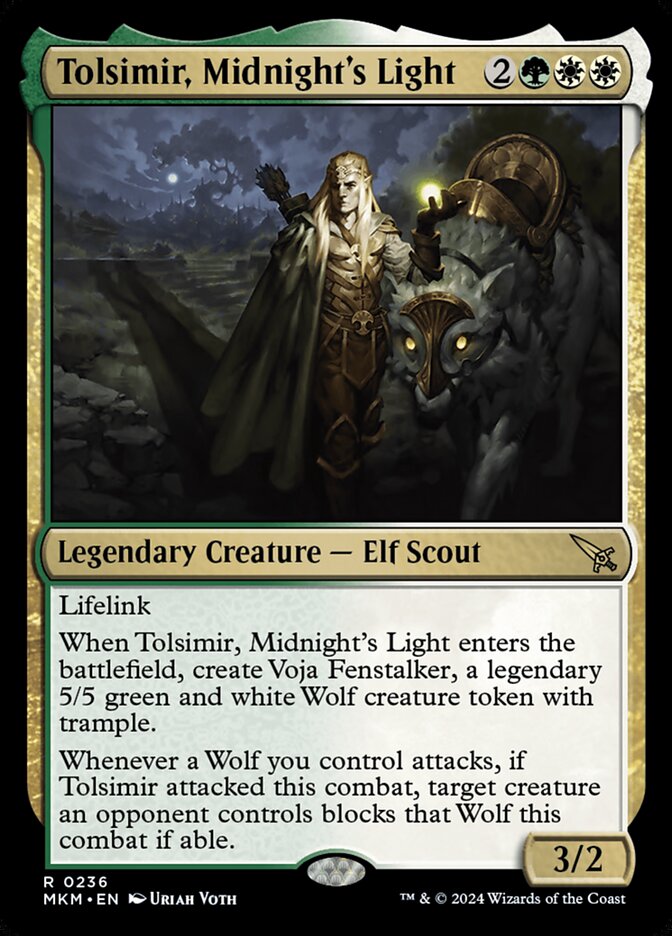
Rating: 10/10
This is our third version of Tolsimir, and our third Limited 10/10. Holy crap, Tolsimir, Midnight's Light can do no wrong. Five mana for a 3/2 with lifelink and a 5/5 trampling wolf is just nuts. Yeah, you can force creatures to block Voja Fenstalker, that’s cool, but you had me at the first ability. What a card.
Treacherous Greed
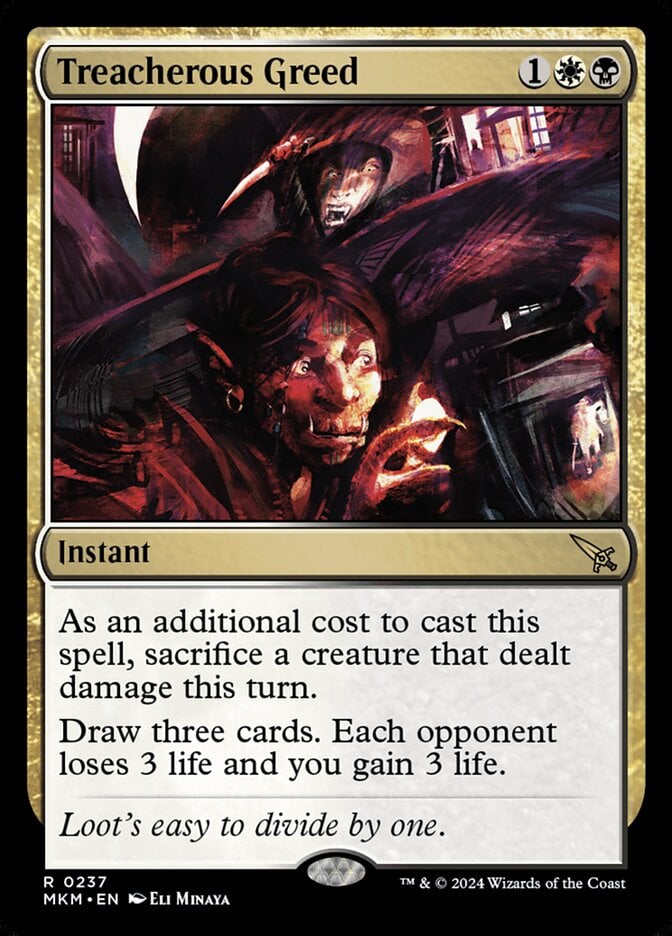
Rating: 2/10
I don’t know about you, but this looks really bad to me. Having a creature deal damage and survive to the end of combat isn’t trivial to do, but even worse, a creature capable of doing that probably isn’t something you want to be sacrificing. You also lose the best use of sacrifice spells, which is that you won’t be able to sacrifice anything in response to removal. While Treacherous Greed isn’t unplayable, I think this is really far from being good.
Trostani, Three Whispers
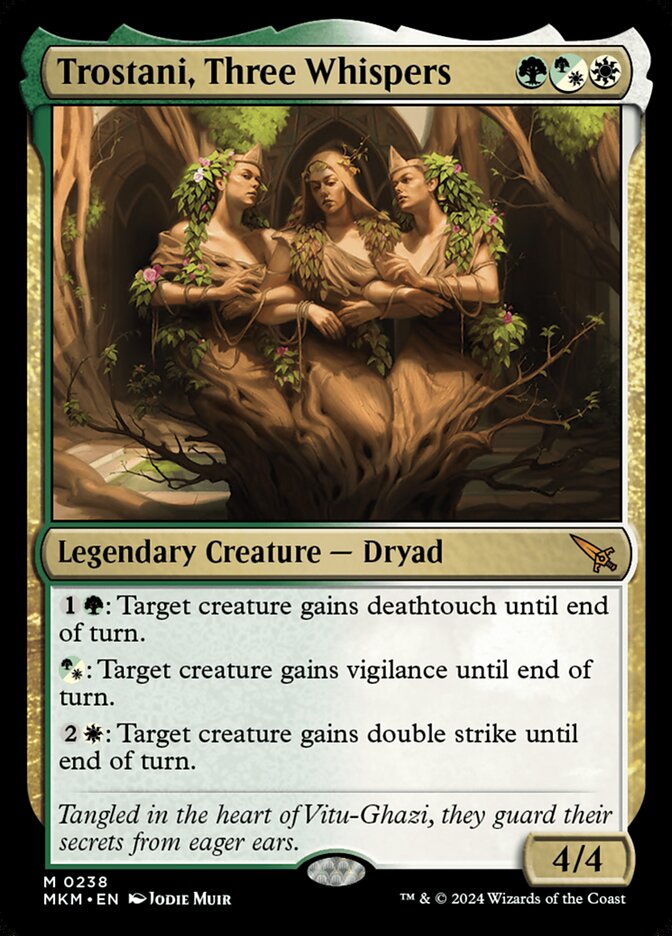
Rating: 9/10
Spoiler warning for the MKM Story. Did anyone else figure out that Trostani was the culprit the moment they saw Trostani, Three Whispers? Apparently the killer was using pollen to coerce unsuspecting citizens to kill people, and this Trostani gives deathtouch to other creatures! I mean… yeah. Anyway, this dryad is really good. Particularly because of the ability to give double strike to your creatures, which combined with deathtouch just means that your opponent can never get into combat safely again.
Undercover Crocodelf
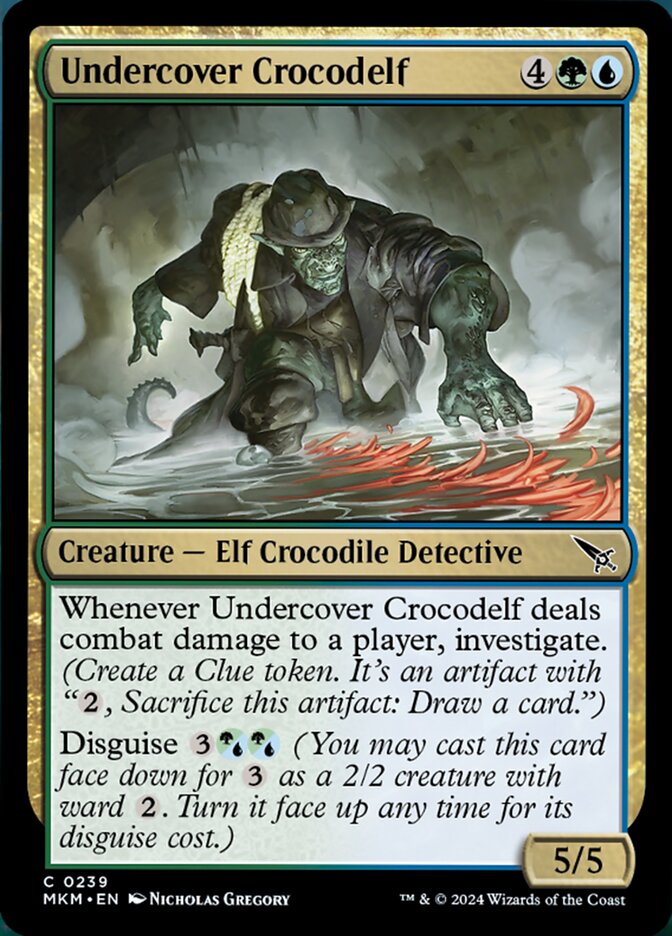
Name: 10/10
Rating: 4/10
I just love it. It’s a Crocodelf! I didn’t know I needed Undercover Crocodelf in my life until now, but here we are. This honestly reminds me a lot of Snowhorn Rider, which anyone who played Khans of Tarkir will tell you was a messed-up morph creature. It’s just huge, and you can’t let it through too often or you’ll lose.
Urgent Necropsy
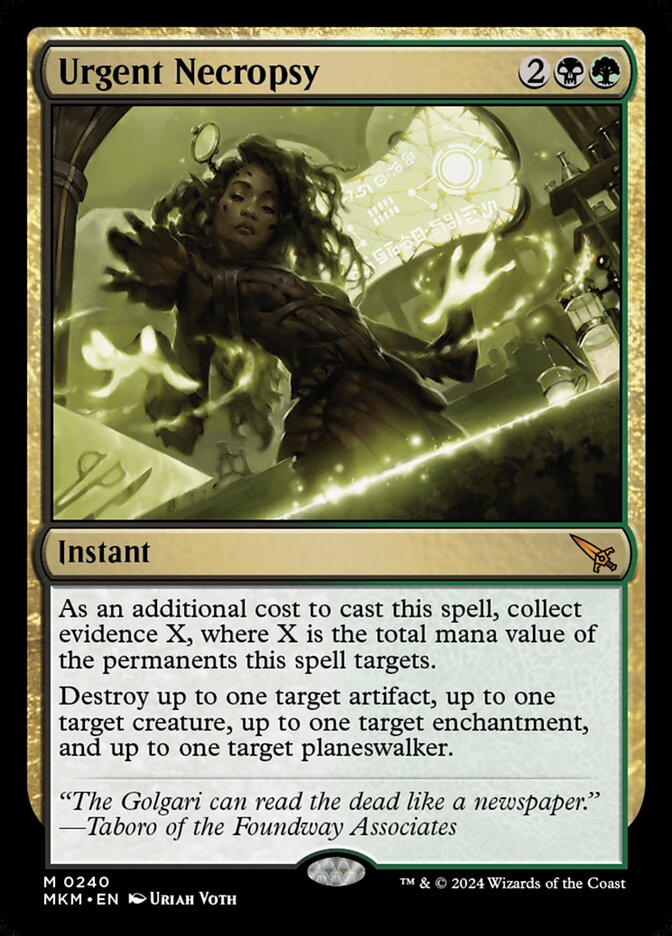
Rating: 3/10
Realistically, Urgent Necropsy is only ever going to kill a creature anyway, so it’s just a weak Murder with a bunch of extra steps. Sure, it’s removal, but very weak removal and a very disappointing mythic.
Vannifar, Evolved Enigma

Rating: 9/10
Vannifar is back with a vengeance, and oh boy is she back. Cloaking a card from your hand each turn is one thing, but maybe you don’t want to use up the cards in your hand that way. Well, then Vannifar, Evolved Enigma flips over to growing all your disguised/cloaked creatures each turn. It shouldn’t take you long to win if Vannifar is left alone for a while.
Warleader’s Call
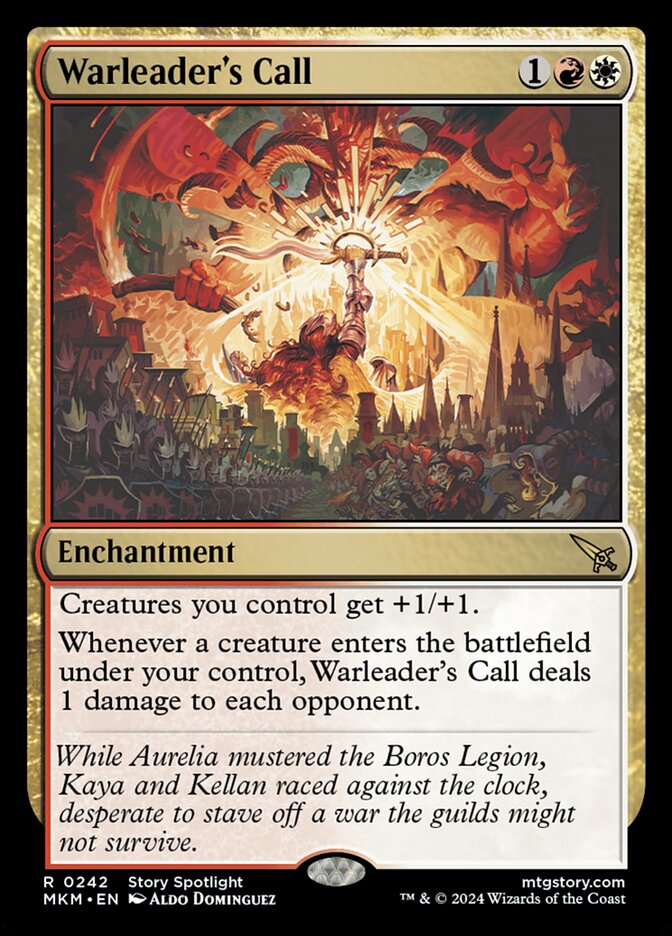
Rating: 9/10
Glorious Anthem is already an exceptional card, so tack on a really strong ability to hit your opponent whenever you play a creature and I’m definitely paying attention. It may not sound like much, but if you play Warleader's Call early enough, the triggers could add up to an extra 5 or 6 damage on top of an anthem effect that you’d happily play if it did no damage.
Wispdrinker Vampire

Rating: 7/10
The final signpost uncommon is a real banger. 2/4s are really well positioned in a format full of 2/2s, the “2 power creatures matter” archetype has tons of great ways to spam the board, and each one of them drains your opponent for a point of life? That seems incredible. Wispdrinker Vampire makes me really want to prioritize cards like Krovod Haunch and Dog Walker to really maximize it.
Worldsoul’s Rage
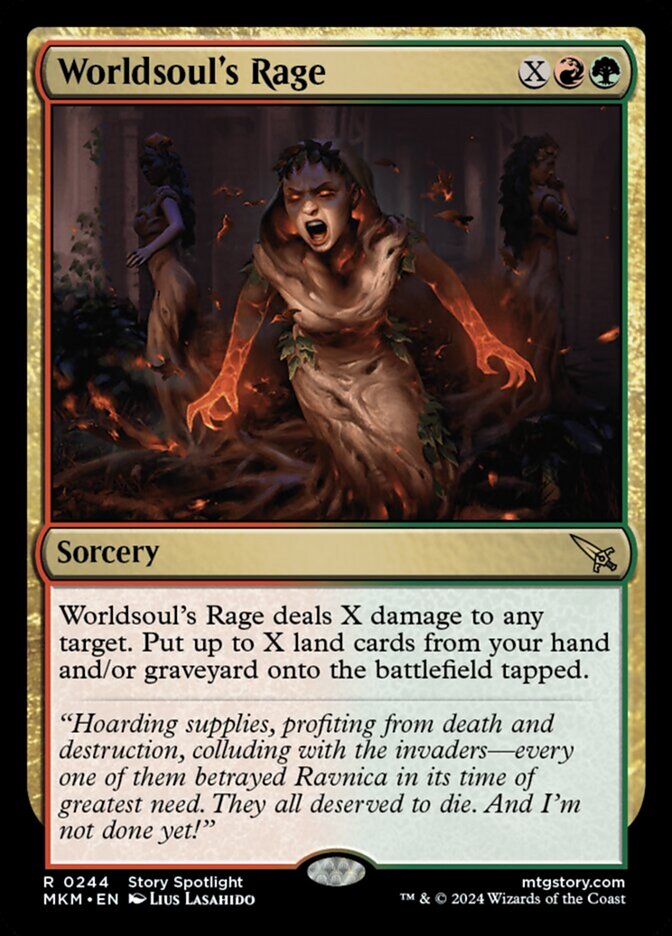
Rating: 8/10
You can really tell that WotC just wanted to make a green Fireball and were asking “how do we make this feel more green?”. They ended up tacking on some random ability that does something with lands. Yeah, I don’t care, but I’ll happily take a spell that does X damage to any target for . Worldsoul's Rage kills most creatures and finishes off your opponent in the late game, what’s not to love?
Yarus, Roar of the Old Gods
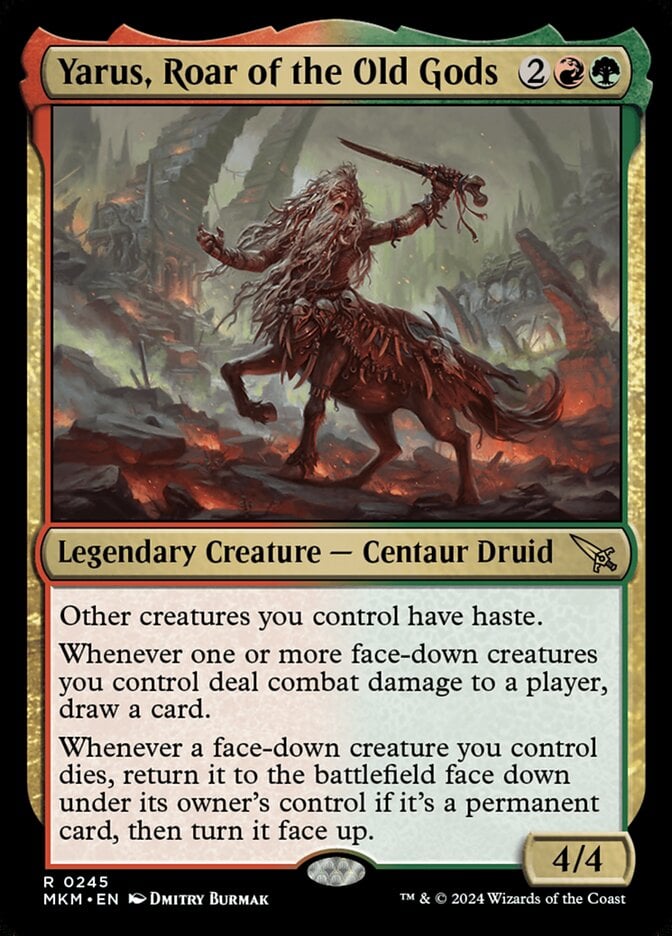
Rating: 9/10
Yarus, Roar of the Old Gods makes it so that you can actually just attack with any and all of your face-down creatures without fear of losing anything. That makes it a lot easier for some of them to draw you a card or two whenever they deal combat damage. On top of that you get to haste out every creature you play? This sounds like an incredible bomb for the red/green archetype.
Colorless
Case of the Shattered Pact

Rating: 1/10
I don’t think Case of the Shattered Past is very solvable due to the overall lack of color fixing making it too hard to play all five colors. You might be able to make it happen thanks to the hybrid cost disguise creatures, but it seems too unlikely for me. If you think that your deck might want a worse Environmental Sciences, then by all means go for it, but I doubt that will be the case.
Cryptex
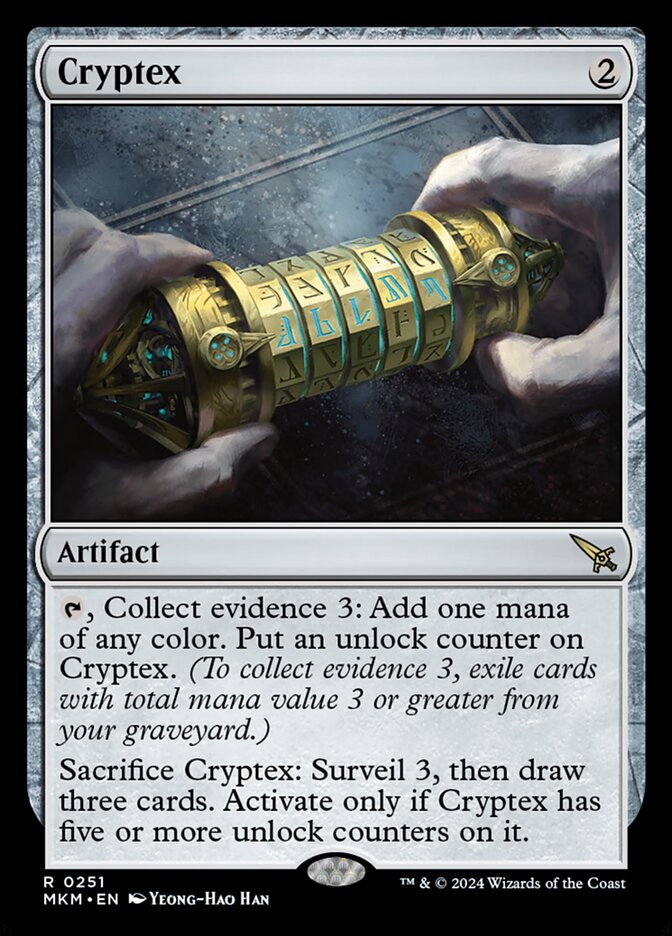
Rating: 0/10
Don’t you just love mana rocks that require a lot of set up to work? Yeah… me neither. If I’m planning to collect evidence, I’m not going to be collecting 15 to enable Cryptex over five separate activations. It’s just not worth it.
Gravestone Strider

Rating: 2/10
There isn’t much mana fixing in the set, so I’m sure I’ll end up playing Gravestone Strider more often than I’d like, though it still doesn’t look too appealing.
Lumbering Laundry
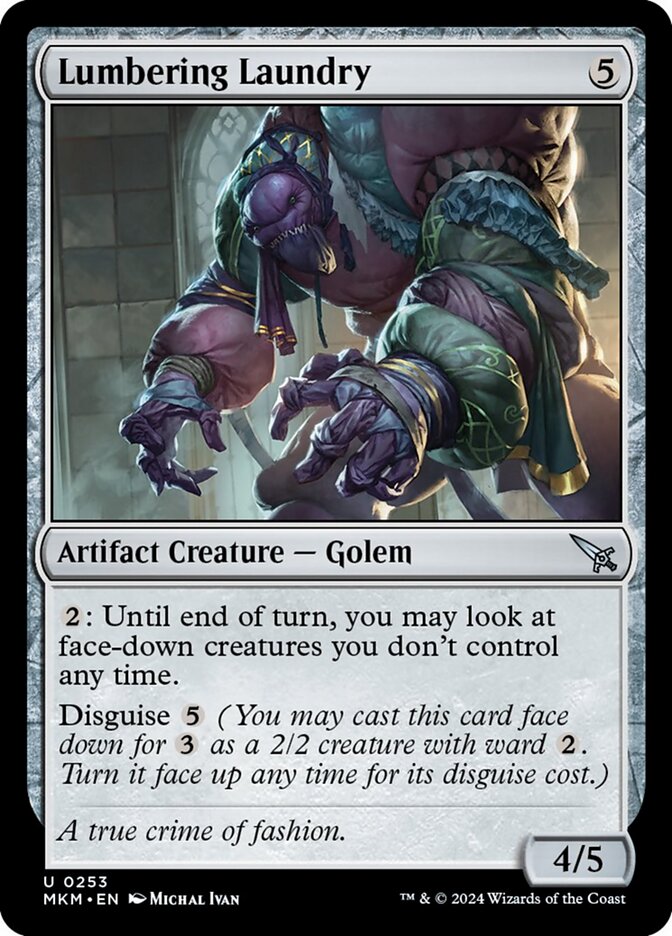
Rating: 2/10
Witness of the Ages was surprisingly playable back in the day, and while Lumbering Laundry isn’t much better, it does have disguise, making it at least fine to cast face-down. It doesn’t do much else though.
Magnetic Snuffler

Rating: 5/10
Normally, a card like Magnetic Snuffler would be nearly unplayable. Equipment just doesn't naturally end up in the graveyard. But this set is different. Between Krovod Haunch and the Clue(do) equipment, we have a bunch of equipment that can sacrifice themselves for value, which really gives this card a lot of value.
Magnifying Glass
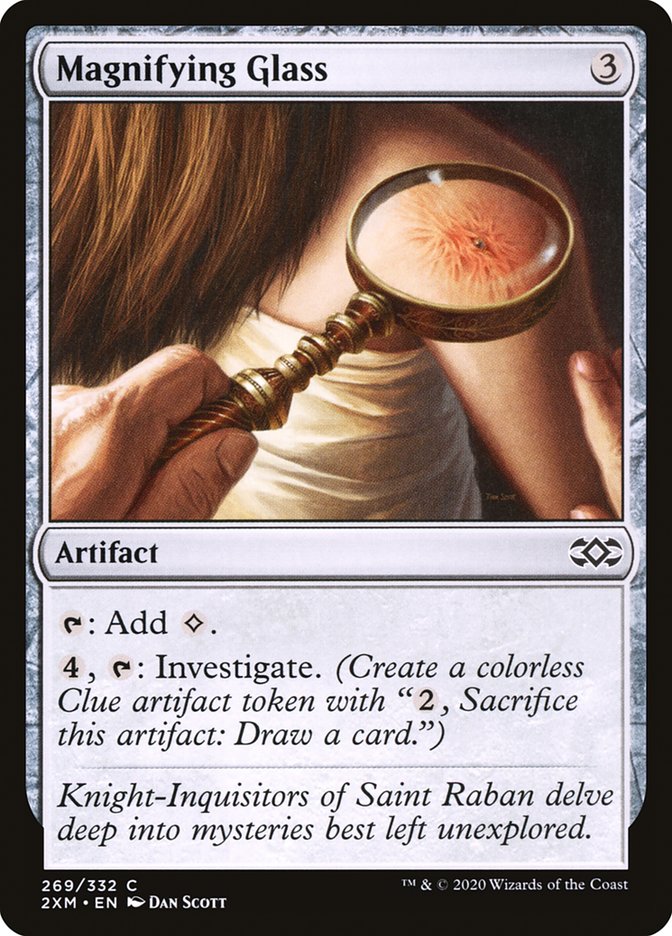
Rating: 3/10
The 3-mana mana rock with late game relevance isn’t that great for Limited, but Magnifying Glass proved itself in Shadows over Innistrad to be one of the best cards in that category. I don’t know how relevant it will be in this set, but it’s certainly a playable card.
Sanitation Automaton
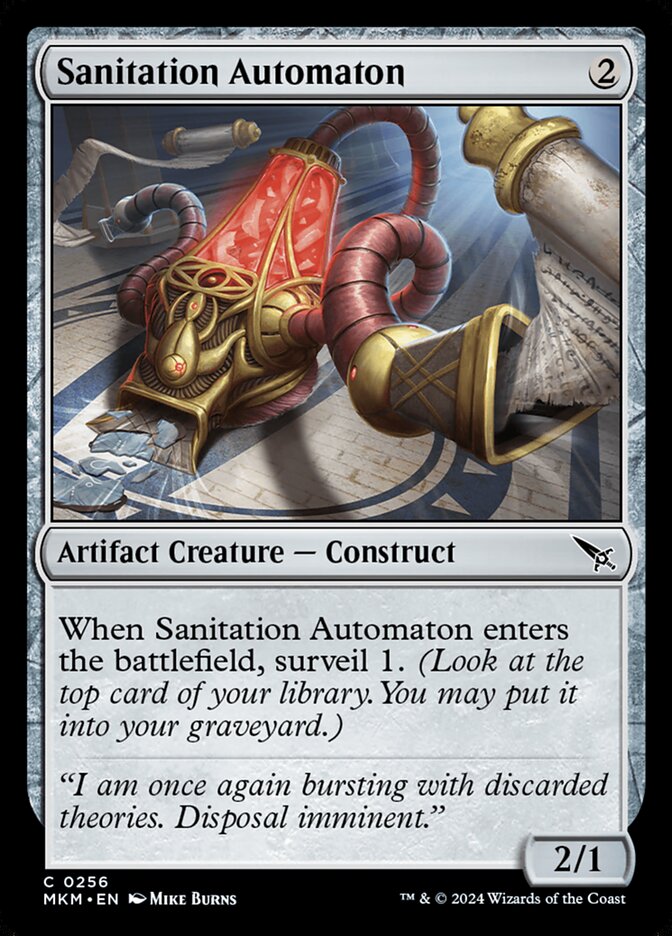
Rating: 2/10
Two-power creatures are very relevant in this set, so Sanitation Automaton actually looks okay. Not a high priority by any stretch, but in a pinch this could make it in your deck to fill out your curve, since it trades for disguises pretty nicely.
Thinking Cap
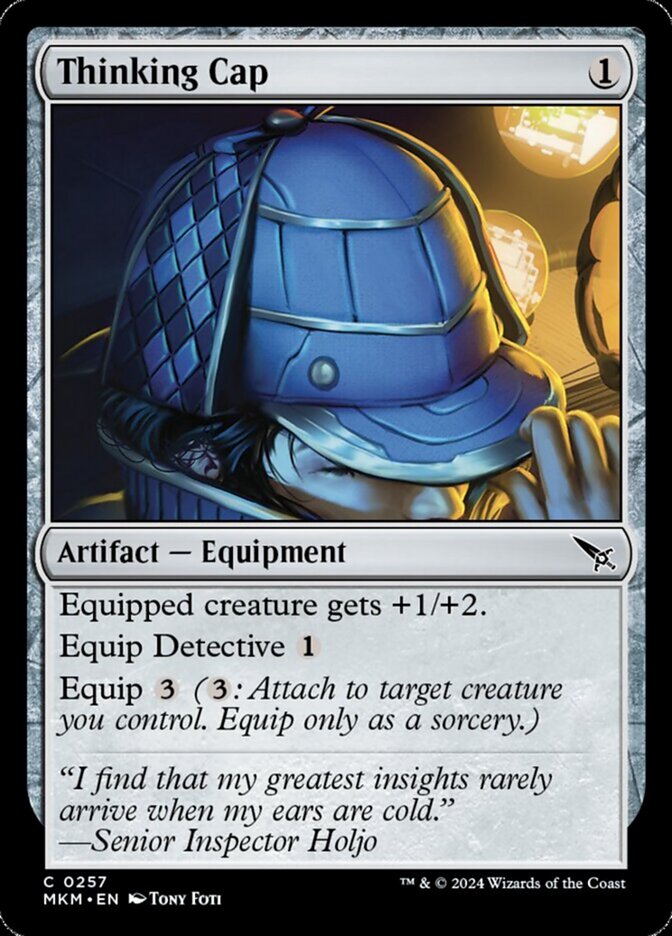
Rating: 2/10 Unless you’re equipping it to a detective, Thinking Cap is embarrassingly bad. Even then, it’s not all that good. It’s fine if you need an extra playable and have a ton of detectives, but I think the main reason you'll play this is if you have an Agency Outfitter in your deck.
Lands
Branch of Vitu-Ghazi
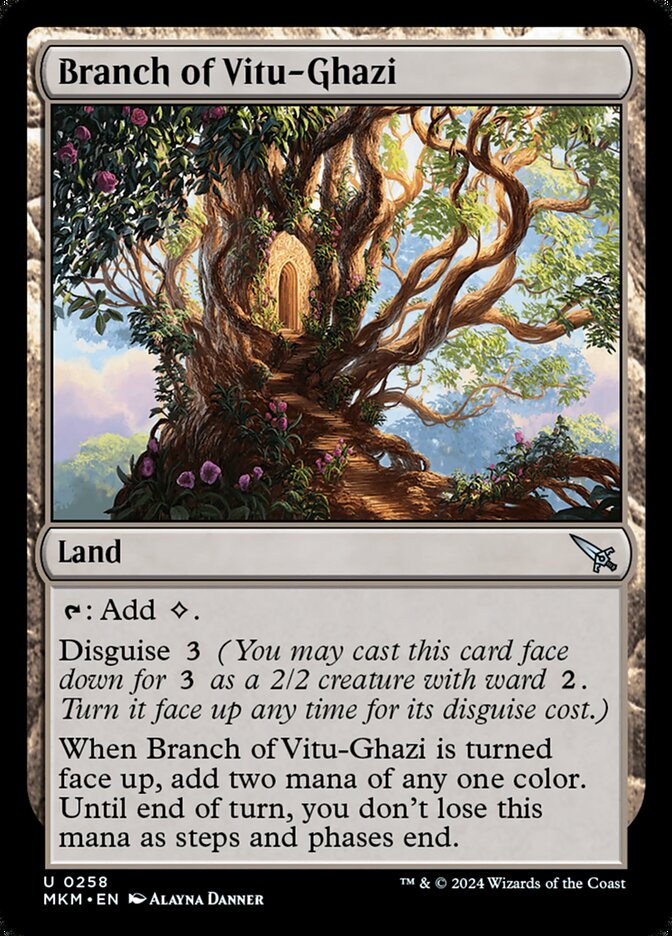
Rating: 3/10
Like I’ve said many times already, any disguise card is automatically playable. I think that Branch of Vitu-Ghazi is a fair bit better than the other weak ones we’ve seen, since hitting your land drops is so important. I don’t think I’d play this as one of my 17 lands, but as an 18th land it looks pretty strong, and you can always sink excess mana into flipping over your disguises.
The Surveil Lands
Rating: 4/10
Like in every set, dual lands settle around this level. If you’re in the color combination, they’re great to help you fix your colors, and otherwise you can avoid them. The surveil ability is very relevant, more so than having lands enter untapped, so I’d definitely play a couple of these if they were only in one of my colors, but I wouldn’t prioritize them in a draft.
Escape Tunnel
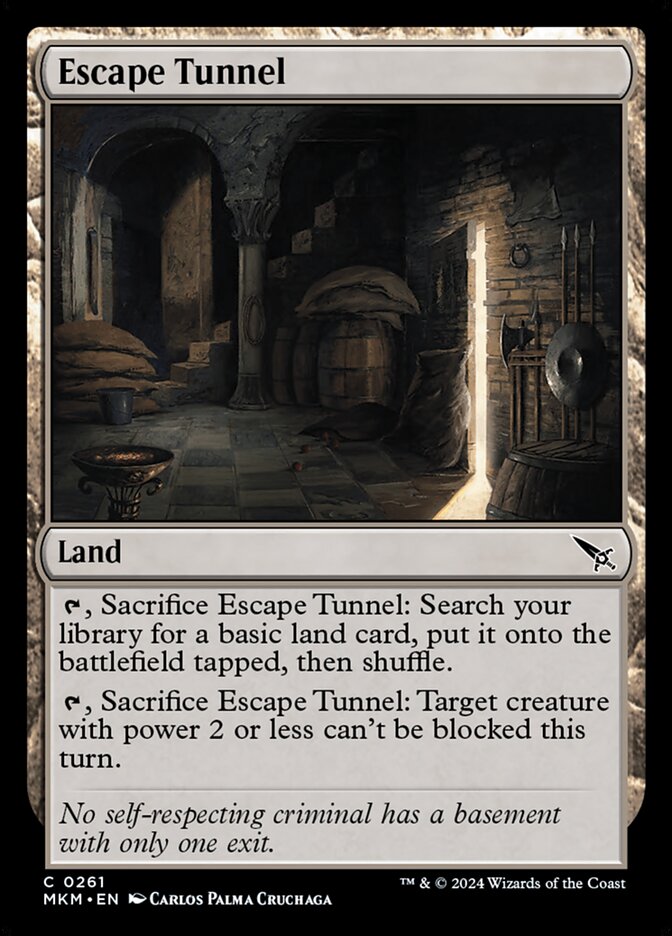
Rating: 4/10
I didn’t think we’d ever get a strict upgrade on Evolving Wilds, but here we are. Just like dual lands, you should probably play as many Escape Tunnels as you can but you never need to prioritize them in the draft portion.
Public Thoroughfare
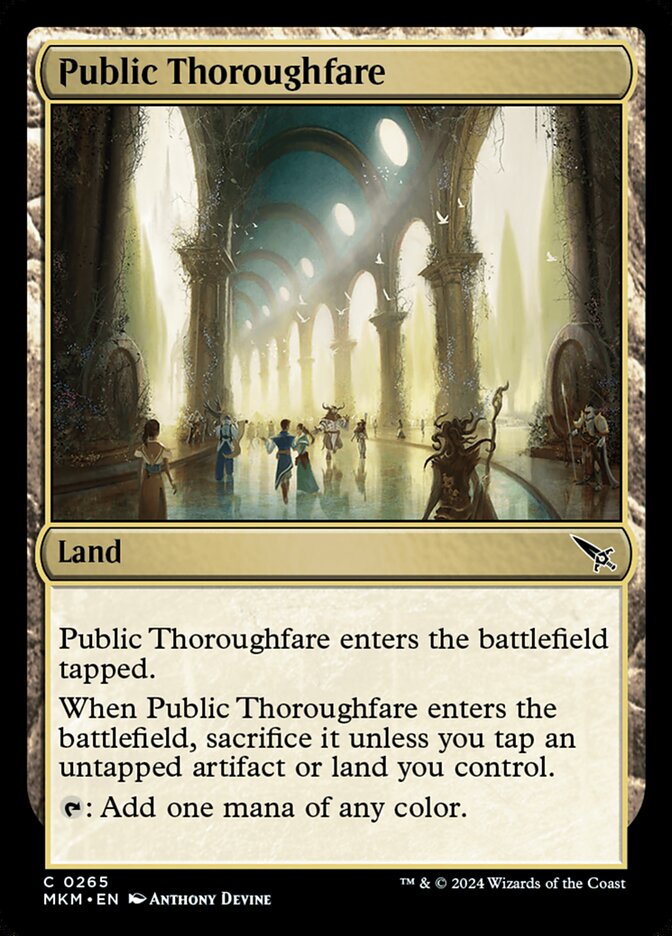
Rating: 3/10
While this is a small upgrade on the typical Rupture Spire design, it’s not enough to make it more playable. If you really want mana fixing, Public Thoroughfare does do that, but you shouldn’t have to prioritize it.
Scene of the Crime

Rating: 3/10
This artifact land doesn’t really function well as mana fixing, but as a colorless land that you can sacrifice to draw a card, it seems good. I’d probably prioritize picking up Scene of the Crime for the blue/red deck for synergy purposes, and outside of that, it will make the cut more often than not.
The List
With the addition of Play Boosters, there’s a small chance to open a card from the List in our booster drafts. As such, it seems prudent to look at all 40 of these cards and assess whether they help our decks. One important note here is that three of these cards are exclusive to abletop Play Boosters, so they’re replaced with three different cards on Arena.
Baleful Mastery (Tabletop Only)

Rating: 6/10
I don’t think you’re likely to want to pay the “student cost” for Baleful Mastery, but 4 mana to exile any creature or planeswalker is always going to be a good card. With only a single black mana symbol in its cost, it’s also highly splashable.
Bishop of the Bloodstained

Rating: 0/10
Without vampires being a dedicated archetype in the set, I don’t think Bishop of the Bloodstained is good enough. There are a few in the set, but I don’t think enough to make this a playable card.
Burden of Guilt

Rating: 3/10
A card like Burden of Guilt was clearly absent from Wilds of Eldraine’s pathetically bad tapping strategy. This is nice and cheap, but not a particularly strong removal spell on balance.
Cavalier of Thorns (Tabletop Only)
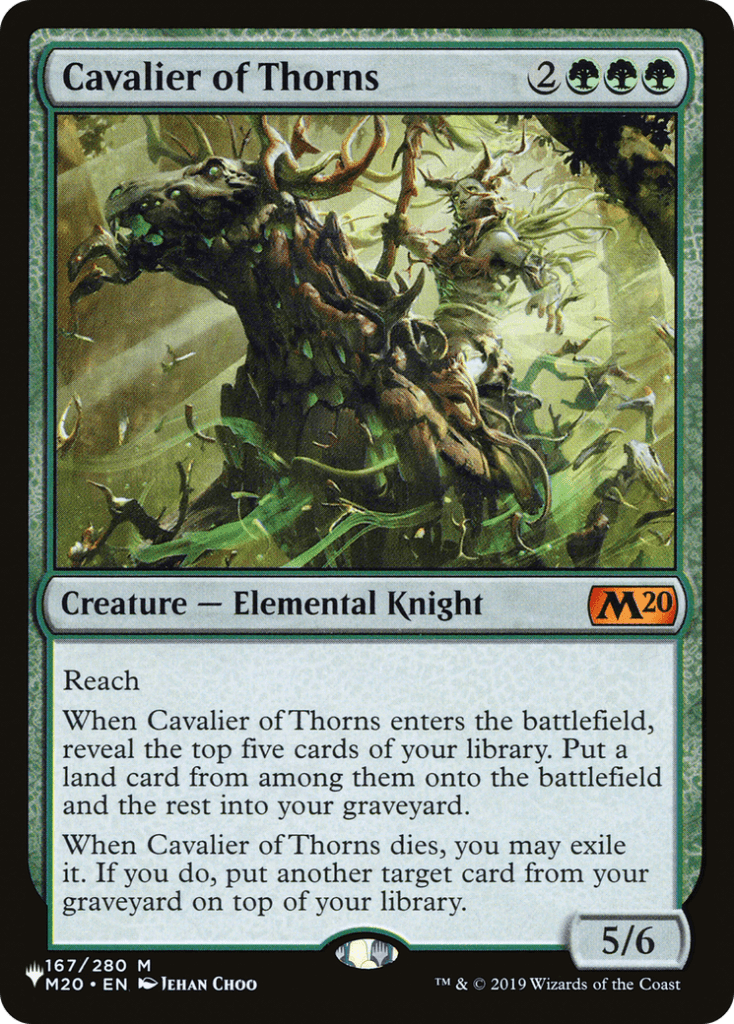
Rating: 9/10
Triple green isn’t trivial, but Cavalier of Thorns is perfectly situated in this format. It’s a massive threat that ramps you, but notably fills your graveyard for collect evidence payoffs, which is exactly what green is looking to do. You also get your best card back when it dies, so it’s really hard for any opponent to play against.
Combine Chrysalis

Rating: 5/10
Combine Chrysalis is a build-around that I wish I got to play more with, but I never got the chance to draft Modern Horizons 2. It does some good work in this set, as it should be easy enough to feed Clue tokens to it and turn them into 4/4 fliers.
Consign // Oblivion

Rating: 3/10
I’m always a fan of a bounce spell, and Consign // Oblivion definitely does that job well. But bounce spells aren’t that good in the first place and Oblivion is such a weak follow-up spell that this isn’t much better than a medium playable.
Death Cloud (Tabletop Only)

Rating: 0/10
Death Cloud can be a really powerful card, but only when you have large amounts of mana. It requires a ton of setup and basically requires your deck to be built to support it, which isn’t something you can really accomplish in Limited, so I think this is just bad and unplayable.
Duskmantle, House of Shadow
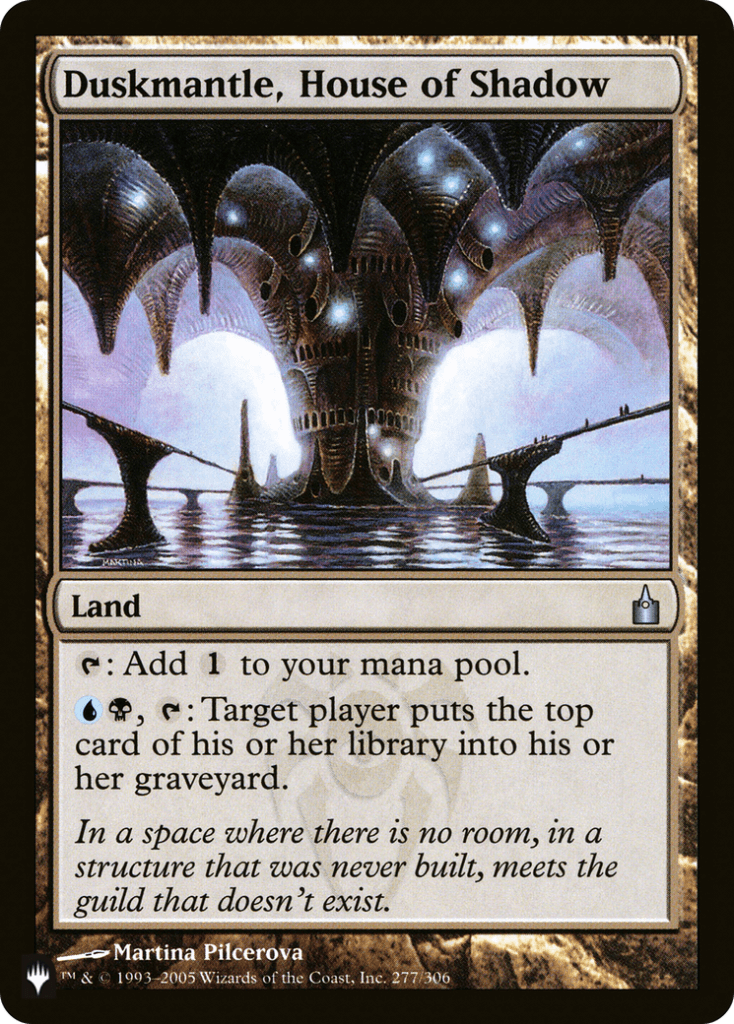
Rating: 0/10
If Duskmantle, House of Shadow were Nephalia Drownyard, then maybe we’d be on to something, but milling one card per turn is a joke and far too slow to be interested in it.
Enlisted Wurm

Rating: 6/10
Since you’ve played with discover cards in The Lost Caverns of Ixalan, I’m sure you’ll be very familiar with how broken that mechanic is. Of course, cascade is the same, so as long as the original spell is something that matters, you’re on to a winner, and Enlisted Wurm definitely qualifies.
Evolutionary Leap (Arena Only)

Rating: 0/10
Evolutionary Leap was a real powerhouse when it was legal in Standard, but it doesn’t stack up in Limited. In Standard, it could be built around, but you can’t do that here and it’ll just fall short of playable.
Ghost Quarter
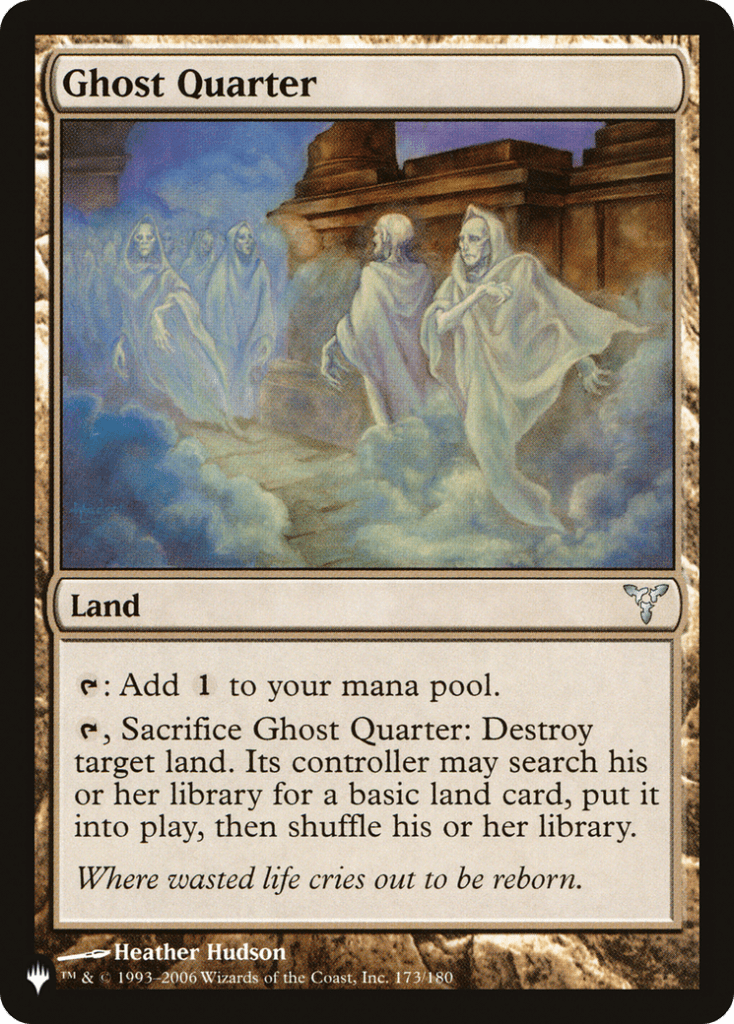
Rating: 0/10
Ghost Quarter is a strong answer to a category of card that you just don’t care about in Limited, so there’s never a reason to play it.
Gnaw to the Bone
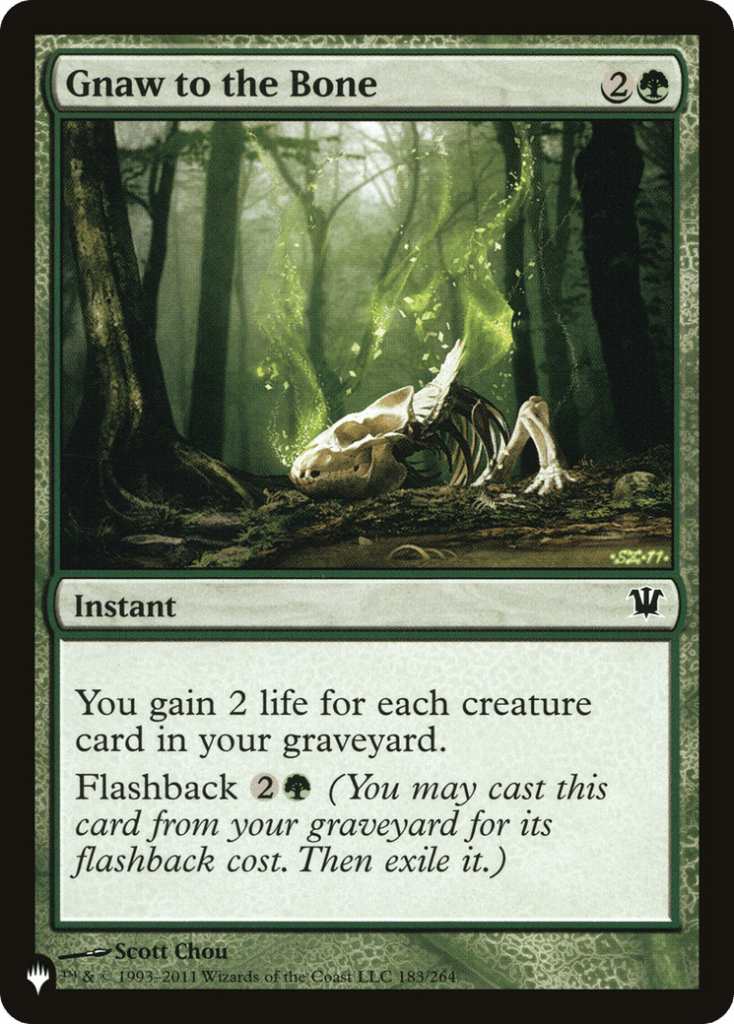
Rating: 1/10
Gnaw to the Bone was a strong card in Innistrad, as self-mill strategies could often gain 10-20 life with it and stay alive for much longer. I don’t think that’s going to be very possible here, though it could be a powerful sideboard card in the right matchup.
Goblin Warchief
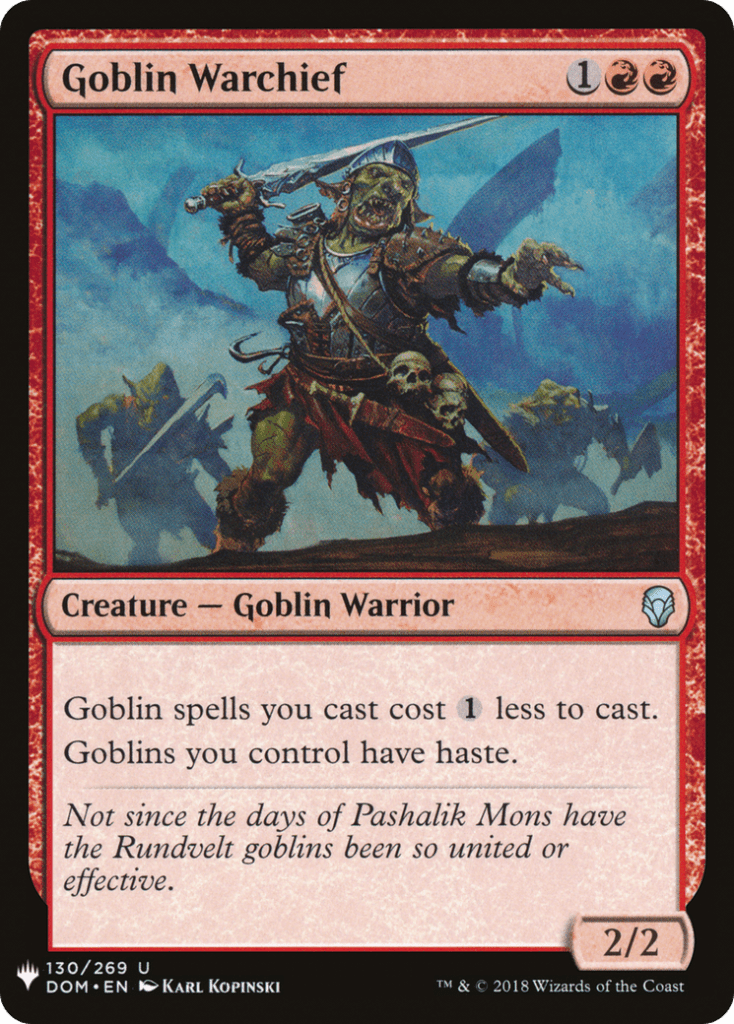
Rating: 1/10
There are a few goblins in this set, but haste and a cost reduction aren’t abilities we care all that much about in a Limited environment. If Goblin Warchief gave +1/+1 or something similar, then great, but as it stands, this is little better than an overcosted 2/2 with haste.
Hard Evidence
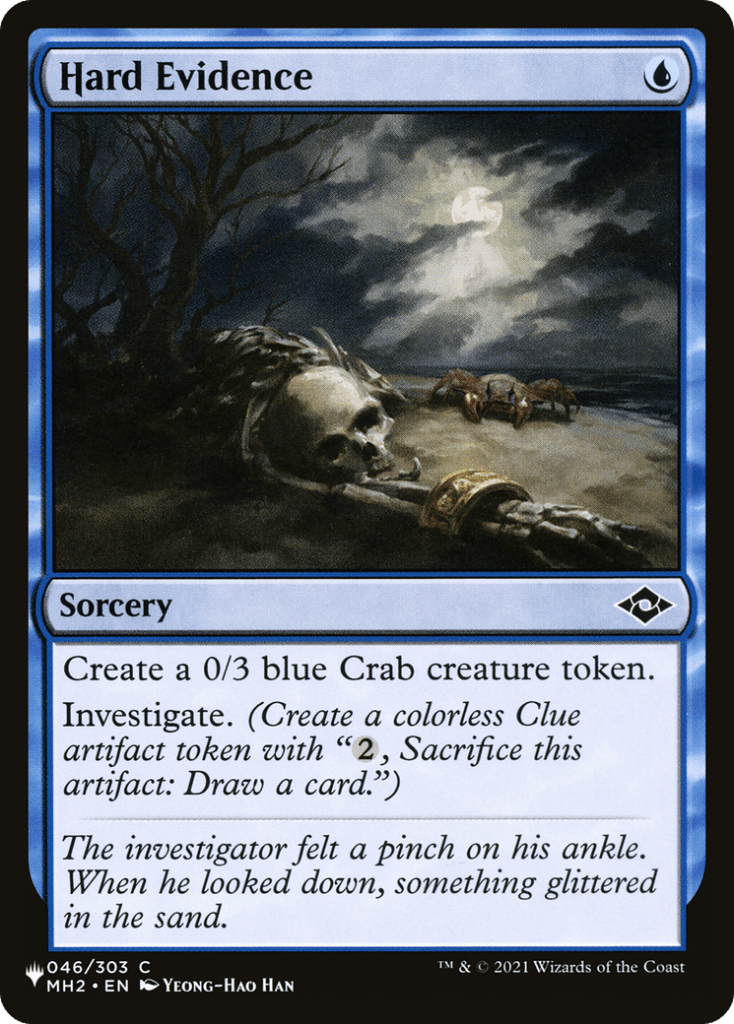
Rating: 5/10
It’s not quite as good as Thraben Inspector, but Hard Evidence is still a very strong play that most blue decks should be happy to see. A 0/3 is also a very relevant blocker in this format, what with all the 2/2 disguised creatures about, so this should really pull its weight.
High Alert
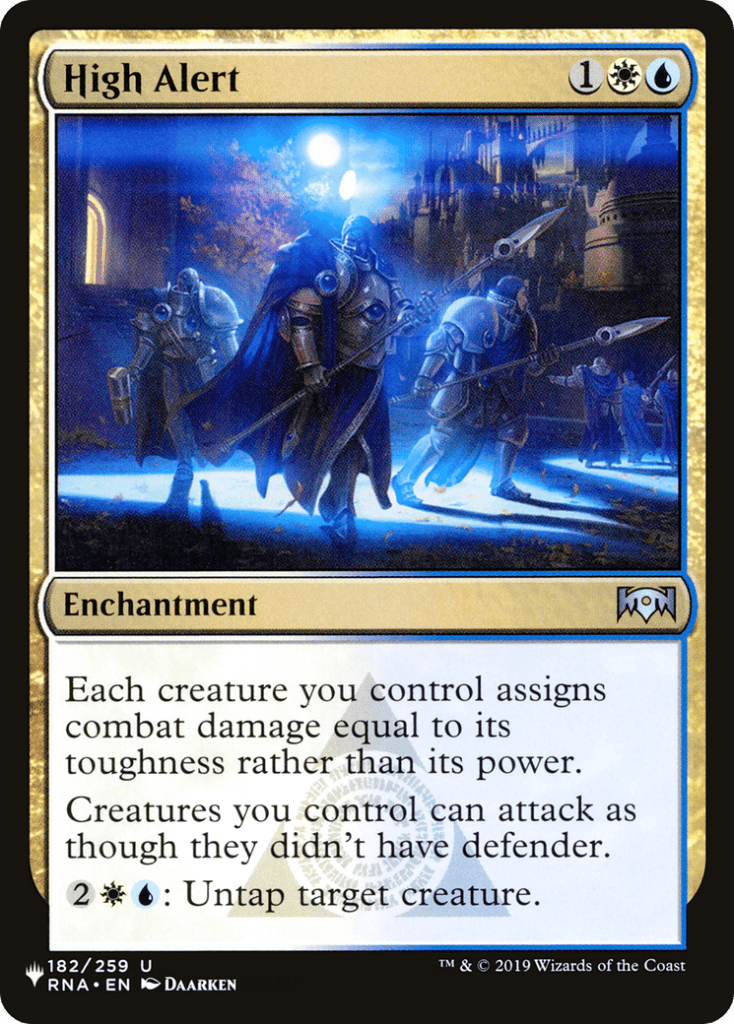
Rating: 1/10
I loved building High Alert decks in Ravnica Allegiance, but I don’t think this set is made to do it. But hey, we’re dreamers aren’t we? Essence of Antiquity and The Pride of Hull Clade are calling out to me, and this is exactly the kind of wacky card that I’d love to pair them with and have a laugh.
Ixidor, Reality Sculptor
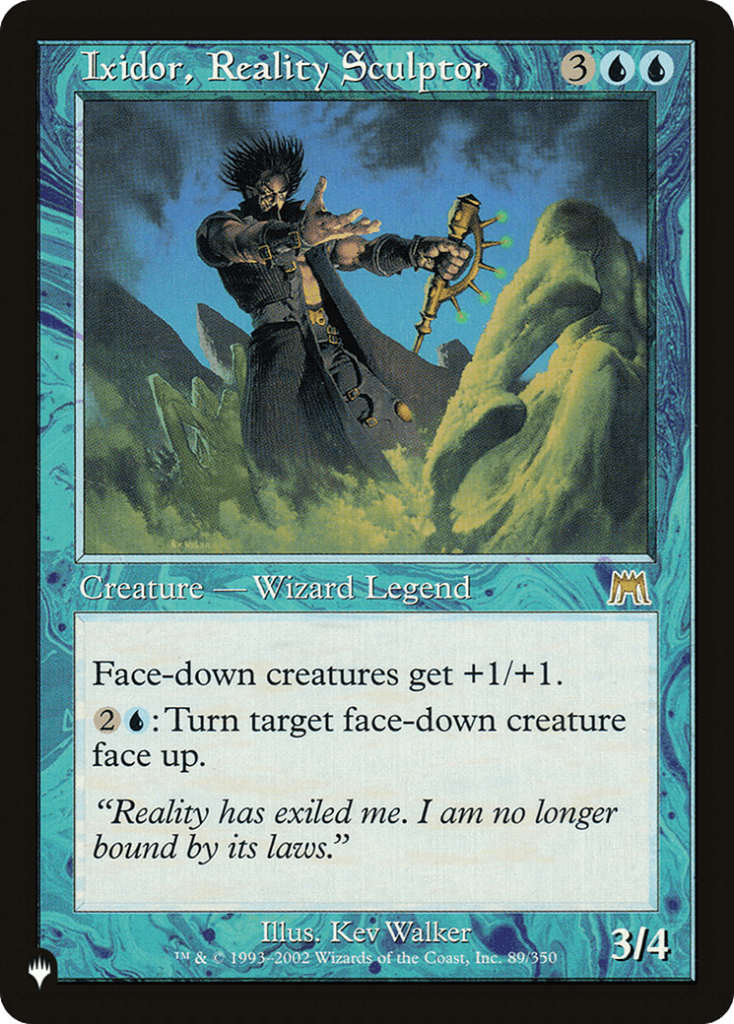
Rating: 7/10
Ixidor, Reality Sculptor looks like a really sweet build-around card that pays you off massively for playing disguise/cloak deck. Casting disguise creatures on turns 3 and 4 with this on turn 5 is a powerful sequence of plays that lets you press your advantage early and build up to some very dirty plays later, thanks to being able to turn anything face up for 3 mana.
Jace, Wielder of Mysteries
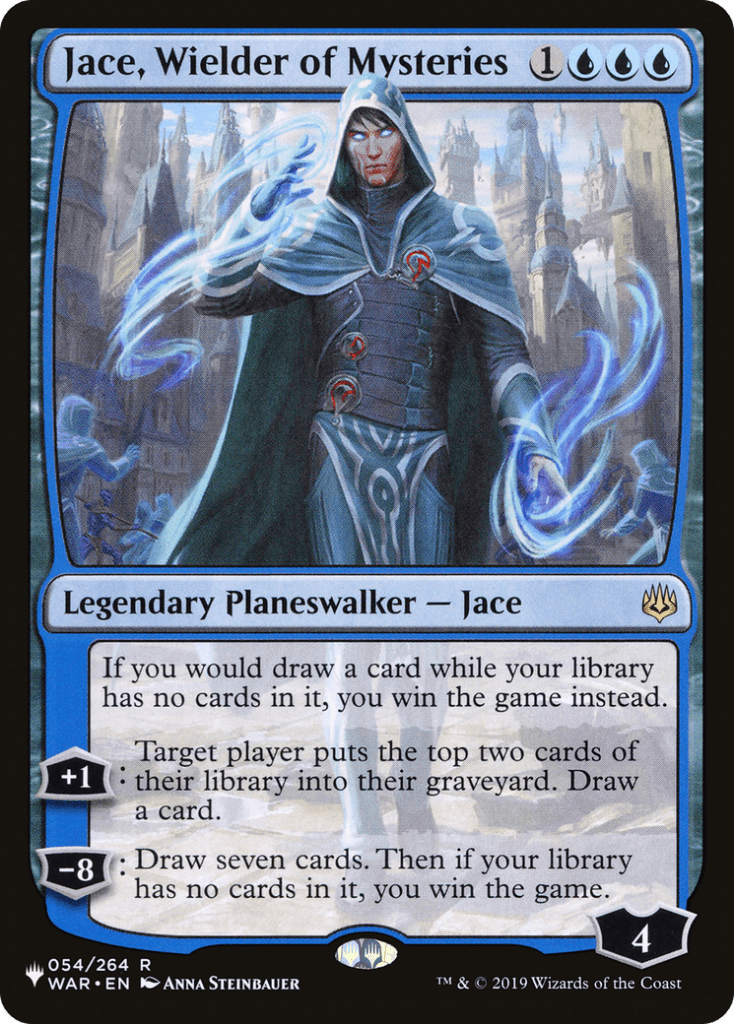
Rating: 4/10
Jace, Wielder of Mysteries is a powerful enabler for self-mill strategies, which apparently exist in this set. However, not affecting the board in any meaningful way, as well as being very difficult to cast, really limits just how powerful this particular planeswalker can be.
Krosan Tusker
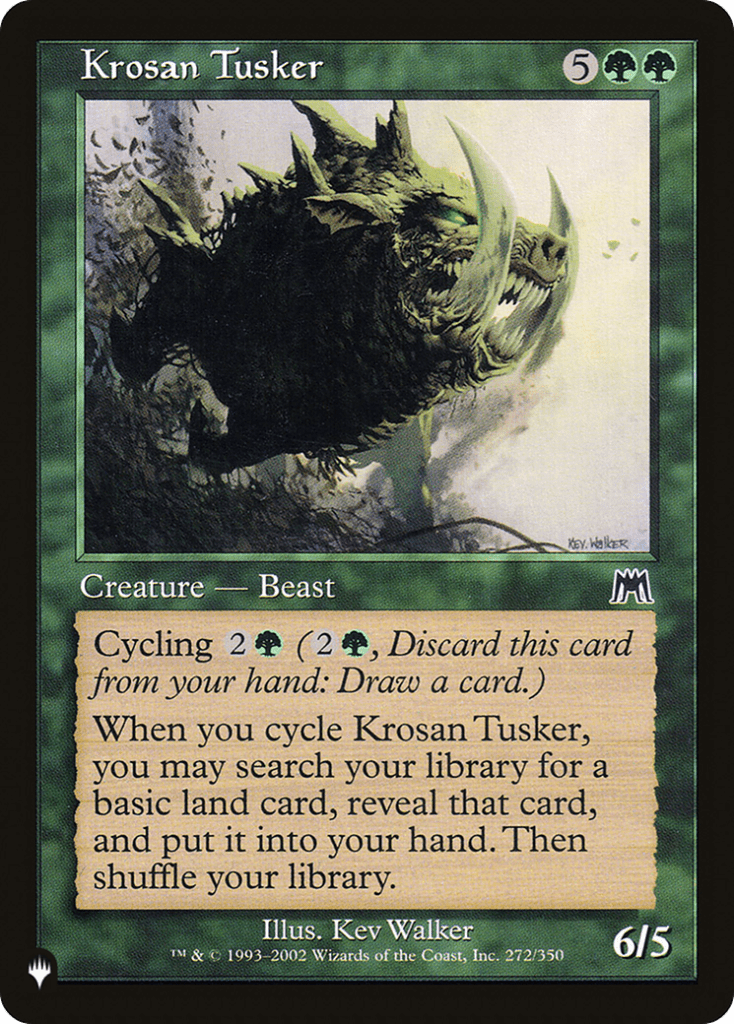
Rating: 6/10
Krosan Tusker is basically a green Divination with upside. It’s so powerful to cycle this in the early game and fix your mana, but also be able to come down as a 6/5 in the late game. We’ve had a lot of landcyclers in recent sets, and this is much better than all of them. It’s definitely possible that modern Limited sets are a little more hostile to a card like this, but it should still be great to pick up when you see it.
Kuldotha Rebirth
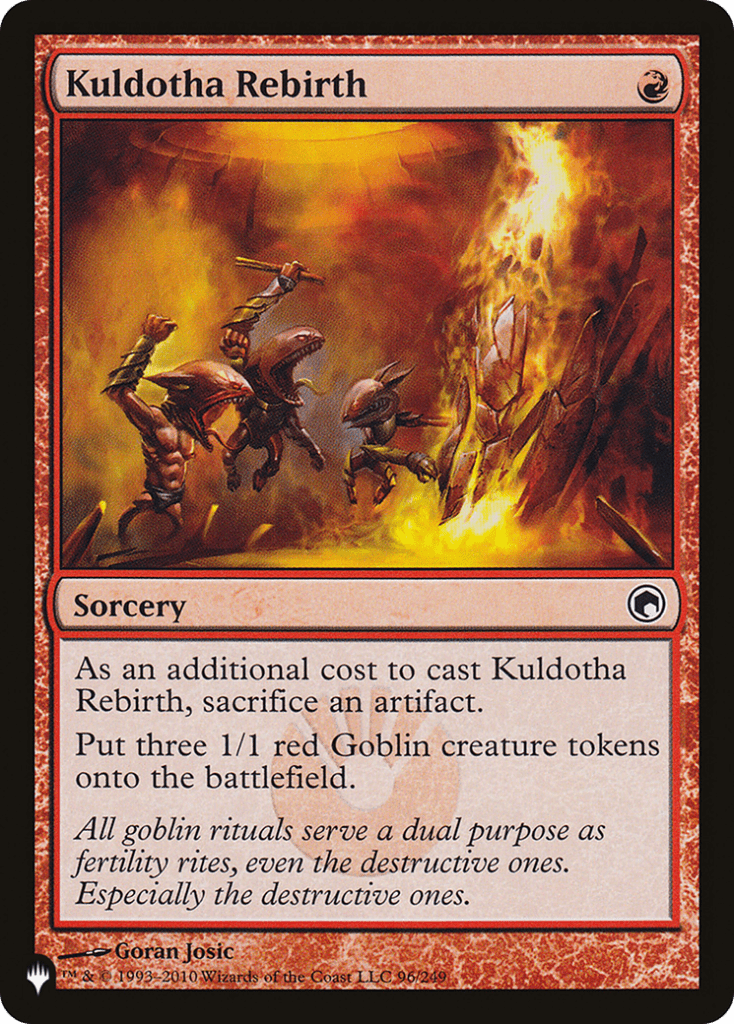
Rating: 3/10
Kuldotha Rebirth isn’t a particularly strong card, but there’s an archetype that wants you to sacrifice artifacts, so it’s definitely possible for this to find a home in that deck.
Laid to Rest
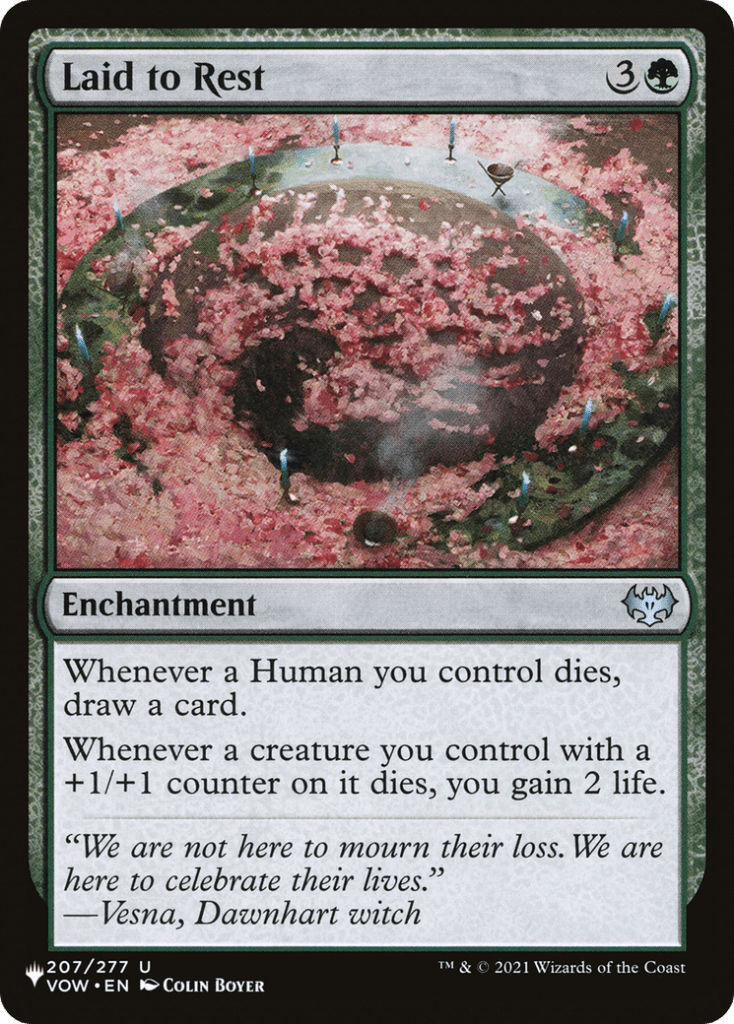
Rating: 0/10
I remember slating Laid to Rest when it was in Innistrad: Crimson Vow, despite other reviewers saying it looked great. It ended up being terrible and virtually unplayable. Presumably it still is.
Leonin Relic-Warder

Rating: 5/10
Leonin Relic-Warder has been an exceptionally good card when we’ve seen it in the past, though that has been in sets with a focus on artifacts. That’s not the case here, but there are still a lot of good artifacts to hit, and you can always exile a Clue token to essentially have your opponent lose a card with no downside on your end.
Magmaw
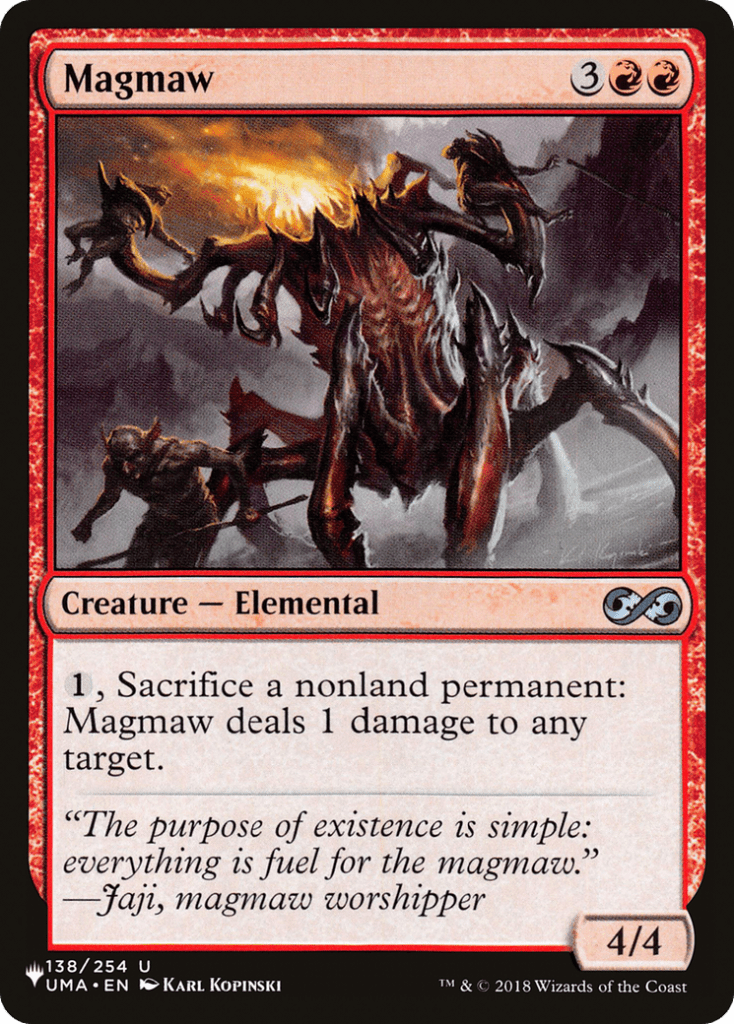
Rating: 6/10
Magmaw is a pretty beastly sacrifice outlet, allowing you to sacrifice nearly anything and shoot any target. Given the setting for this, if you have enough clues lying around, this should pop off really nicely.
Mass Hysteria

Rating: 0/10
Mass Hysteria just isn’t worth spending a whole card on. Even worse, sometimes it even works against you, which sounds exactly like something I don’t want to be a part of.
Maverick Thopterist
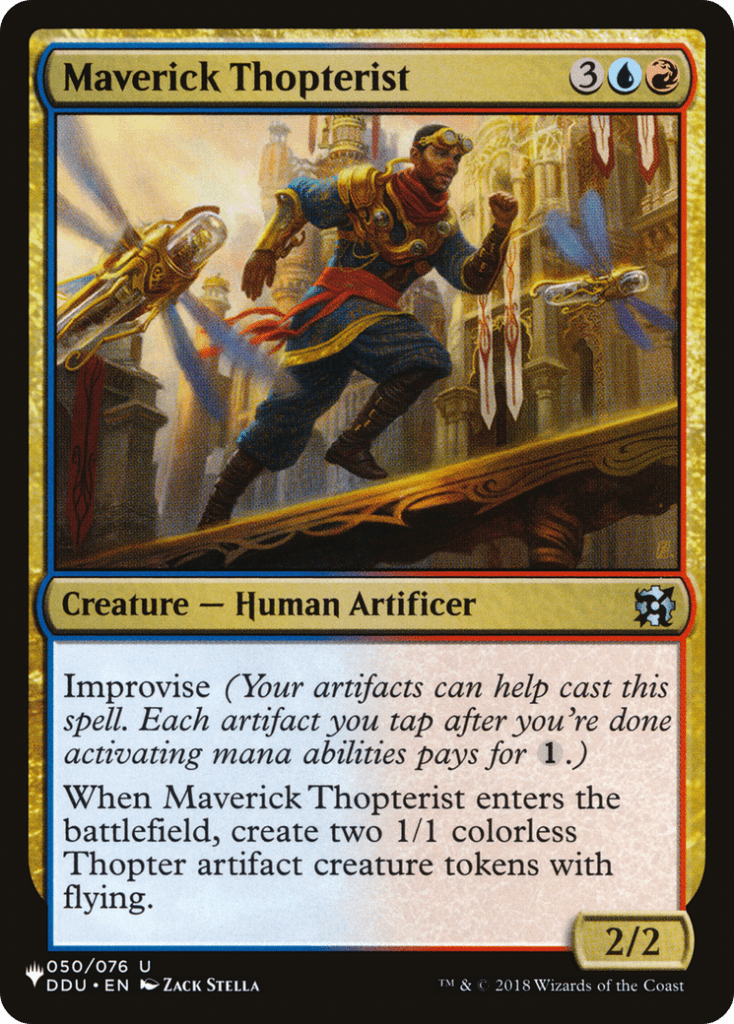
Rating: 7/10
Five mana for a 2/2 and two 1/1 fliers is a great deal. Improvise isn’t even necessary, but the availability of Clue tokens makes it a very real upgrade. I’d definitely splash for this and would slam it if I was already in blue/red.
Mentor of the Meek
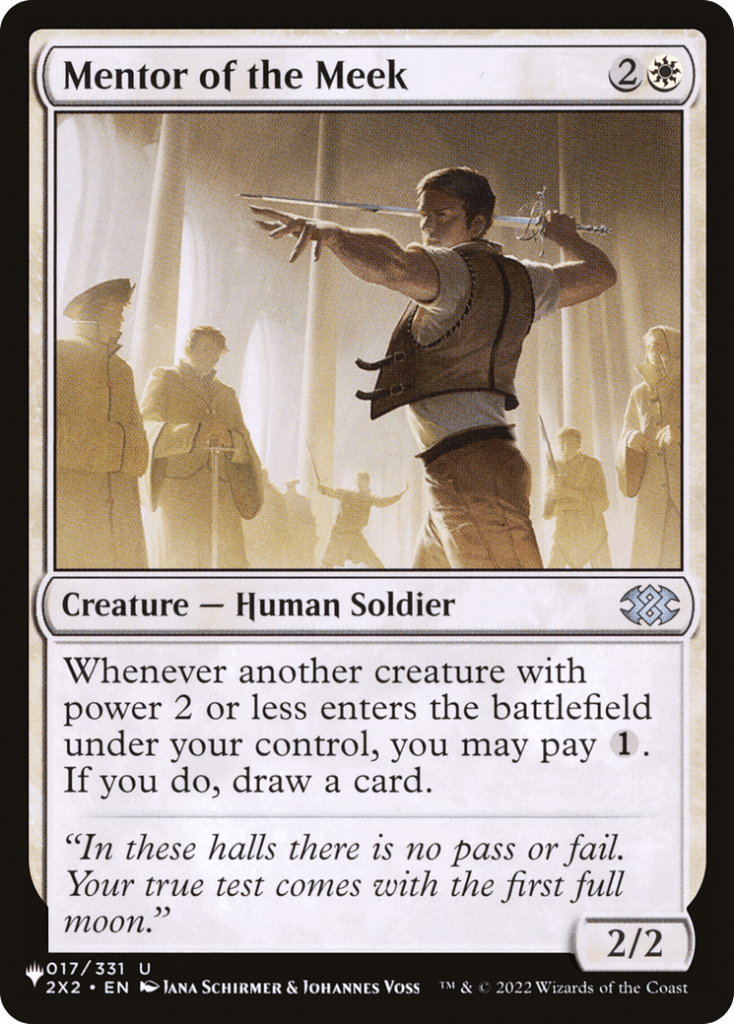
Rating: 8/10
Mentor of the Meek has always been a powerful card that just needs a home. Thanks to disguise and cloak, it definitely has a home here in any white deck. Particularly in the black/white archetype that focuses on 2-power creatures.
Metalspinner’s Puzzleknot
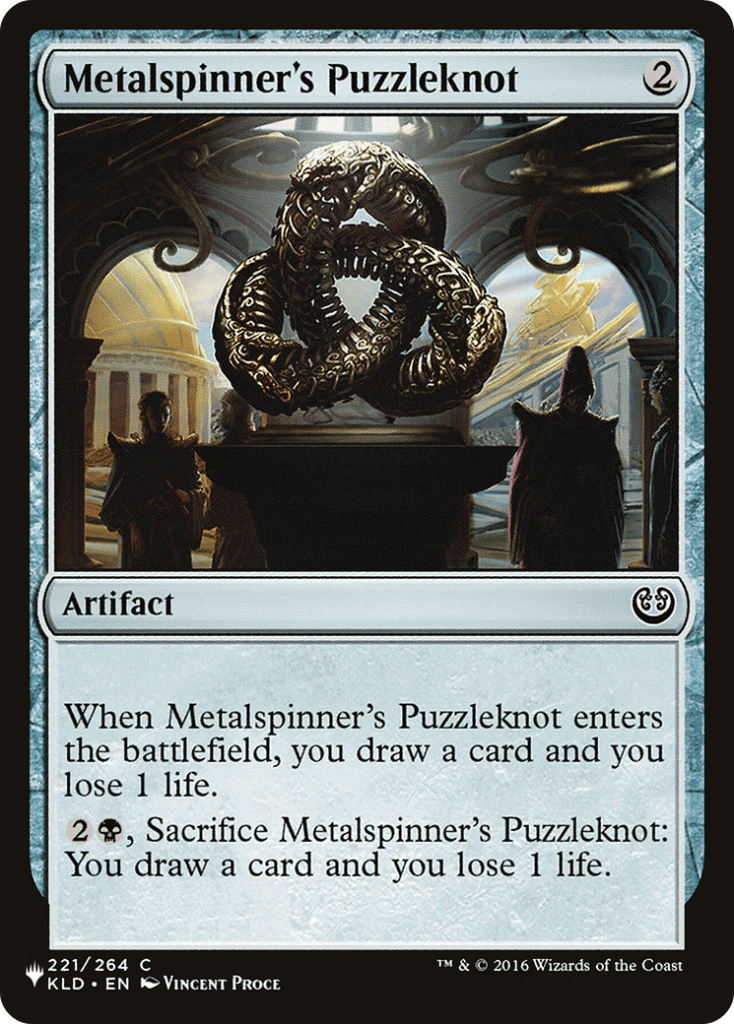
Rating: 3/10
This isn’t quite Mephitic Draught, but Metalspinner's Puzzleknot is certainly a card that can be useful in the right deck. Even if there isn’t a specific home for it, it still draws you two cards total, so it’s still fine in any black deck, just so long as you’re not too aggressive.
Millstone
Rating: 1/10
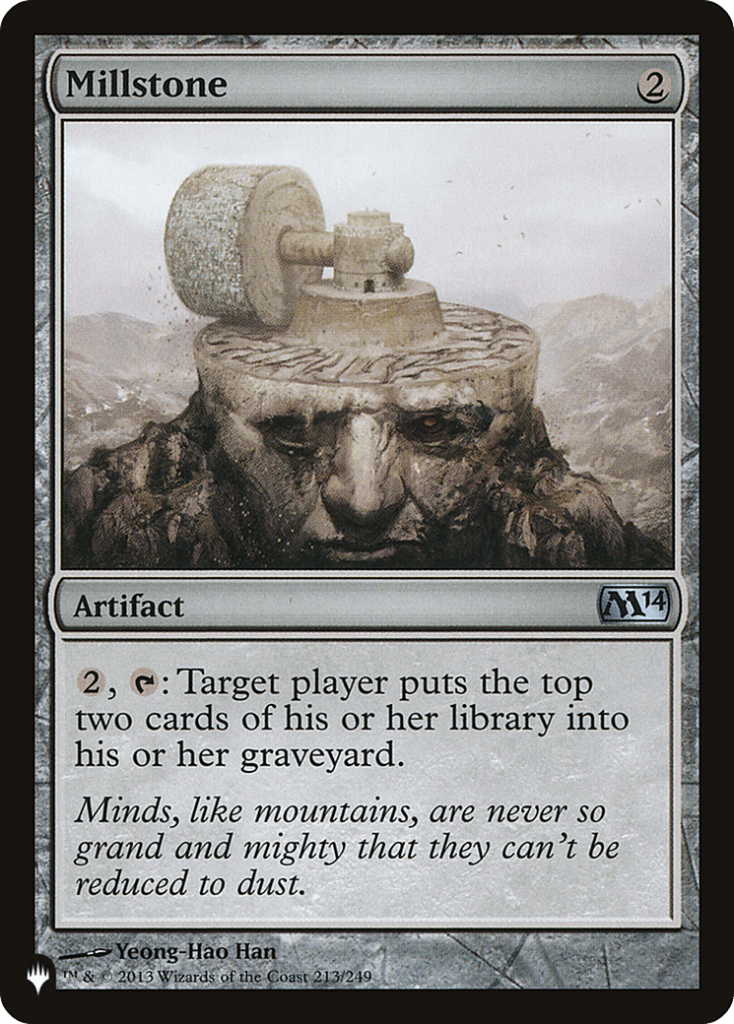
It might be reasonable to side Millstone in against a really slow deck, or against self-mill decks that get a little too greedy, but other than that, this classic card just doesn’t cut it.
Mistveil Plains
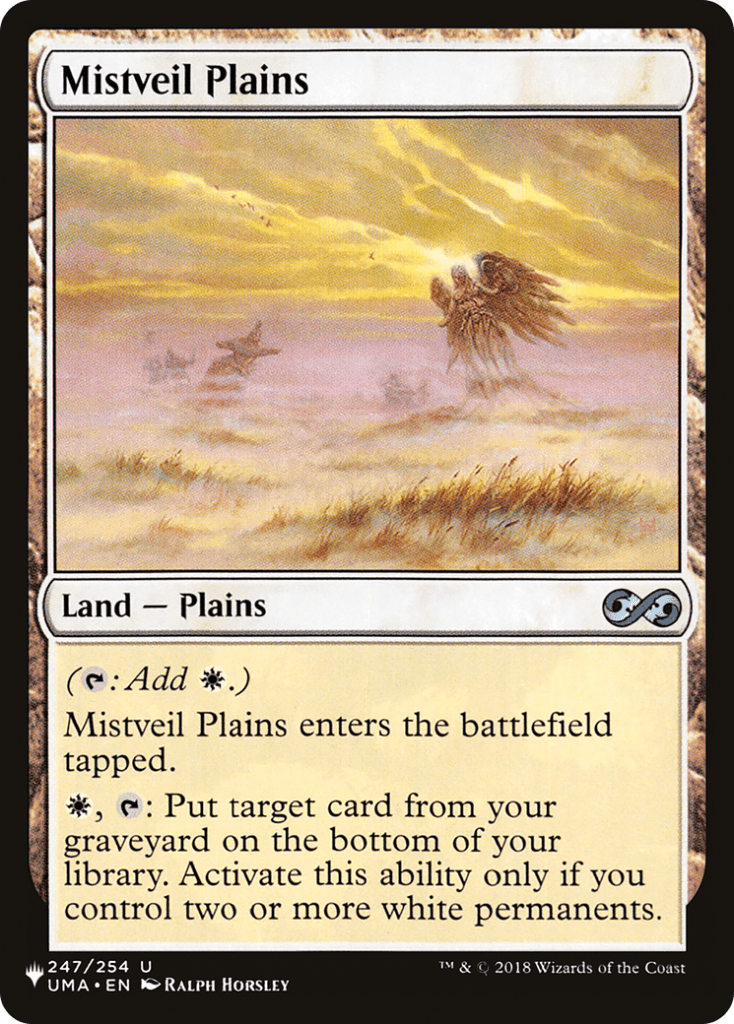
Rating: 0/10
Entering the battlefield tapped is a big downside. Your land needs to have an upside to counteract that, but Mistveil Plains comes from a cycle with the weakest upsides imaginable, which doesn’t exactly make it any good.
Molten Psyche
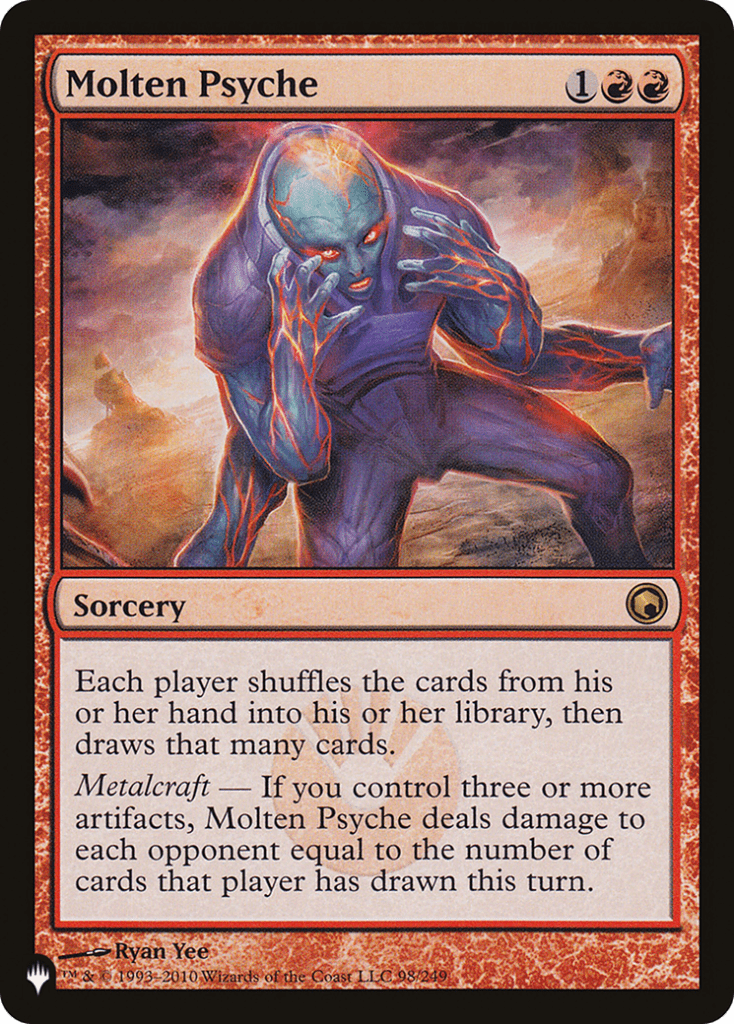
Rating: 0/10
The problem with Molten Psyche is that it puts you down a card right away. It’s also not an inherently good effect. Even if you can get to metalcraft, at that point in the game, players aren’t going to have all that many cards in hand, so it’s not even useful as a finisher.
Monologue Tax
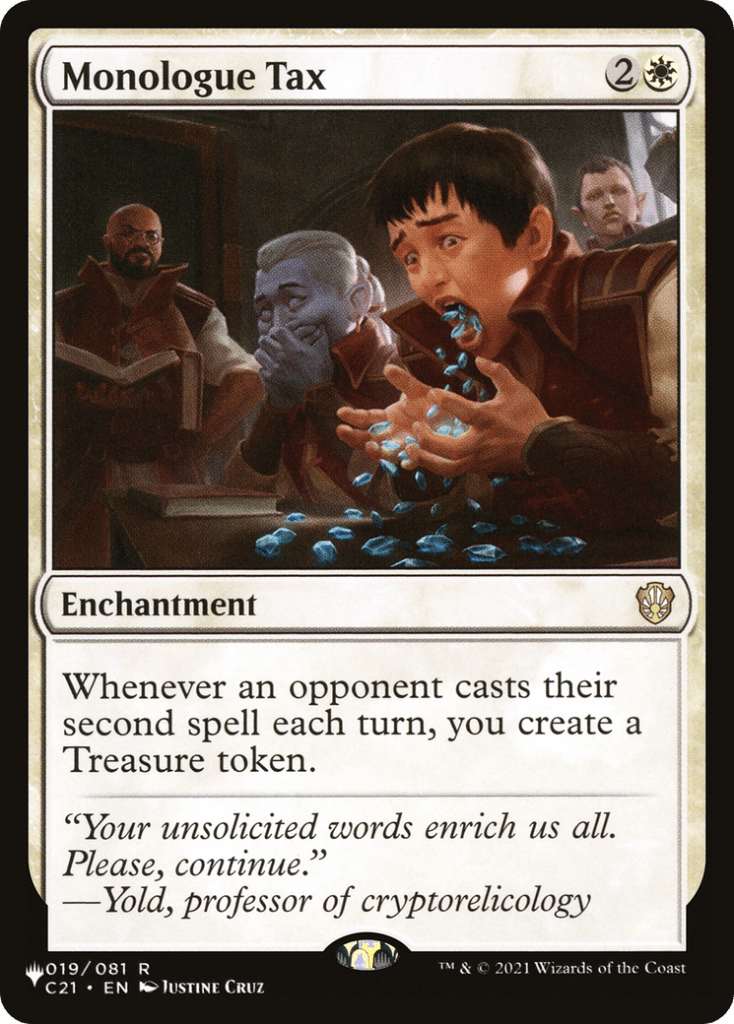
Rating: 0/10
I have to spend 3 mana and a whole card, and it does nothing? Then, if my opponent casts two spells, I get a Treasure? Can I not just have my 3 mana and a card back? Monologue Tax is atrociously bad. But apparently some Commander players like it, so it’s worth some money I guess?
Mystery Key
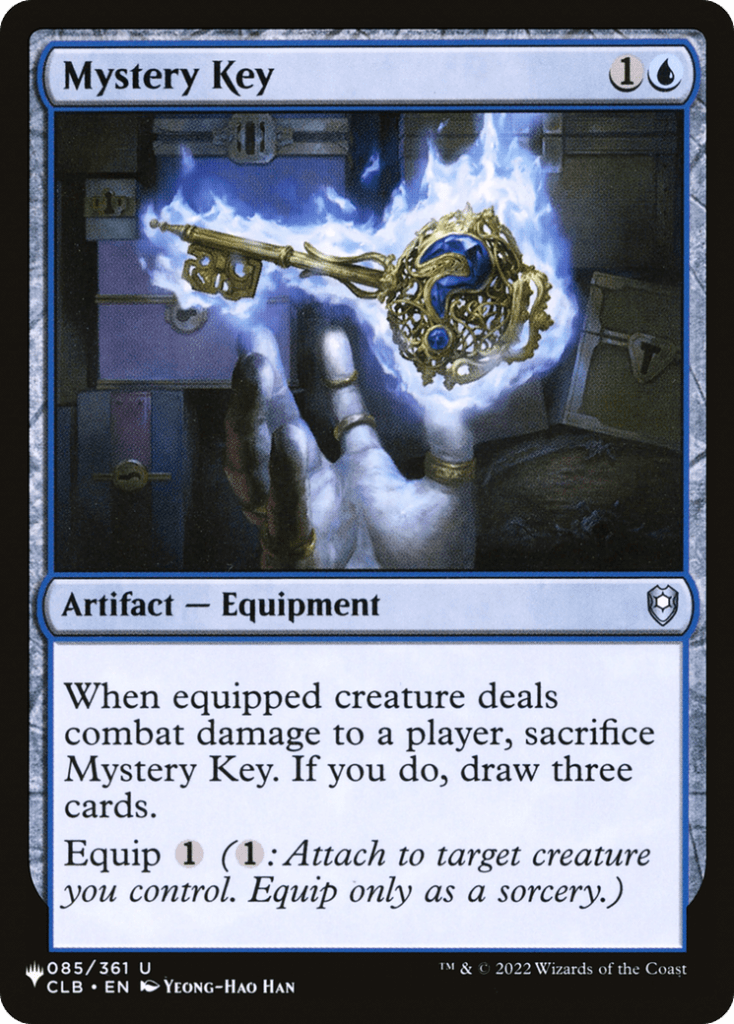
Rating: 6/10
Drawing three cards for such little investment is something I’m very interested in. The obvious synergy is that you want to pair Mystery Key with flying creatures, but it also just encourages your opponent to block, which could also be advantageous for you. You equip this to a 3/3, and all they have is a 2/2, so are they going to let you through? Maybe, maybe not. I like that this has a big payoff as well as some hidden payoffs that you could make use of, too.
Nyx Weaver
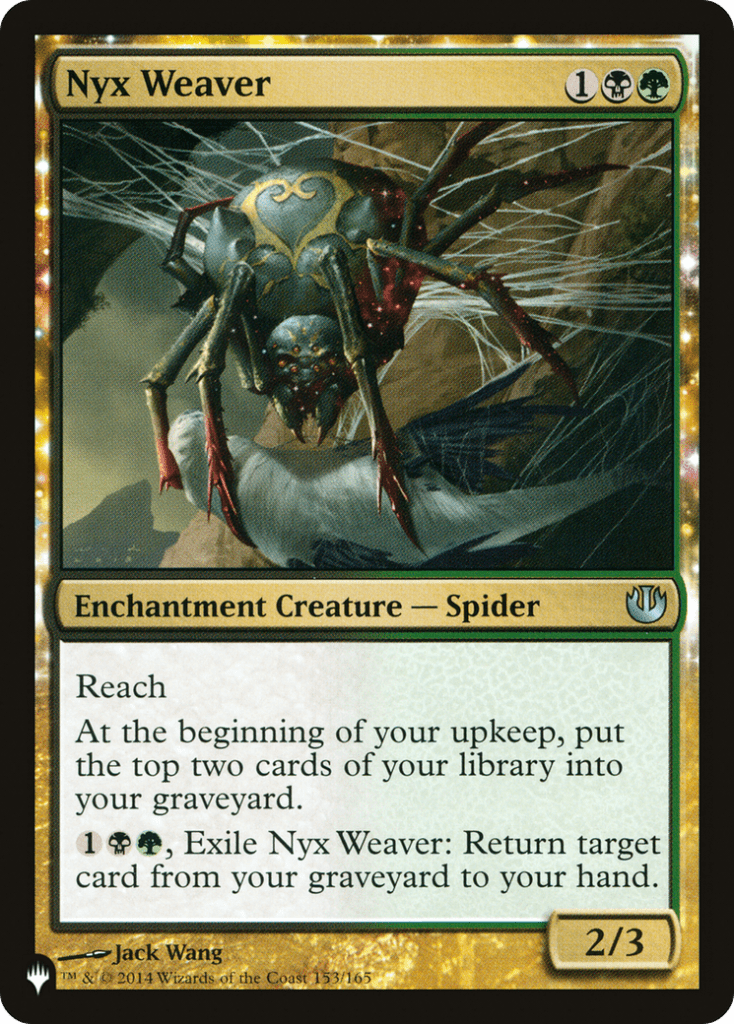
Rating: 5/10Nyx Weaver is a very nice package just by itself, but black/green is supposed to be self-milling in this set, so I assume this will be useful in a lot of decks, and it’s potentially worth splashing if you’re in blue/green.
Possibility Storm (Arena Only)
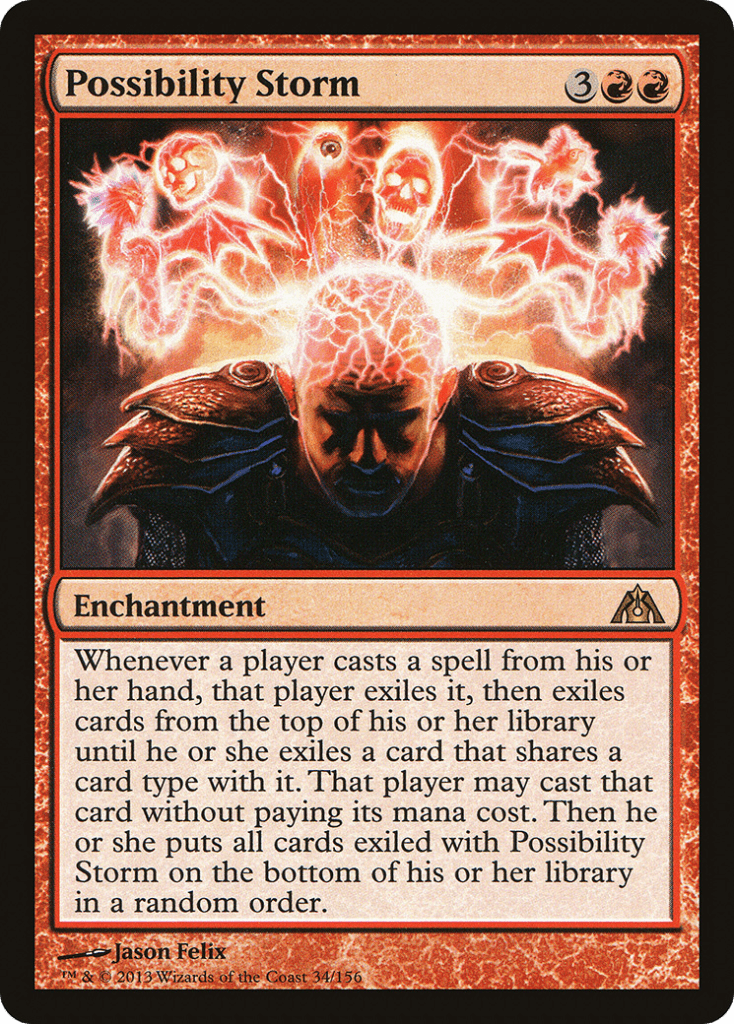
Rating: 0/10
Possibility Storm has some wacky interactions, but you can’t afford to spend 5 mana on an enchantment that doesn’t do anything. It randomizes spells for the rest of the game, which could help you, but it could also hinder you just as easily, so I wouldn’t bother with it.
Putrid Warrior

Rating: 2/10
Putrid Warrior is a weird common, but it’s a 2/2 for two, which isn’t bad. The trigger seems very relevant, especially as it triggers whenever it deals damage to anything, but it’s still not much more than a filler creature.
Quintorius, Field Historian

Rating: 4/10
My boy Quint had a rough time of it in Strixhaven. The Lorehold theme was hot garbage, and Quintorius, Field Historian just didn’t do anything. Here on Ravnica, we have some spirits to buff, and we have a mechanic that removes cards from the graveyard. Quint still isn’t all that powerful, but there does seem like there are some good synergies that you can utilize with it.
Ranger-Captain of Eos
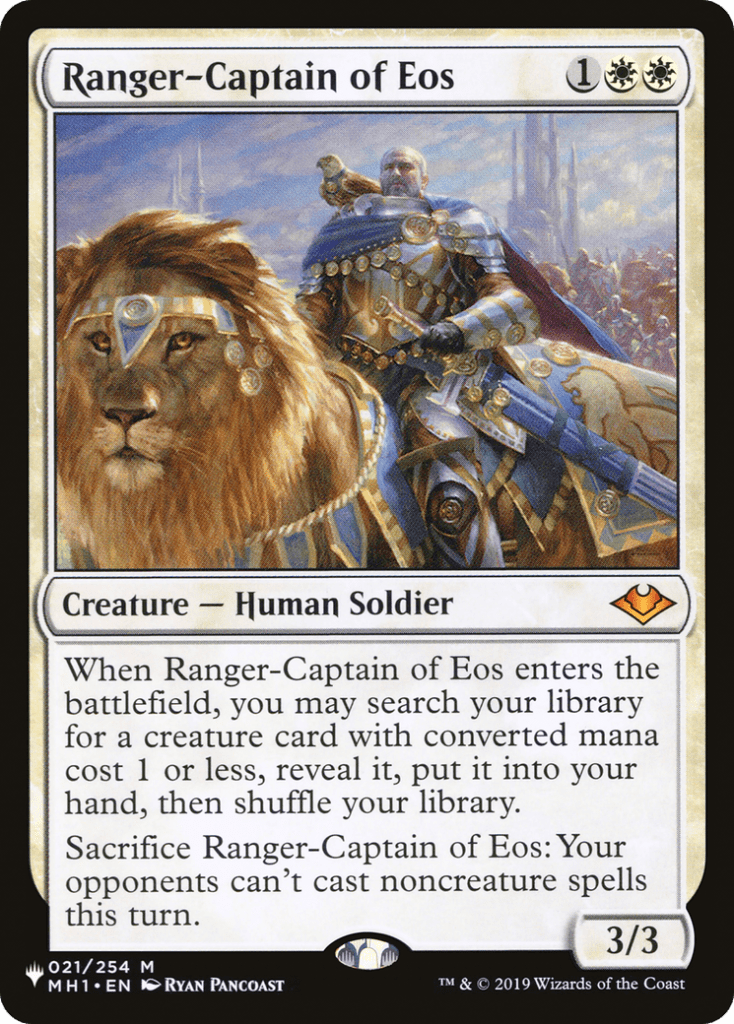
Rating: 6/10
Ranger-Captain of Eos is a staple of Eternal formats and funnily enough, one of its potential targets is in this set, thanks to the printing of Novice Inspector. Assuming you have a couple of good 1-drops to go get, this is a great card. Oh, it’s also worth $30+, so there’s also that.
Shard of Broken Glass
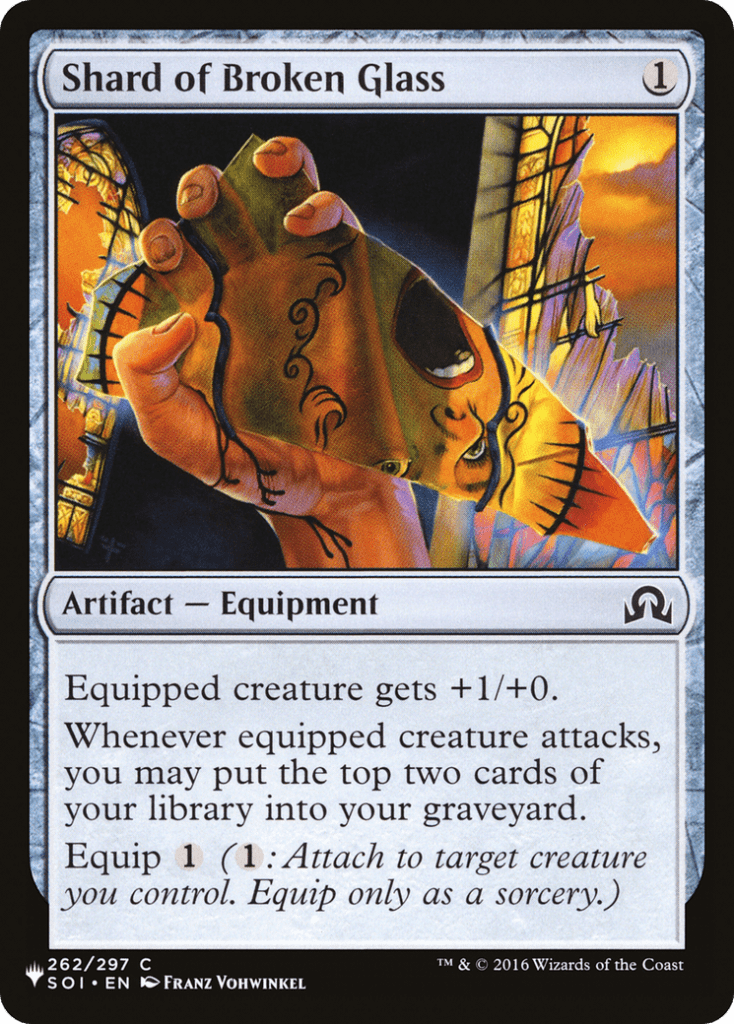
Rating: 0/10
Even if you want to mill yourself, there are surely much better ways of doing it than with Shard of Broken Class. Just useless equipment.
Smuggler’s Copter (Arena Only)
Smuggler's CopterRating: 10/10
What needs to be said about the looter scooter? The vehicle goes in any deck, can attack as early as turn 3, draws you into your best cards, gets crewed by basically anything, and even draws you cards when it blocks. There’s just nothing bad about Smuggler's Copter, and it can put you incredibly far ahead if you draw it early.
Spell Snare
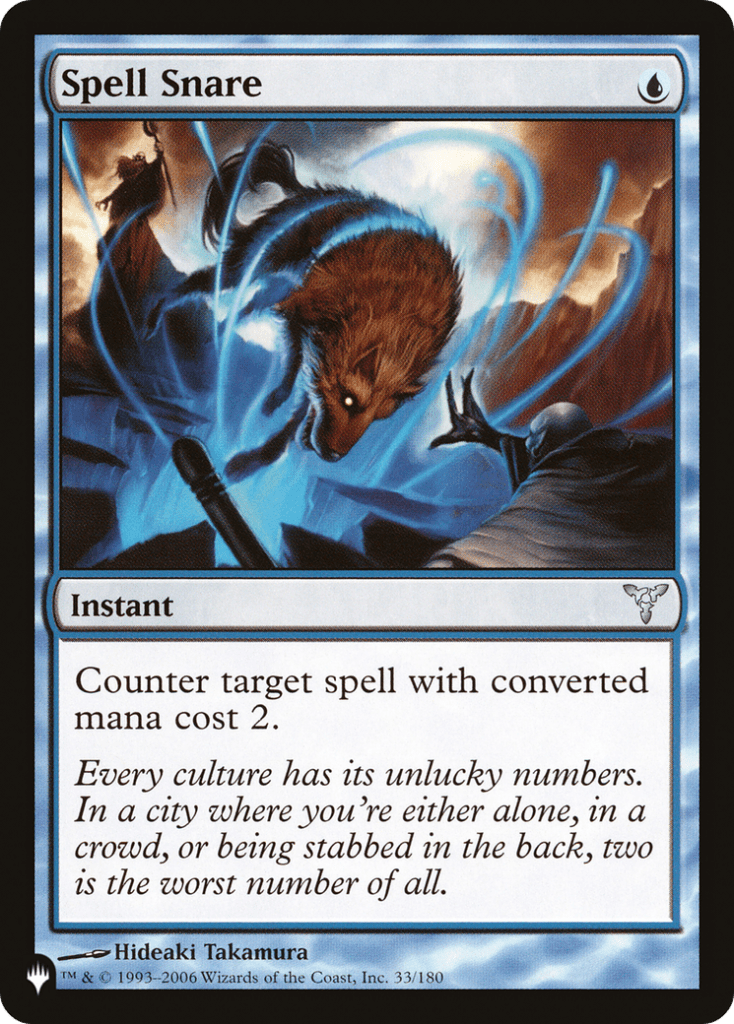
Rating: 0/10
Only countering 2-mana spells is far too restrictive for Limited play. A counterspell that could hit only 3-drops would legitimately be useful given the prevalence of disguise, but Spell Snare just isn’t good enough.
Stromkirk Captain

Rating: 3/10
This set does actually have a few vampires in it and nearly all of them are mono-black. Stromkirk Captain isn’t exactly going to be the game breaker it has been in the past, but it’s a strong typal lord that should be able to pull its weight in the right deck.
Syr Konrad, the Grim

Rating: 7/10
If you play a lot of Commander, you’re probably familiar with this card. Given how much I have to point out that good Commander cards are awful, you might also think that Syr Konrad, the Grim is bad. But no! Syr Konrad is still busted in Limited. It makes it so hard for your opponent to get into combat and just ends games really quickly.
Treacherous Terrain
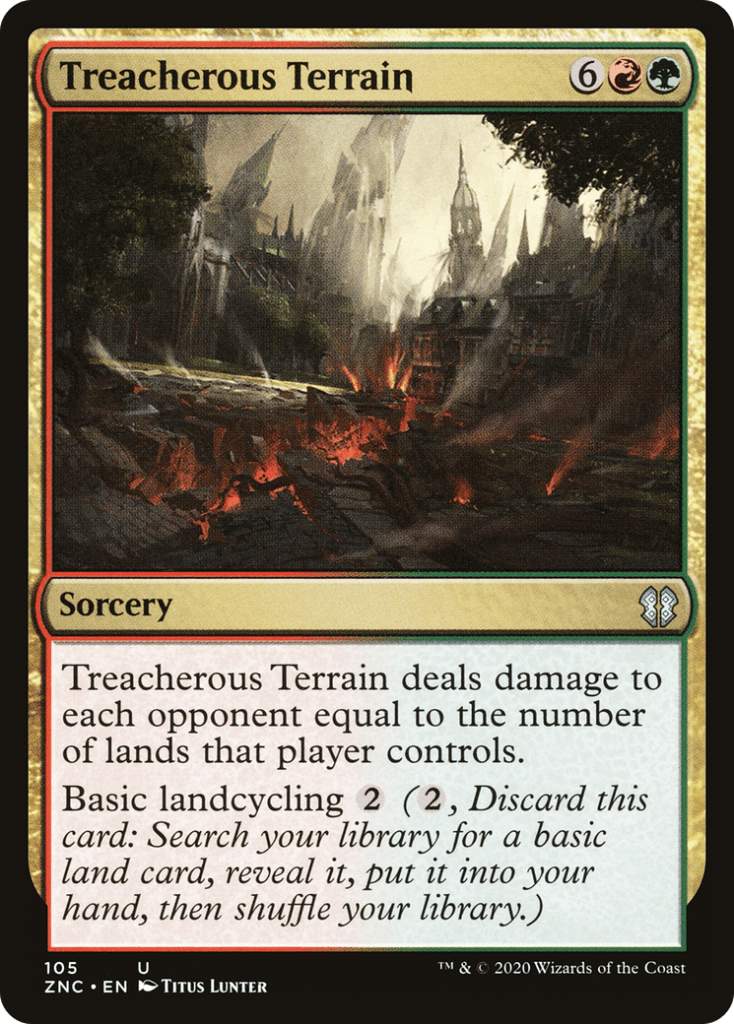
Rating: 2/10
The last year of sets have proven to use that landcyclers are a fair bit past their prime. Treacherous Terrain is fine, but an 8-mana spell when you don’t need it to be a land isn’t great. At least it ends the game though, so that’s something.
Worldspine Wurm
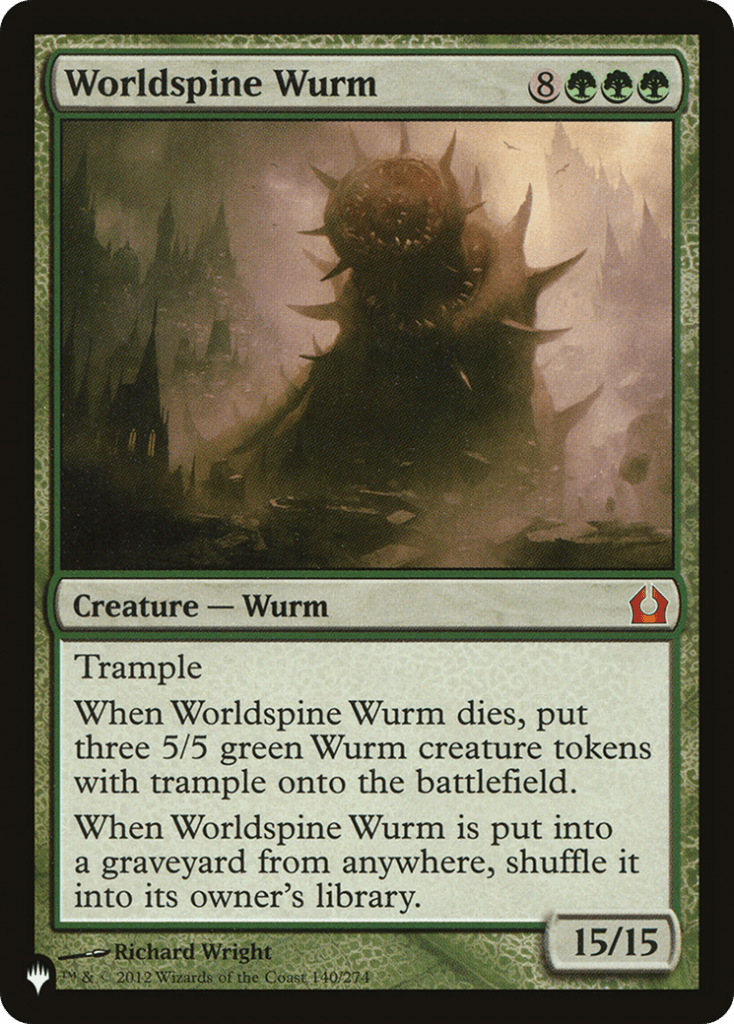
Rating: 2/10
Why am I not giving an 11-mana creature a flat 0? Hear me out. What if you cloaked Worldspine Wurm, then used Expose the Culprit? Yeah, it’s extremely unlikely to come together, but if I saw this in my opening pack, I’d definitely try it and no one can stop me.
Special Guests
Also on the List are the following 10 “Special Guest” cards, which have new borderless artwork.
Ghostly Prison

Rating: 1/10
I don’t think I’ve ever gotten to play with this kind of card in Limited, but I can’t imagine it works out too well. I can see Ghostly Prison being desirable against a deck that goes wide on the board, as it does neuter their strategy, but other than siding it in for that specific case, I don’t think it’ll be worth it.
Fabricate
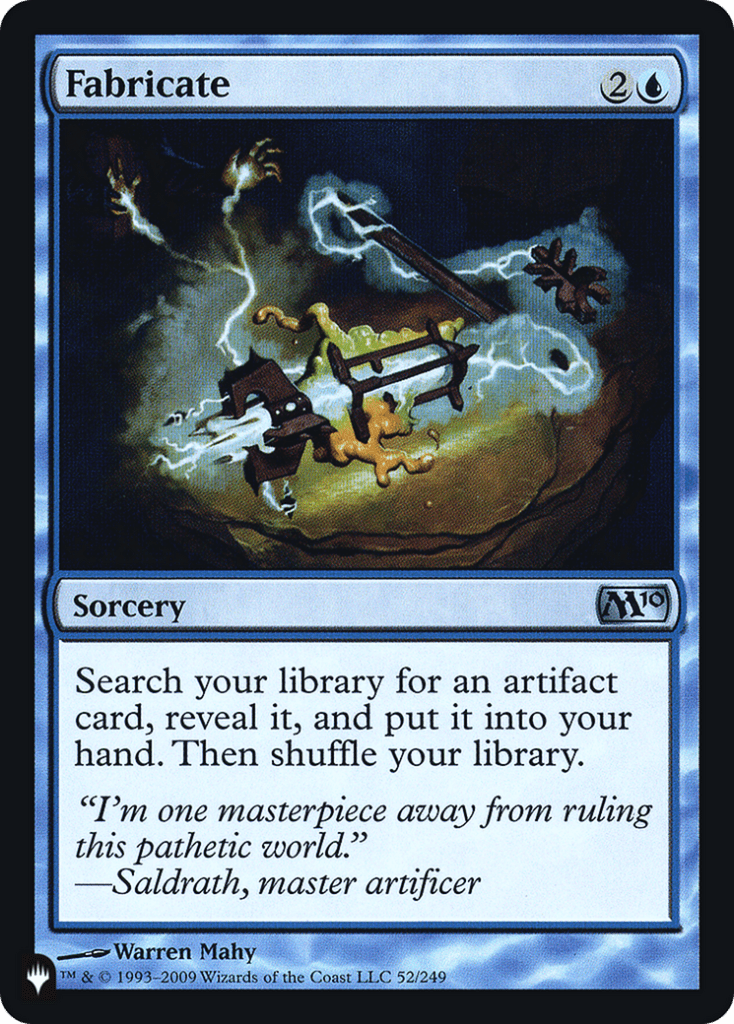
Rating: 0/10
Not even the best artifact in the set is likely to be good enough if you have to pay 3 extra mana for it. Fabricate feels particularly out of place in this set, and I wouldn’t even think of running it.
Show and Tell
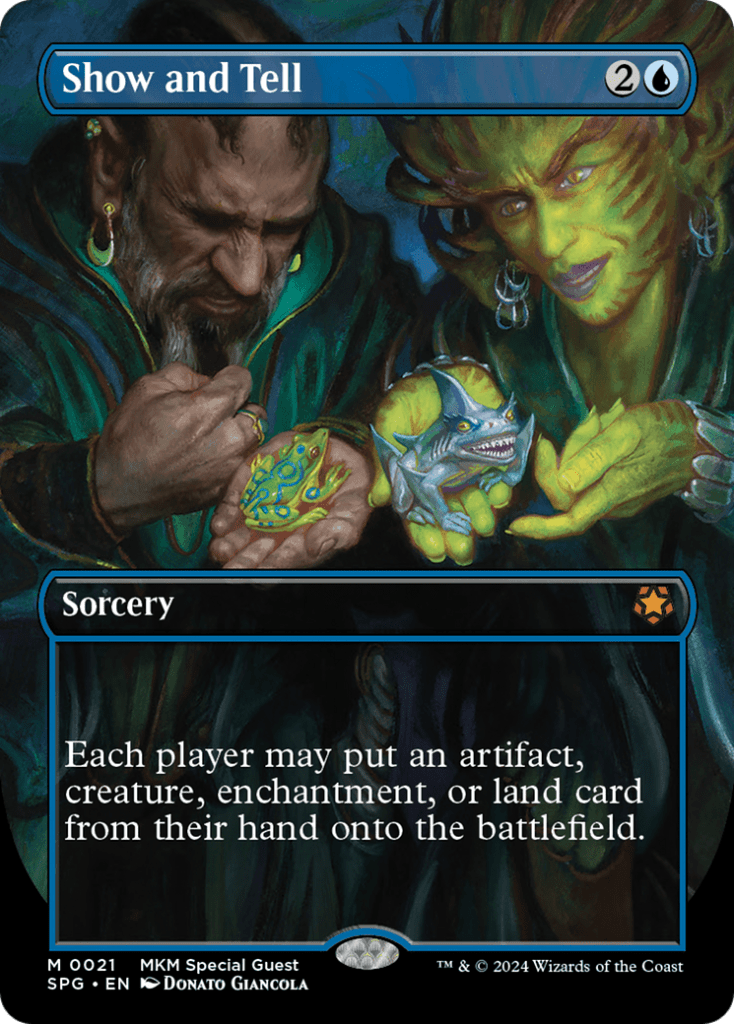
Rating: 0/10
Show and Tell is a classic card in Legacy and Vintage Cube, but that’s only because you get to put ridiculous permanents like Omniscience and Emrakul, the Aeons Torn onto the board as early as turn 1. The best you’re likely to do here is get a 6-drop into play early, but then your opponent gets to do the same and that’s clearly not good enough.
Tragic Slip
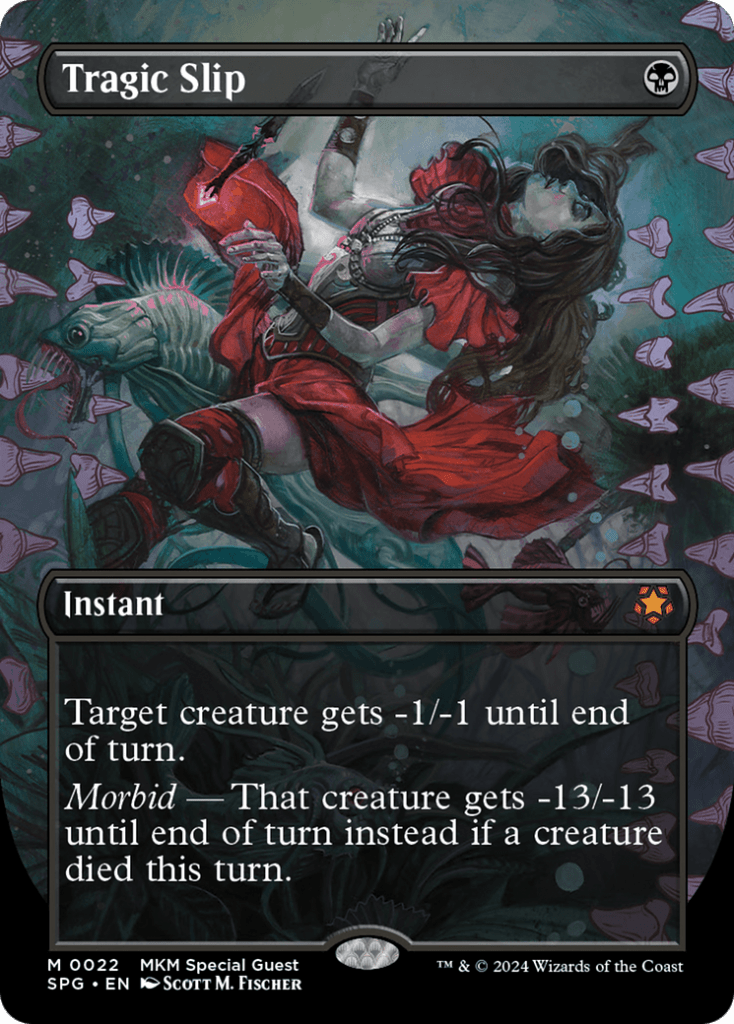
Rating: 5/10
Morbid isn’t the easiest ability to trigger, but getting to kill just about any creature for just 1 mana is a big upside, and one worth going for when you see Tragic Slip. It’s not quite a premium removal spell, but it should be a great addition to any black deck.
Victimize
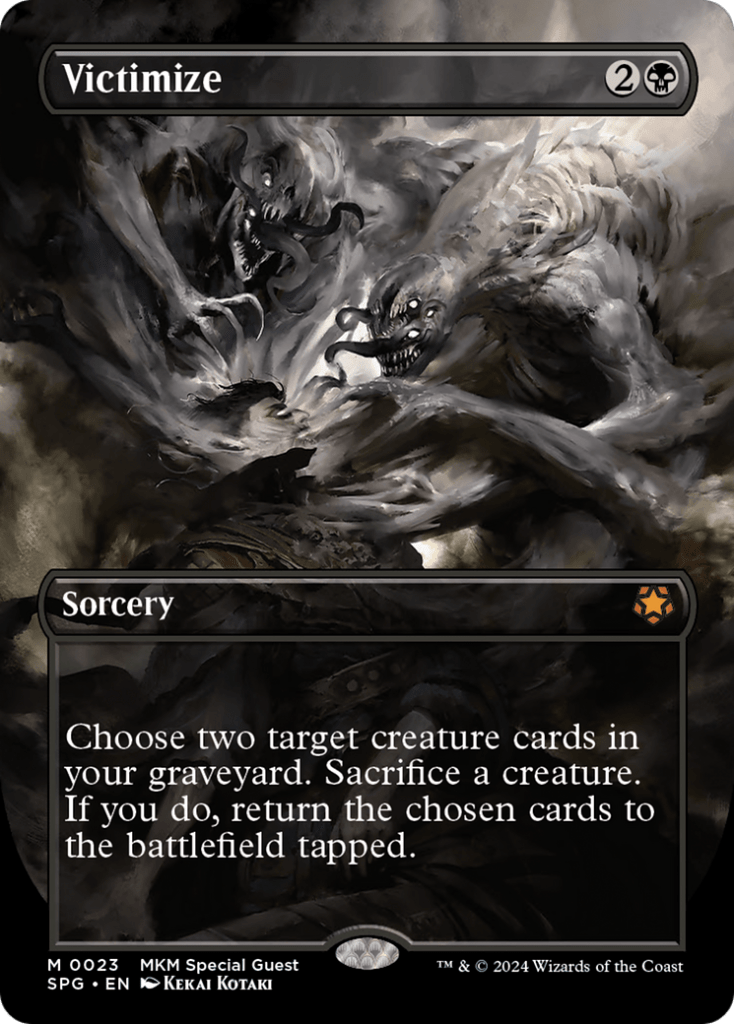
Rating: 5/10
Reanimation spells are very hard to get working in Limited because they cost so much mana, and getting small creatures with them ends up being bad. Victimize completely changes that by costing just 3 mana and giving you two creatures, which actually sounds like a good plan.
Gamble

Rating: 0/10
Tutor effects aren’t good in Limited in the first place, let alone one like Gamble that leaves you down a card and doesn’t guarantee you get to keep the card you tutored up.
Crashing Footfalls

Rating: 7/10
This is likely the best turn 1 play in the format, except it comes with the downside of being very weak if you draw it later in the game. Still, with Crashing Footfalls only costing 1 mana to suspend, you should be able to slot it into a lot of points on the curve, like on turn 4 alongside a disguised creature, and resolving it later on is still impactful.
Tireless Tracker
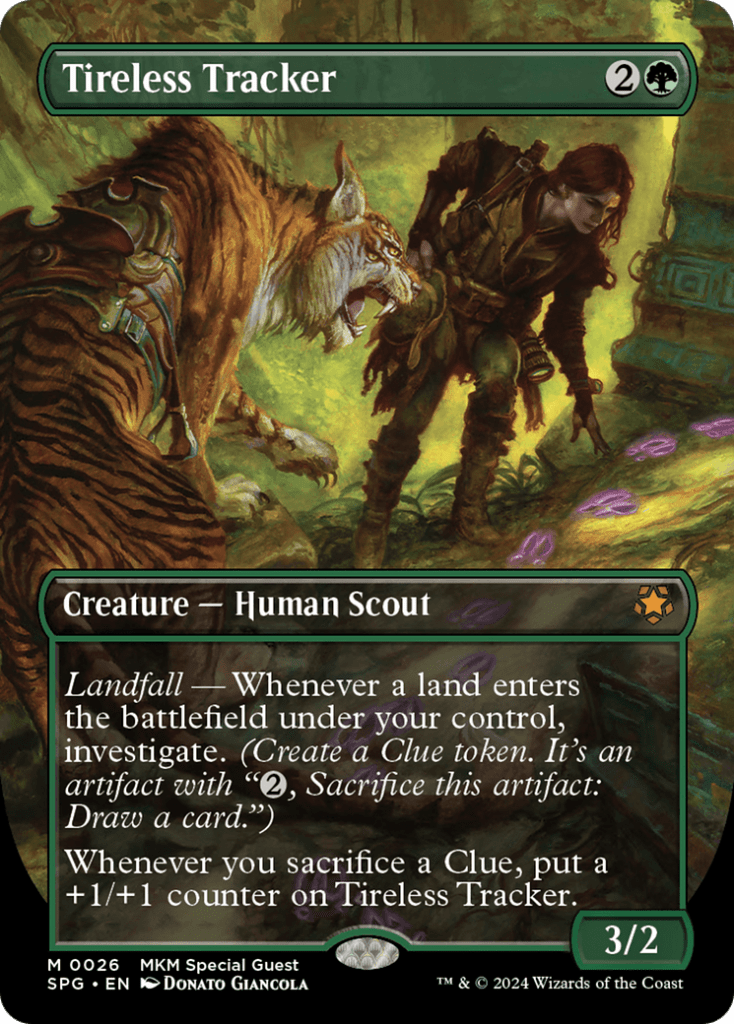
Rating: 9/10
This human scout card has proven itself as an all-star in many formats, and that success definitely translates to Limited. You’d rather play Tireless Tracker on a turn when you can also play your land for the turn to trigger its landfall ability and immediately get a Clue out of it. That’s already a two-for-one, and if it isn’t killed, every land you play puts you further and further ahead. This card is awesome and should make it really easy to swing games in your favor through sheer card advantage.
Drown in the Loch
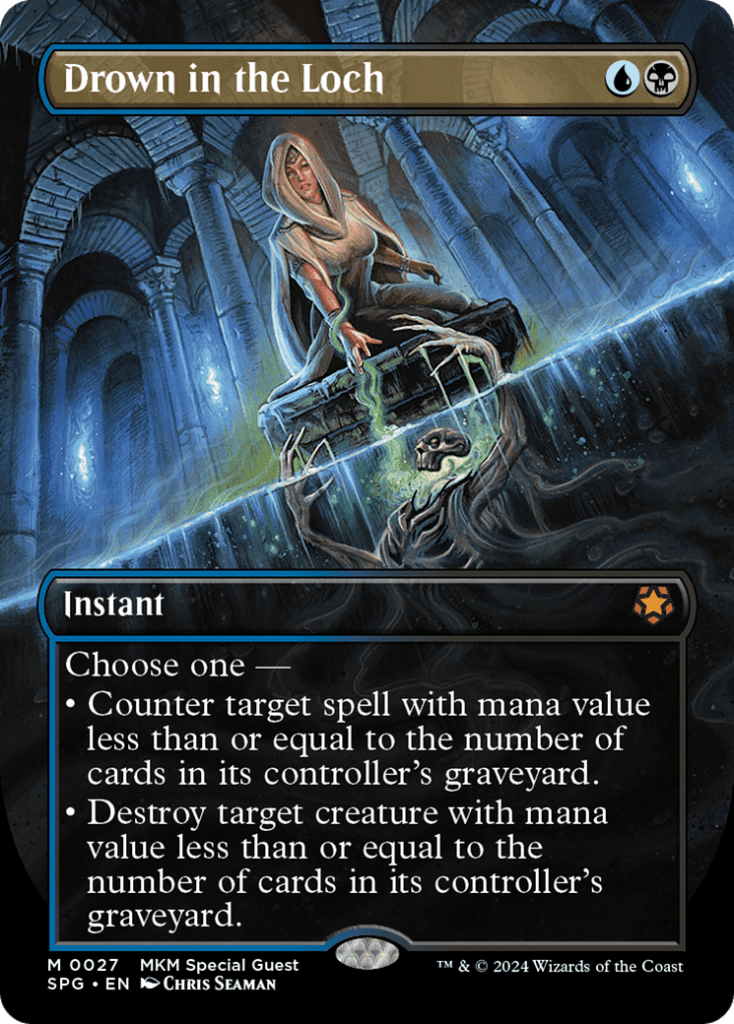
Rating: 6/10
You won’t be able to fill your opponent’s graveyard quite like you could in Throne of Eldraine, but it should naturally fill up enough over the course of the game that Drown in the Loch will turn into a catch-all answer to any annoying threat. It just won’t be very useful in the early game.
Field of the Dead
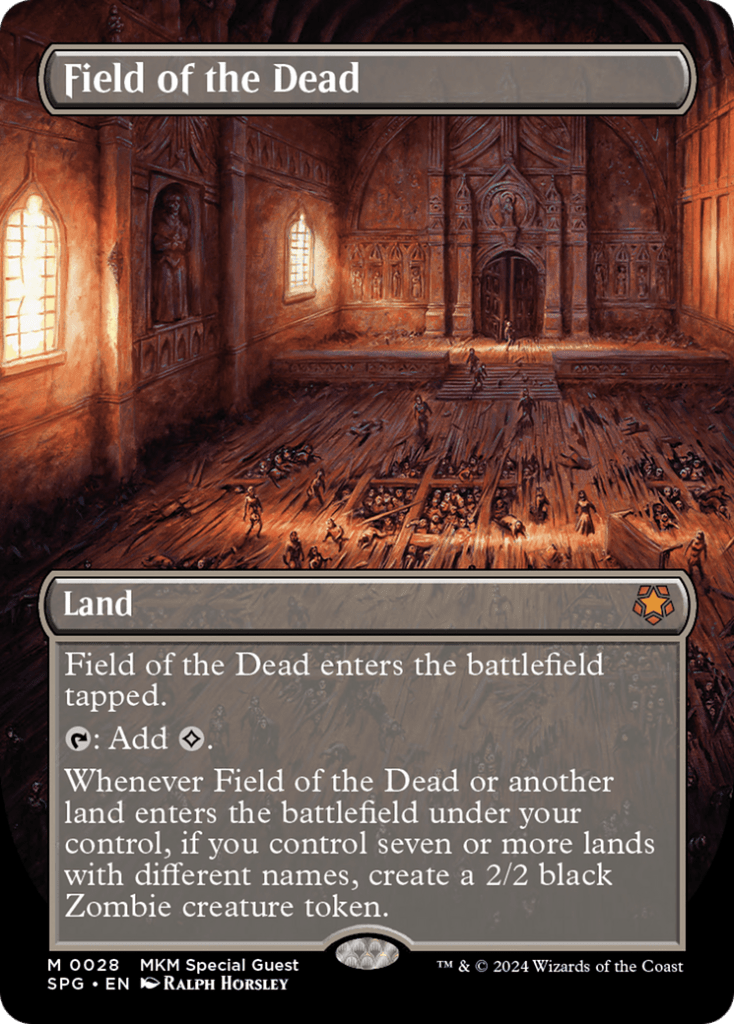
Rating: 0/10
It might be banned in multiple formats, but getting up to seven lands with different names is nearly impossible in Limited, so this is basically useless.
Wrap Up

Field of the Dead | Illustration by Kev Walker
I hope you’ve enjoyed my take on this set. I can’t wait to draft it. I love murder mysteries and the themes of this set really resonate with me.Please follow us on Twitter and join our Discord Server, too. Share the article with your friends and help drive the conversation further.Until next time, take care of yourselves!
Follow Draftsim for awesome articles and set updates:



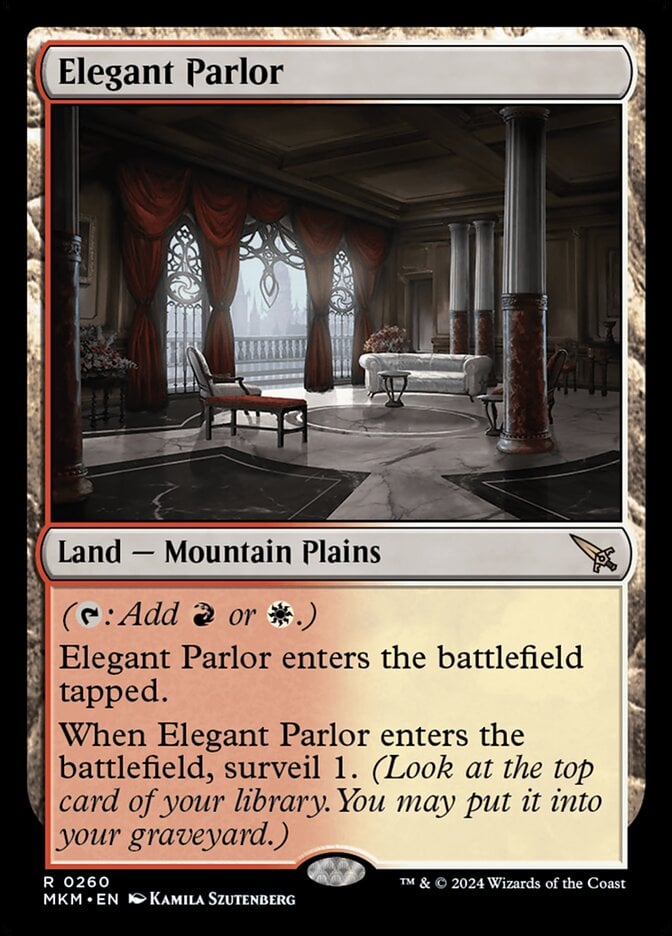

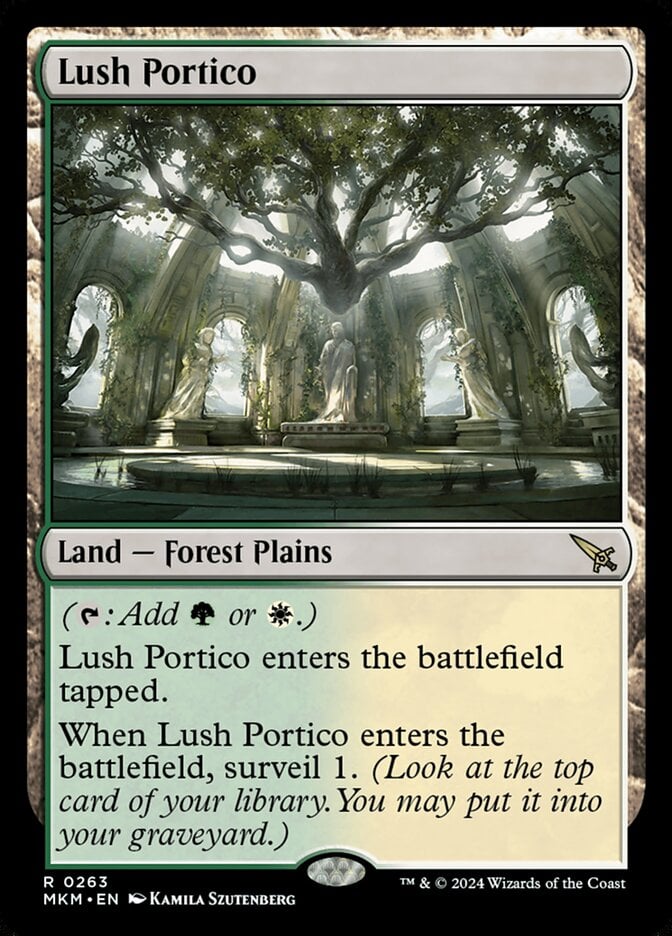
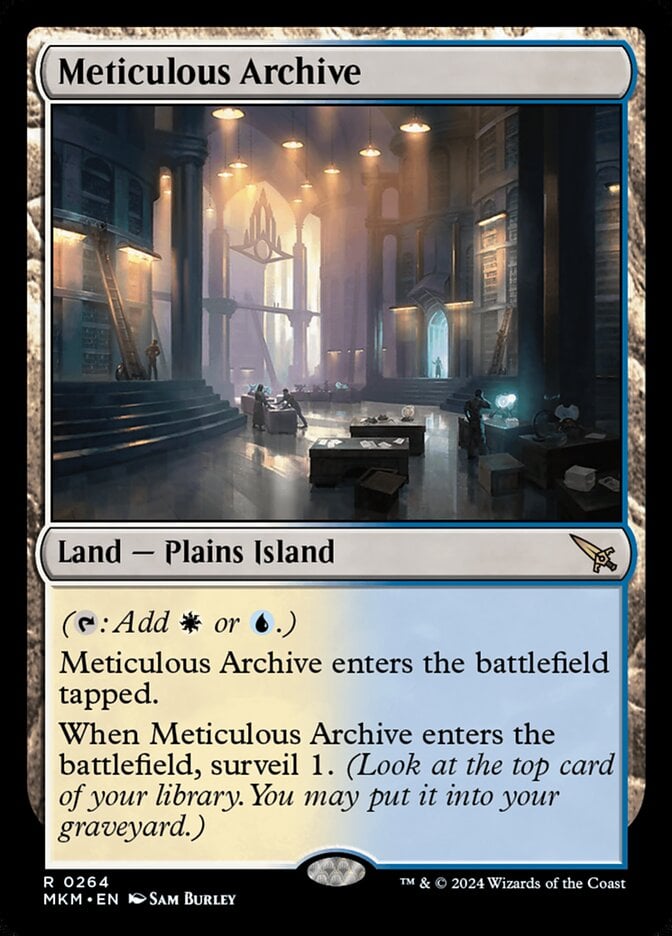

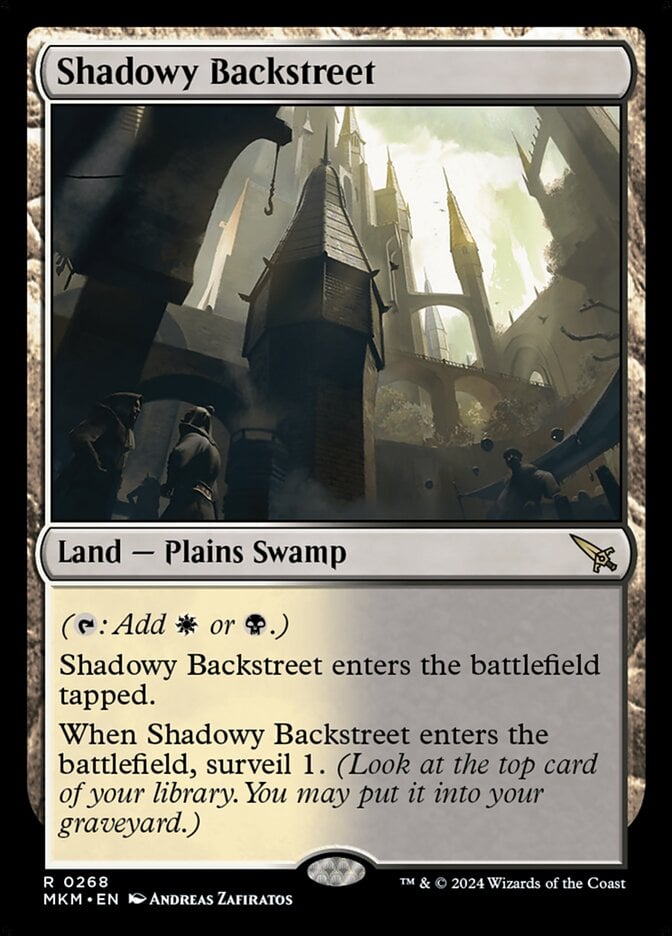
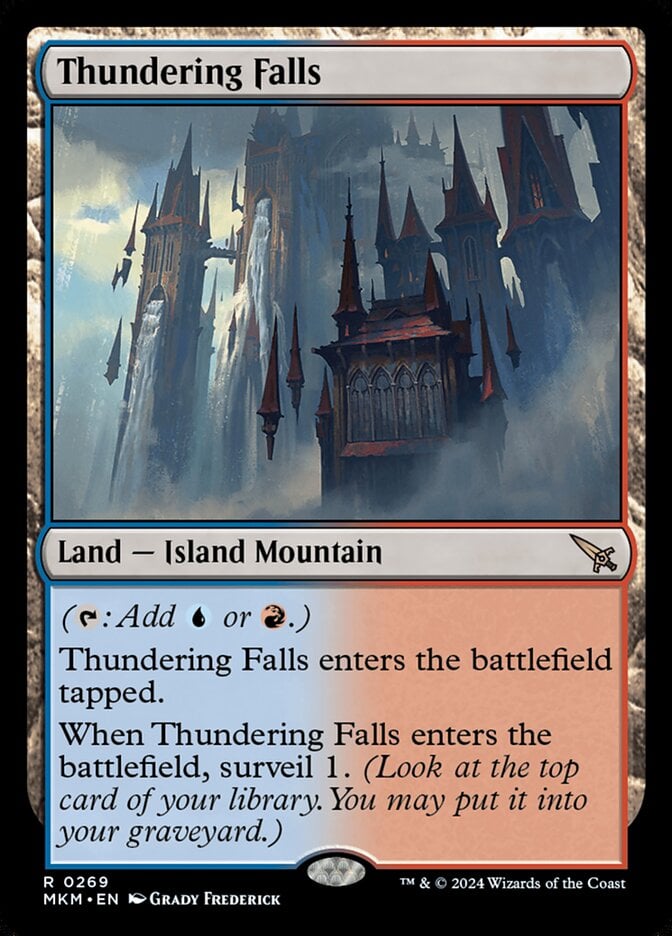
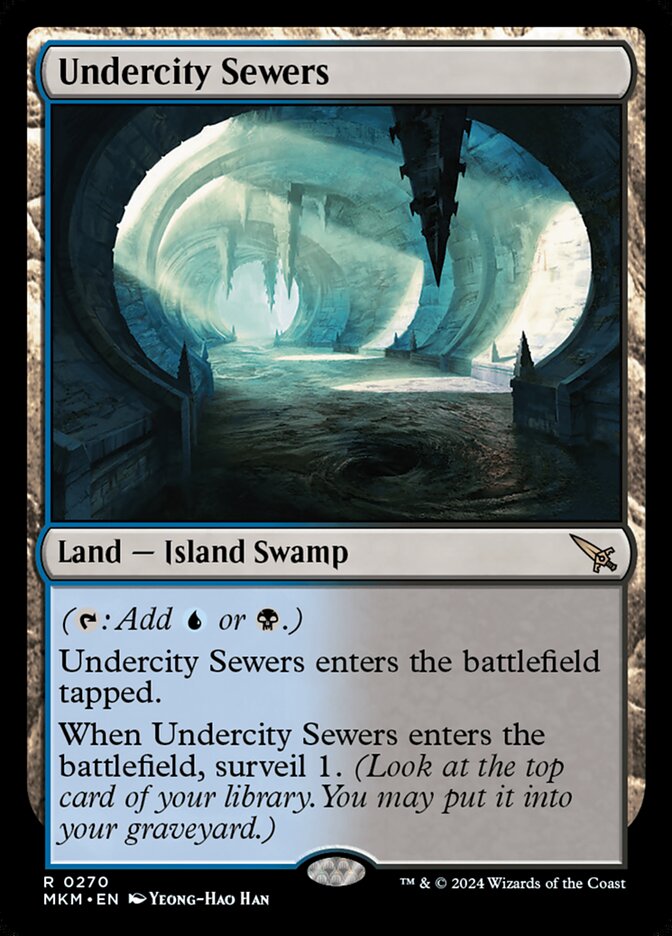
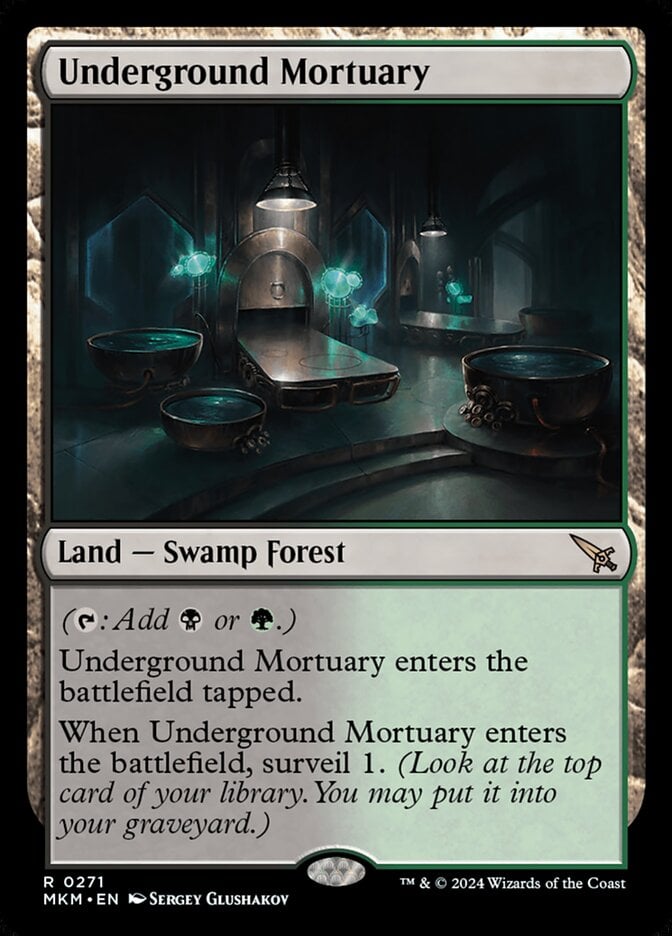

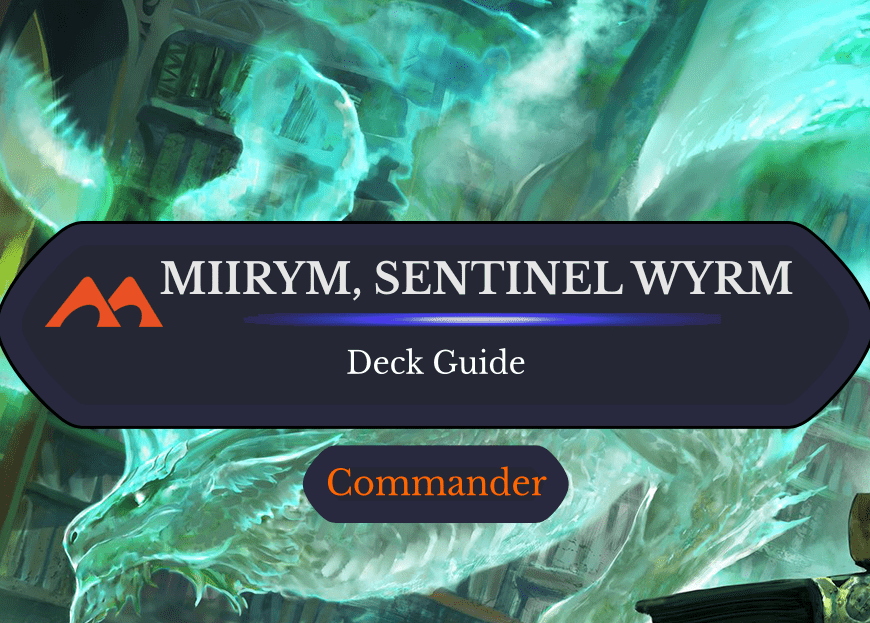
1 Comment
Some of these ratings feel a little off – especially when compared with some of the opinions from Limited Resources and MTG Arena Zone:
Case of the Uneaten Feast – 5/10 seems a little high
Curious Inquiry – 5/10 seems a little high when you still need to pay 2 for the card draw after connecting
Repeat Offender – 1/10 seems a little low for a two-drop with a not completely useless ability
Snarling Gorehound – 2/10 seems too low for a 1/1 menace with repeated card filtering ability (especially with all the disguise creatures)
Case of the Crimson Pulse – 1/10 seems too low for card draw with great late-game/top-deck potential
Caught Red-Handed – 3/10 seems a little high for a 5-mana treason effect (especially with the next card, The Chase Is On also being 3/10 – which is at least a serviceable combat trick with card draw)
Concealed Weapon – 2/10 seems a little low given the flexibility the card offers
Harried Dronesmith – 3/10 seems too low with all the other artifact, sacrifice, on attack, and 2-power-ETB synergy in the set
Vengeful Tracker – 5/10 seems a little high for such a conditional (and maybe more sideboard-worth) ability
Case of the Trampled Garden – 7/10 seems too high
Flourishing Bloom-Kin – 2/10 seems a little low for a two-drop with both ramp and late-game growth potential
Hedge Whisperer – 2/10 seems a little low for an early blocker + late game mana sink
Sample Collector – 1/10 seems too low
Slime Against Humanity – 3/10 seems a little high
Undercover Crocodelf – 4/10 seems a little high as a 5/5 with no evasion for 6-8 mana
Magnetic Snuffler – 5/10 seems a little high
Add Comment